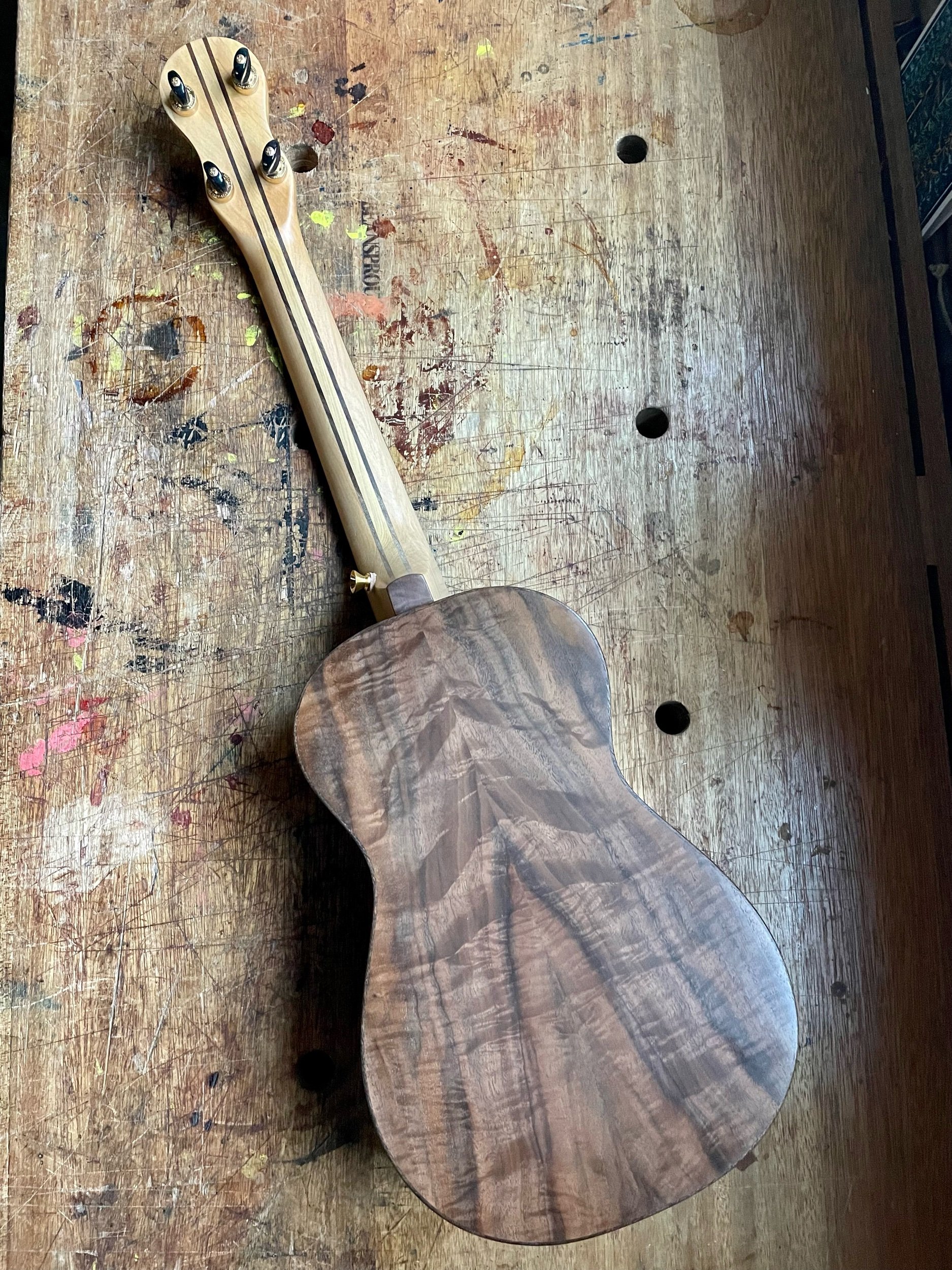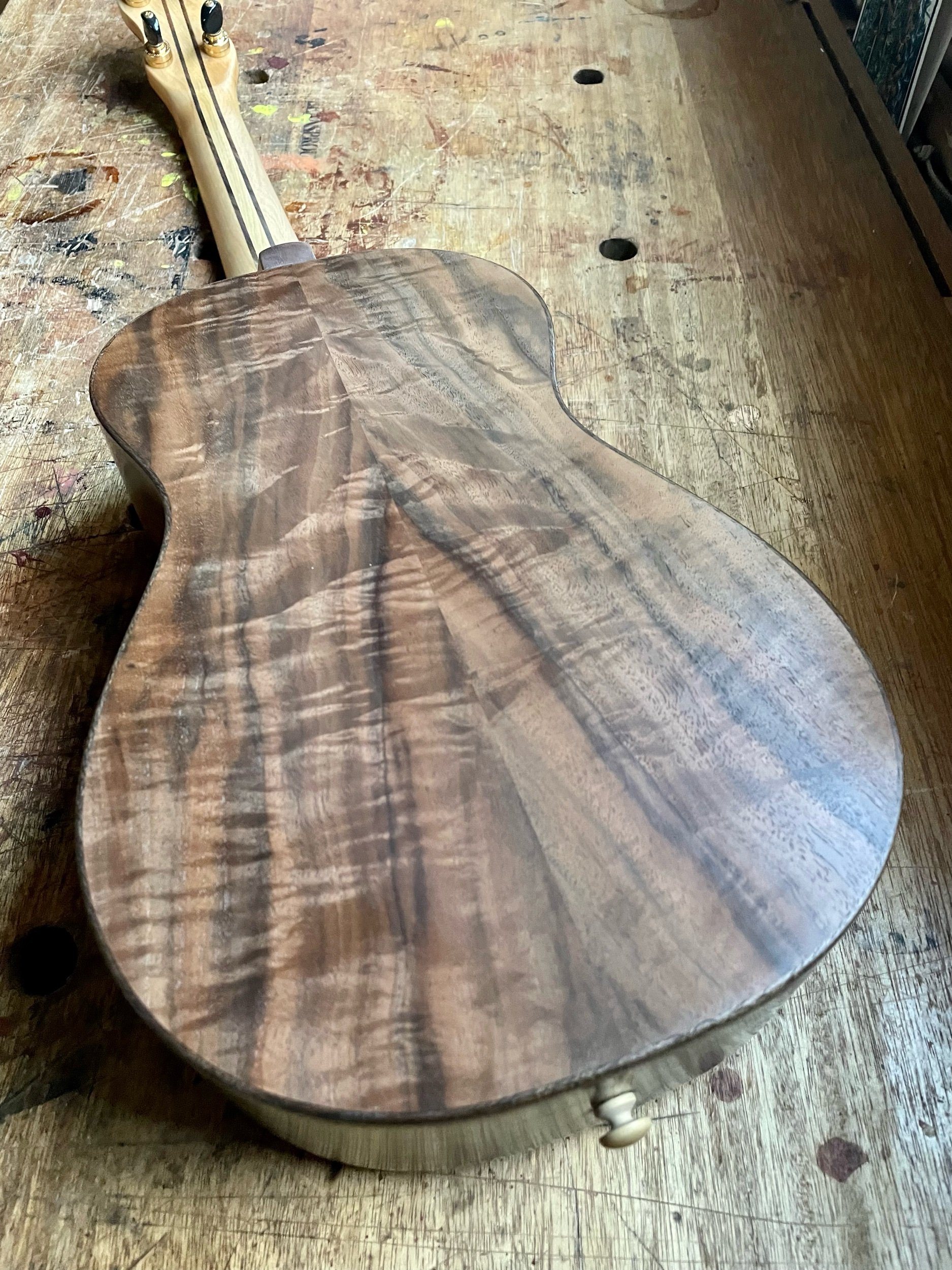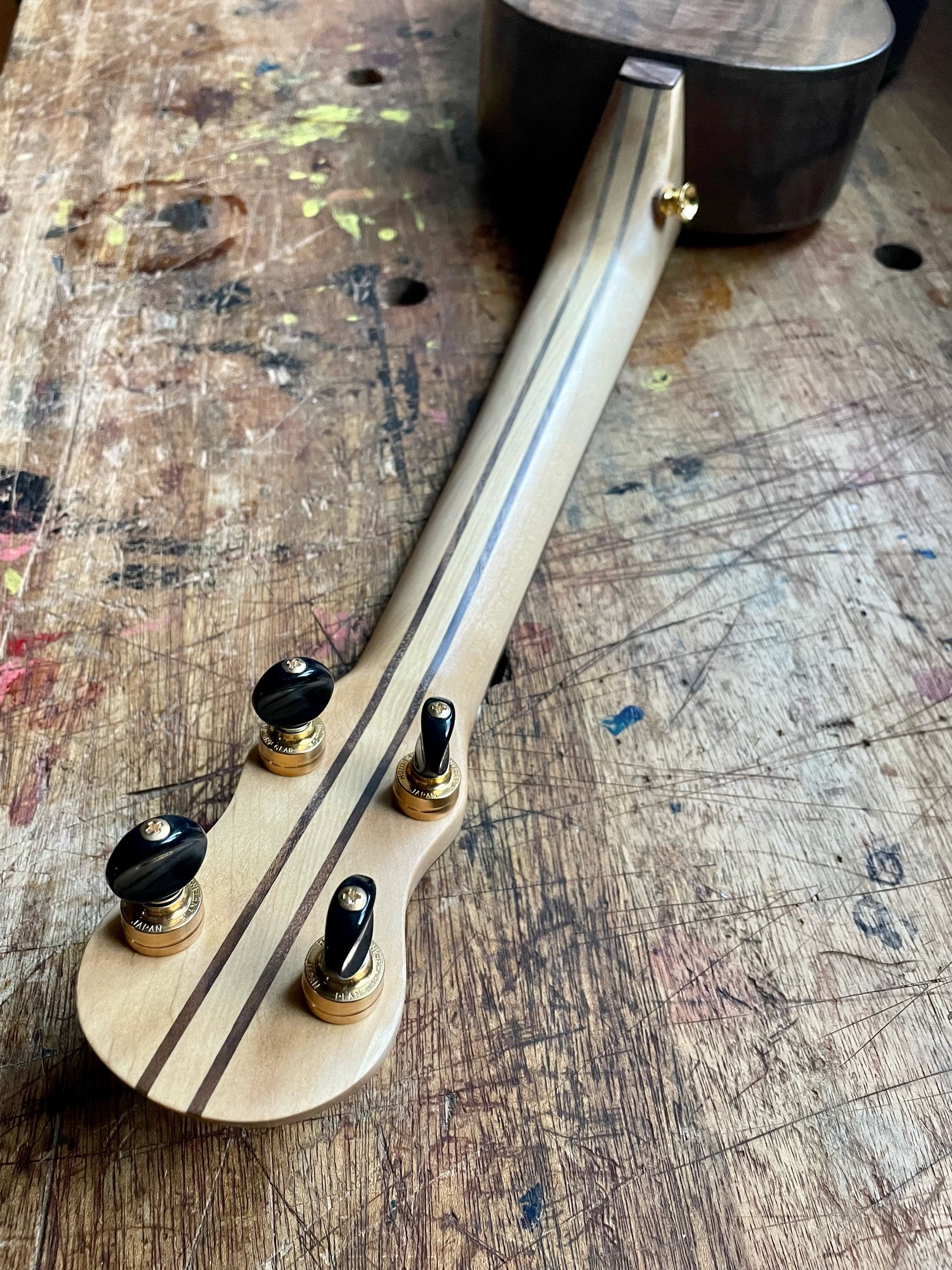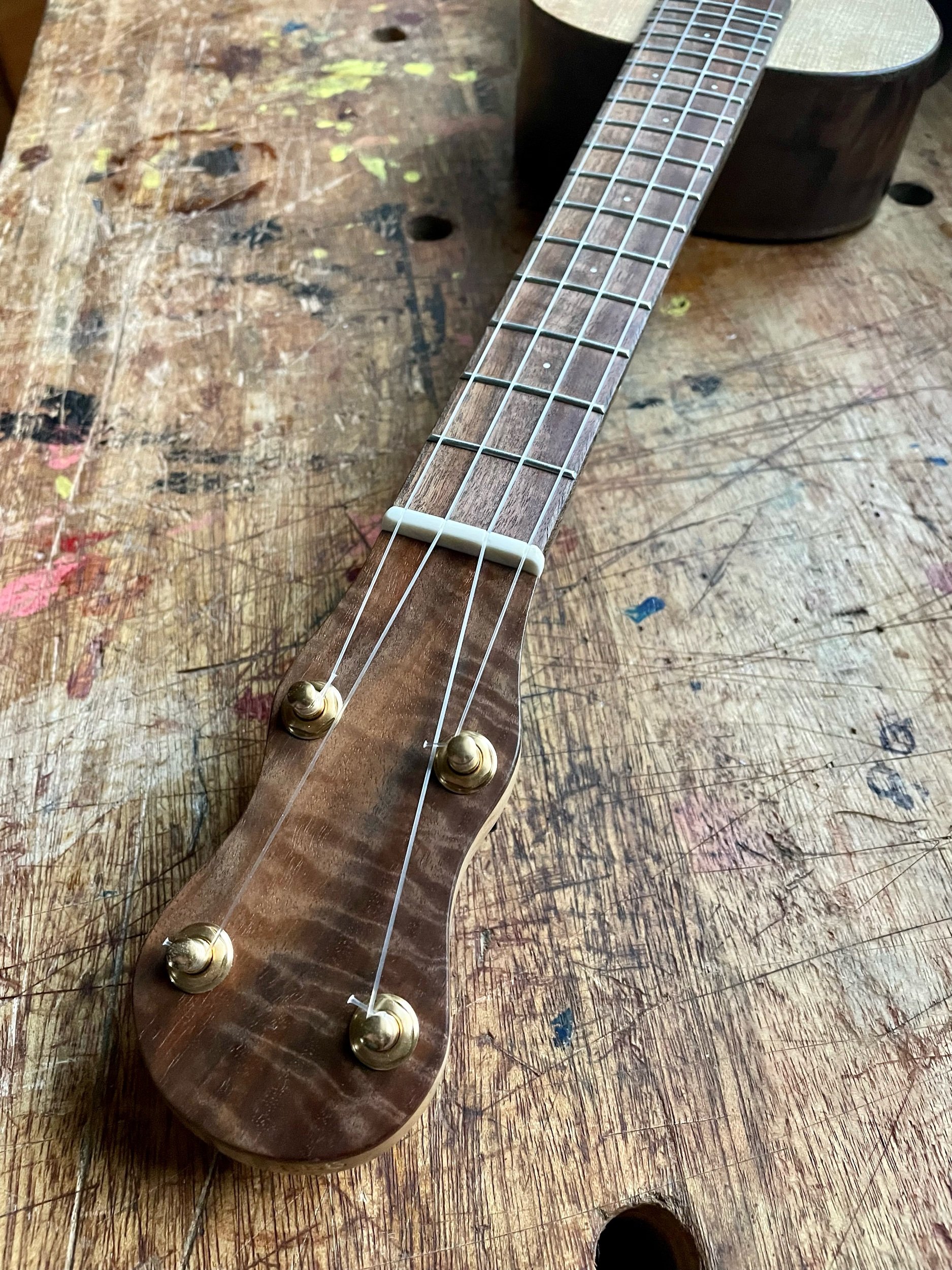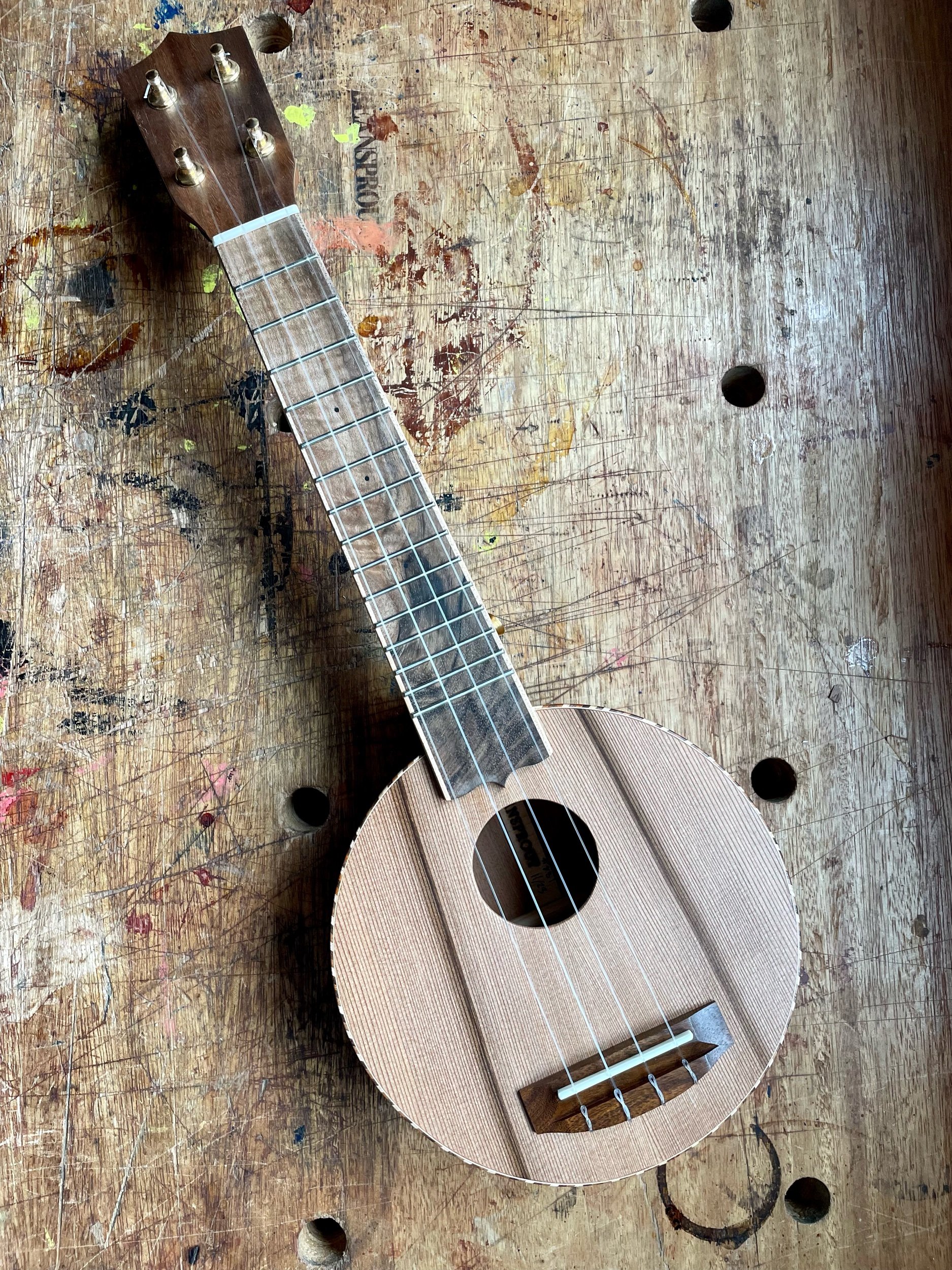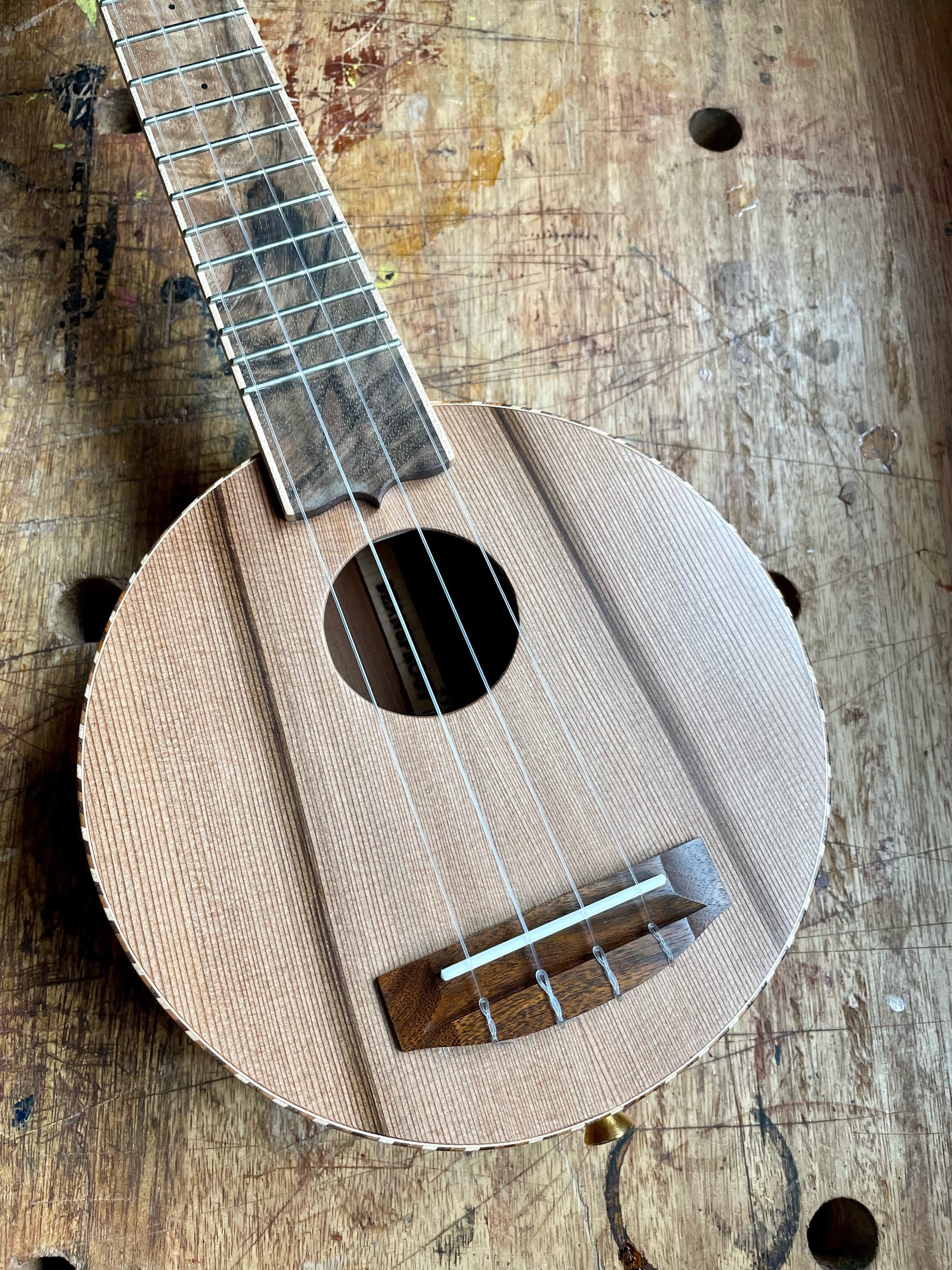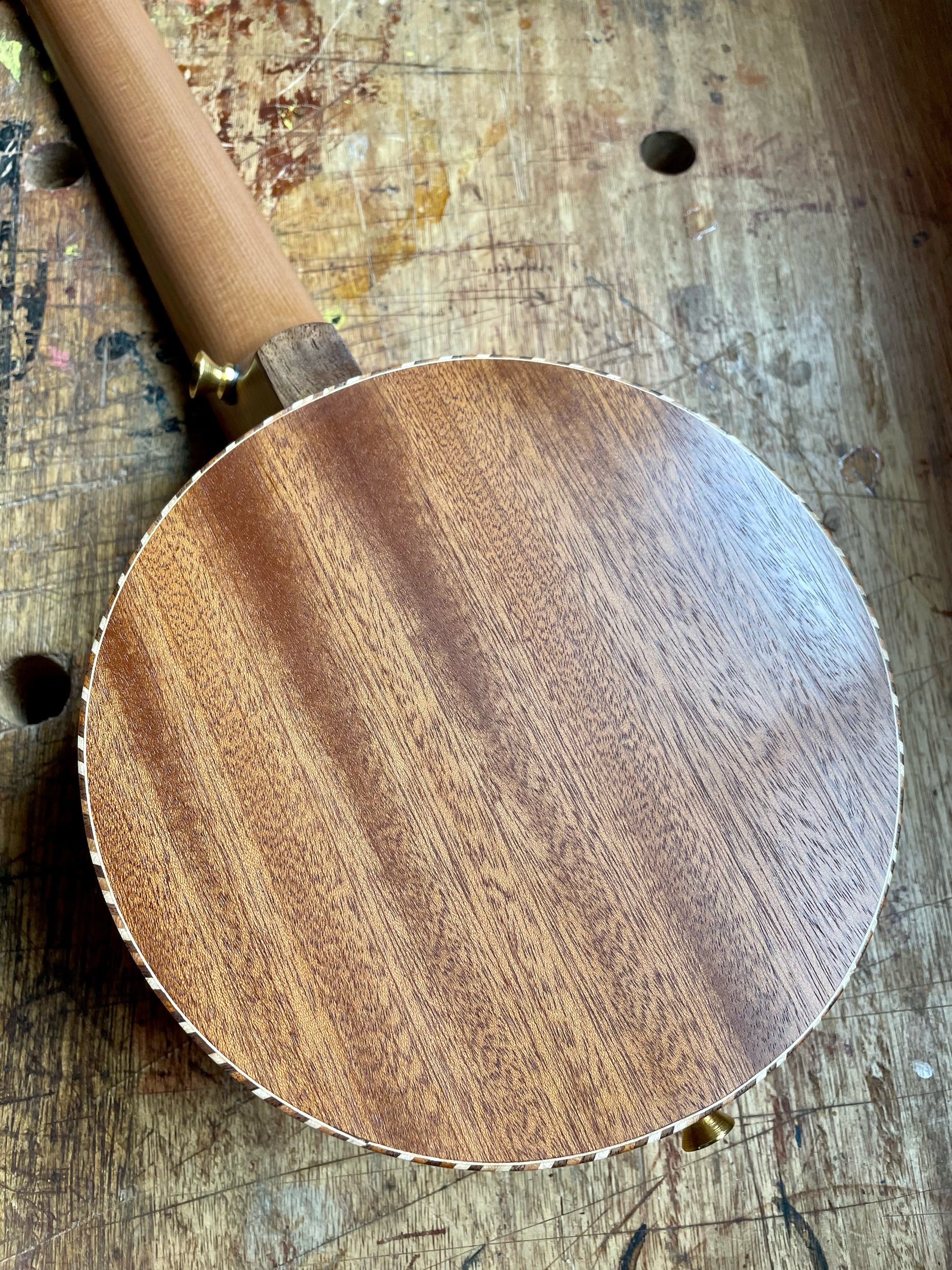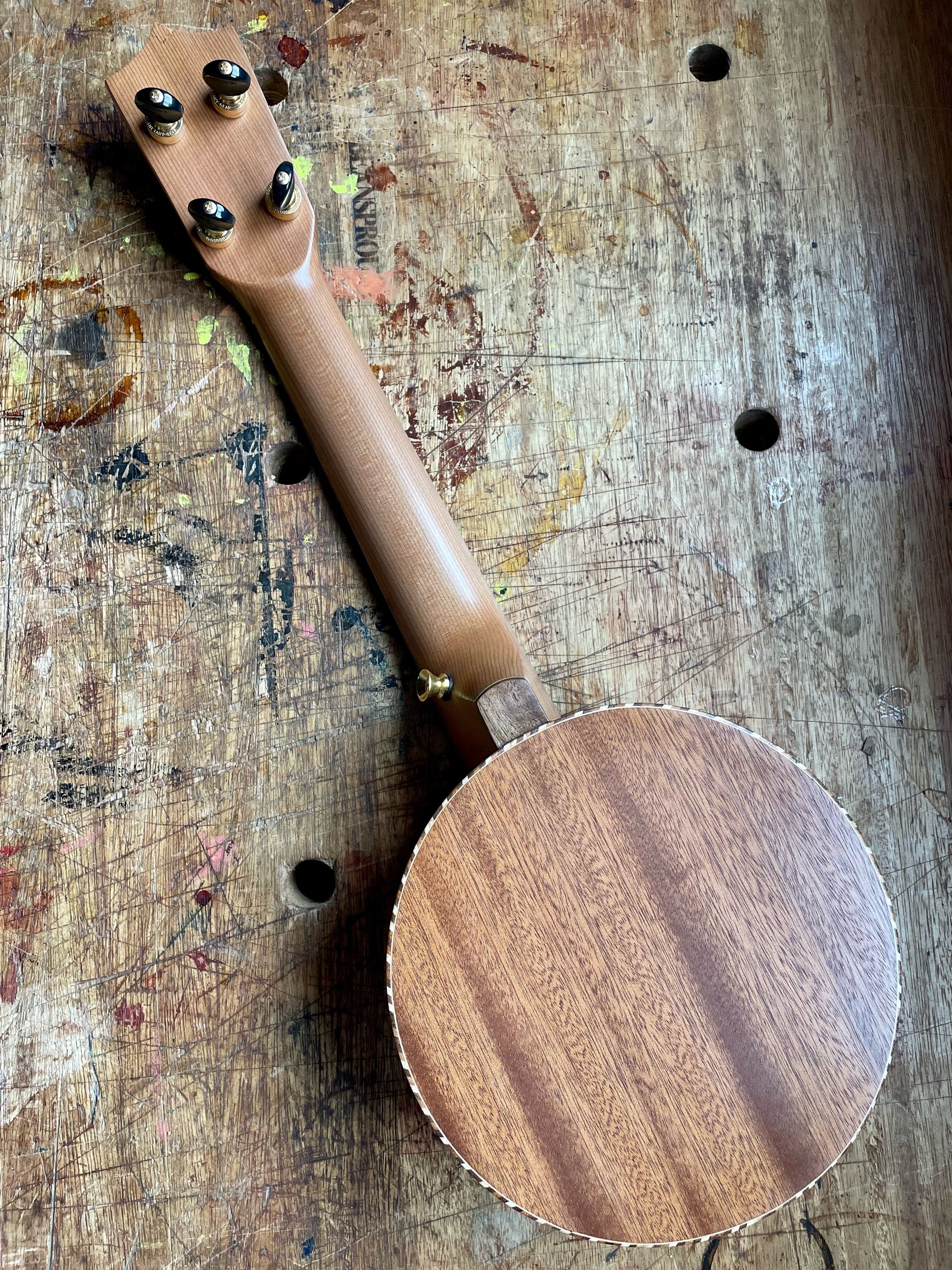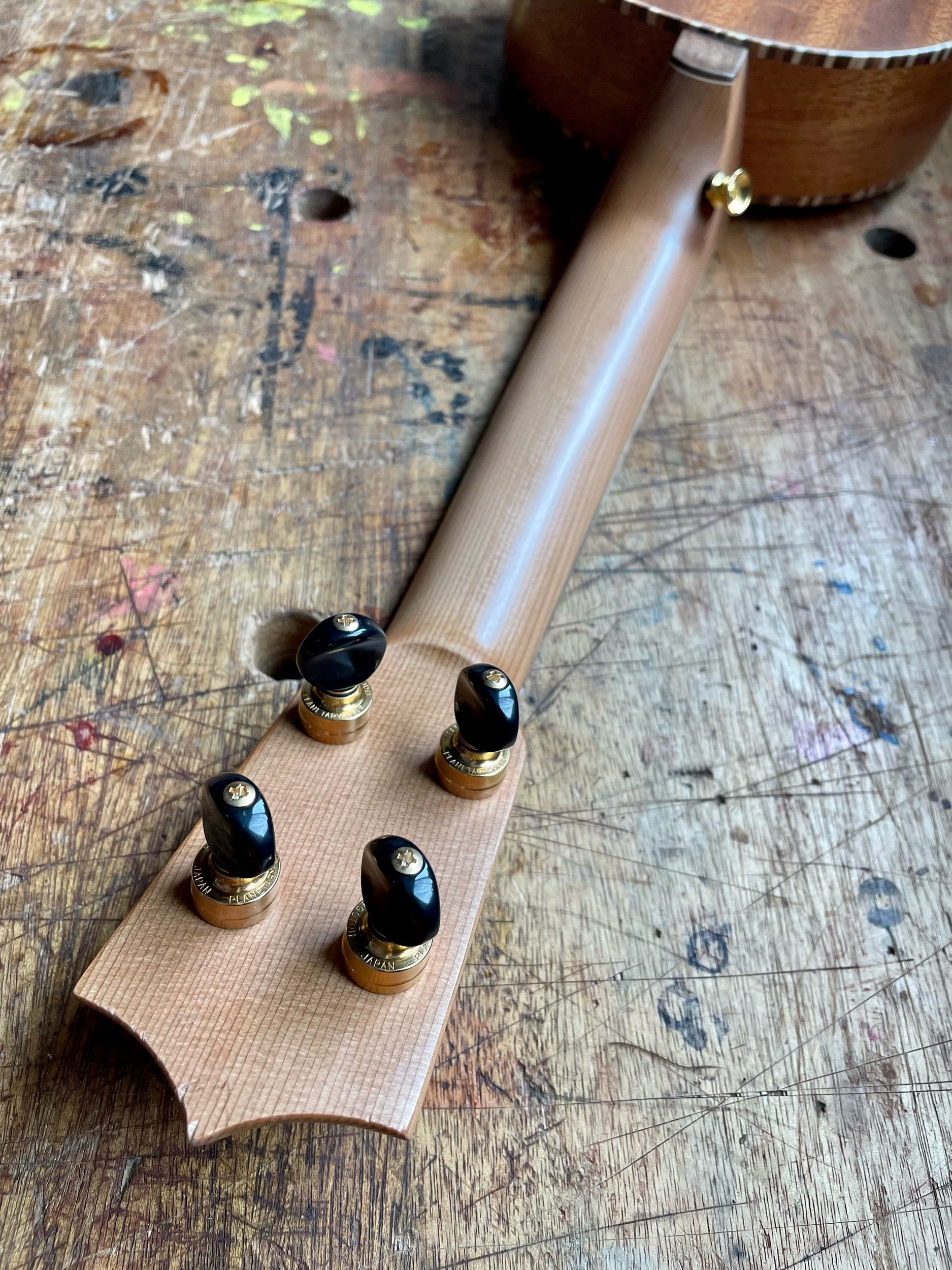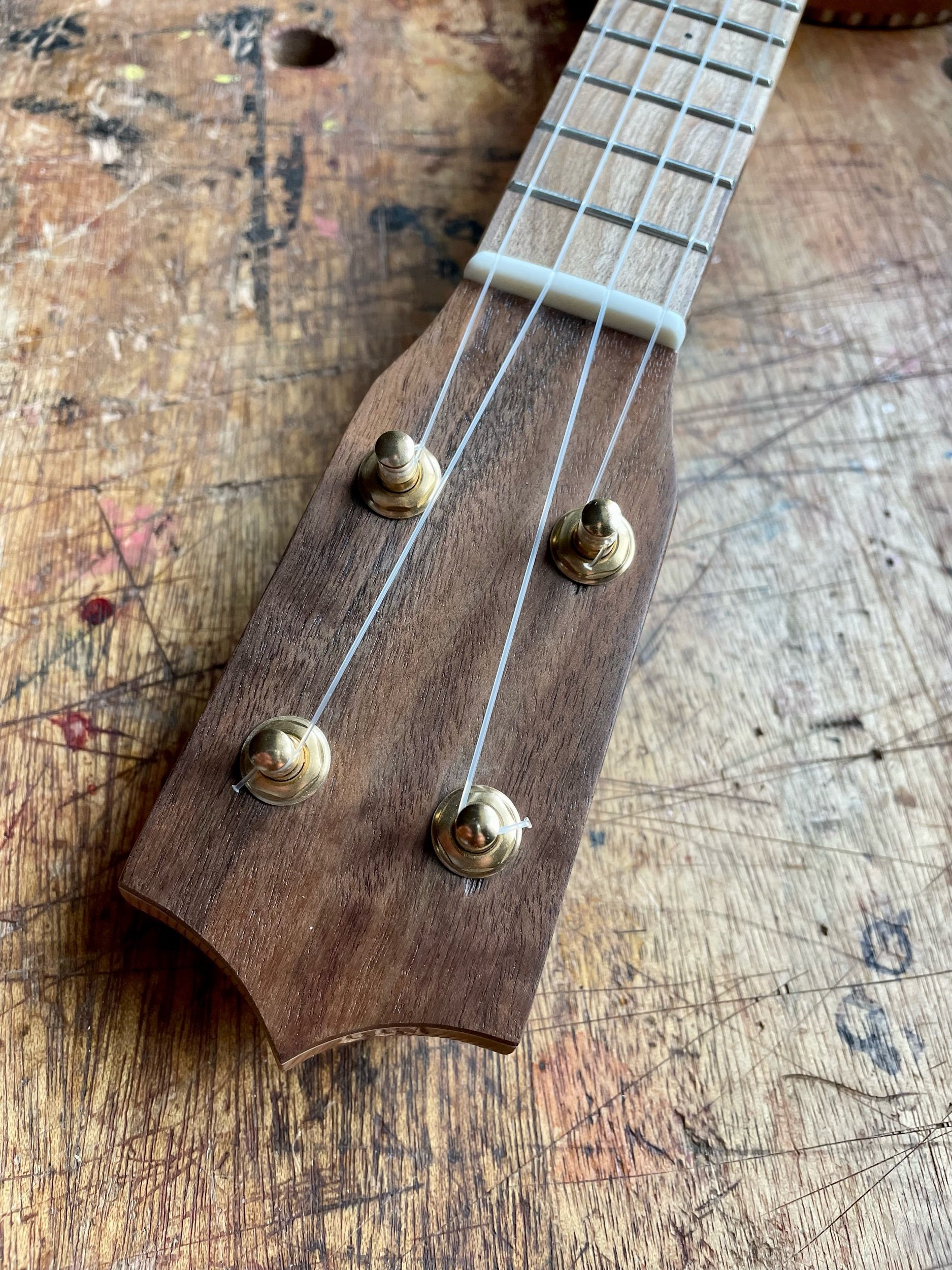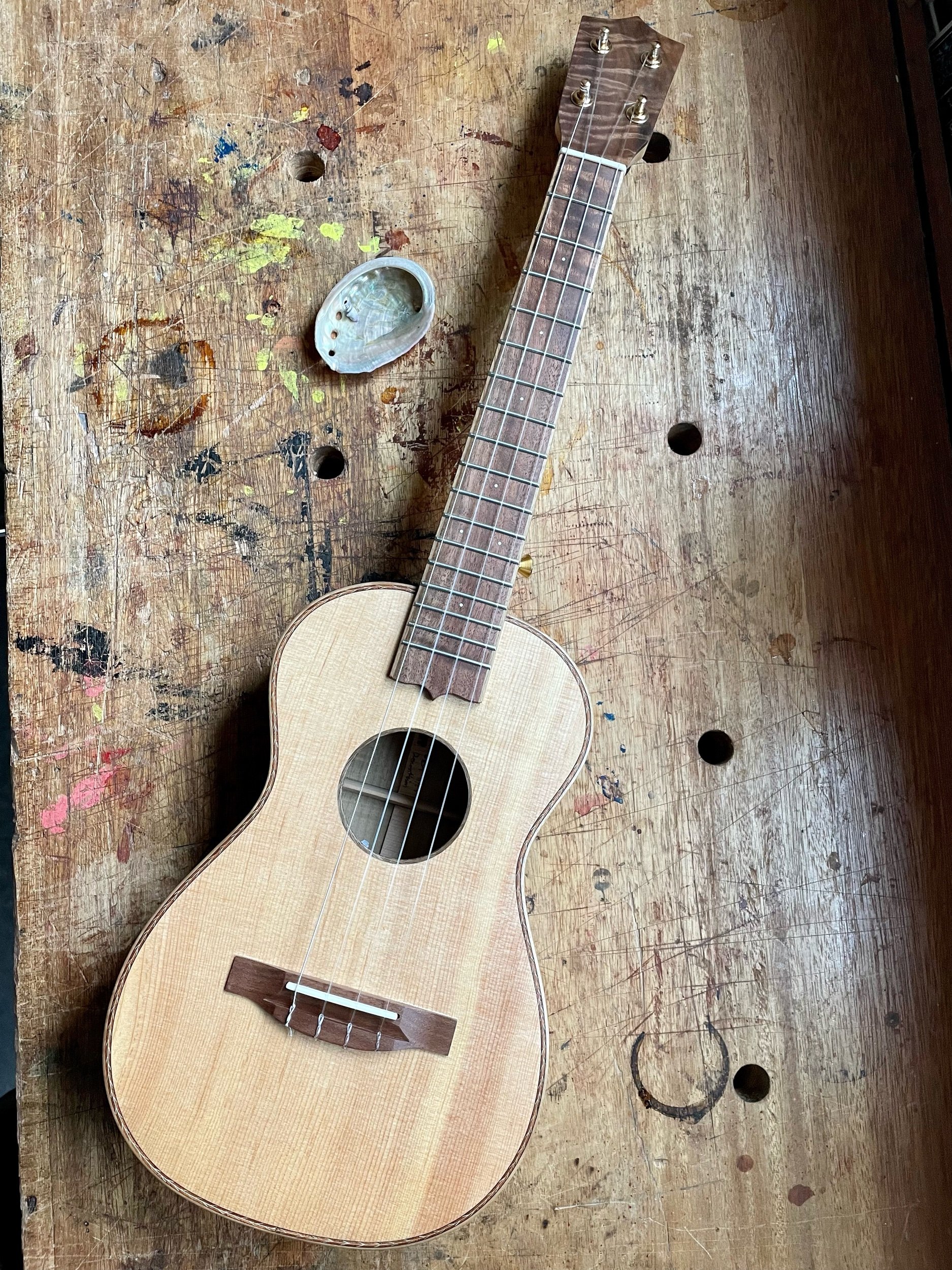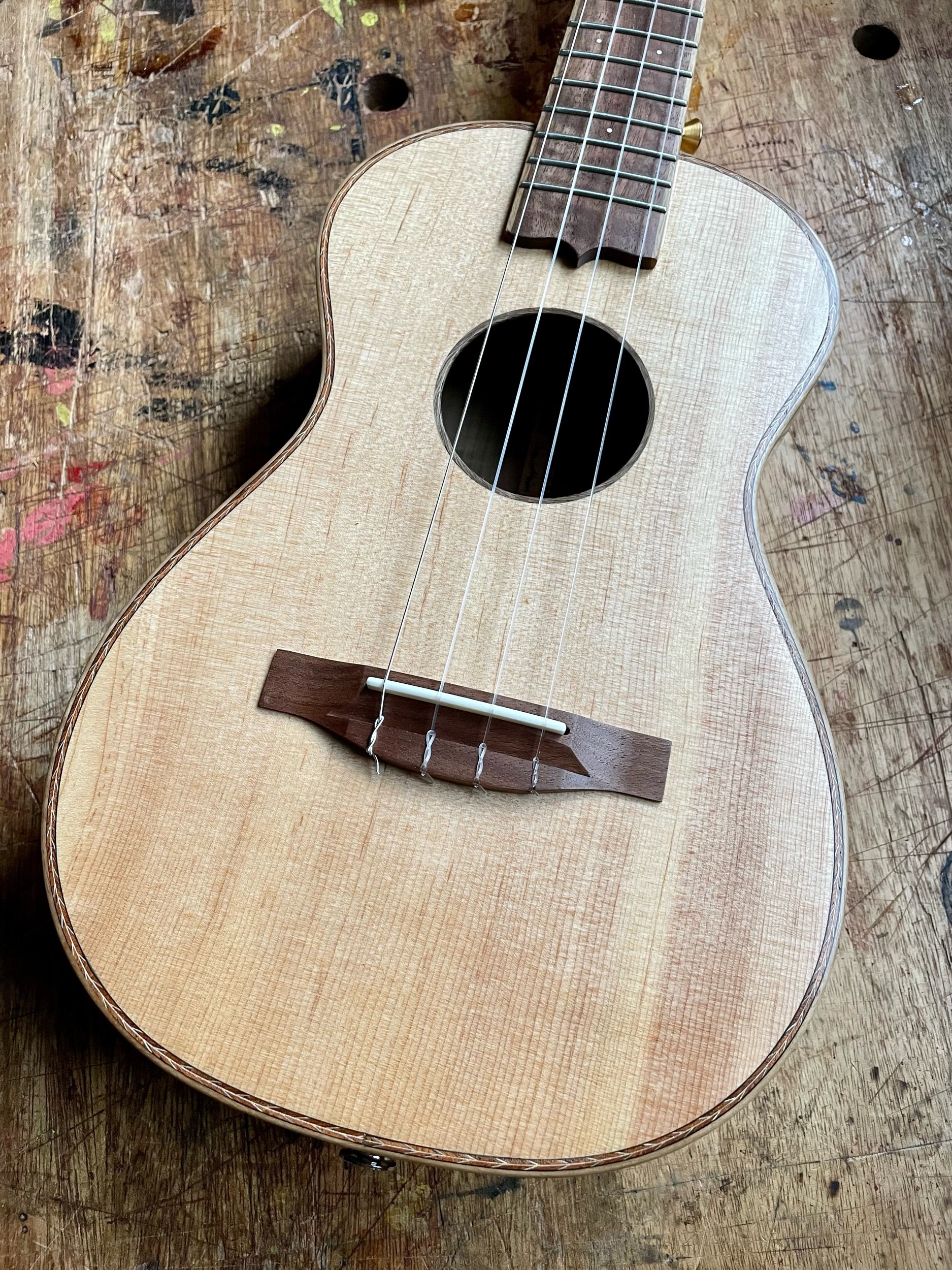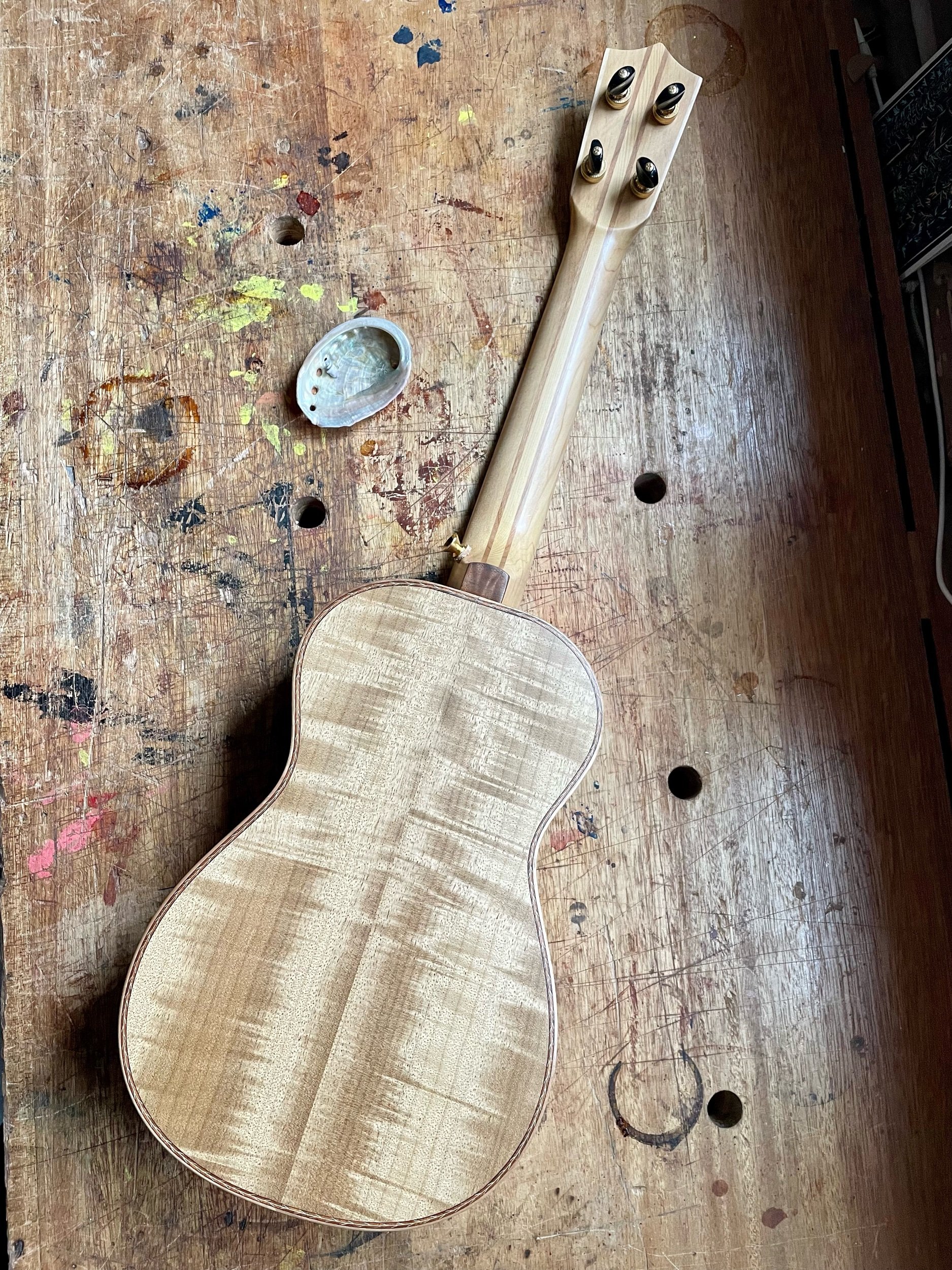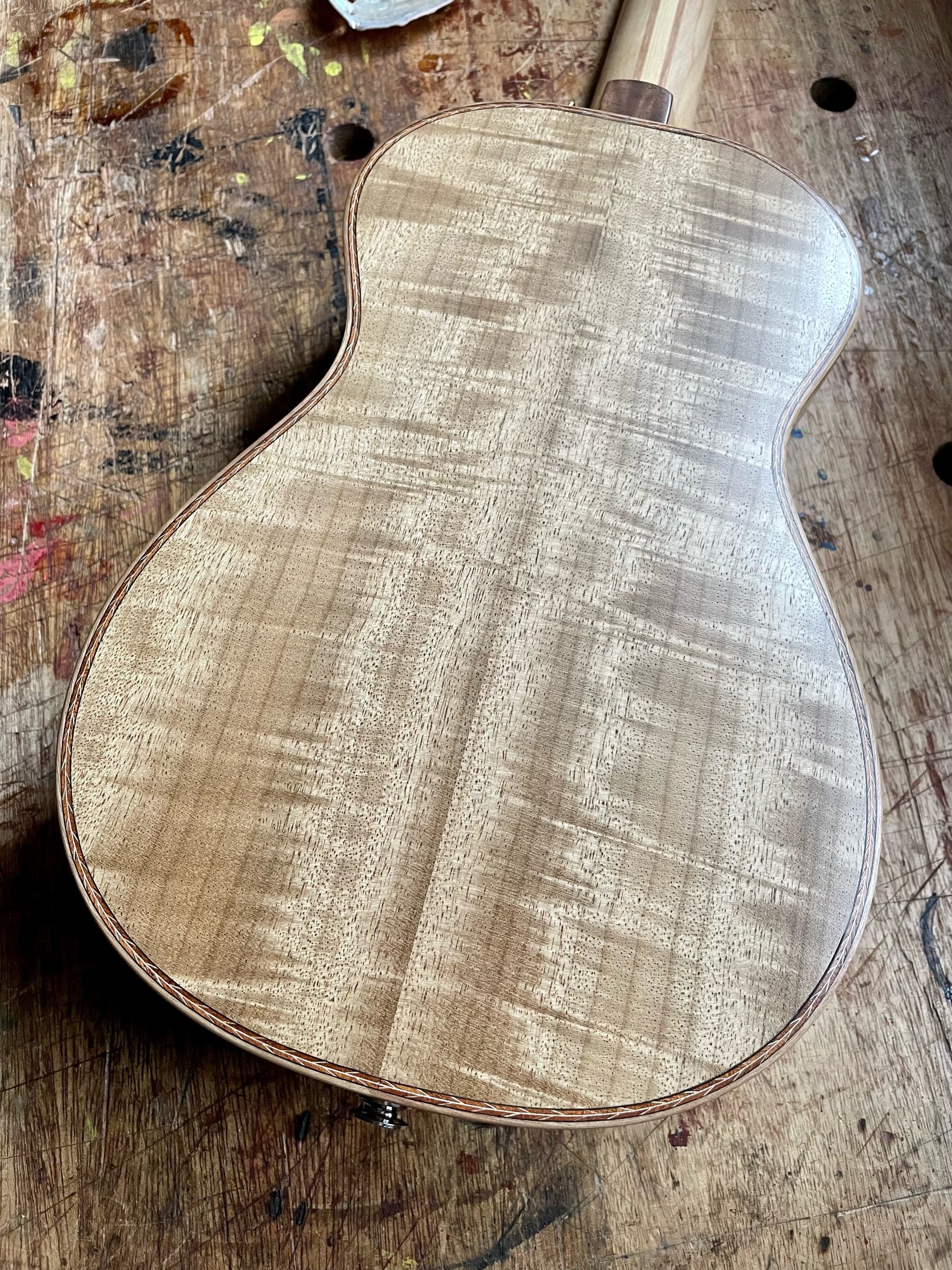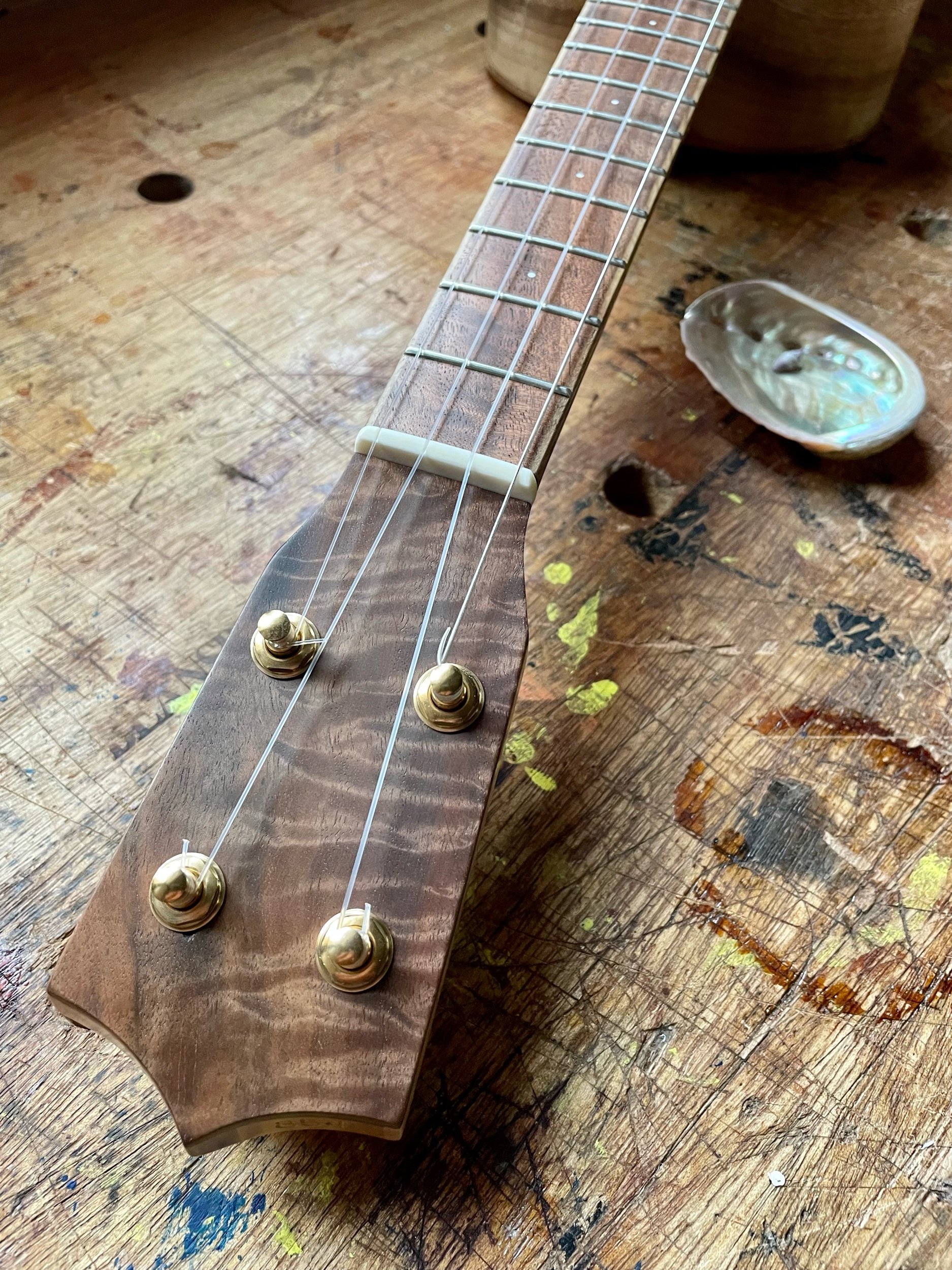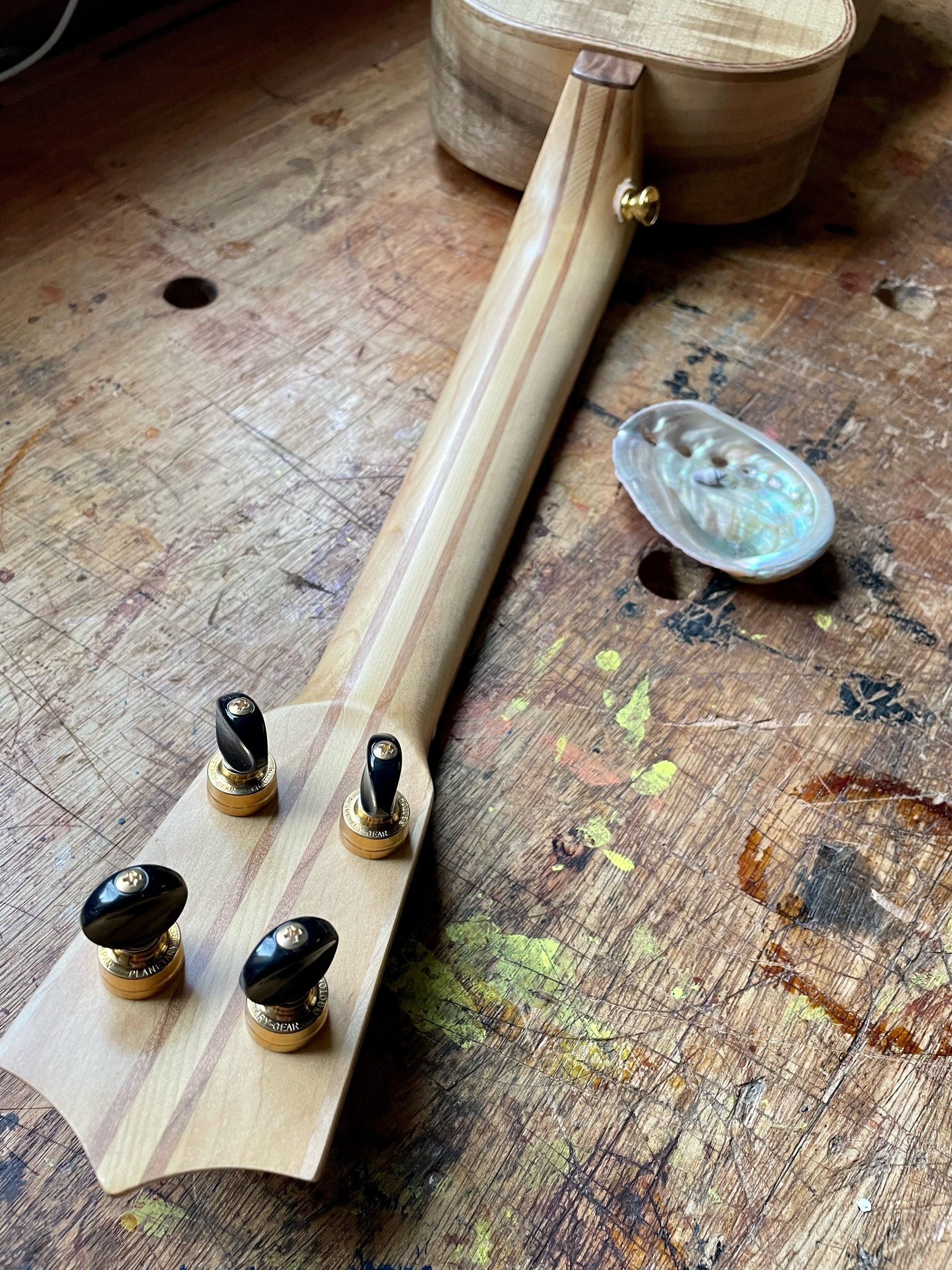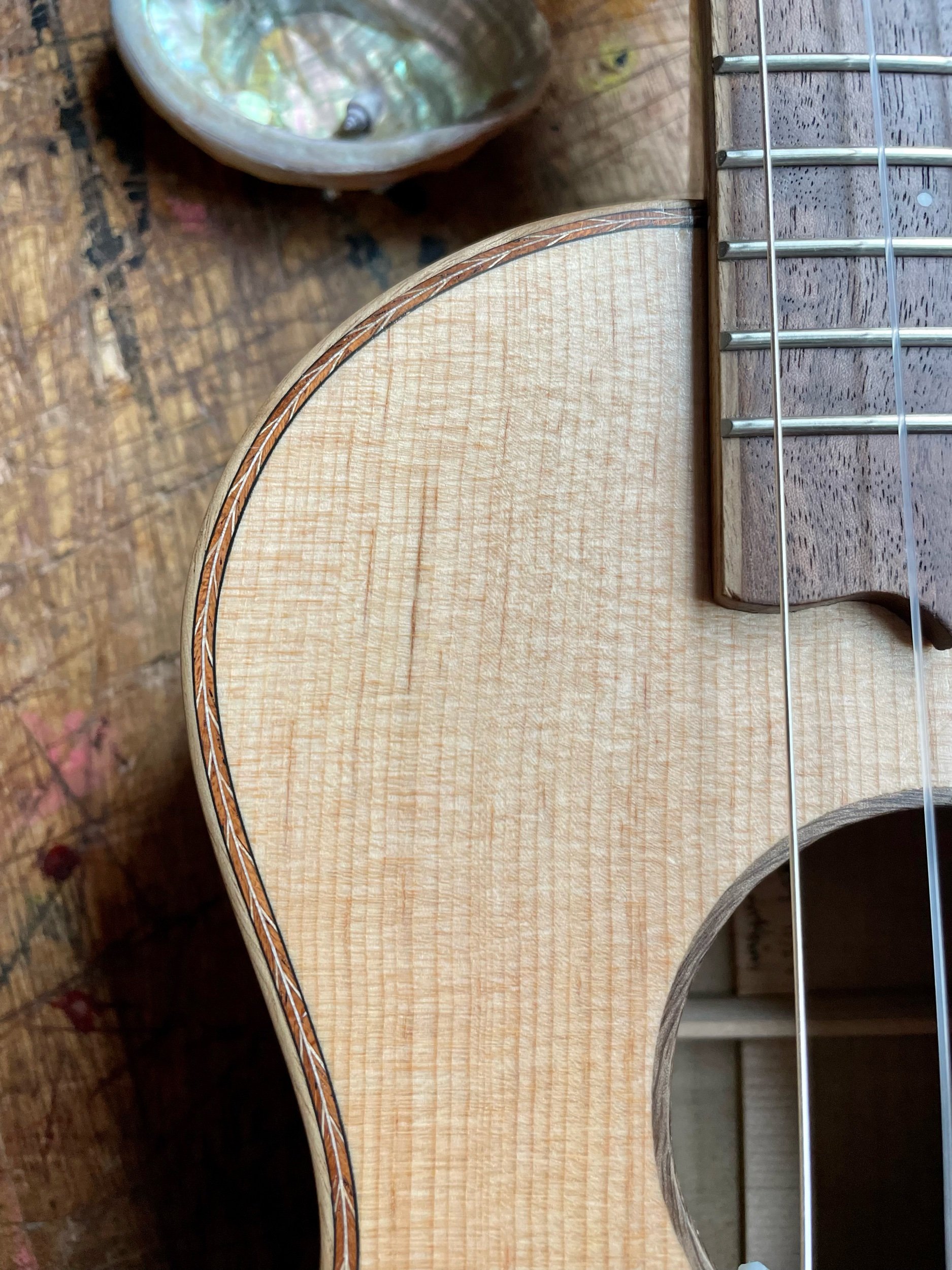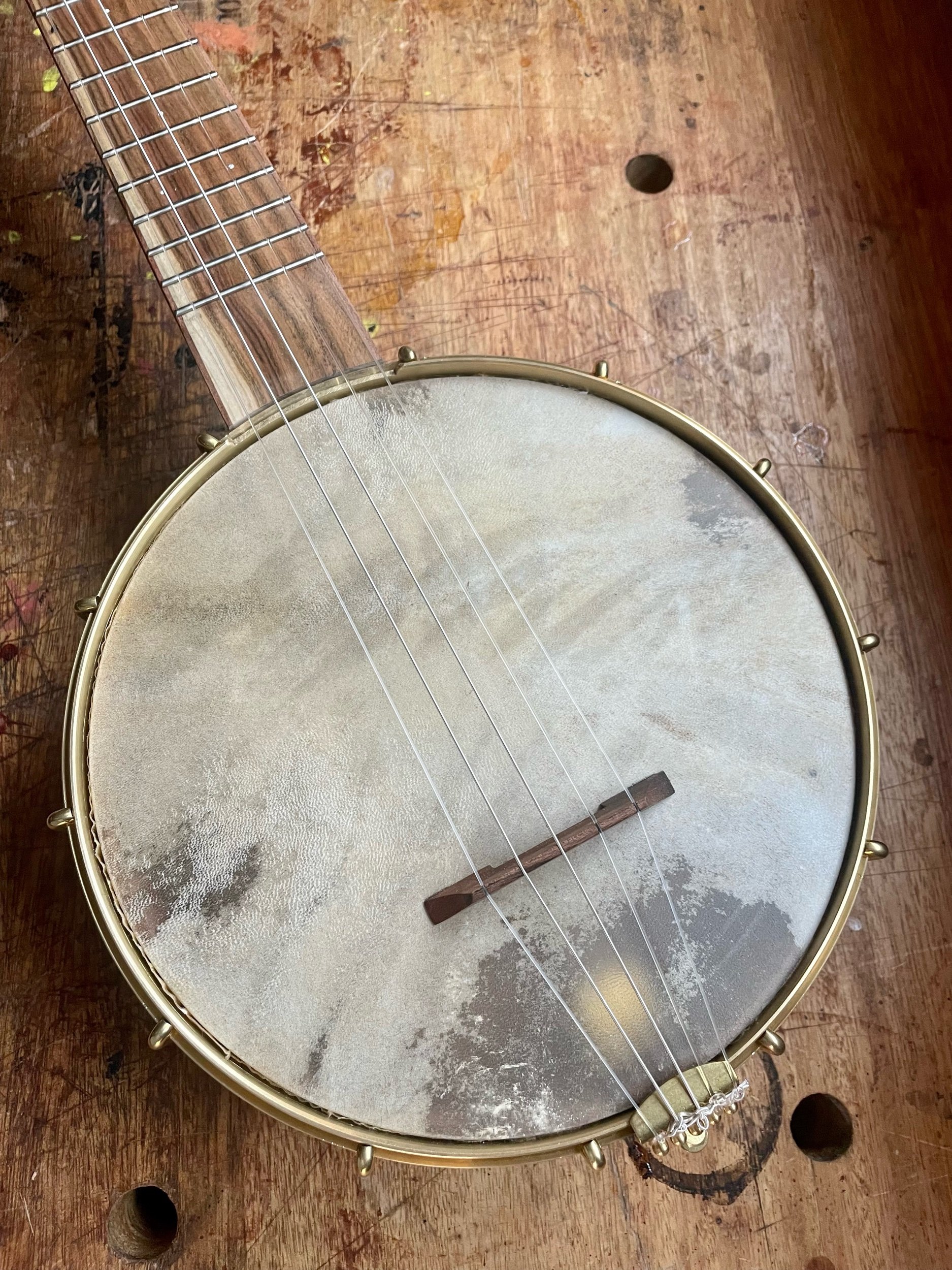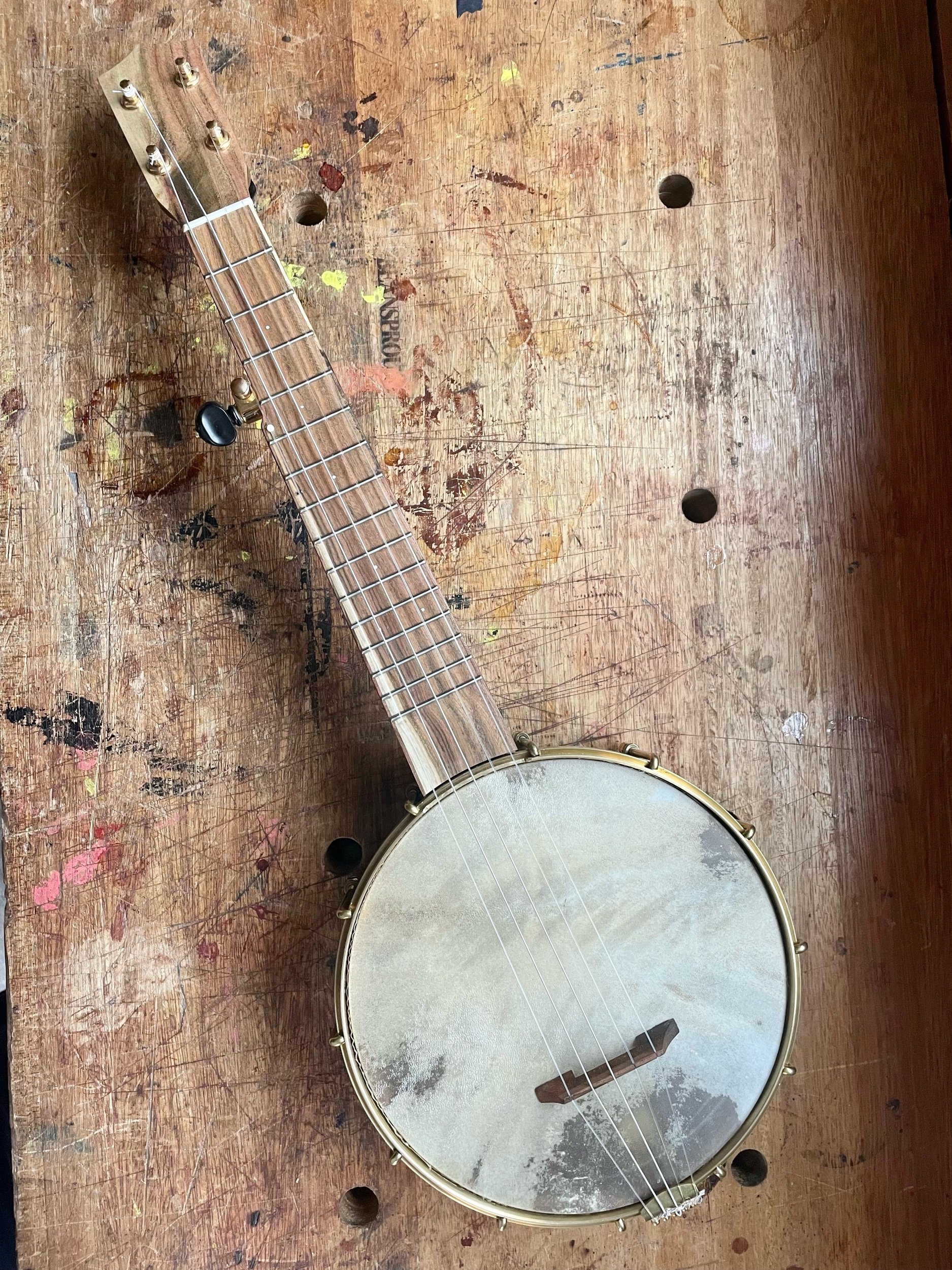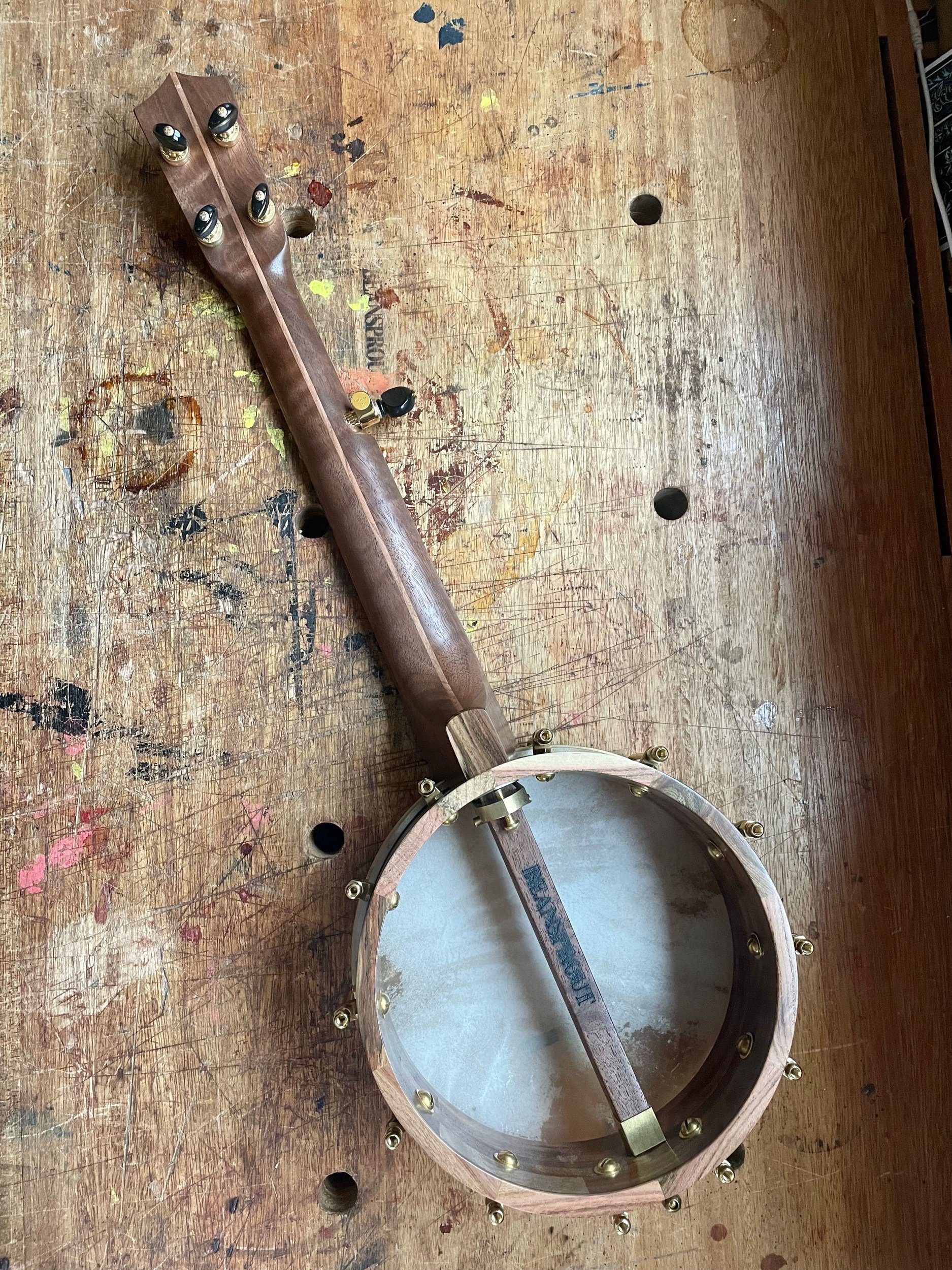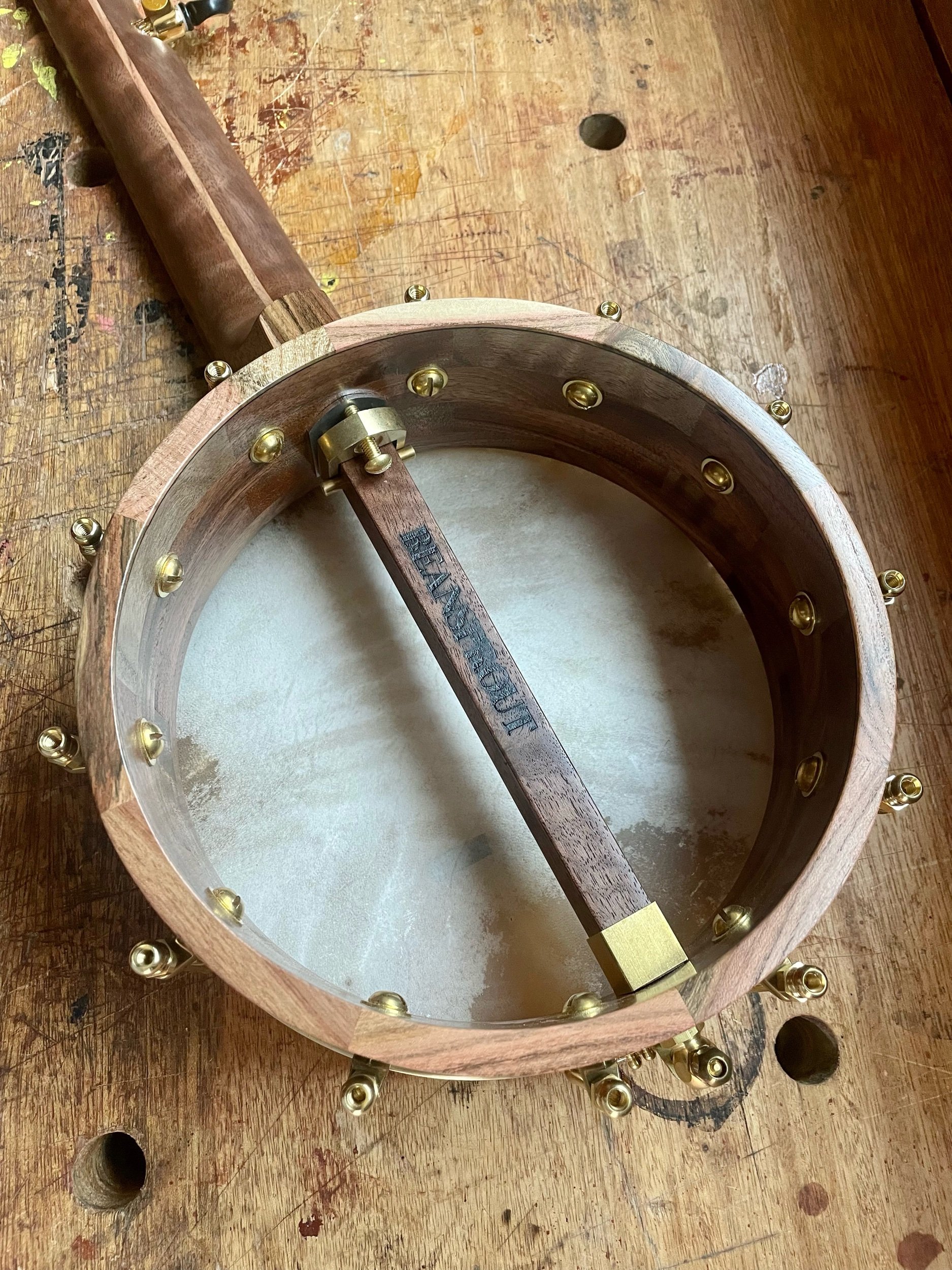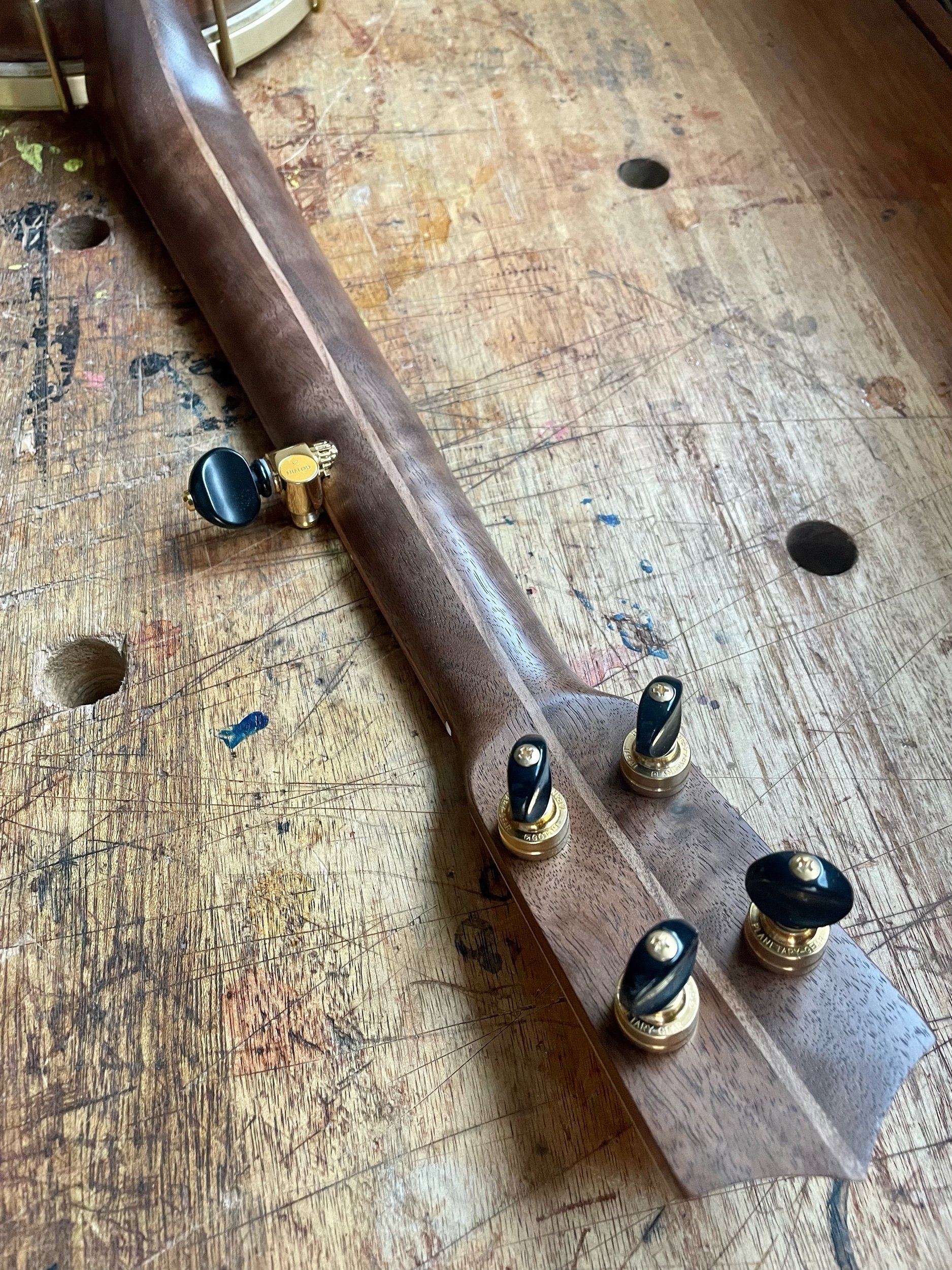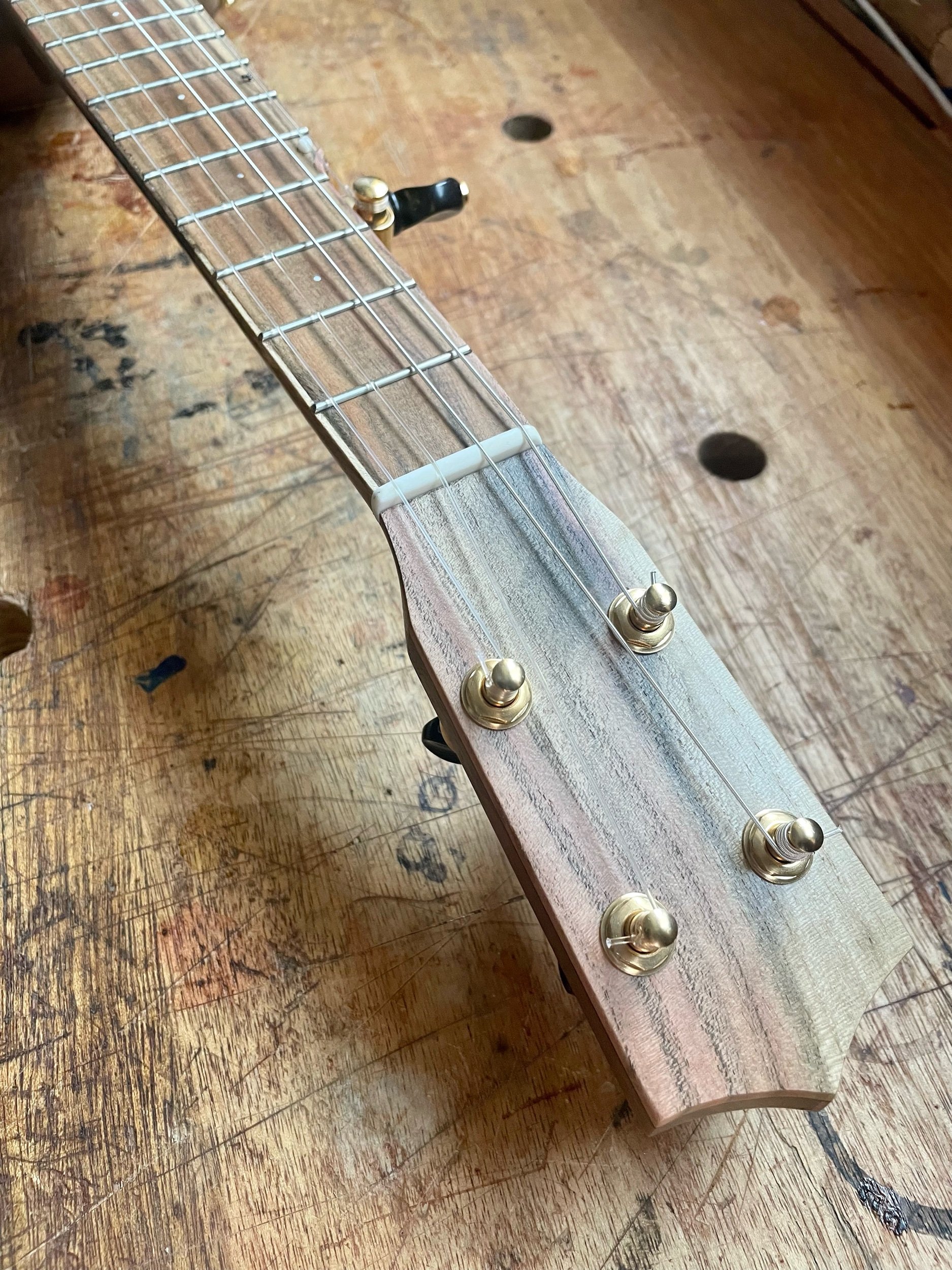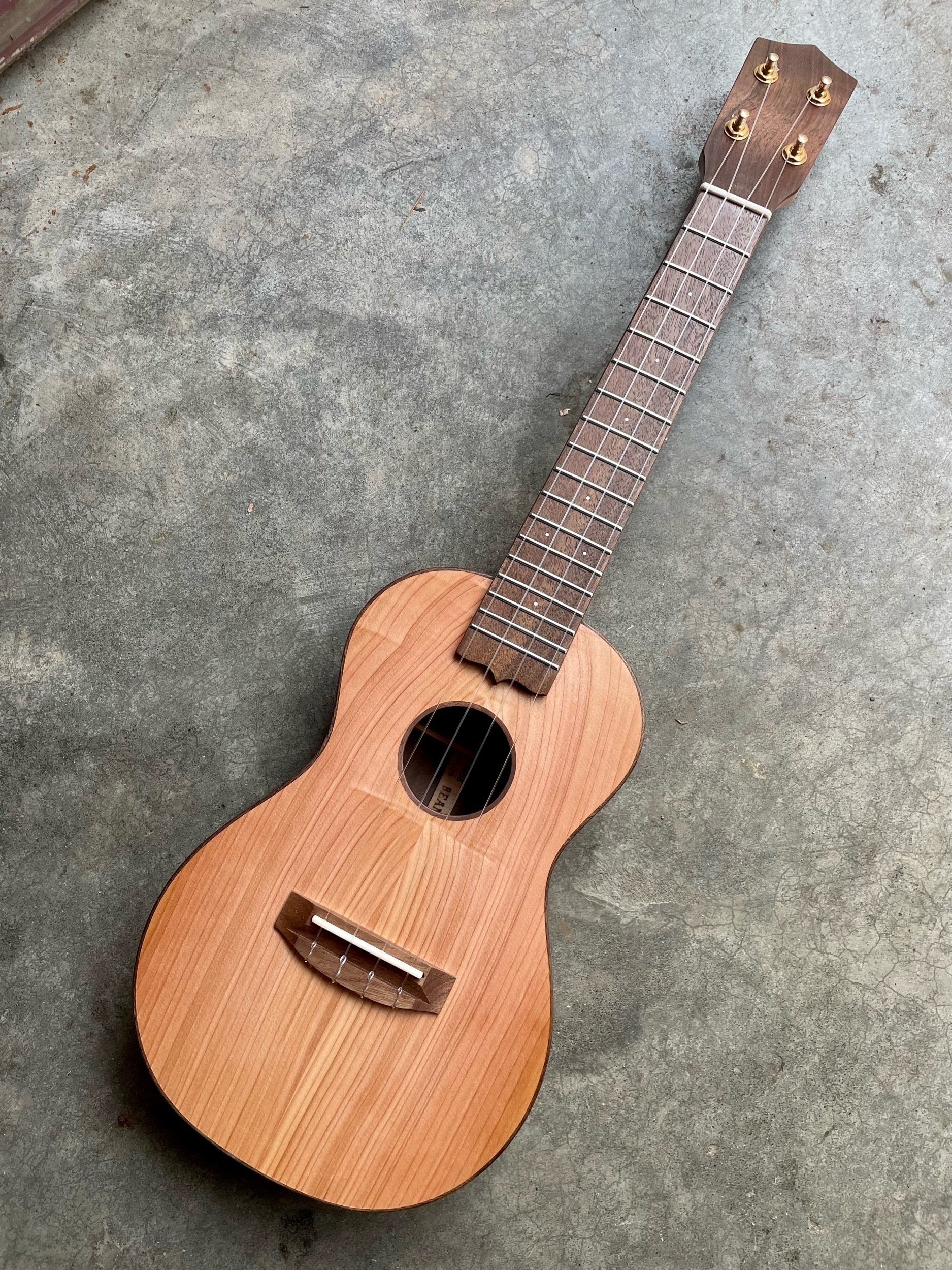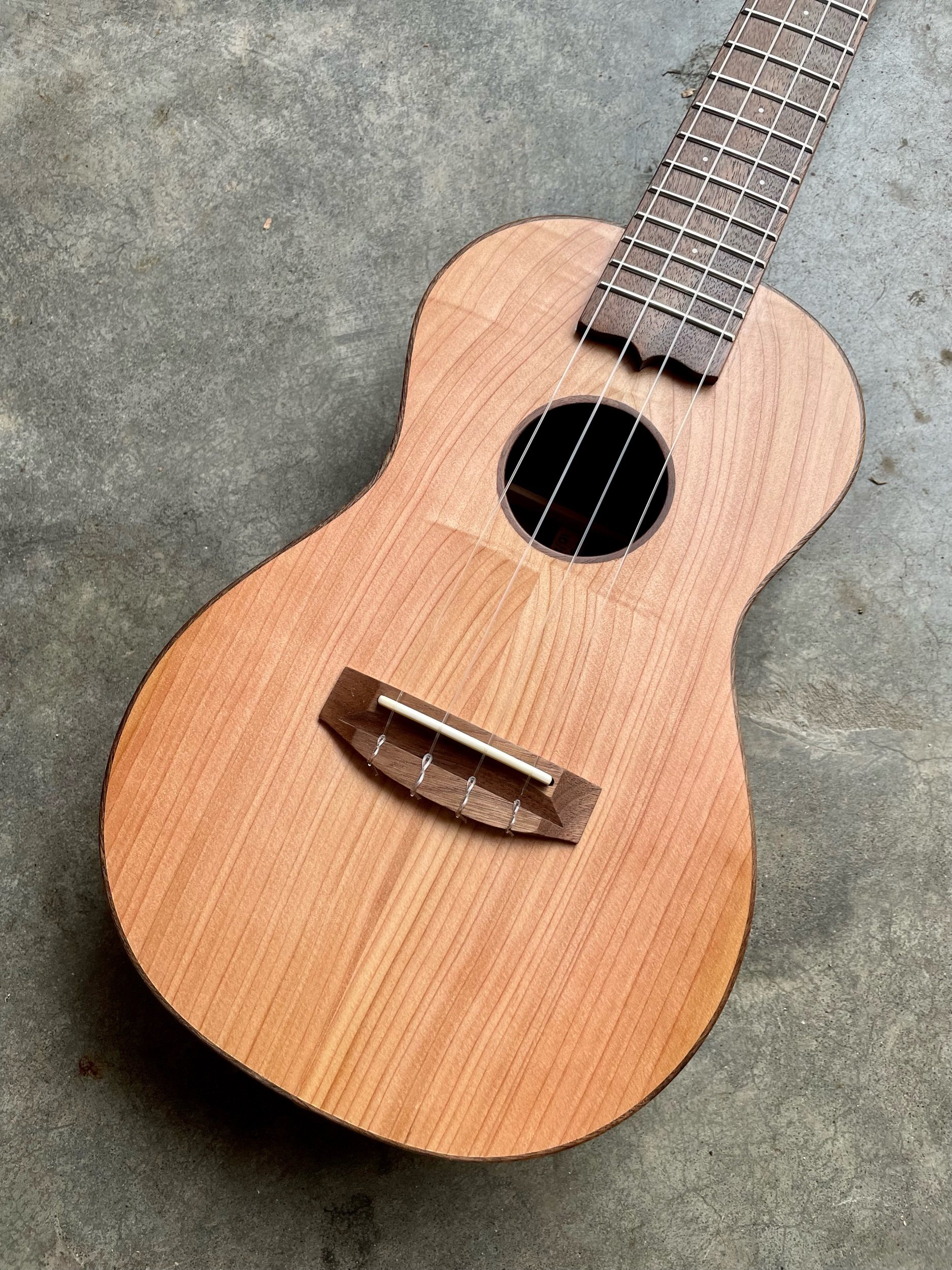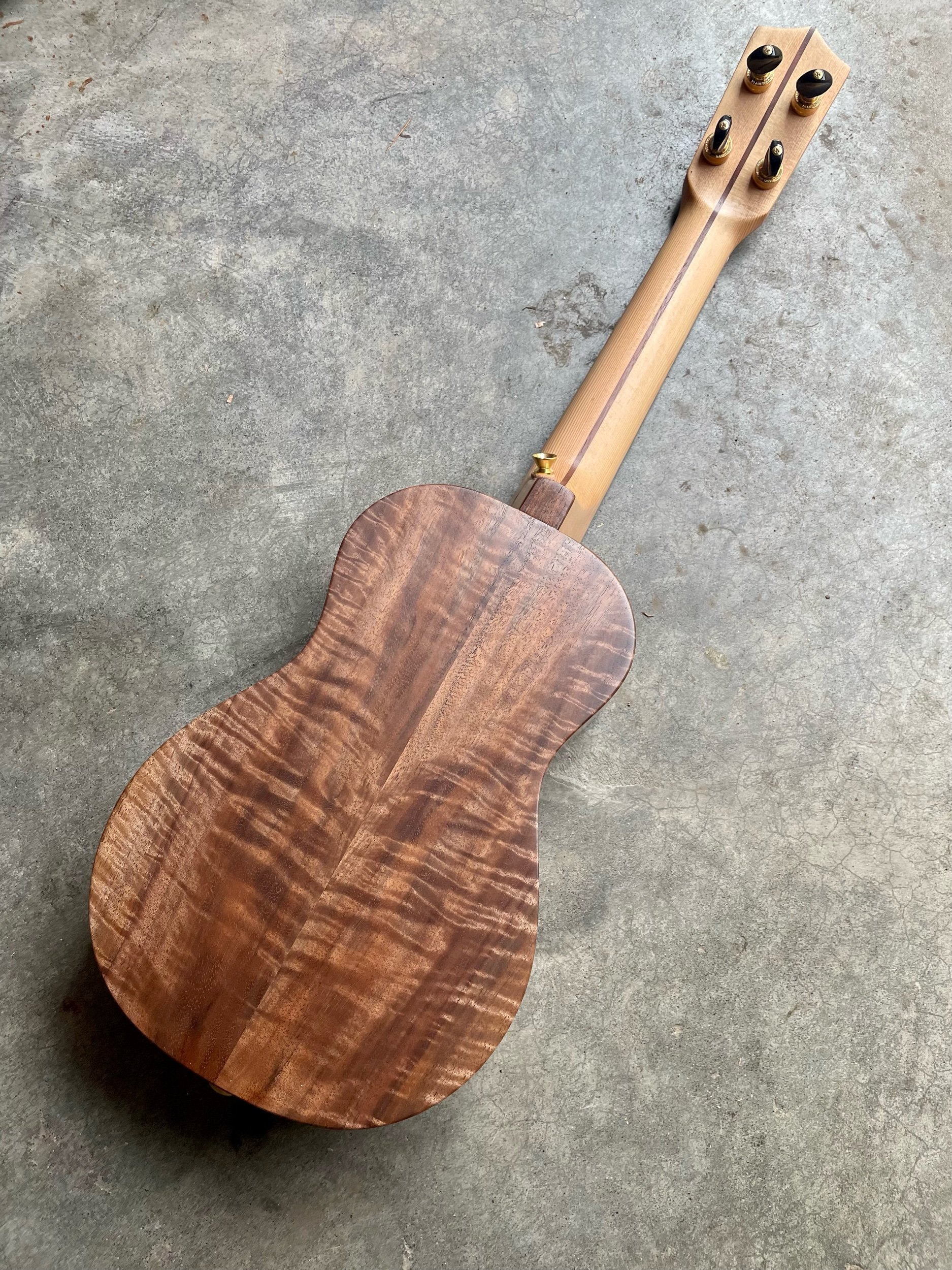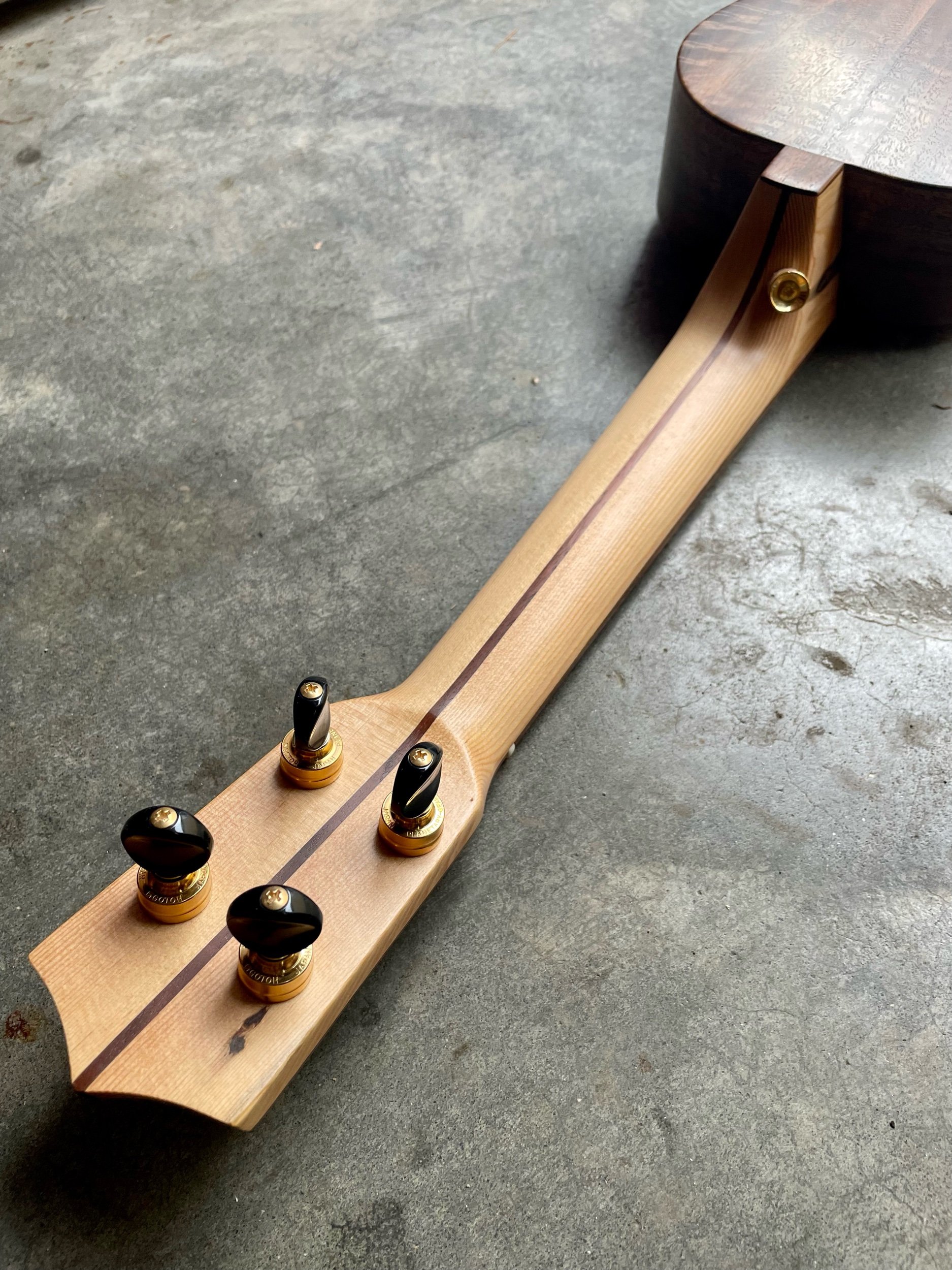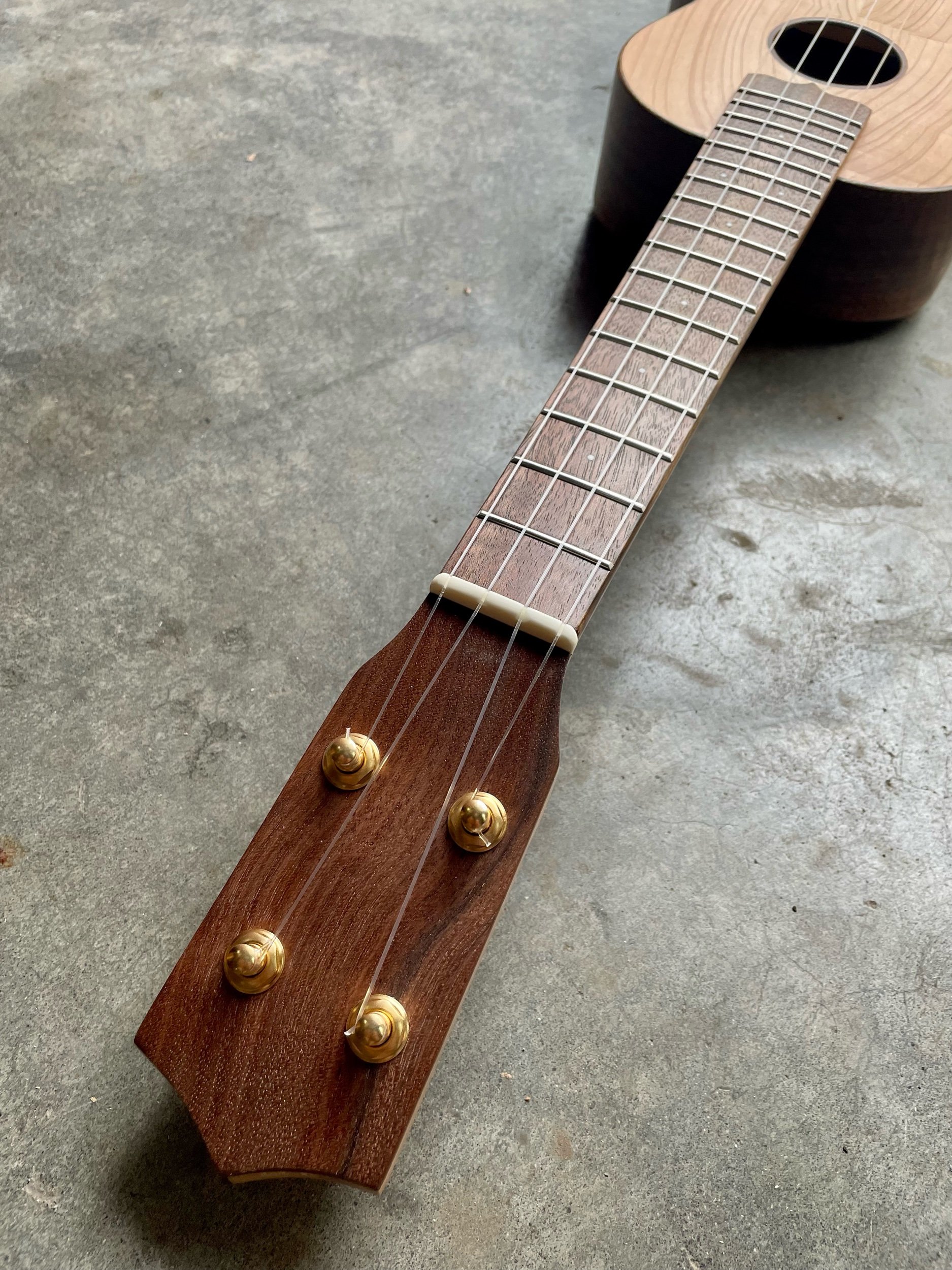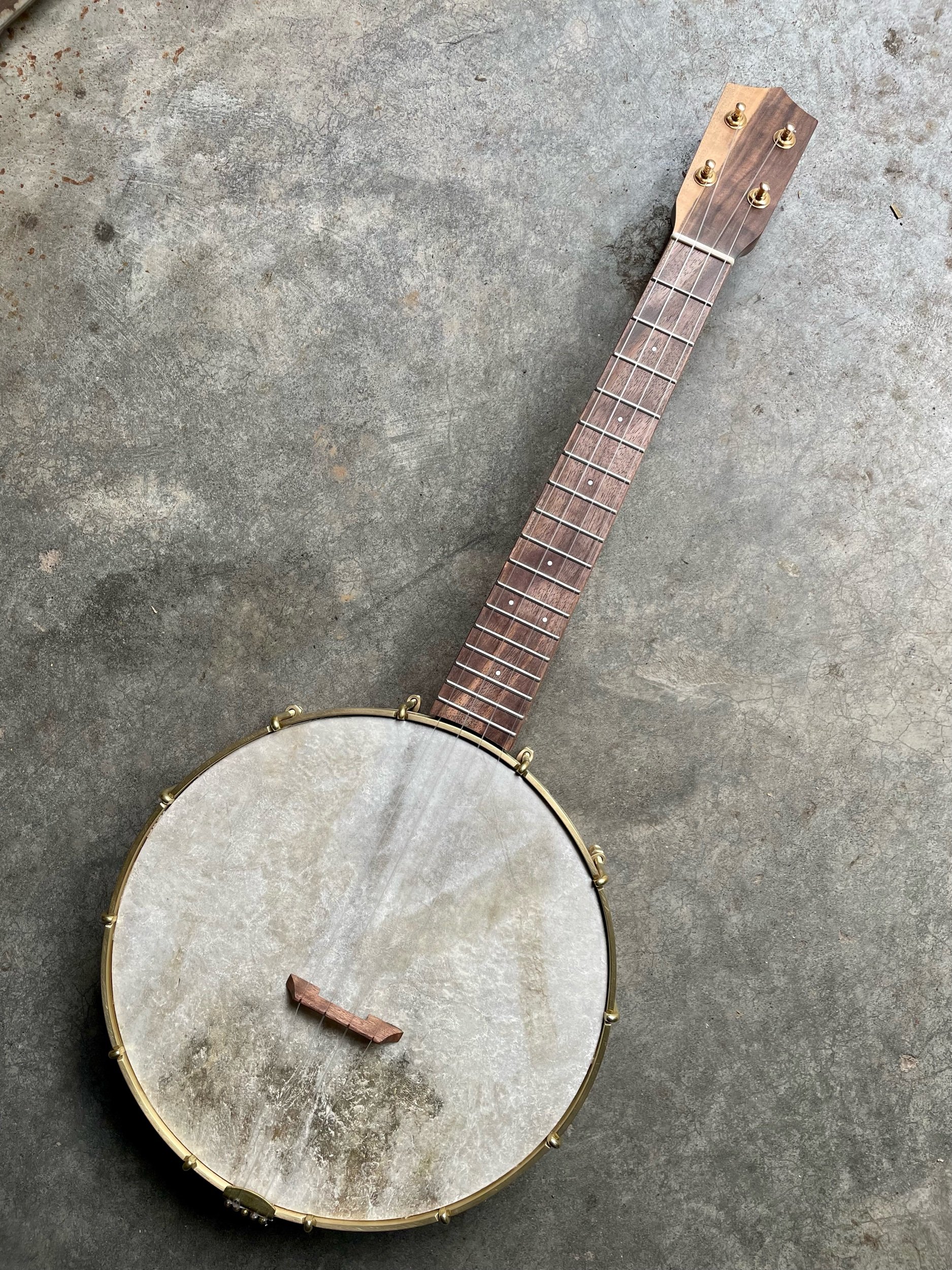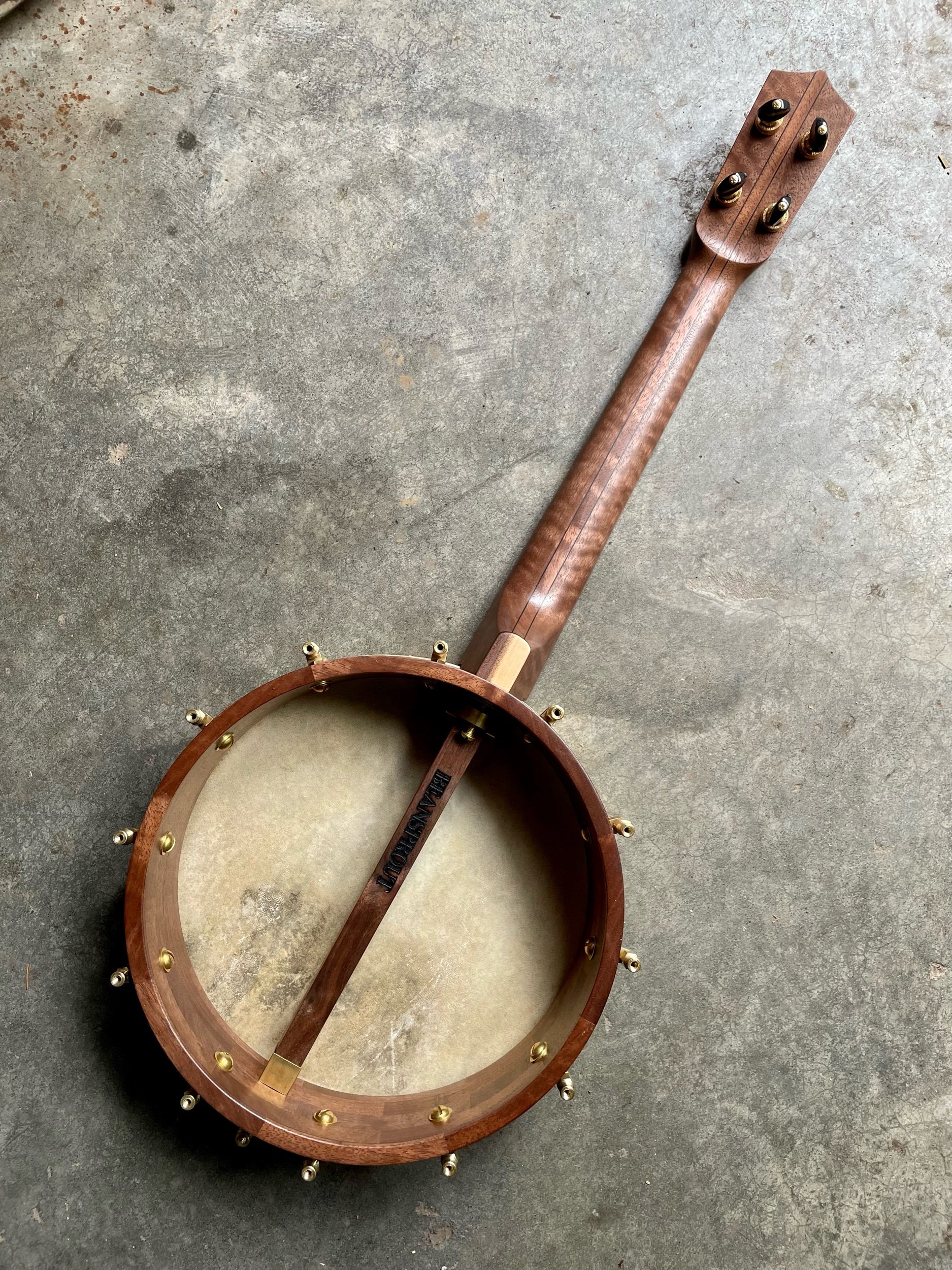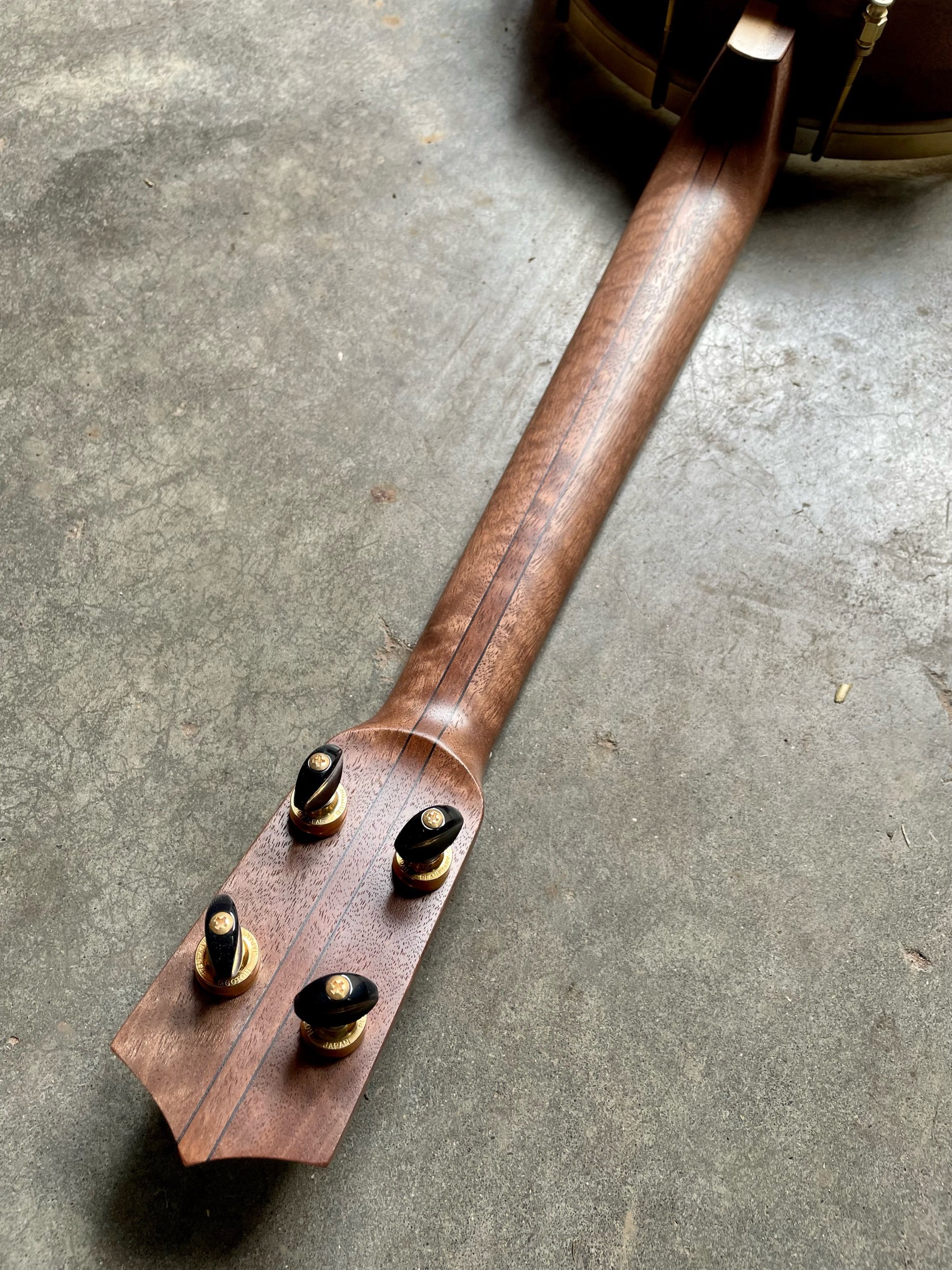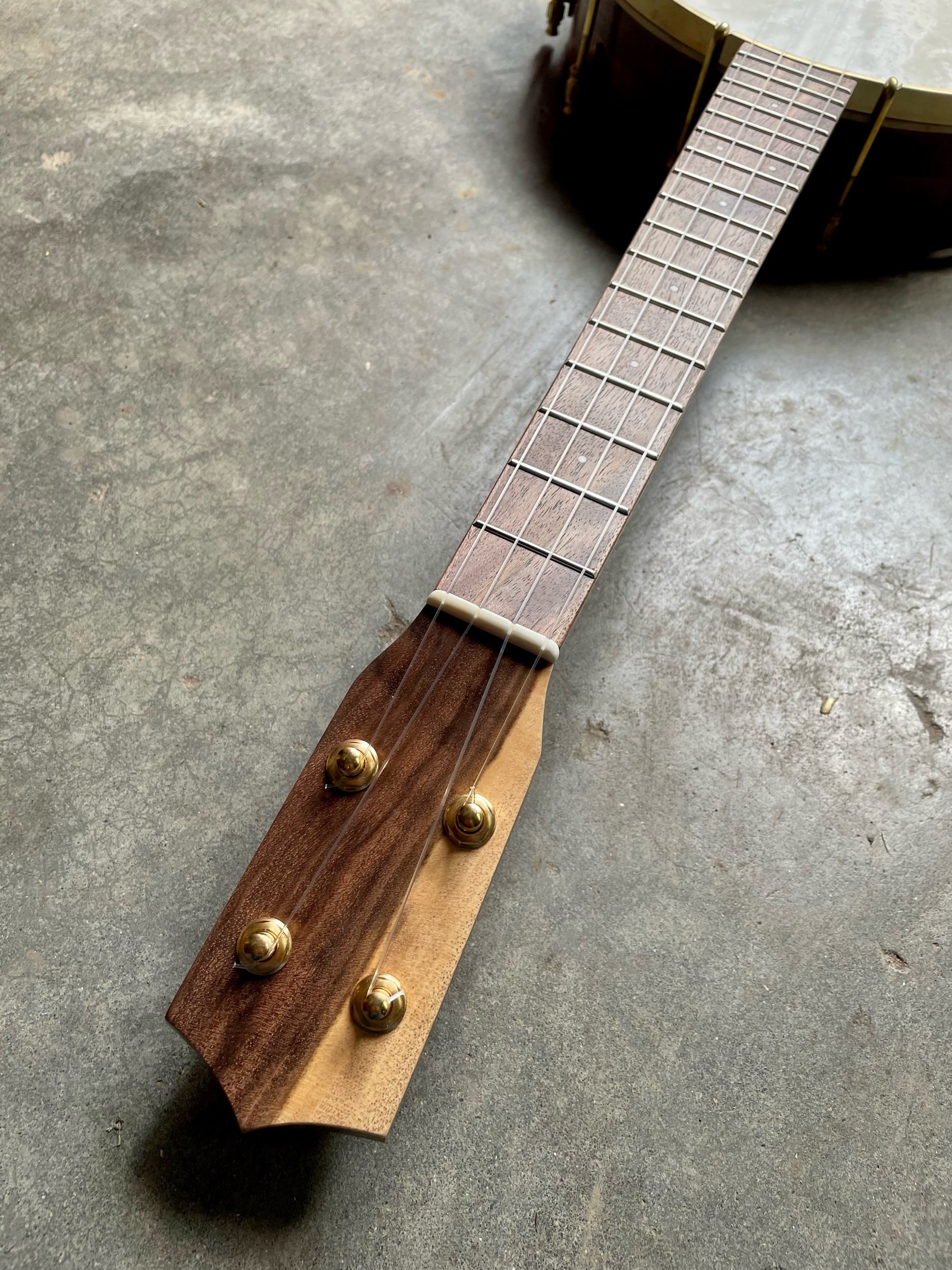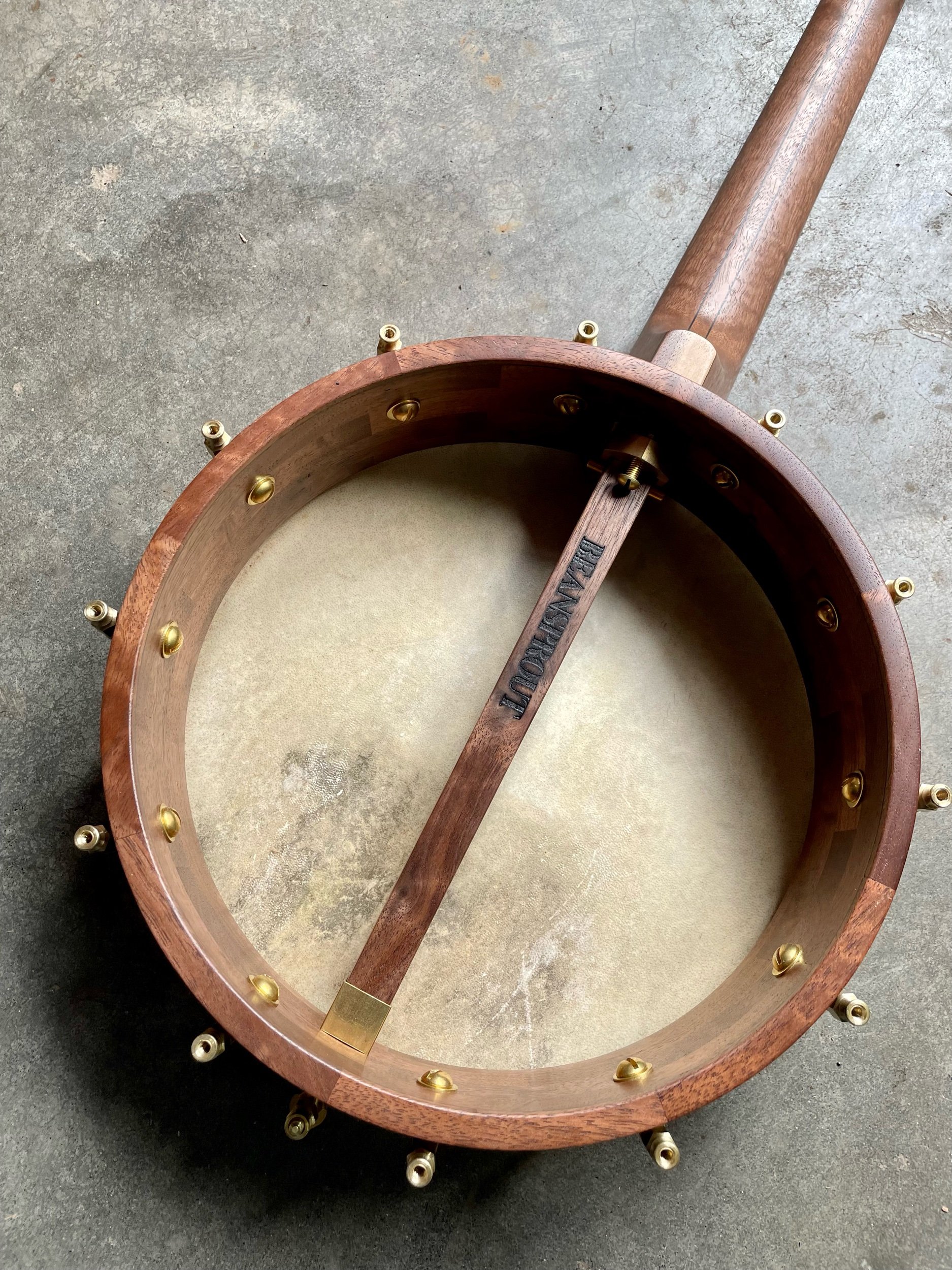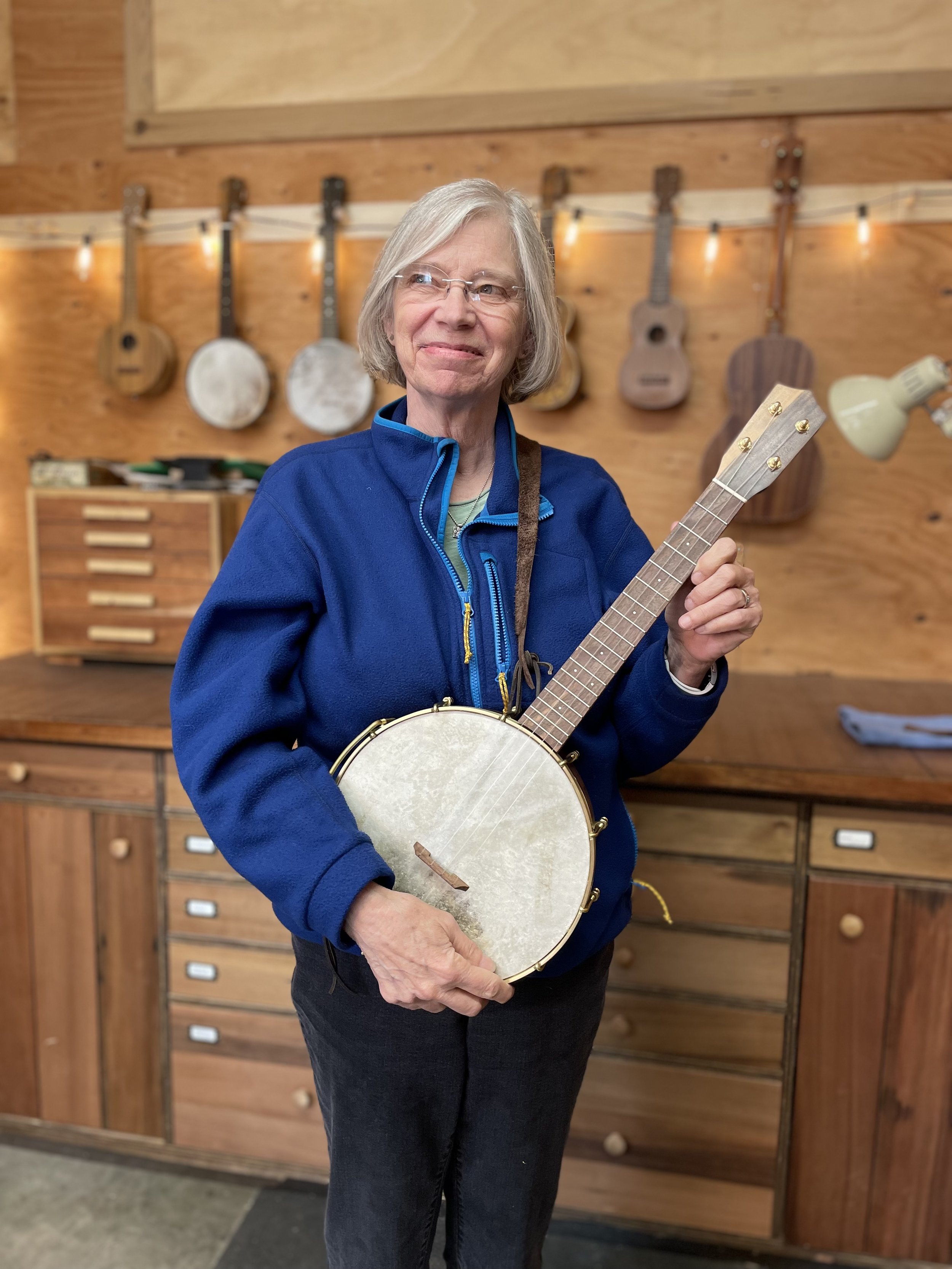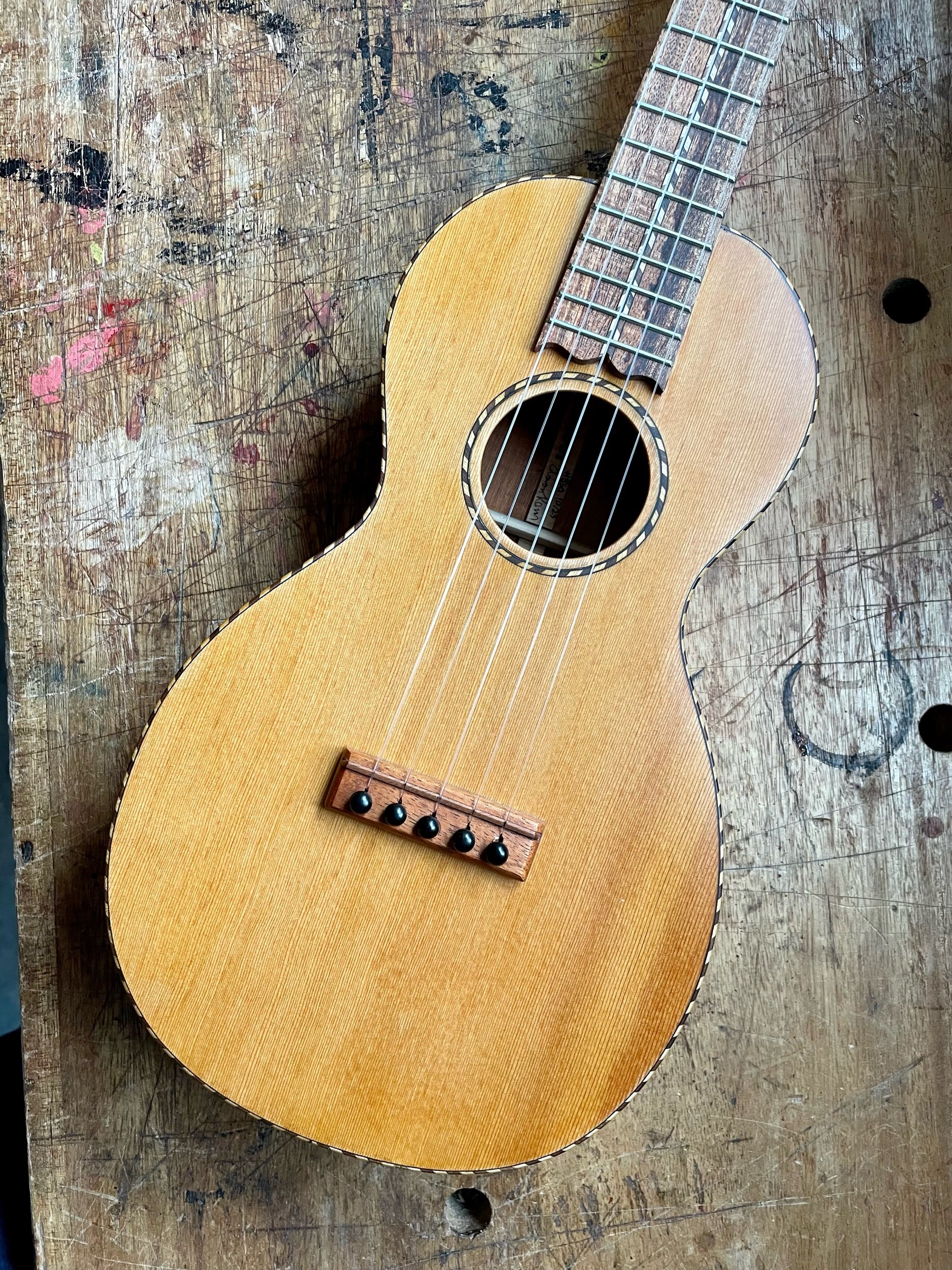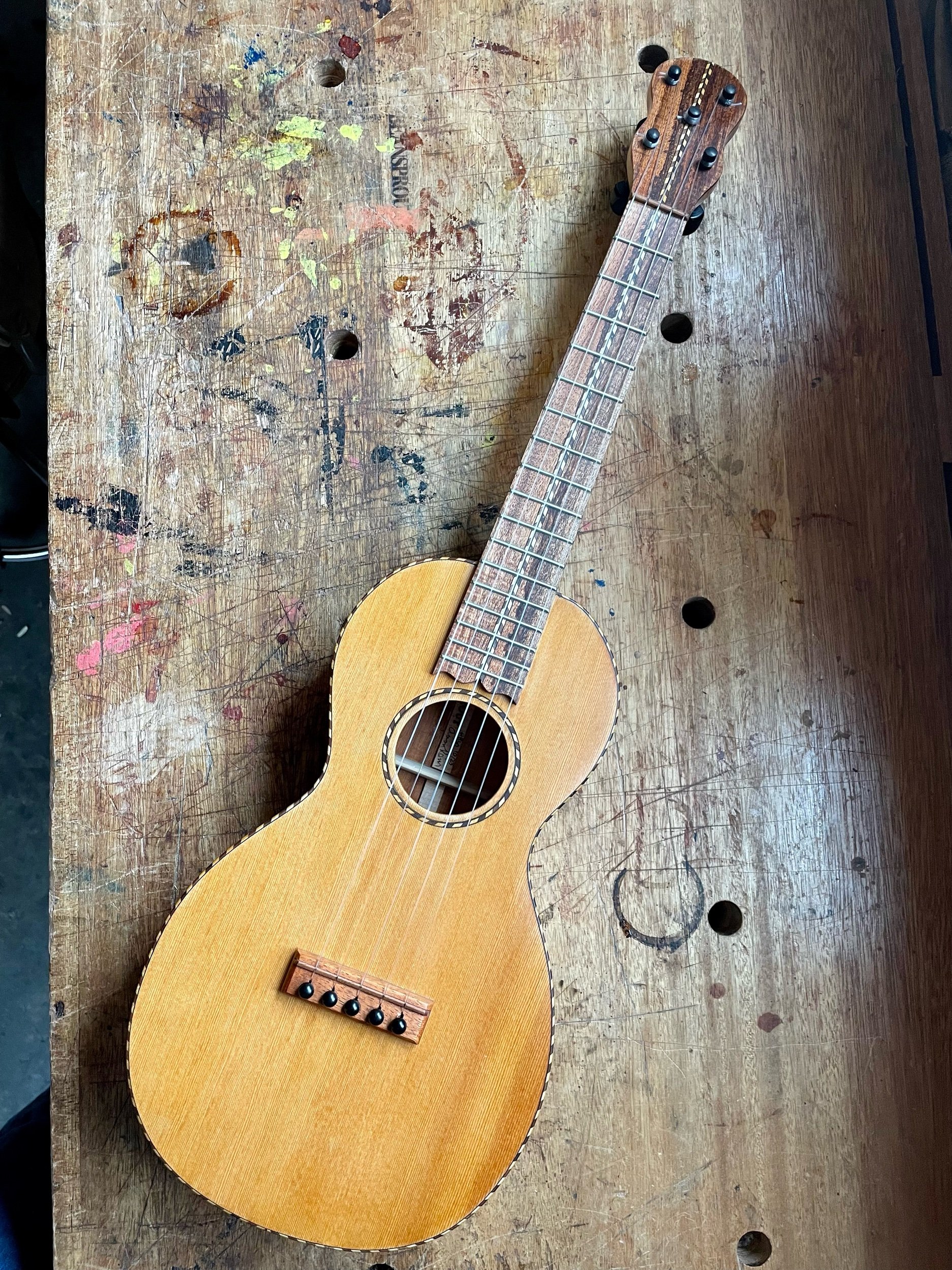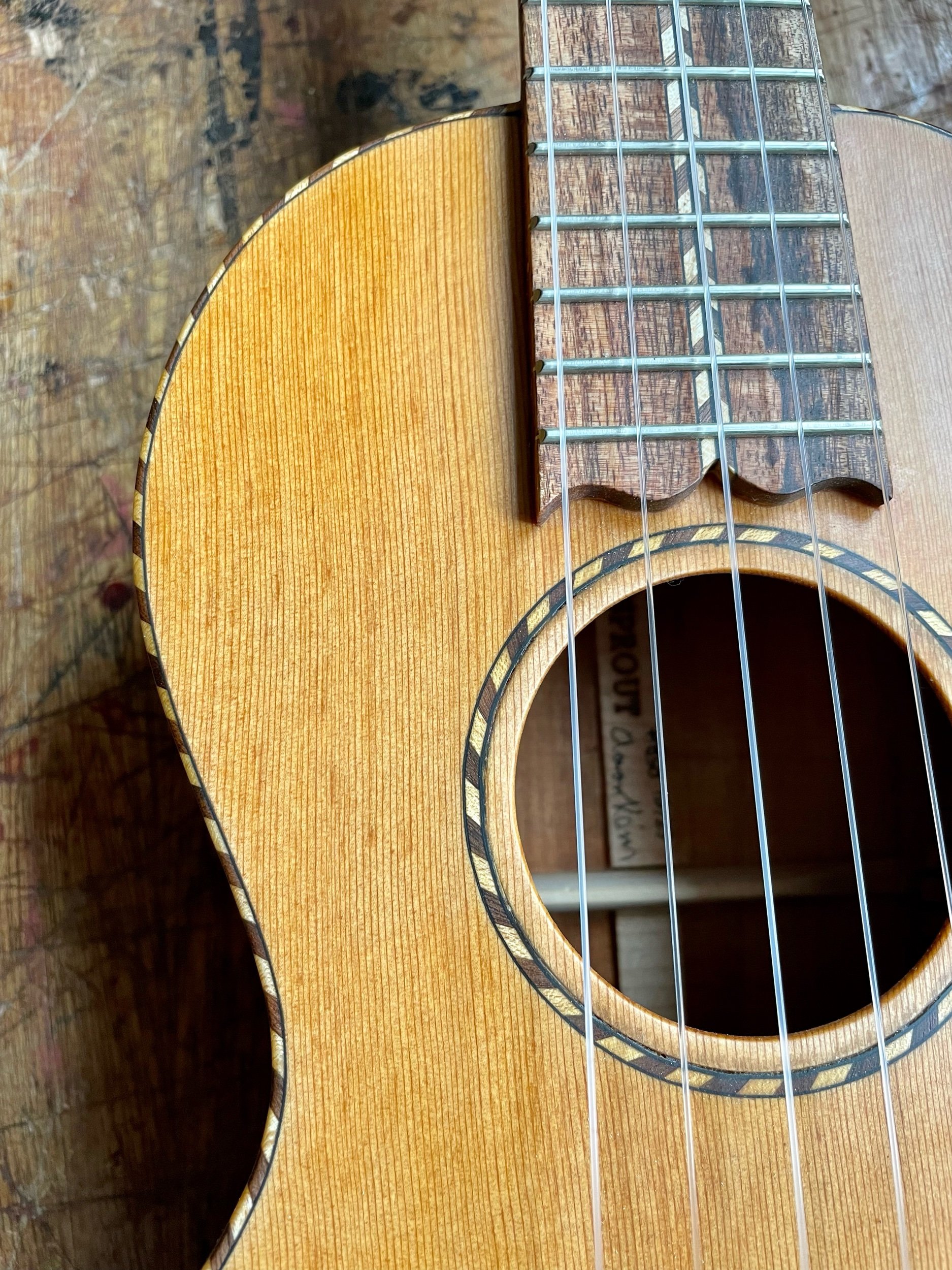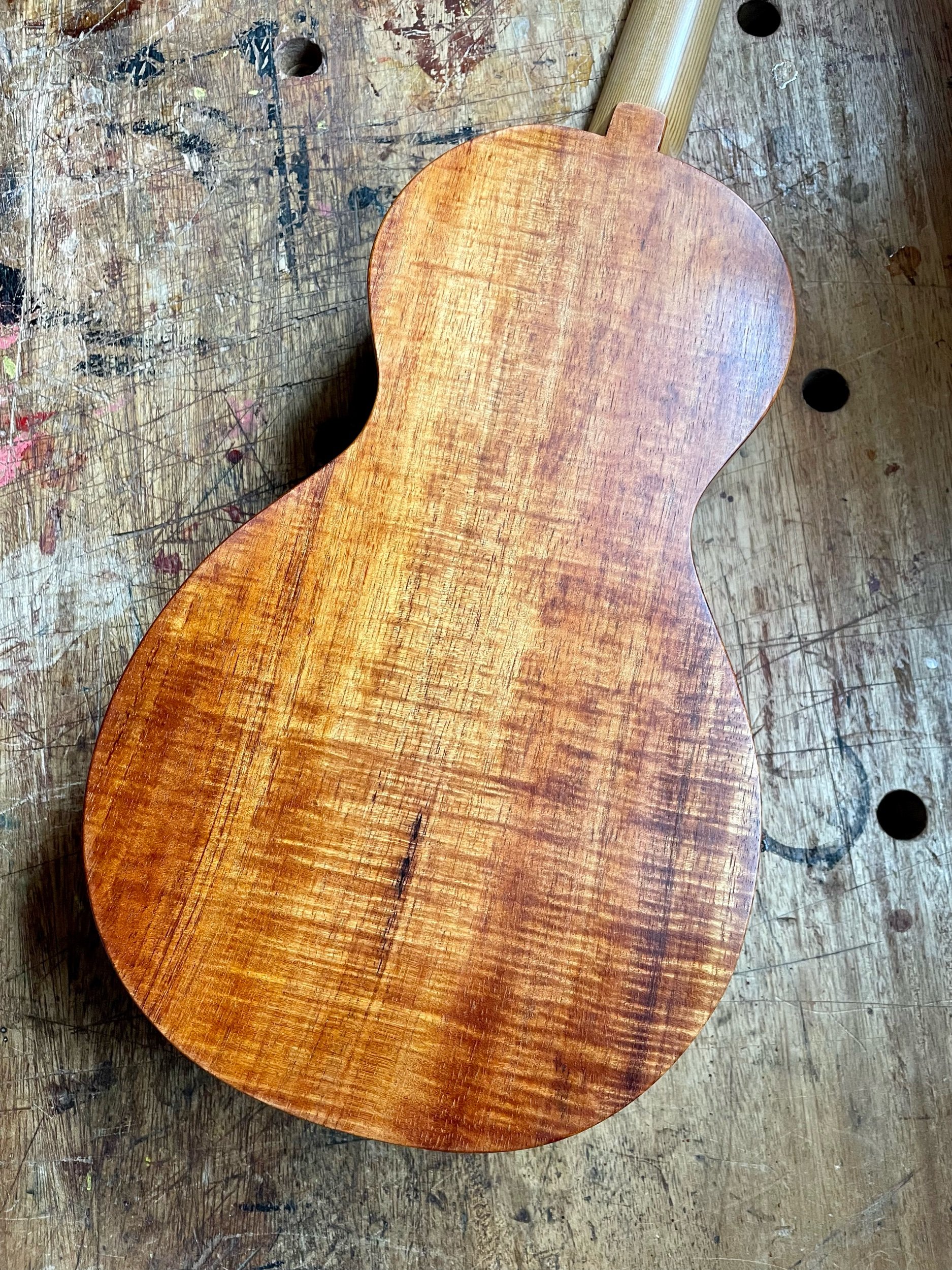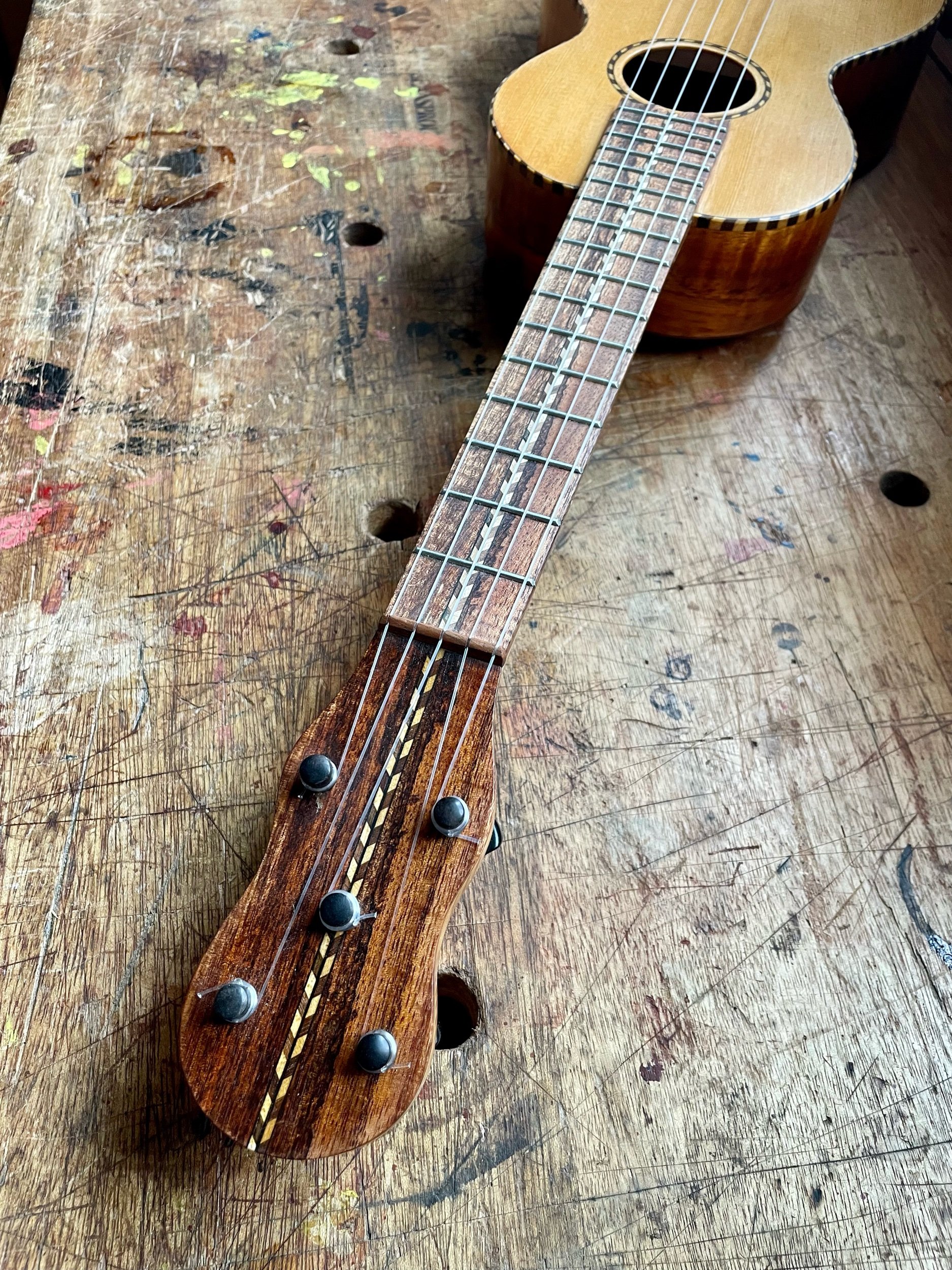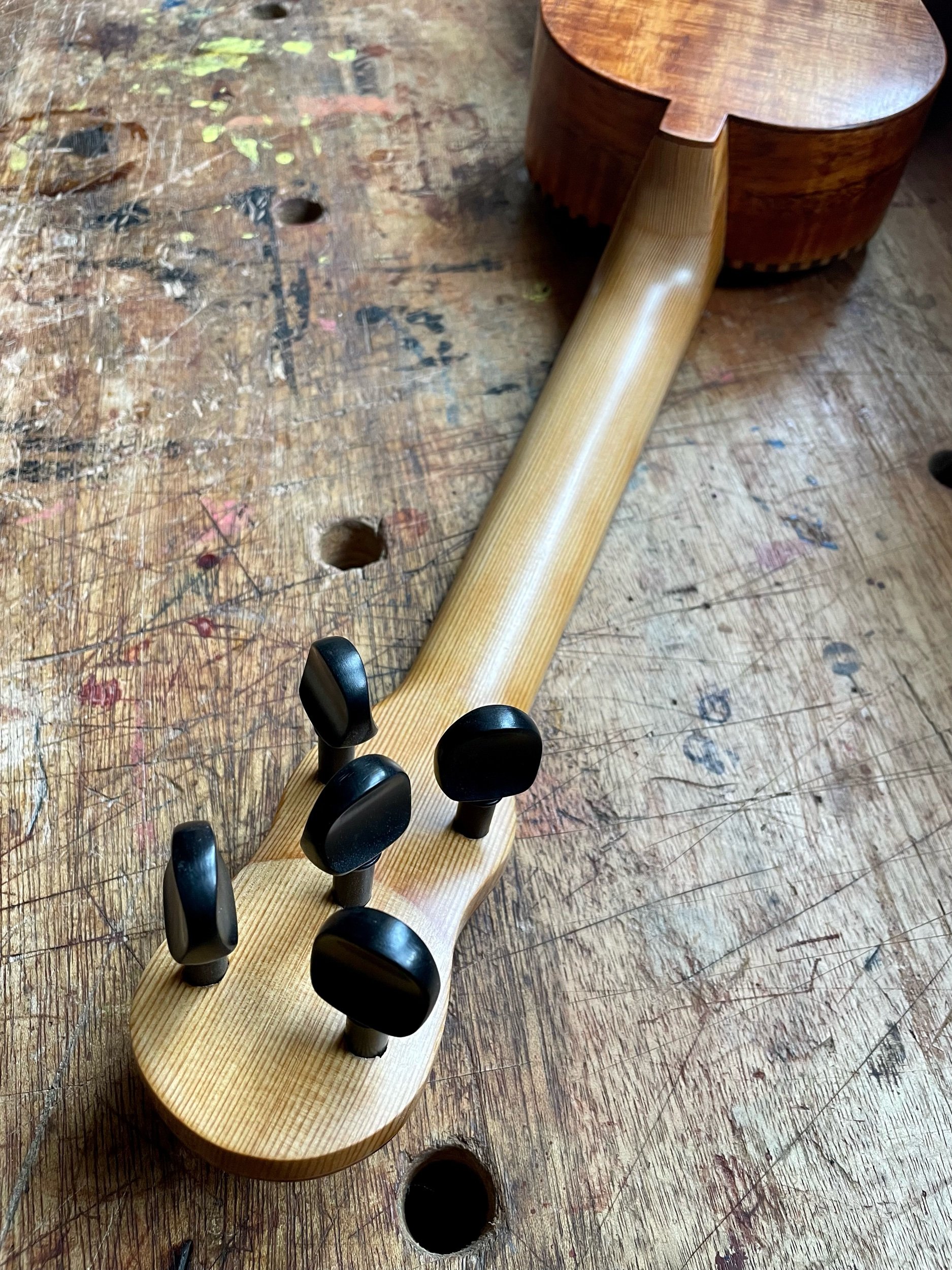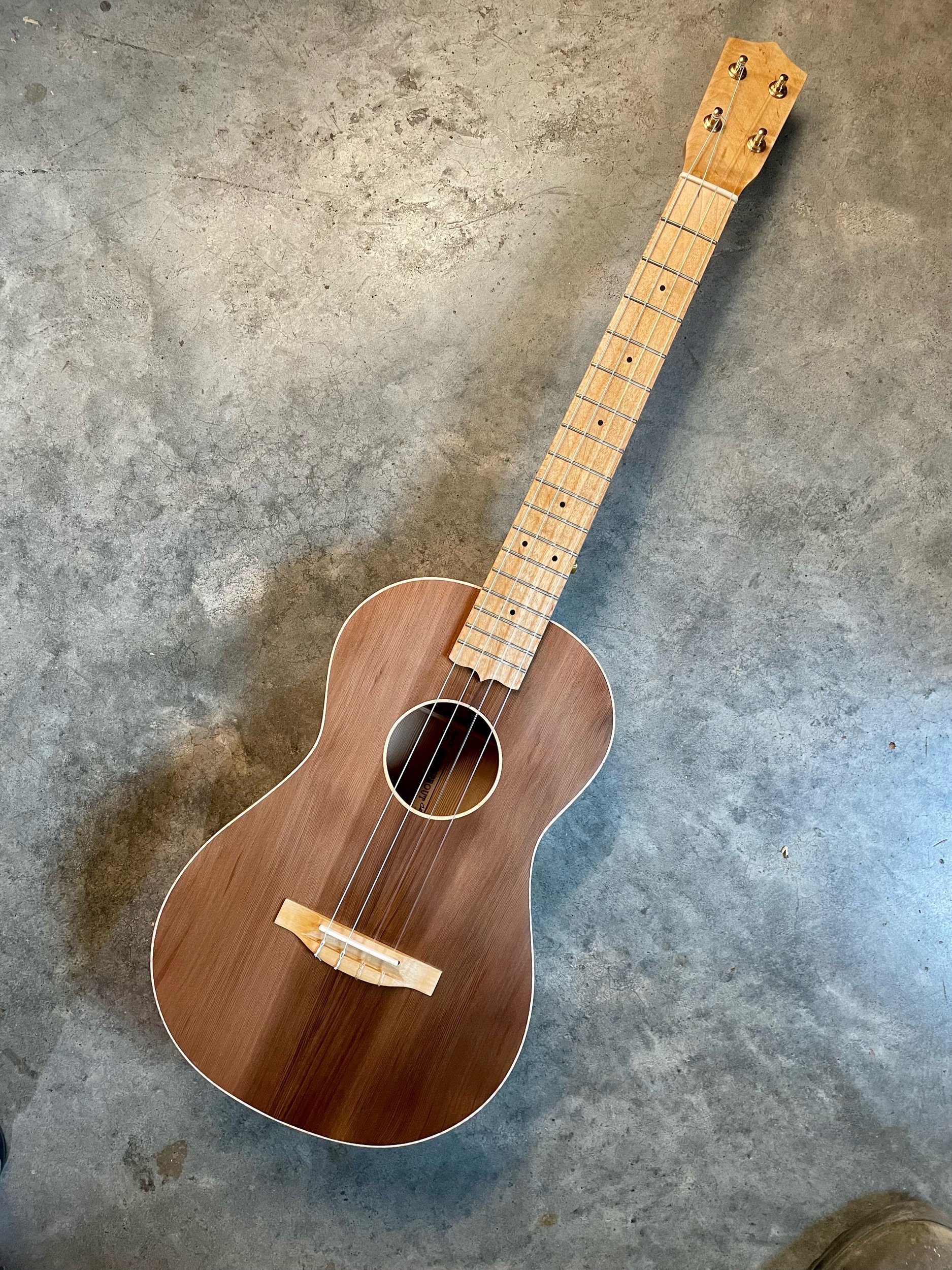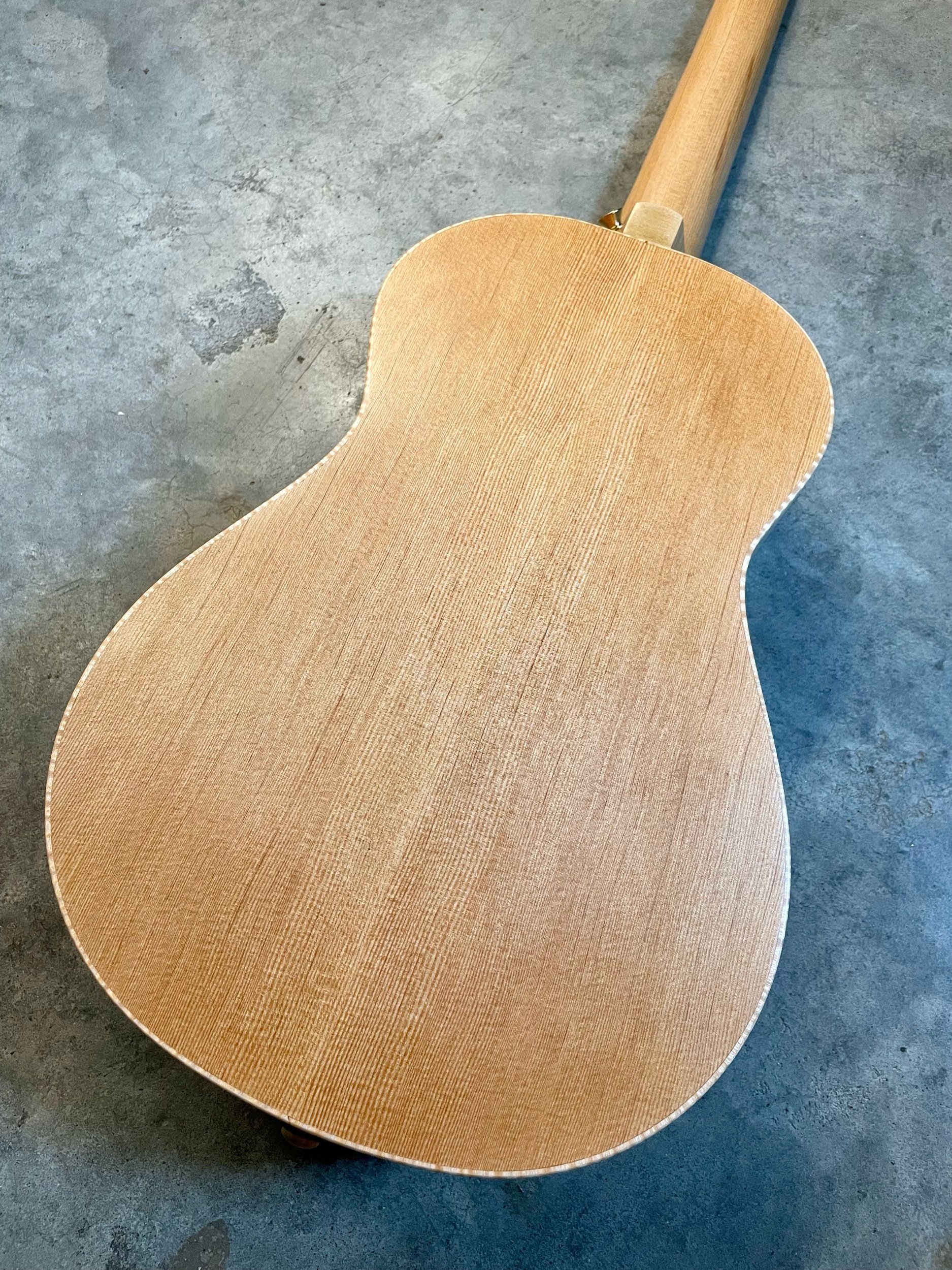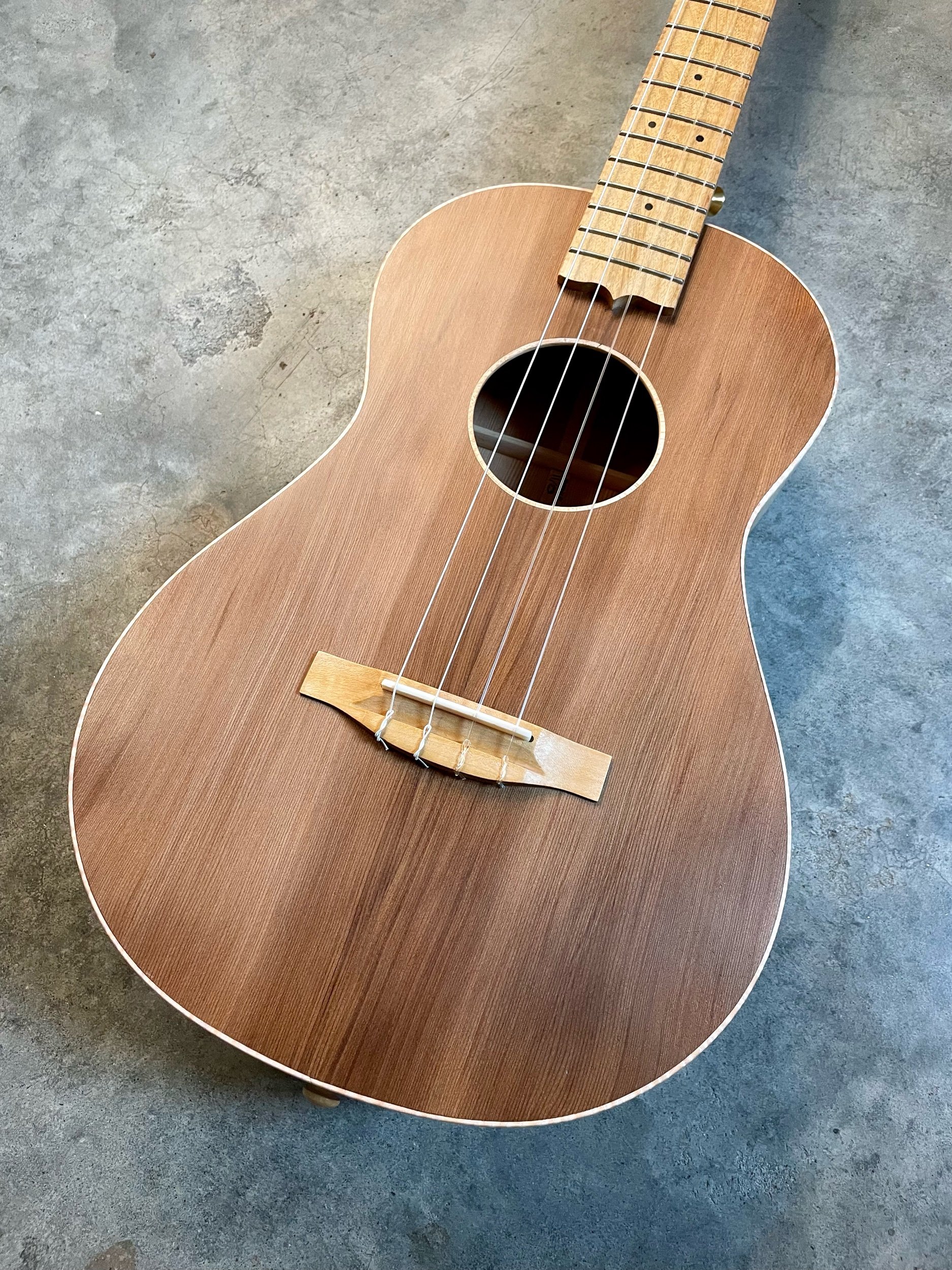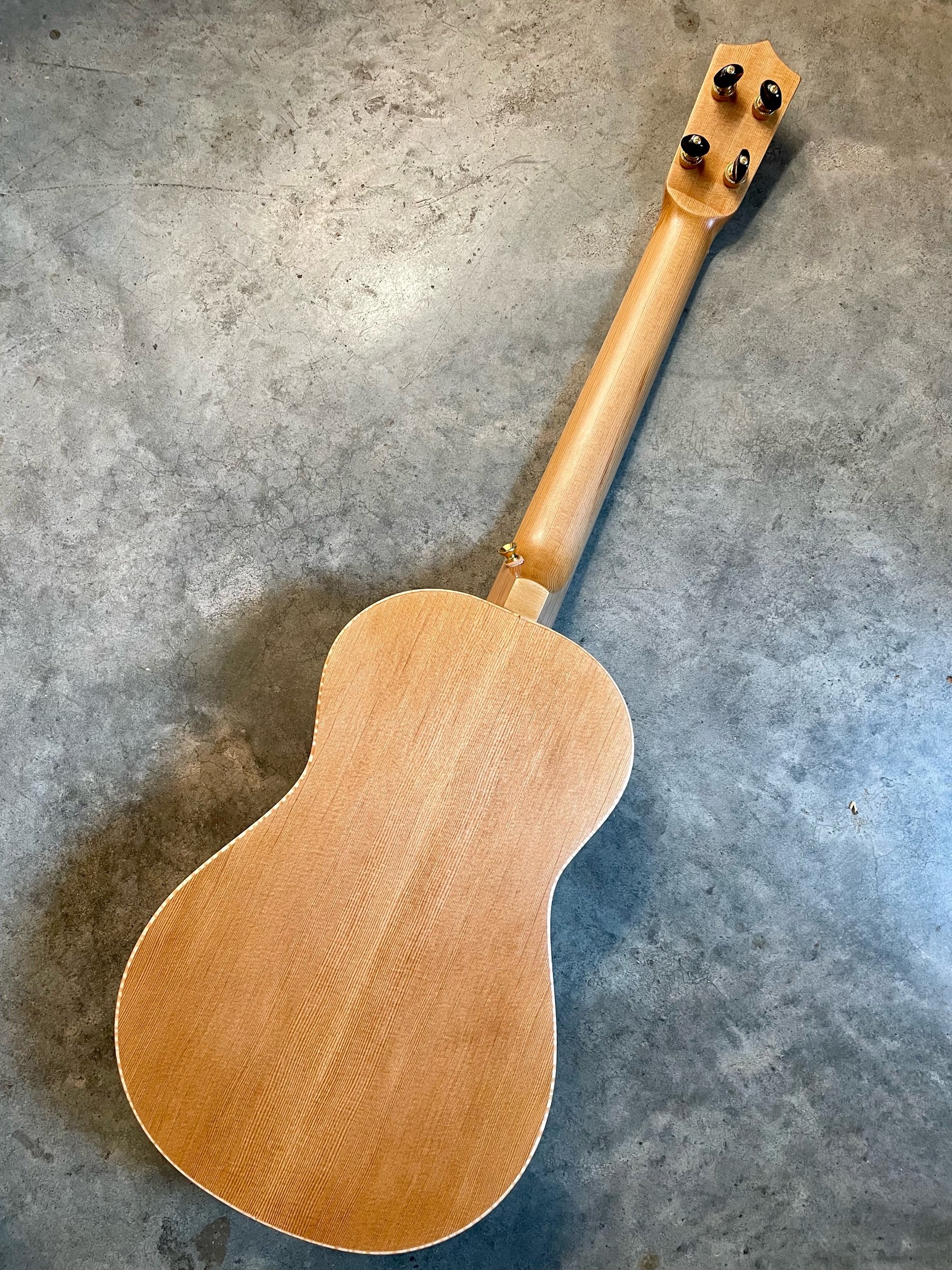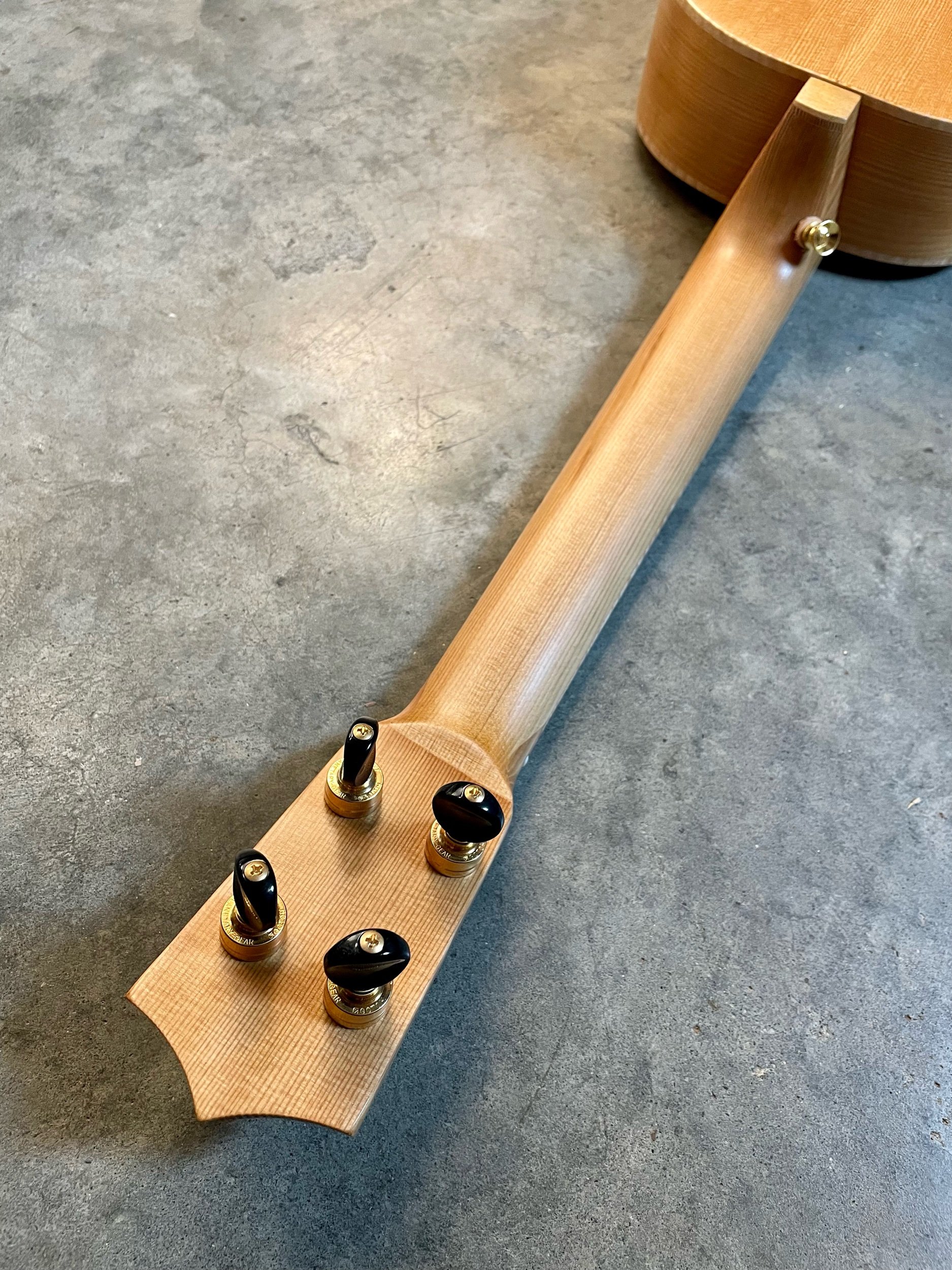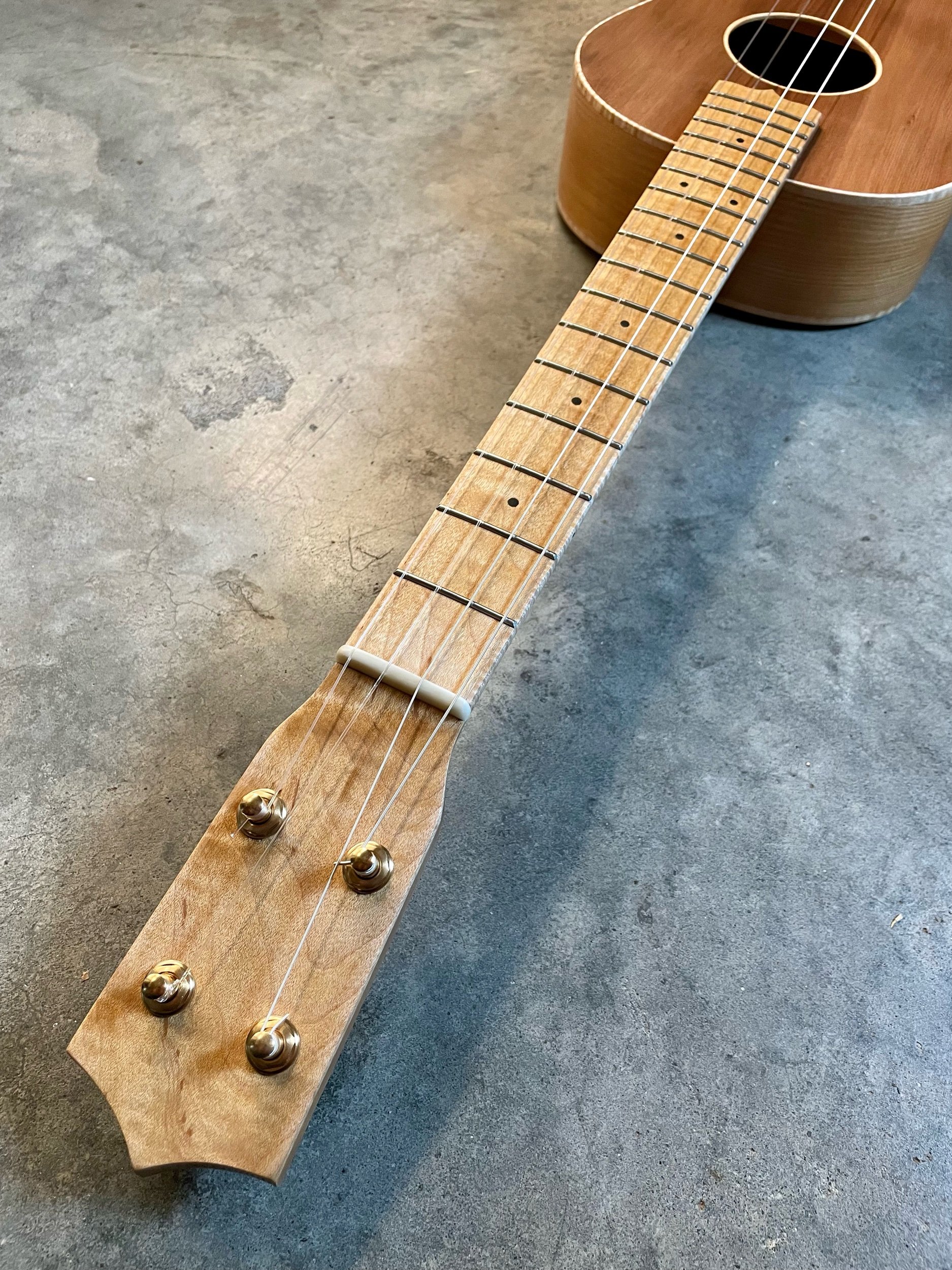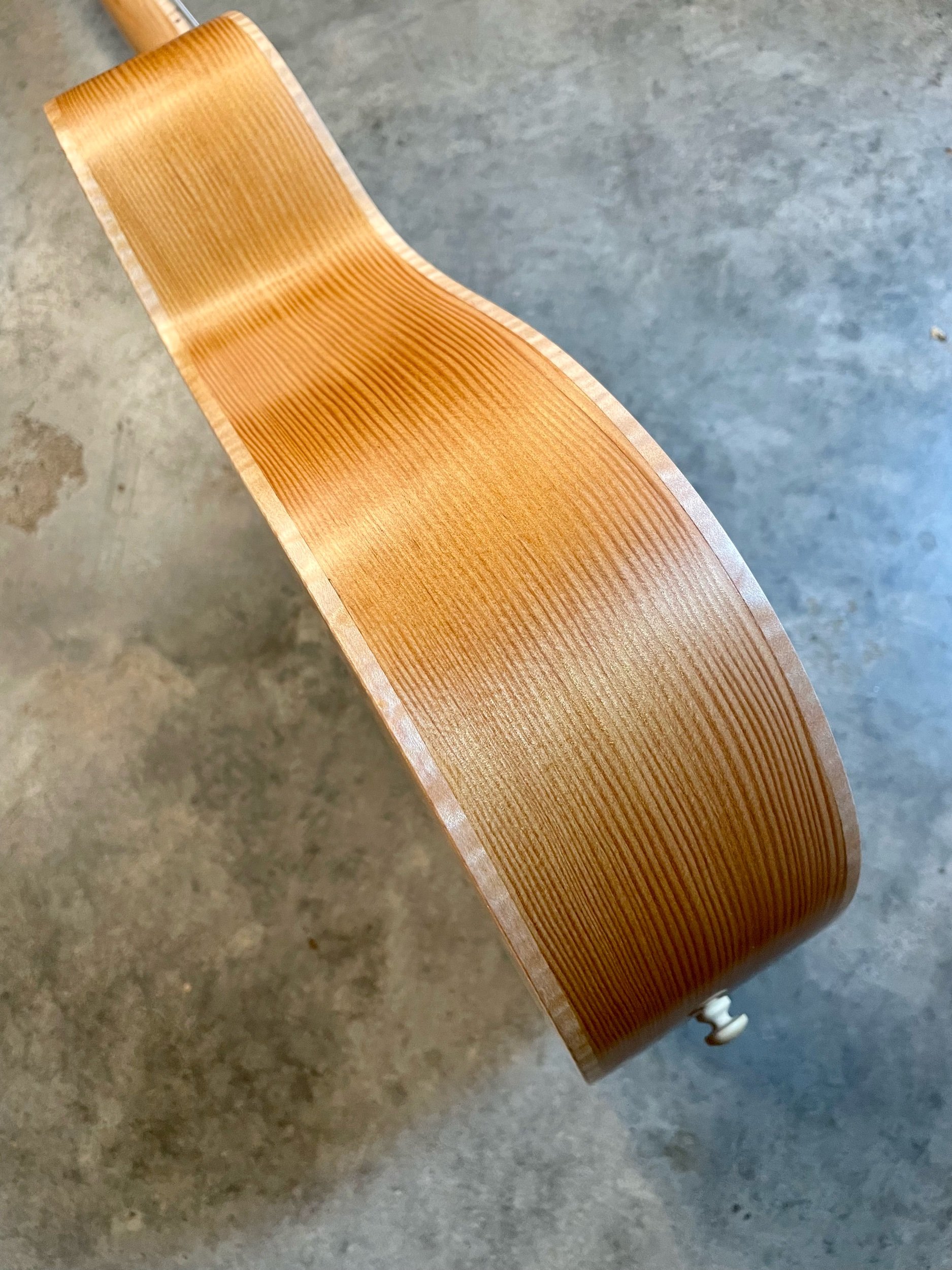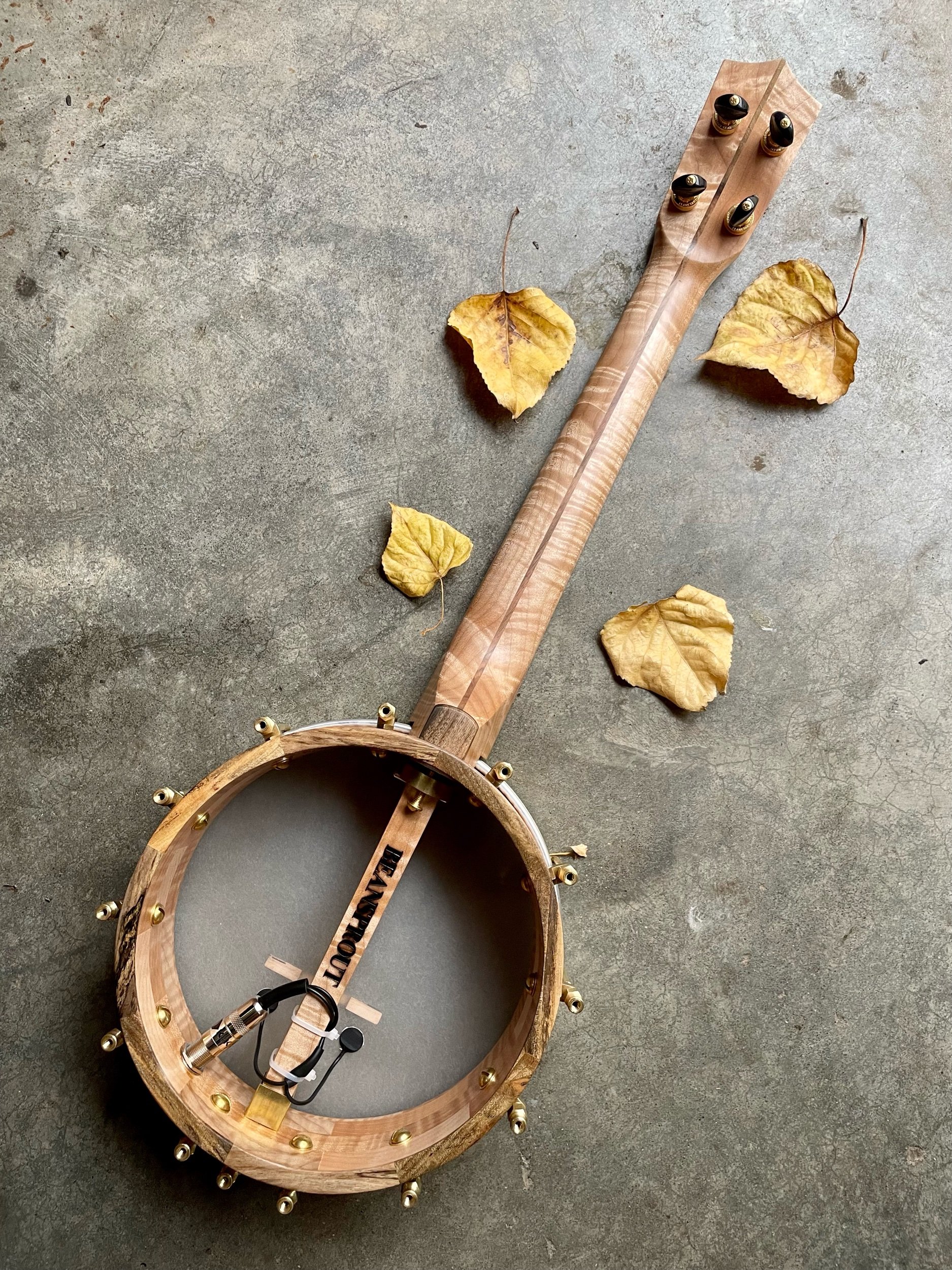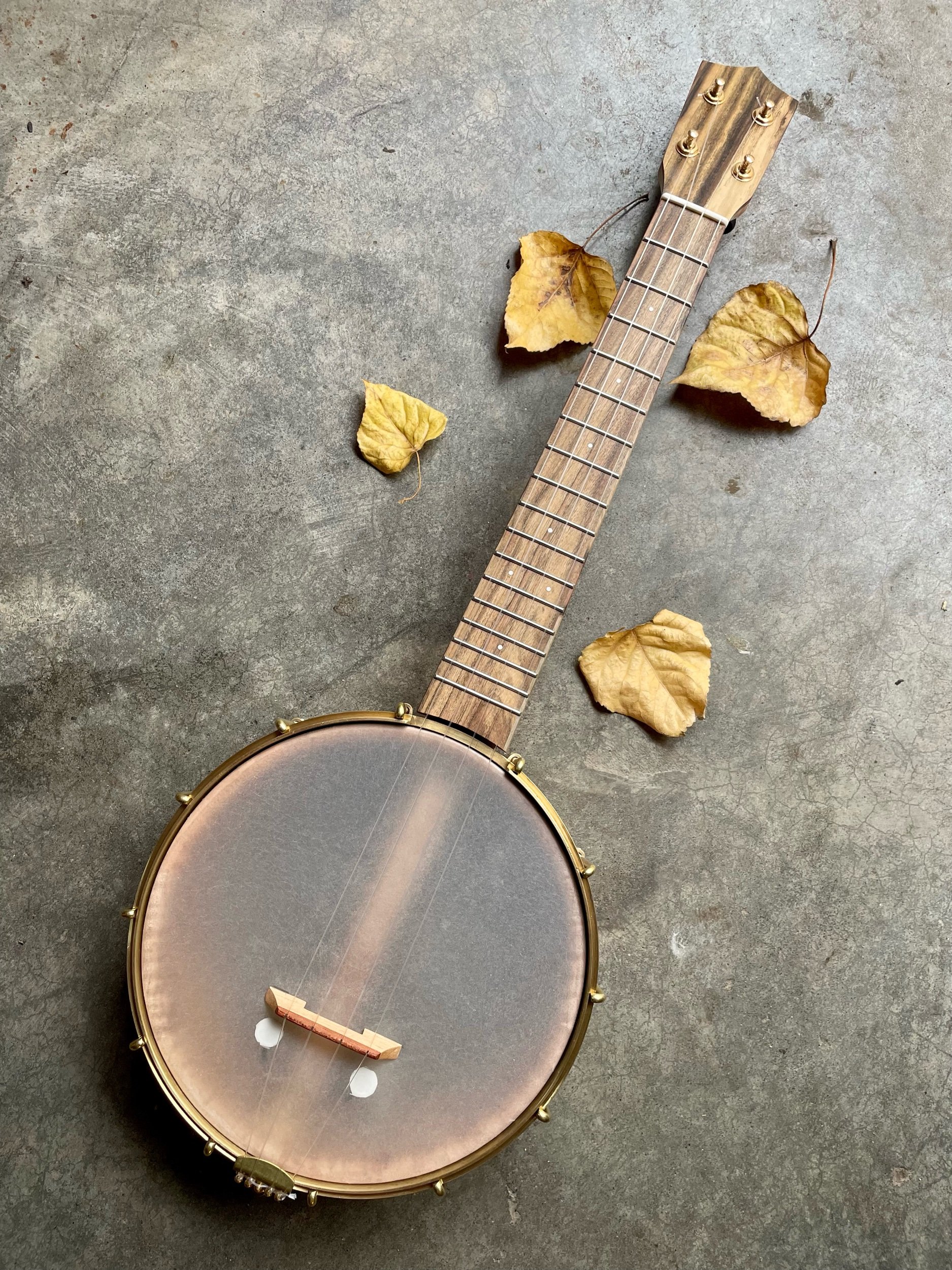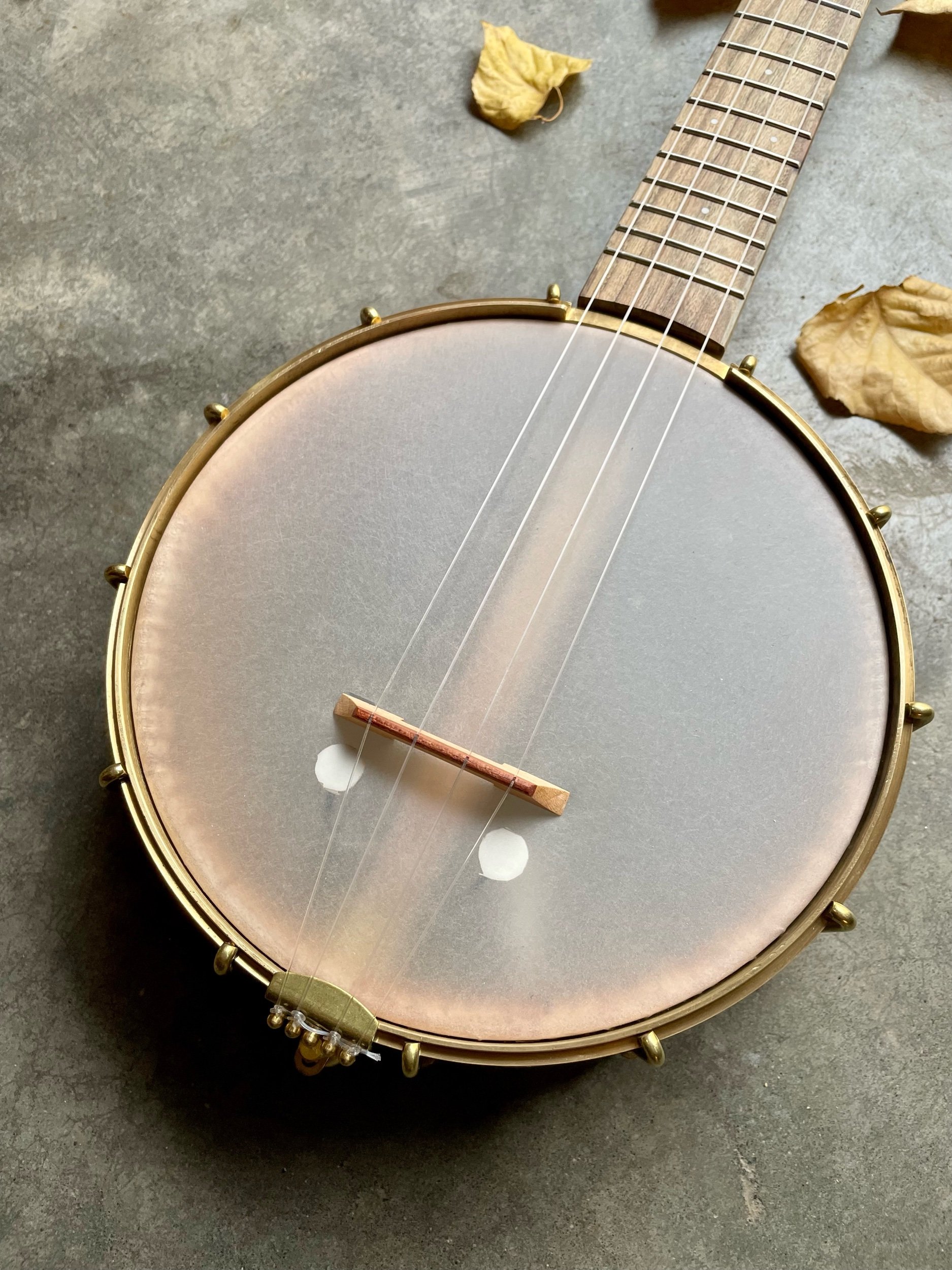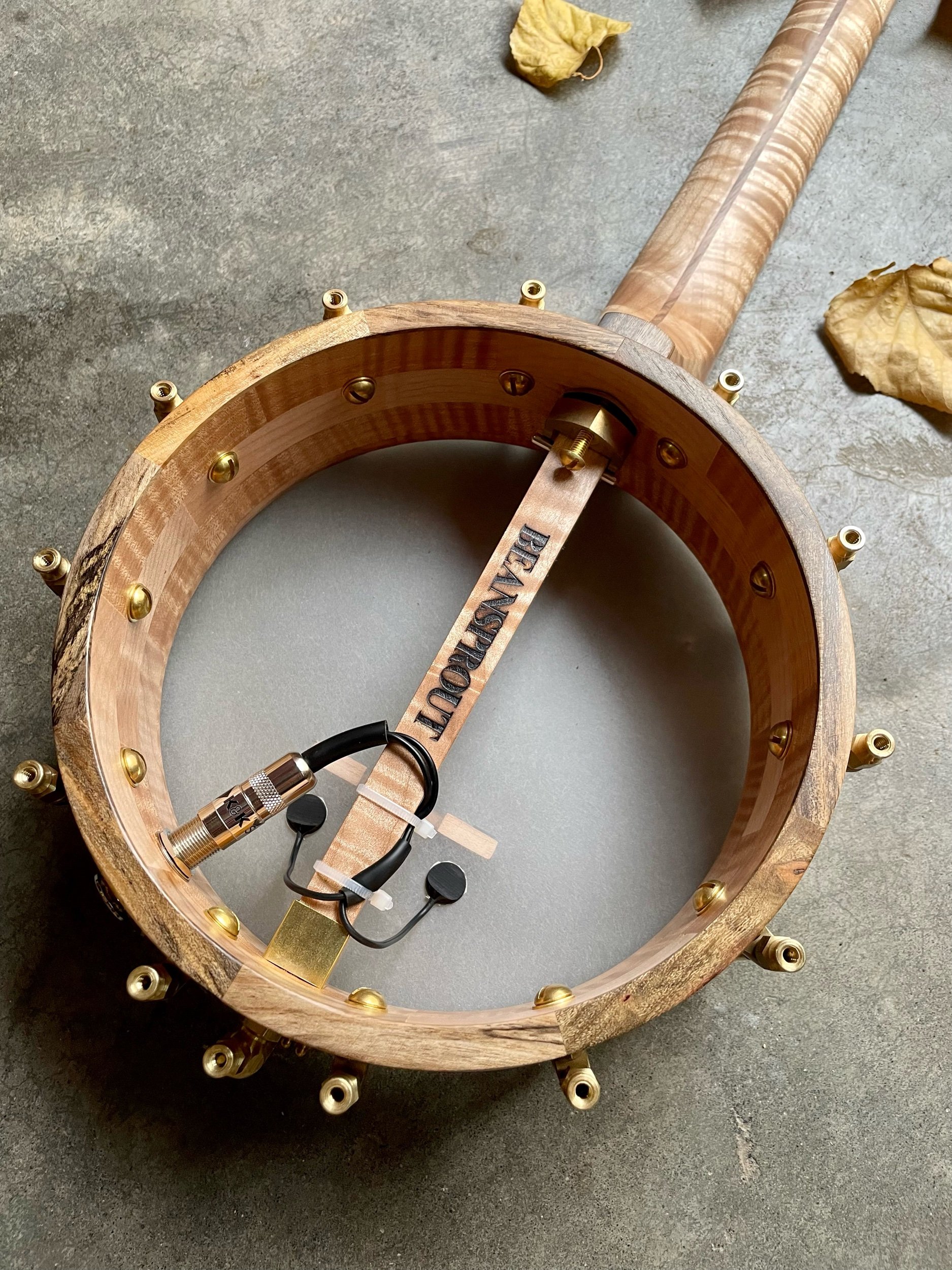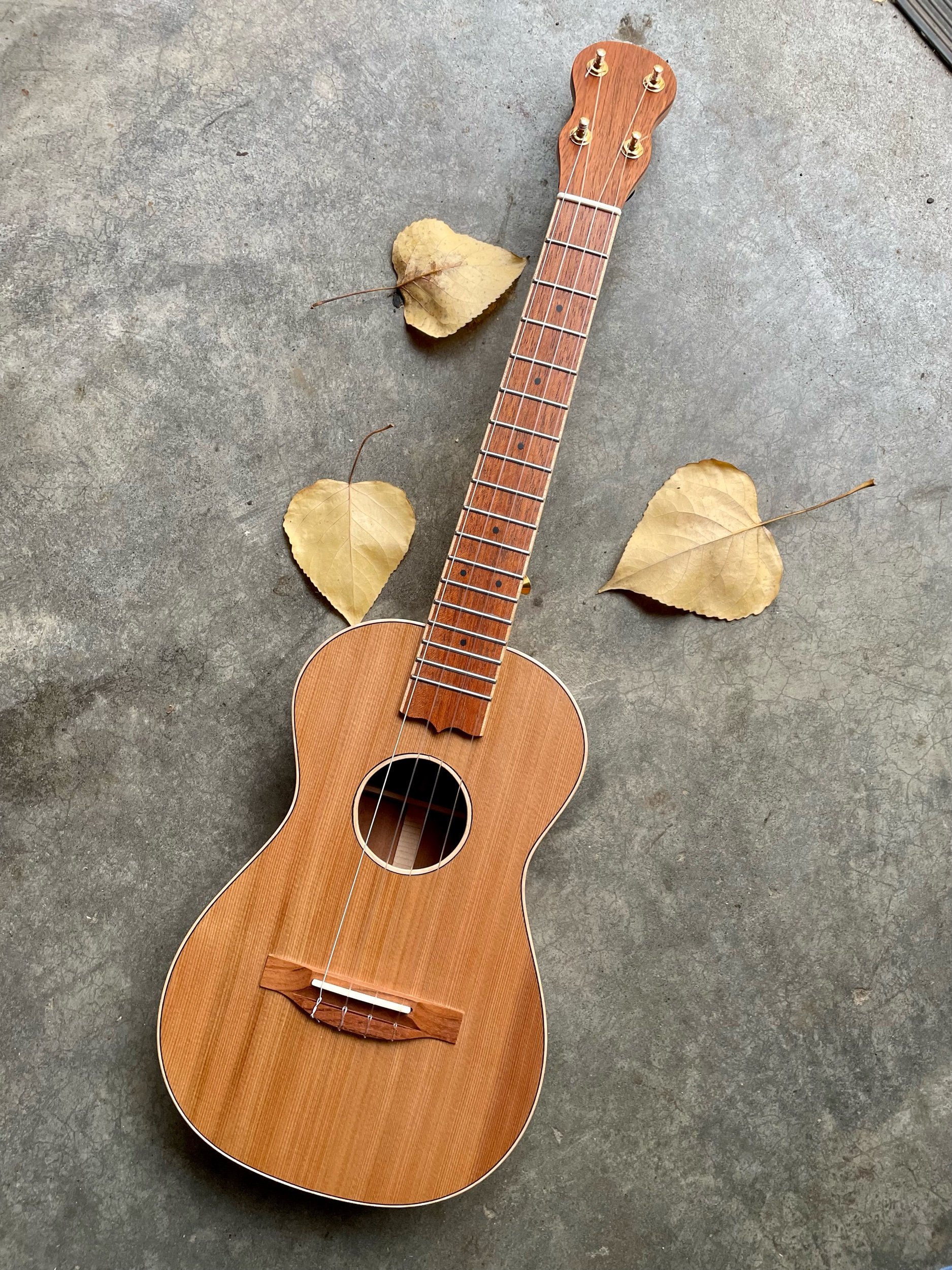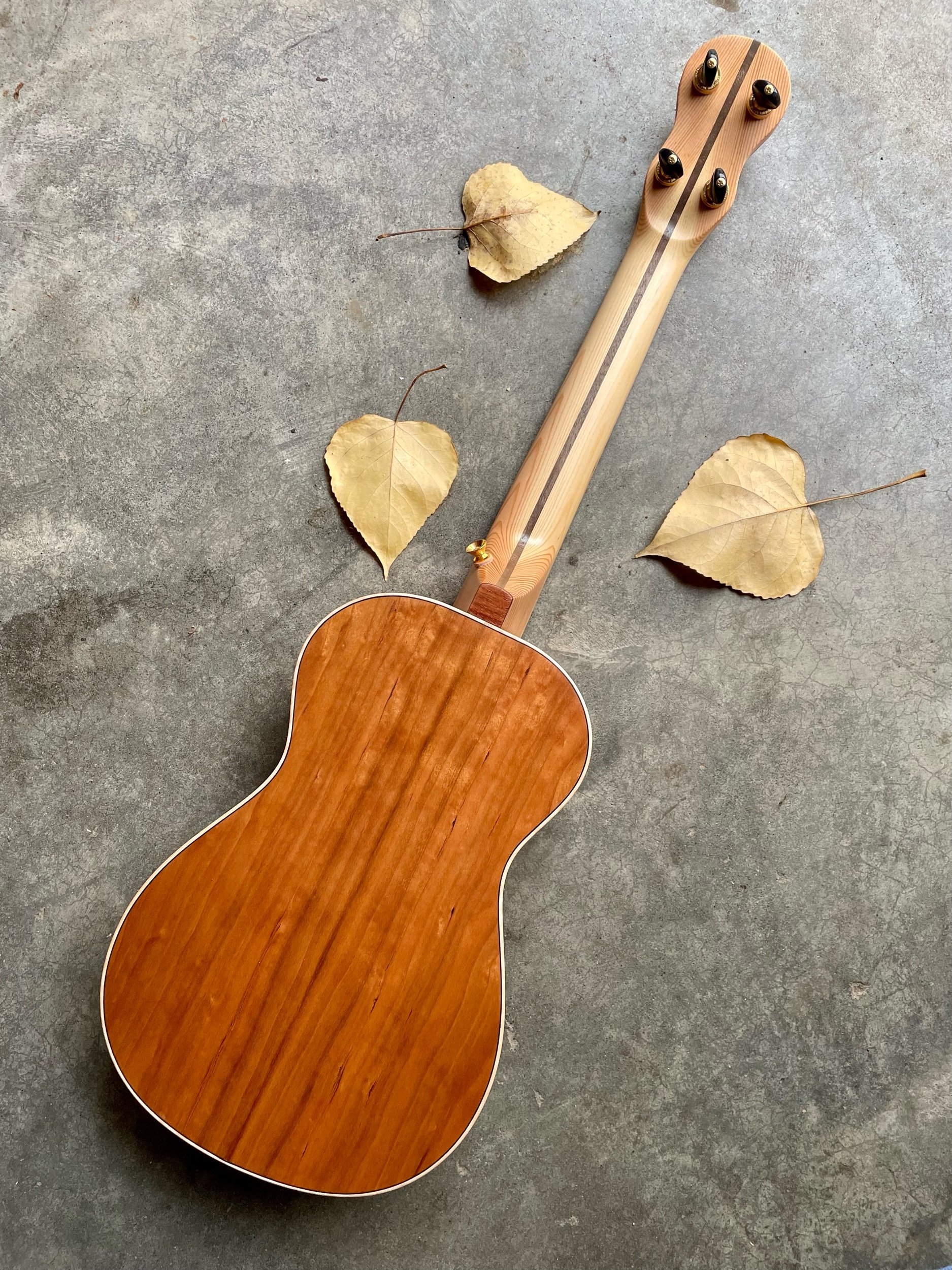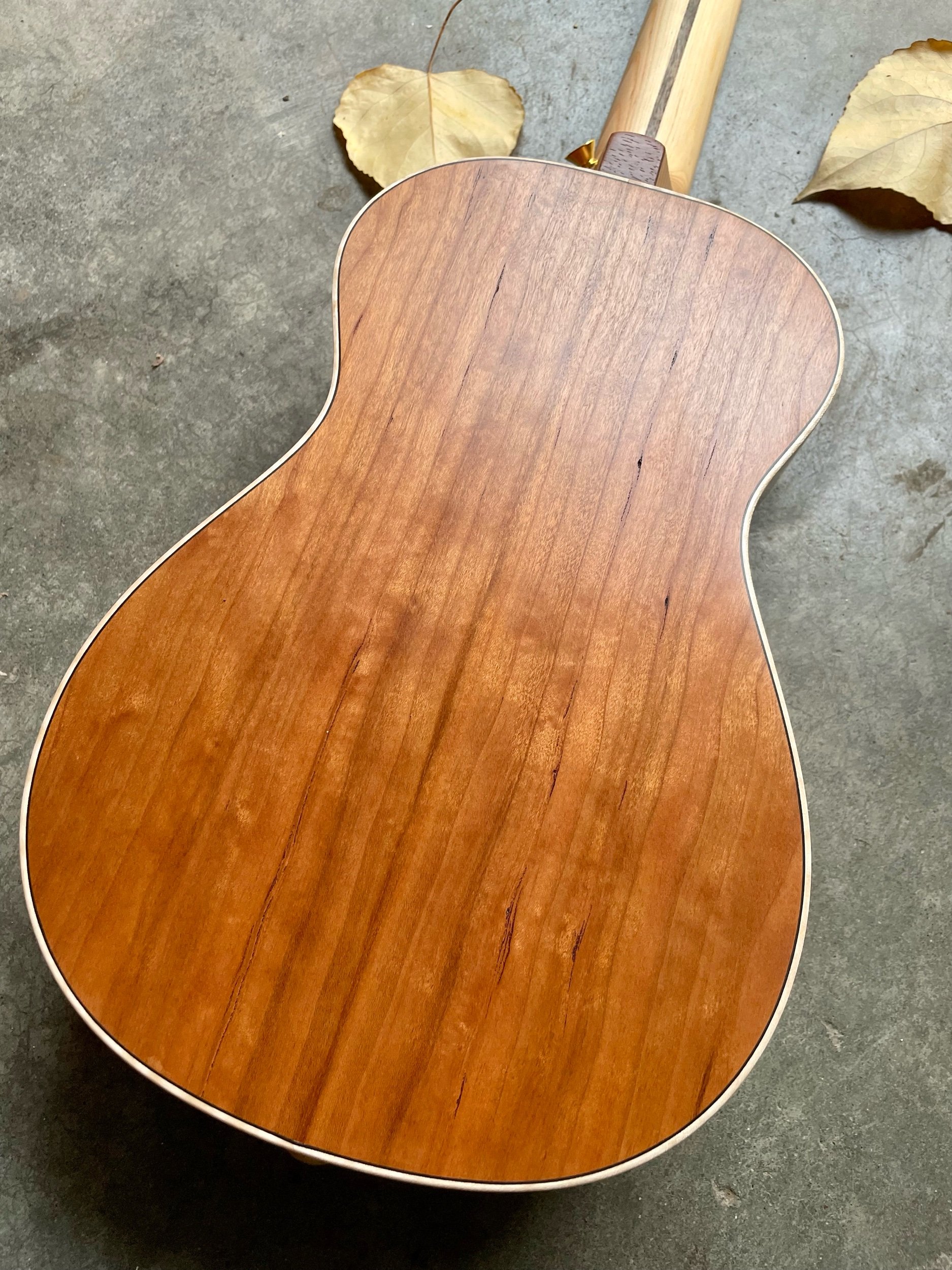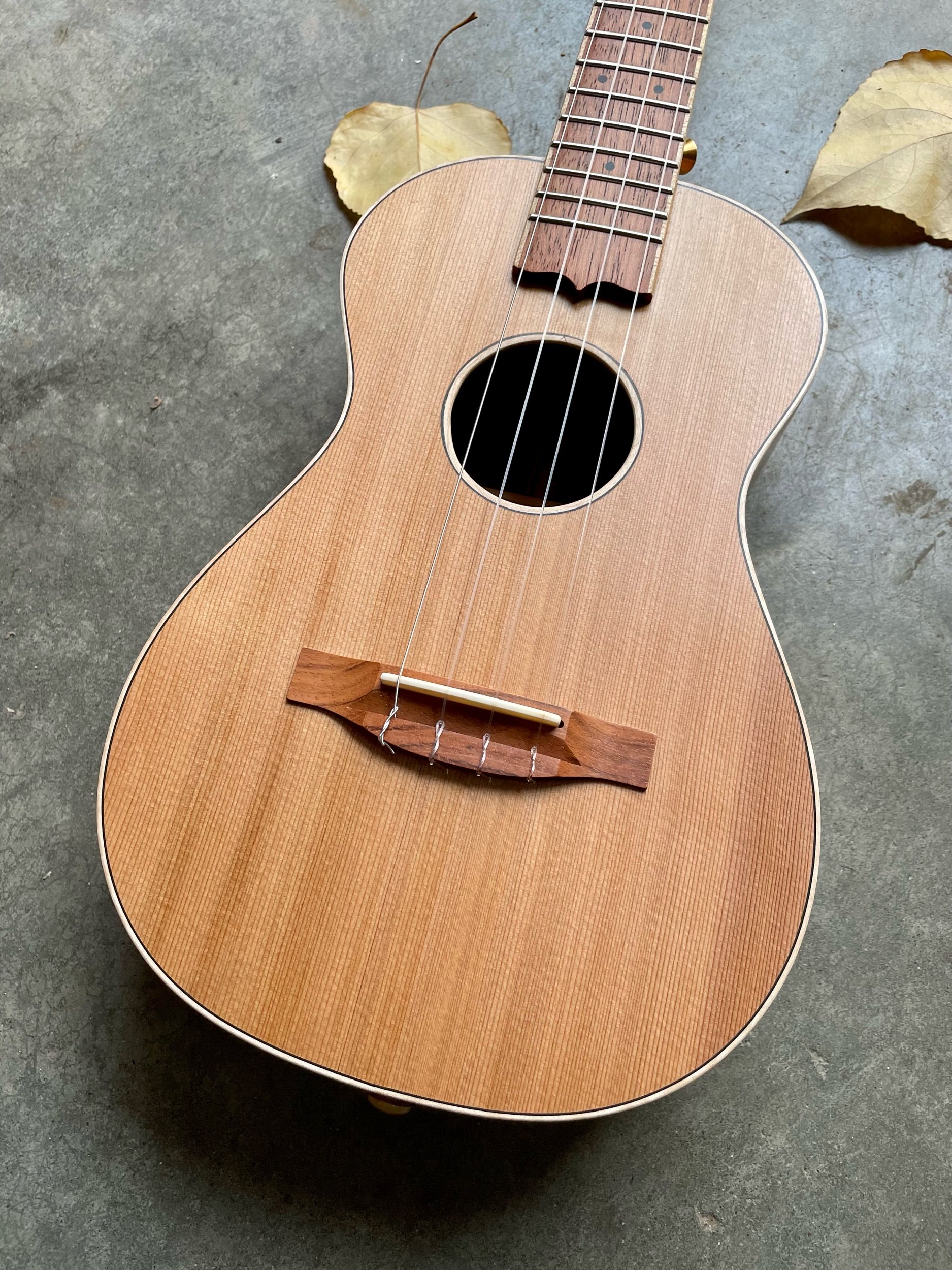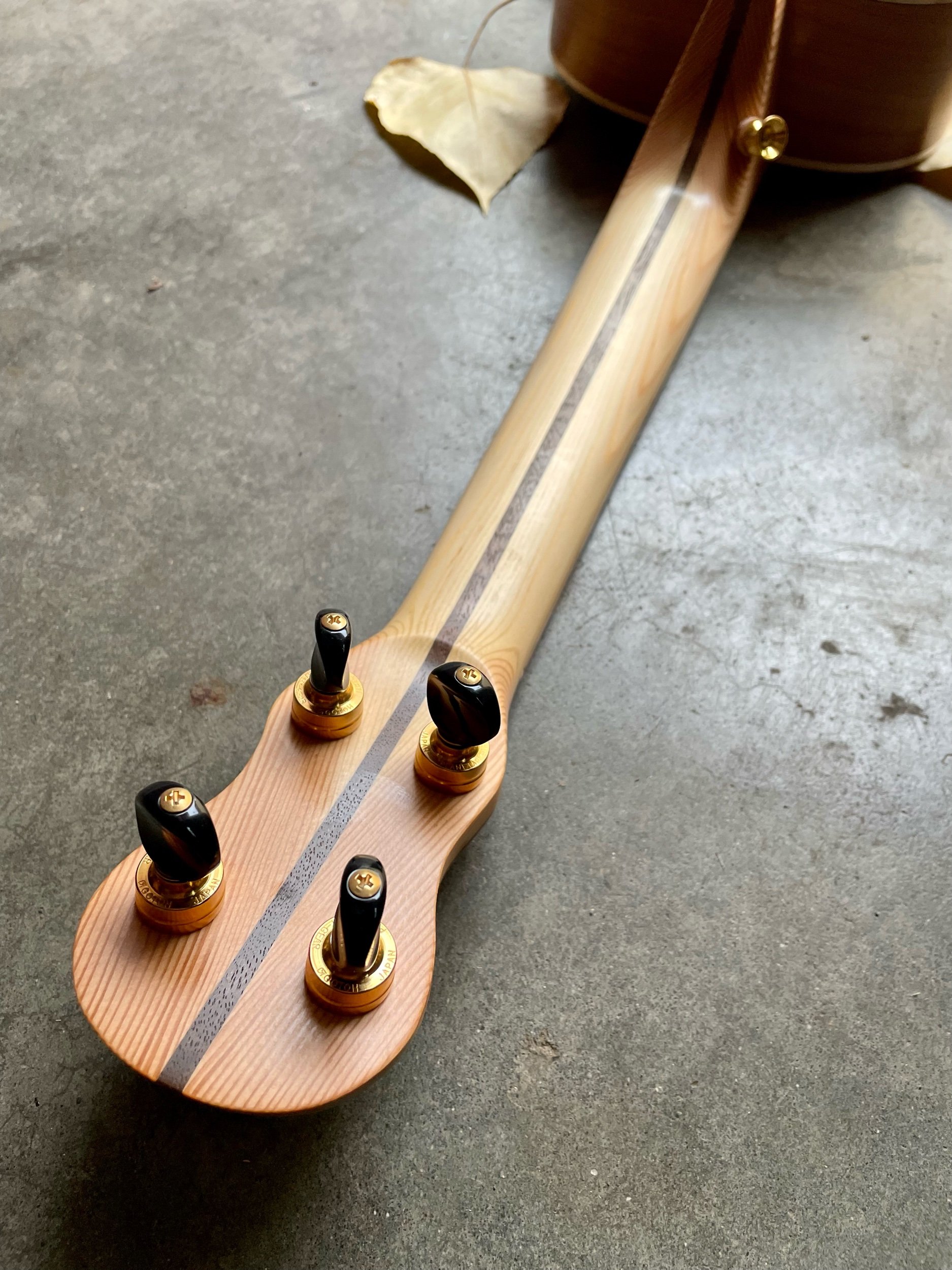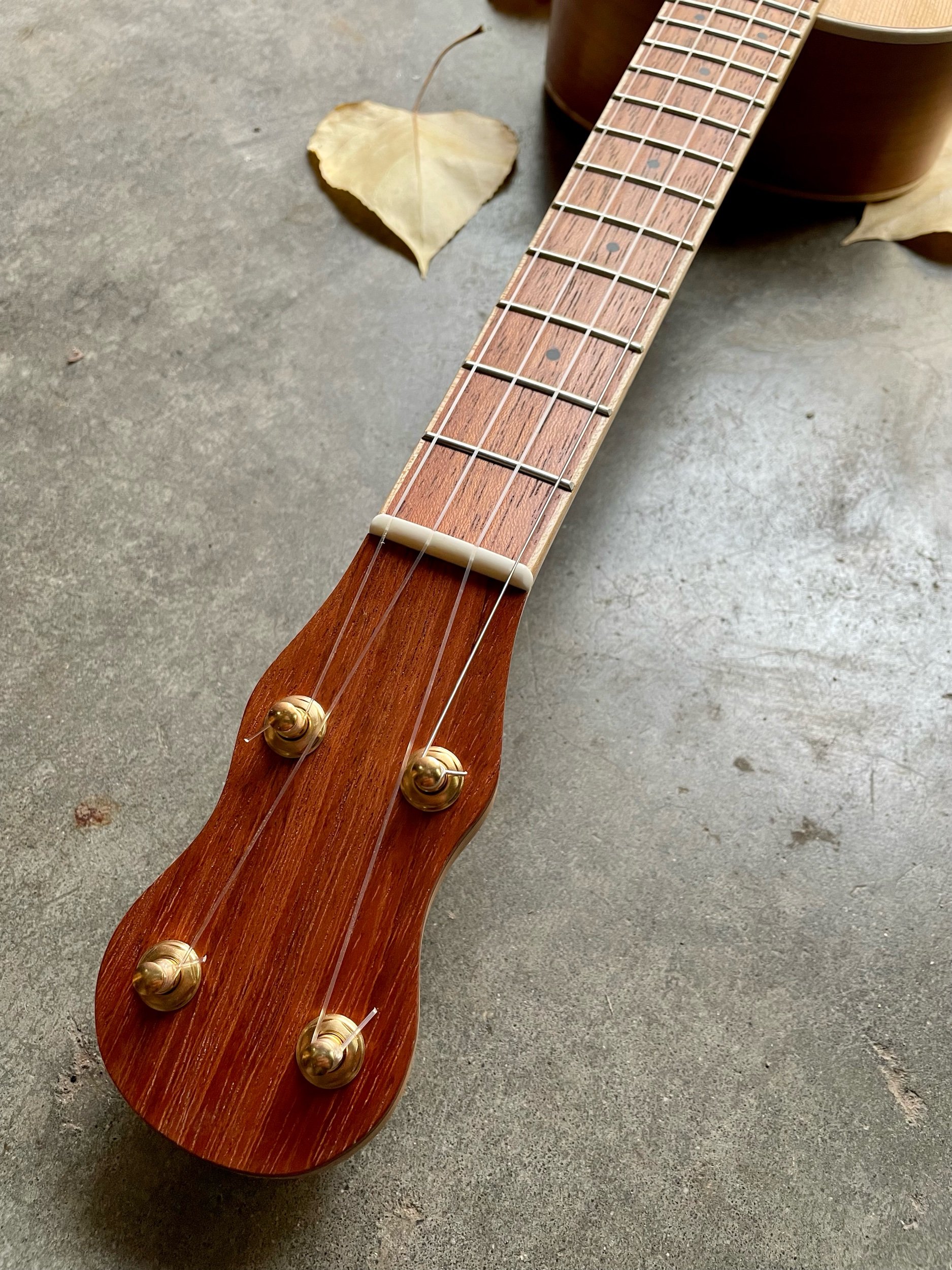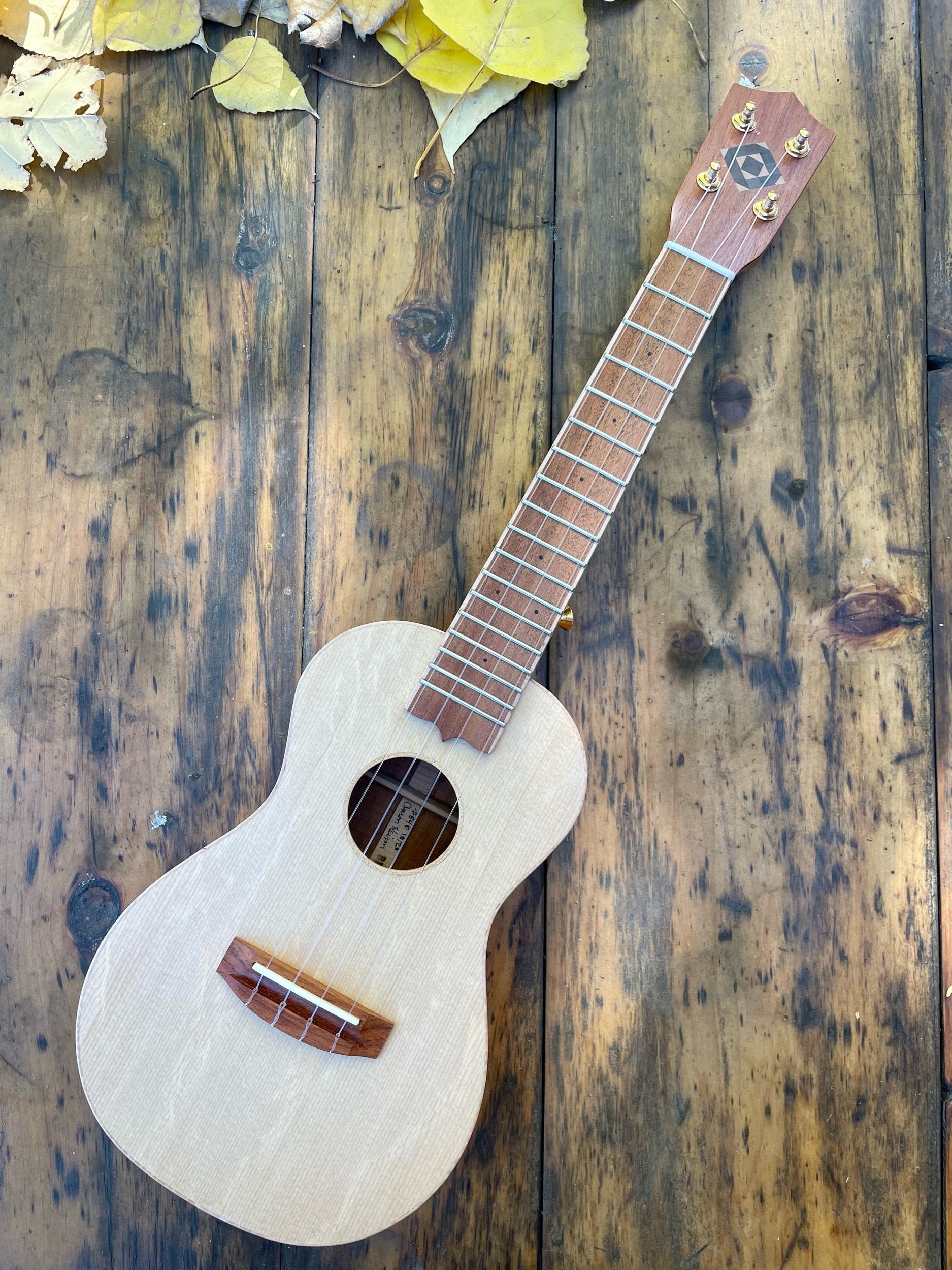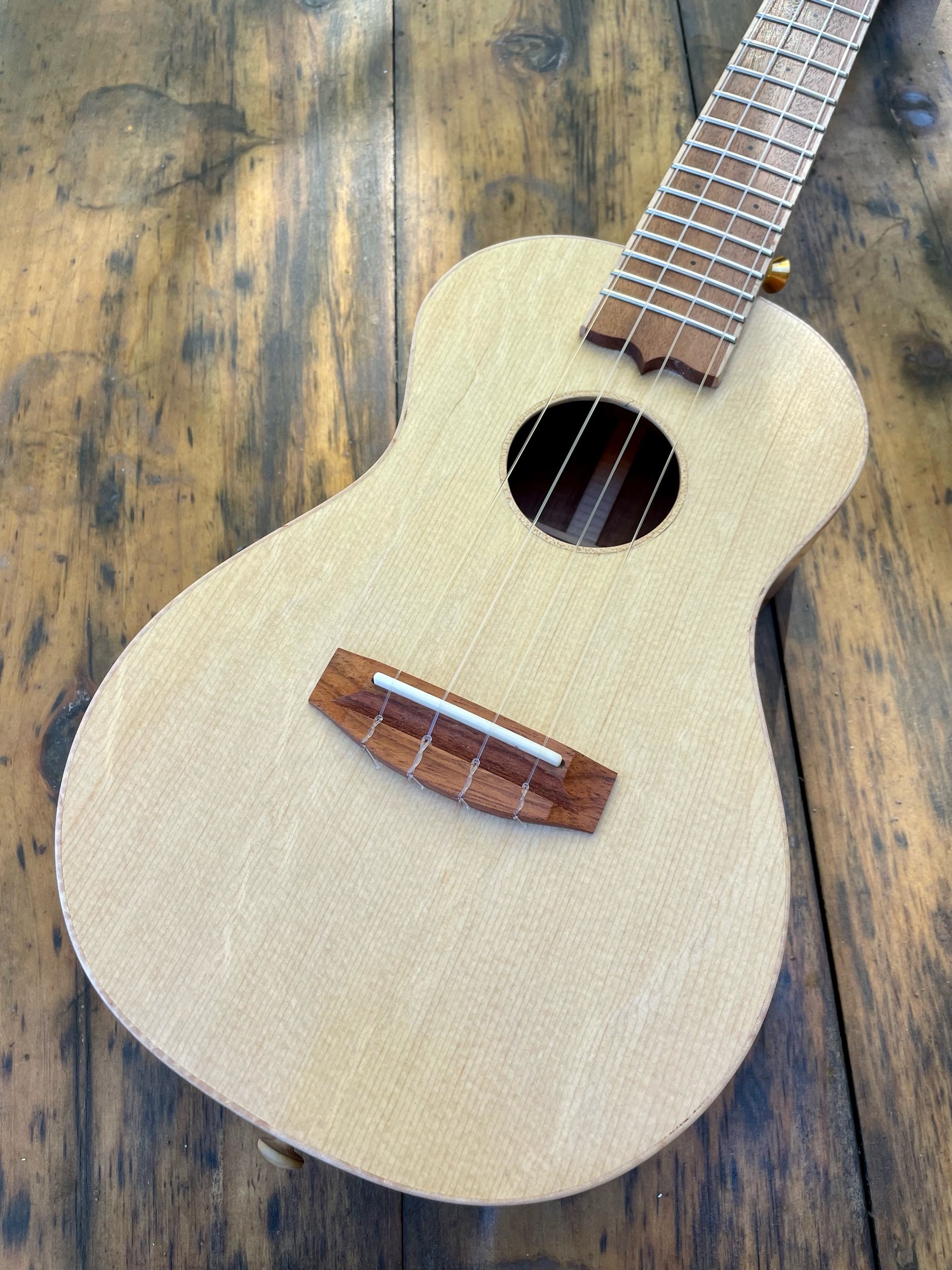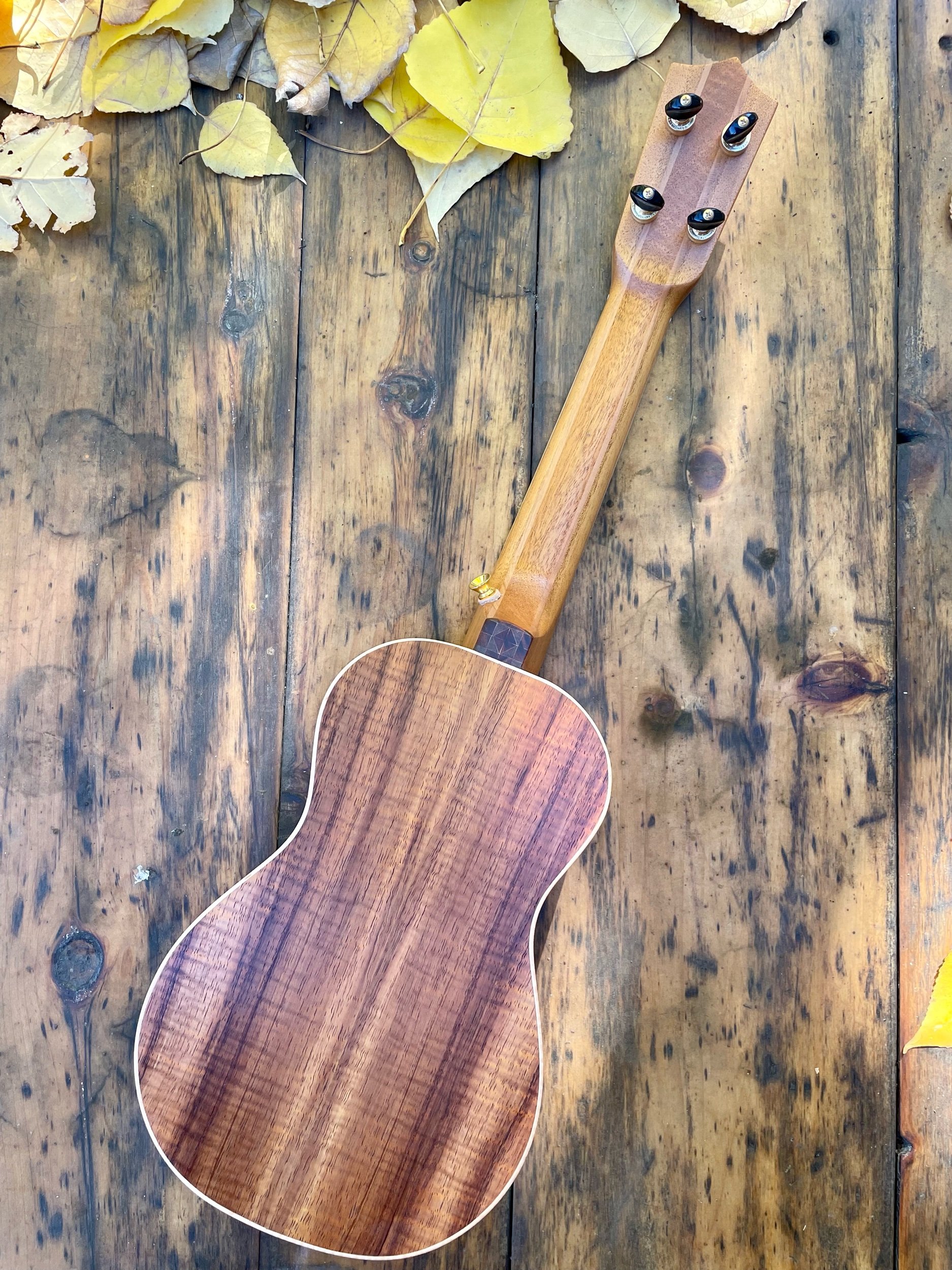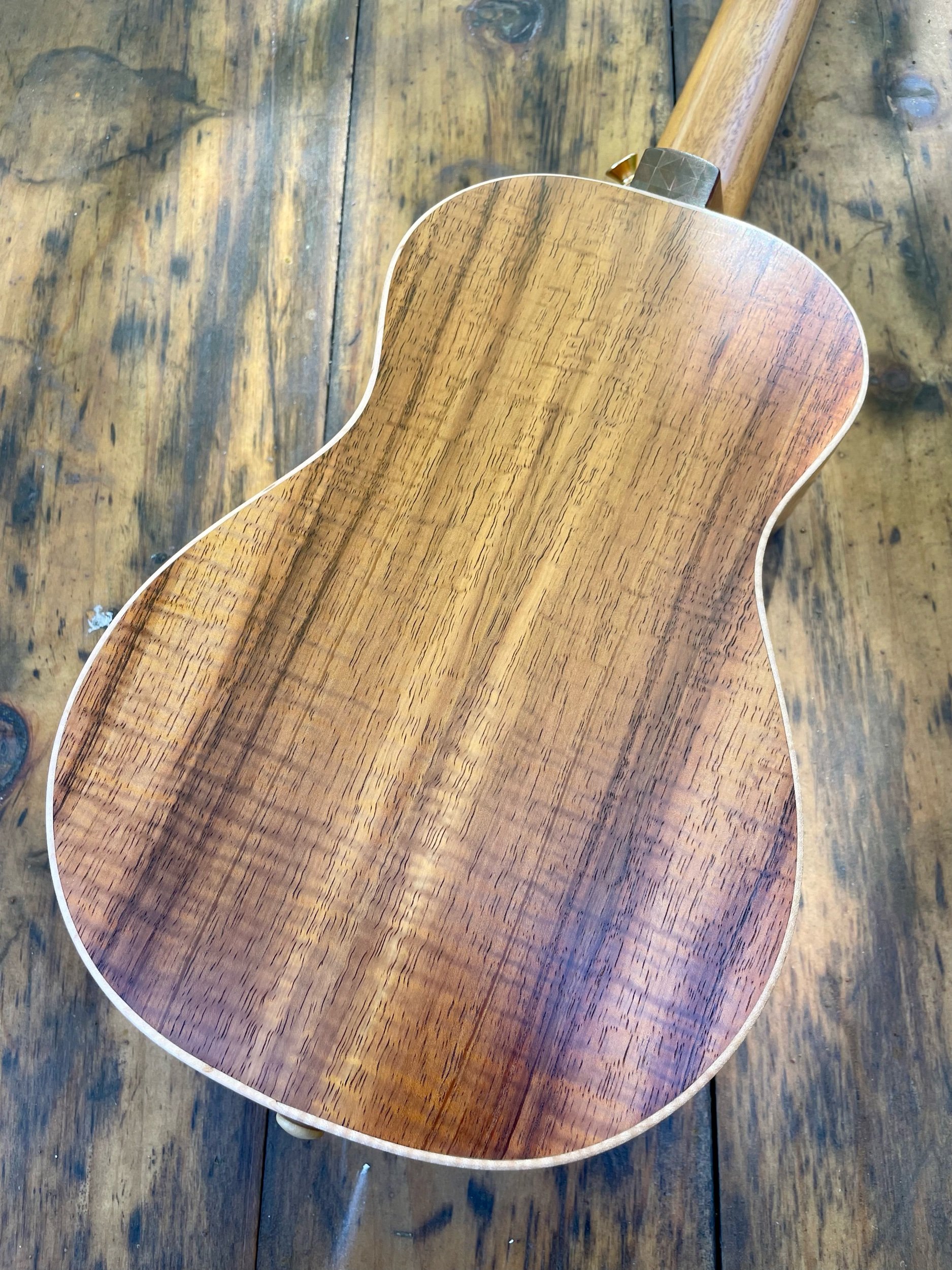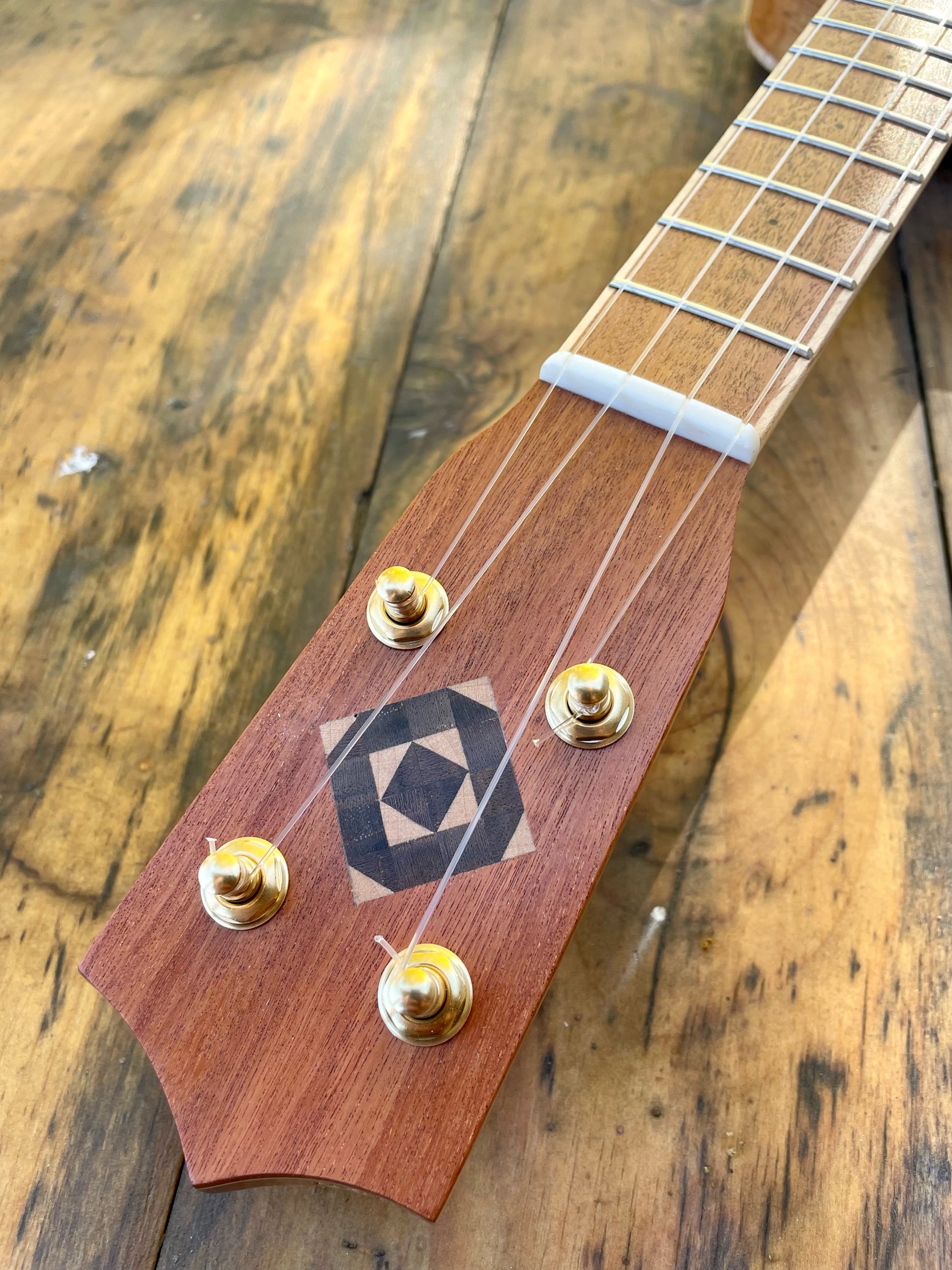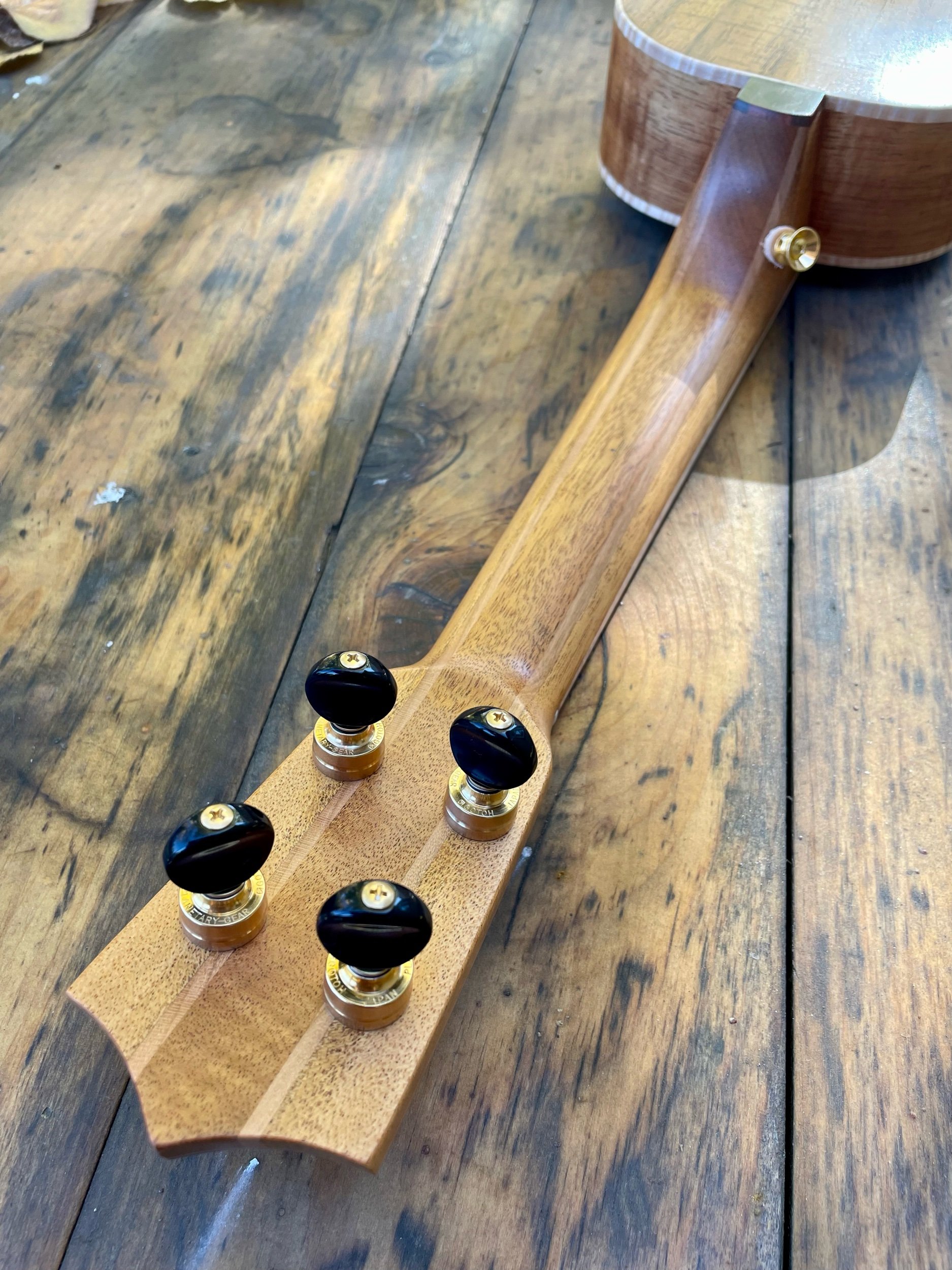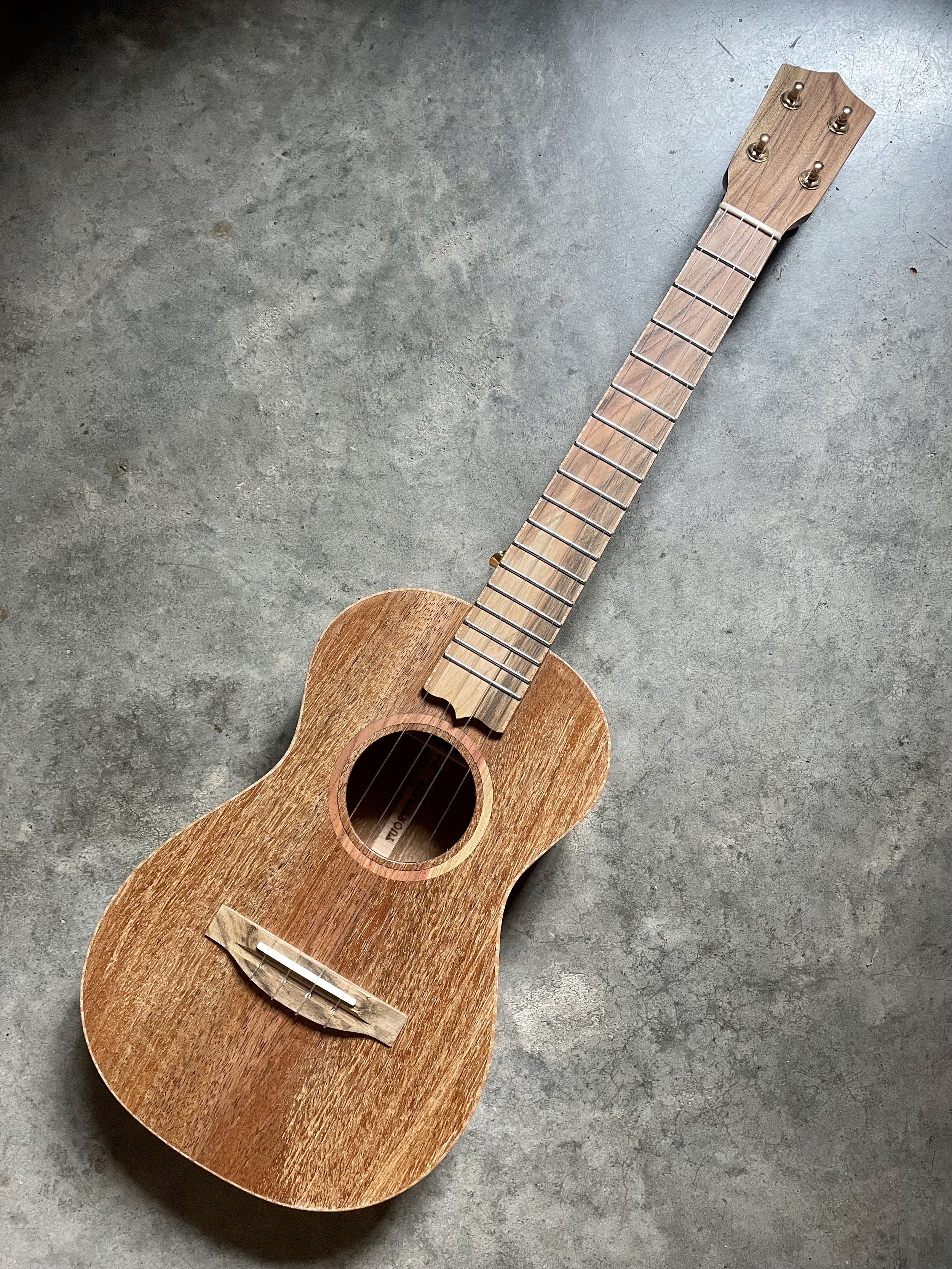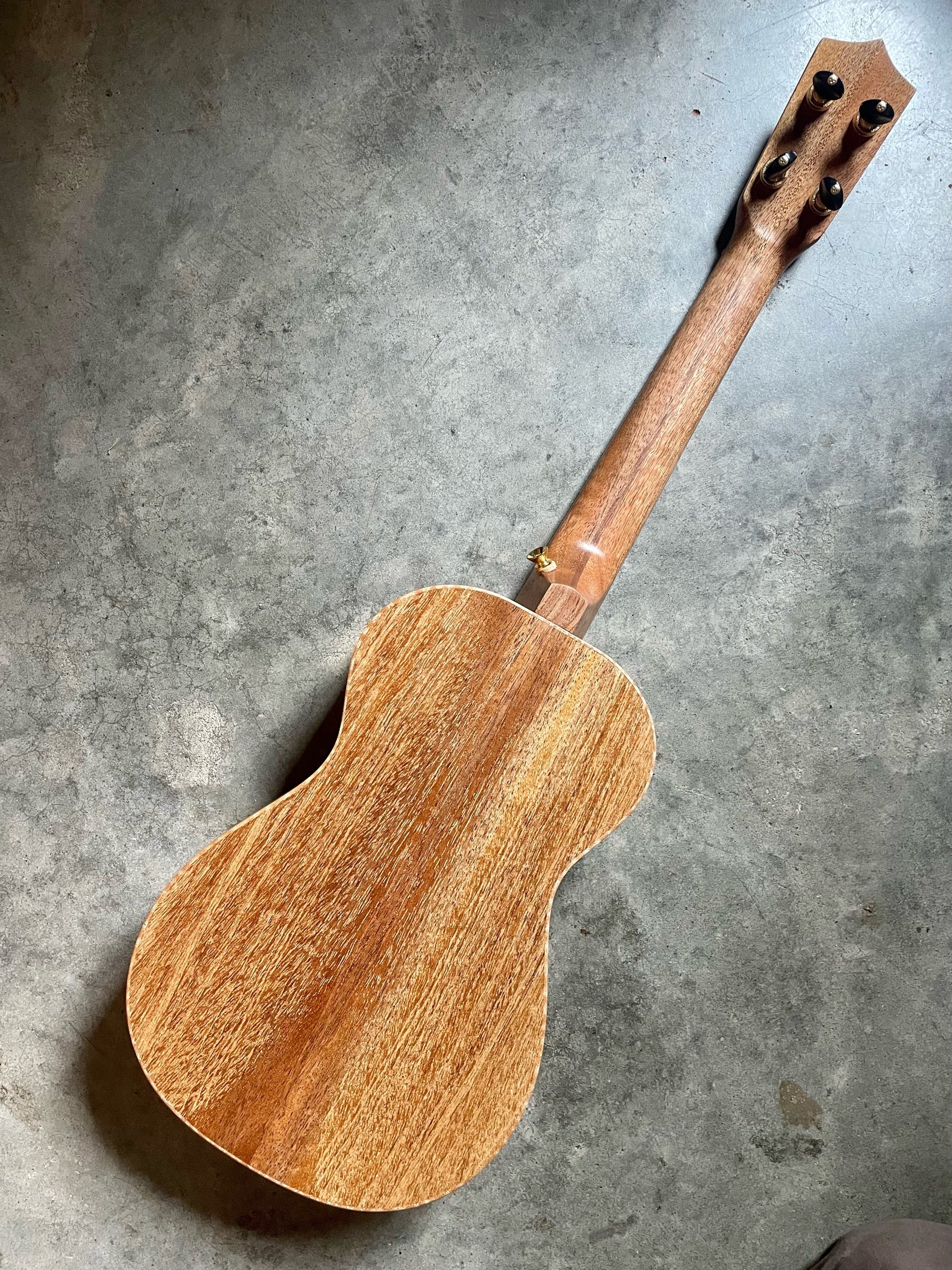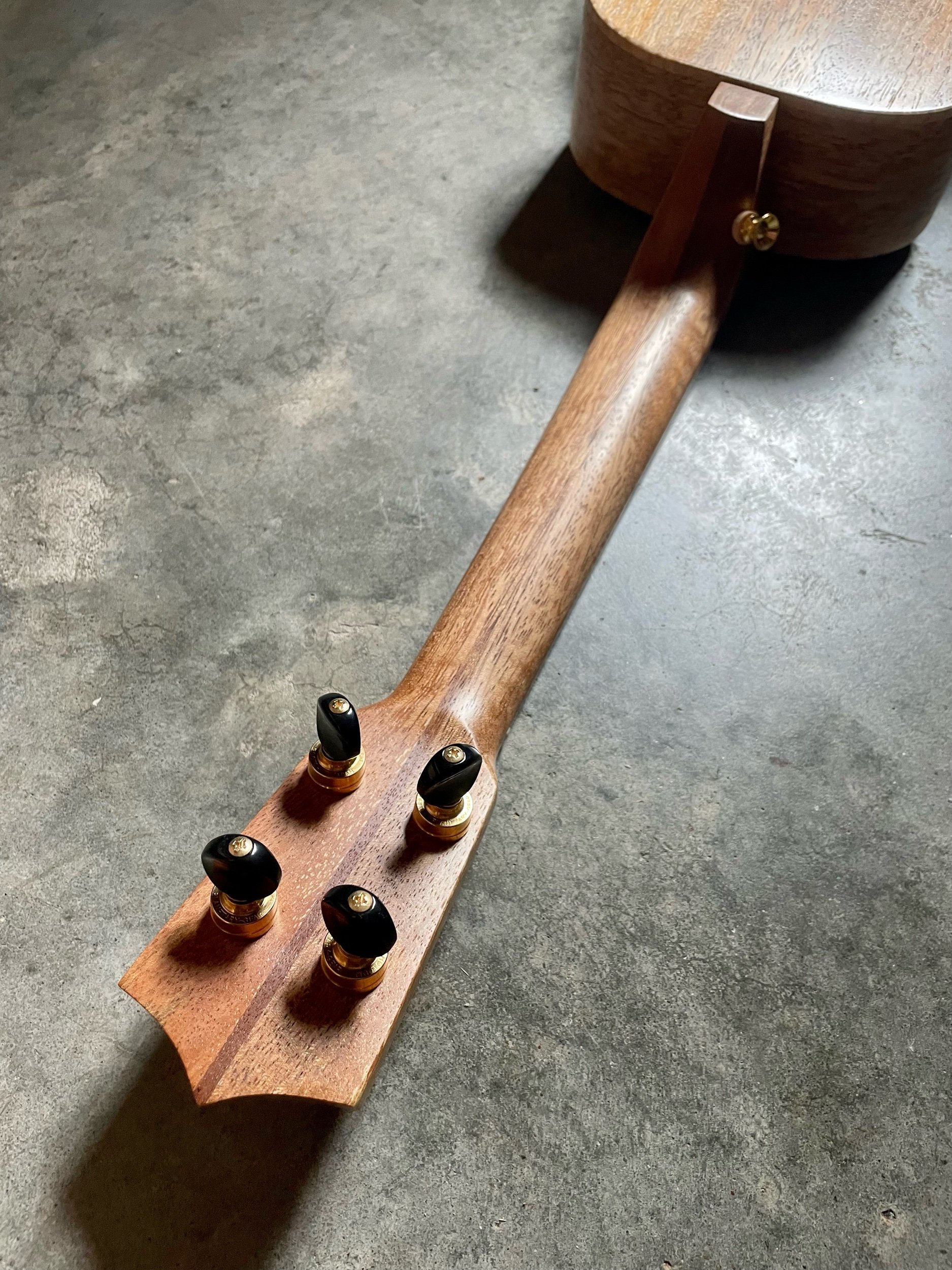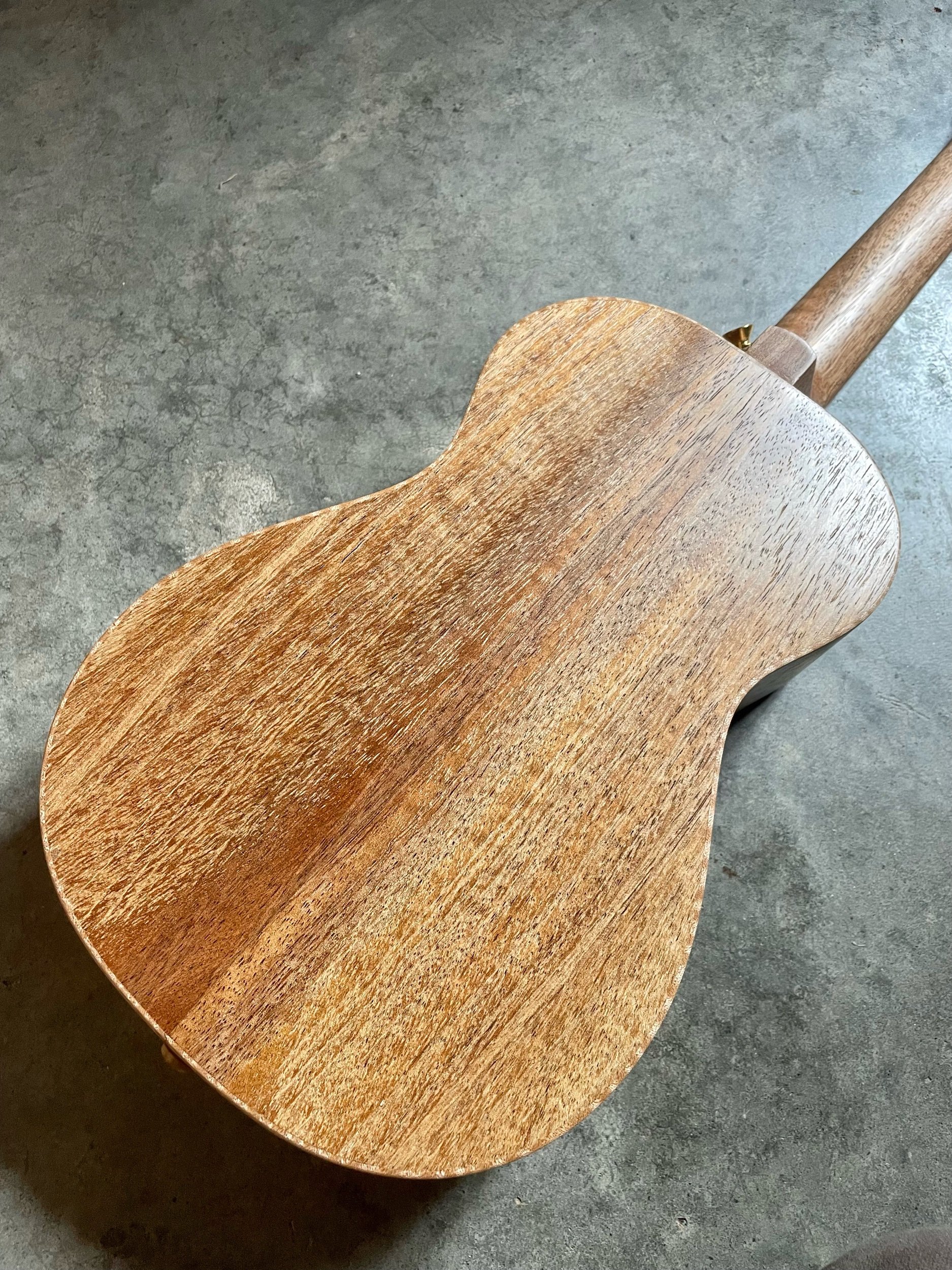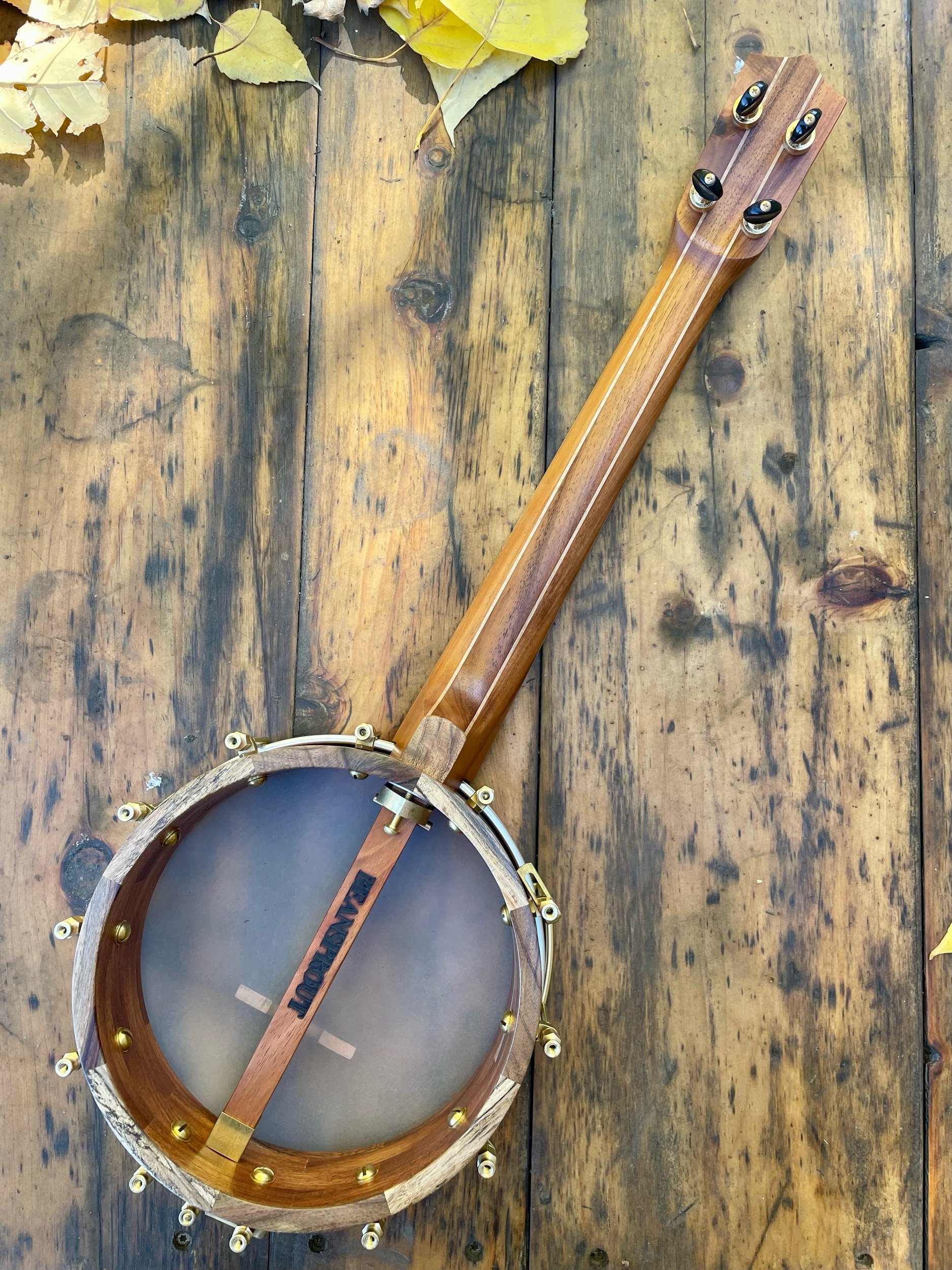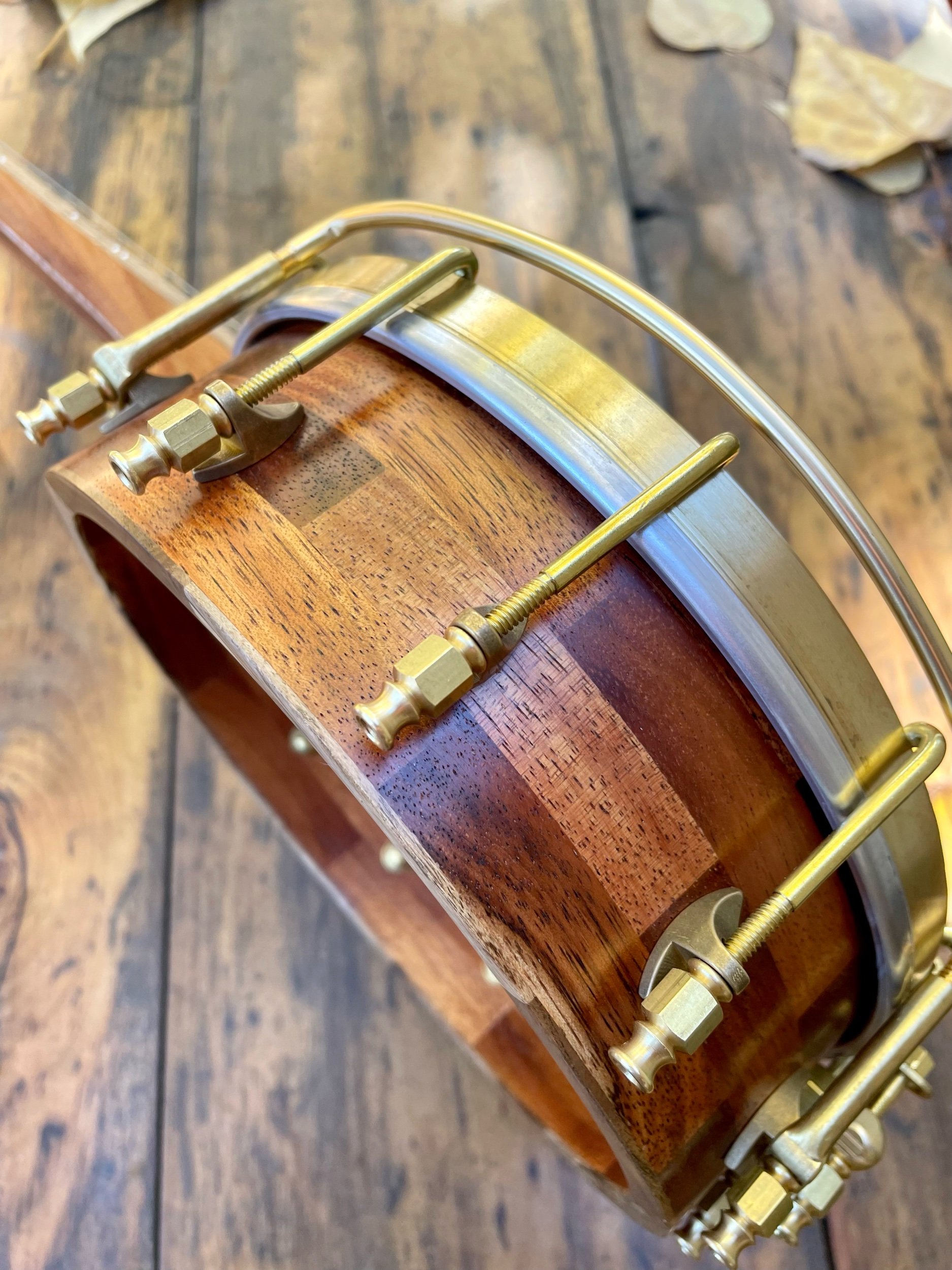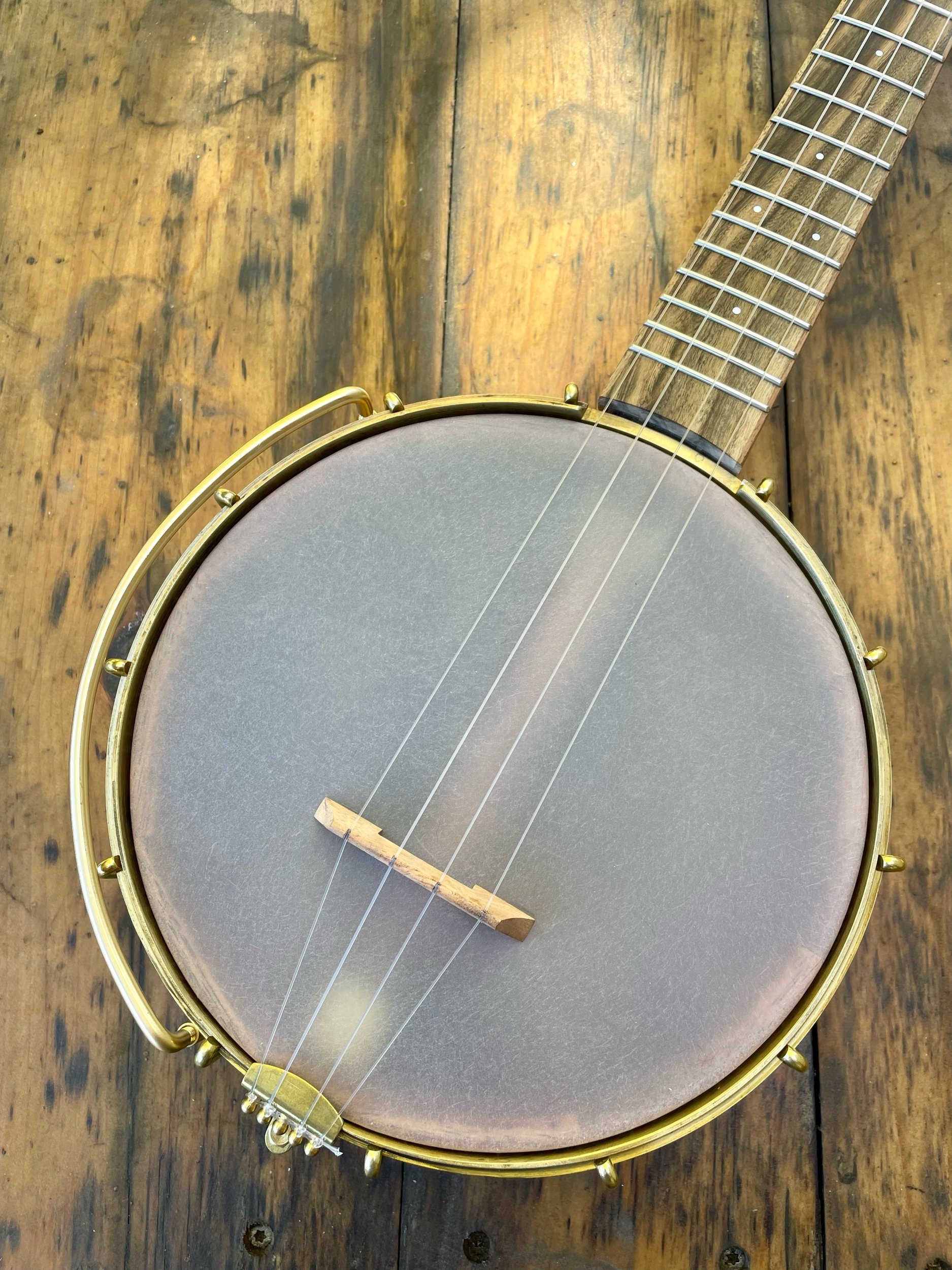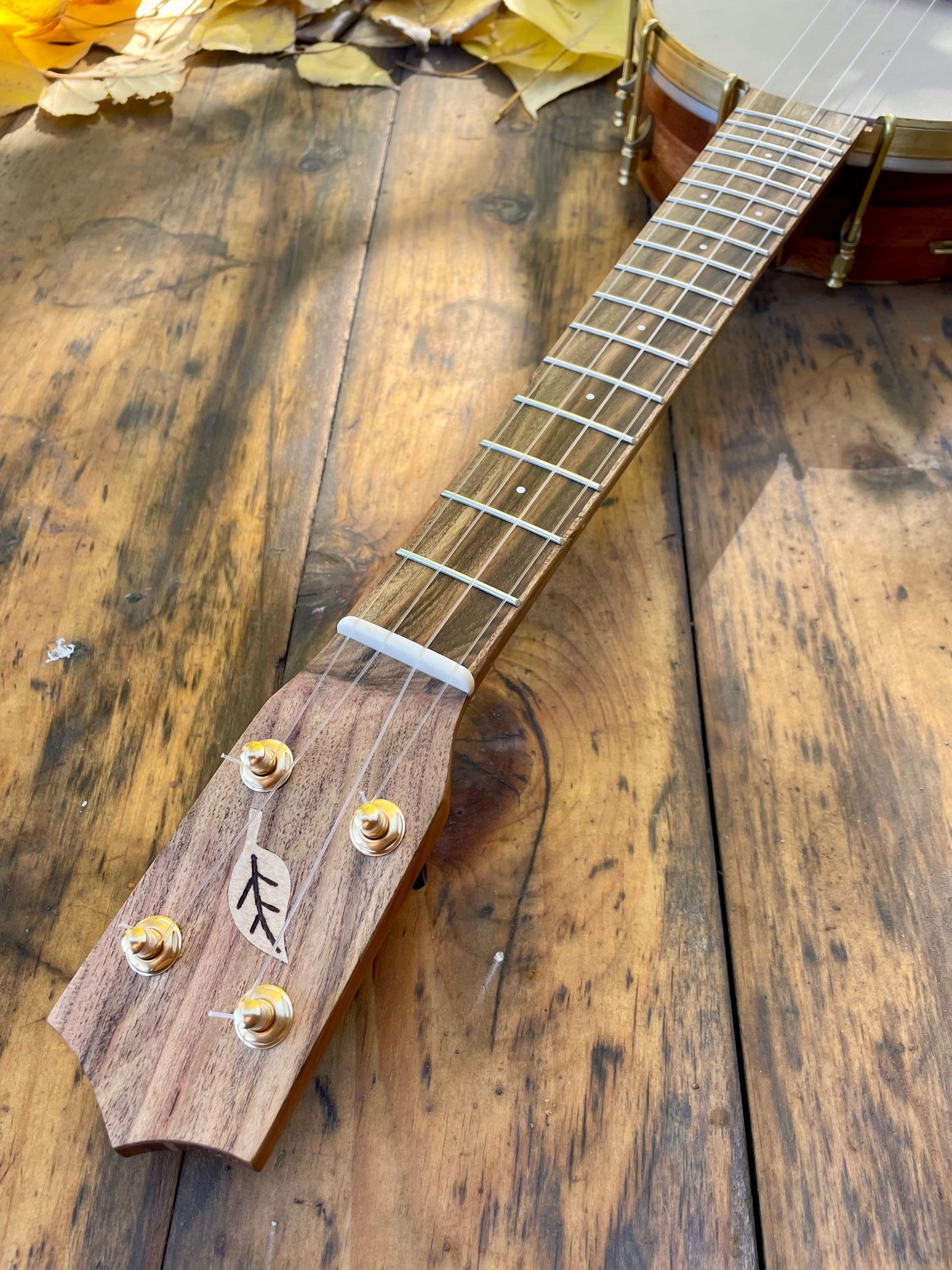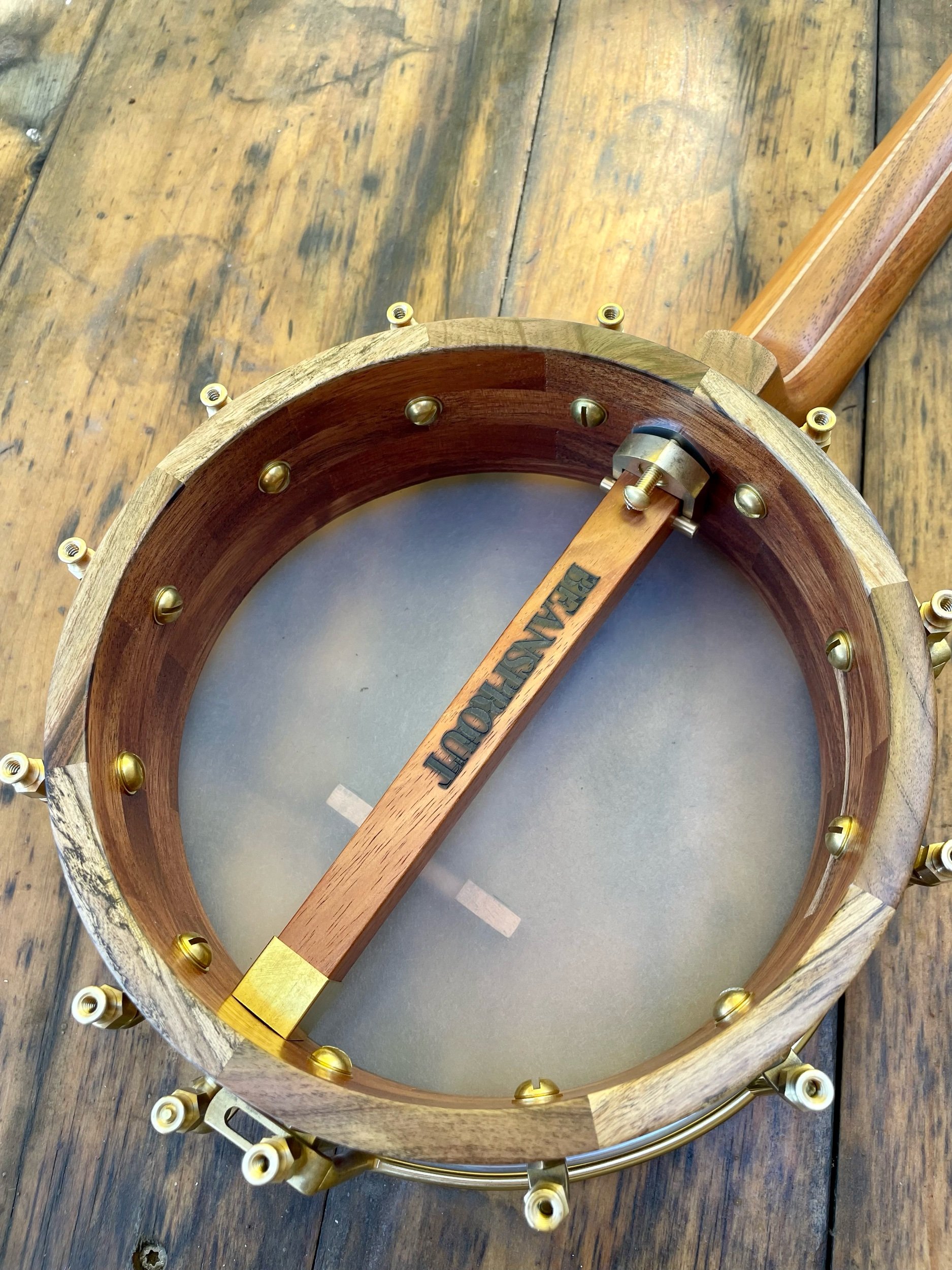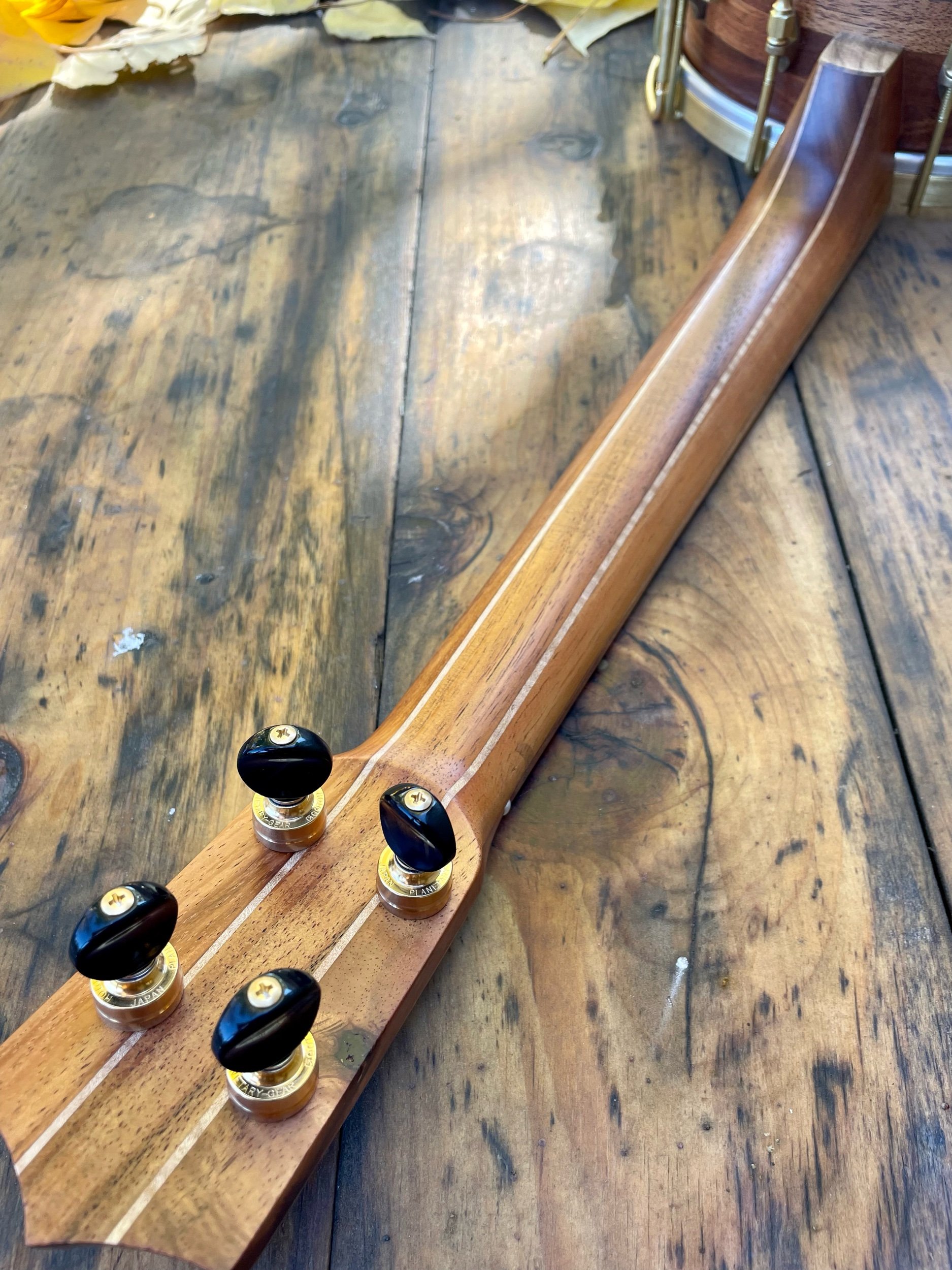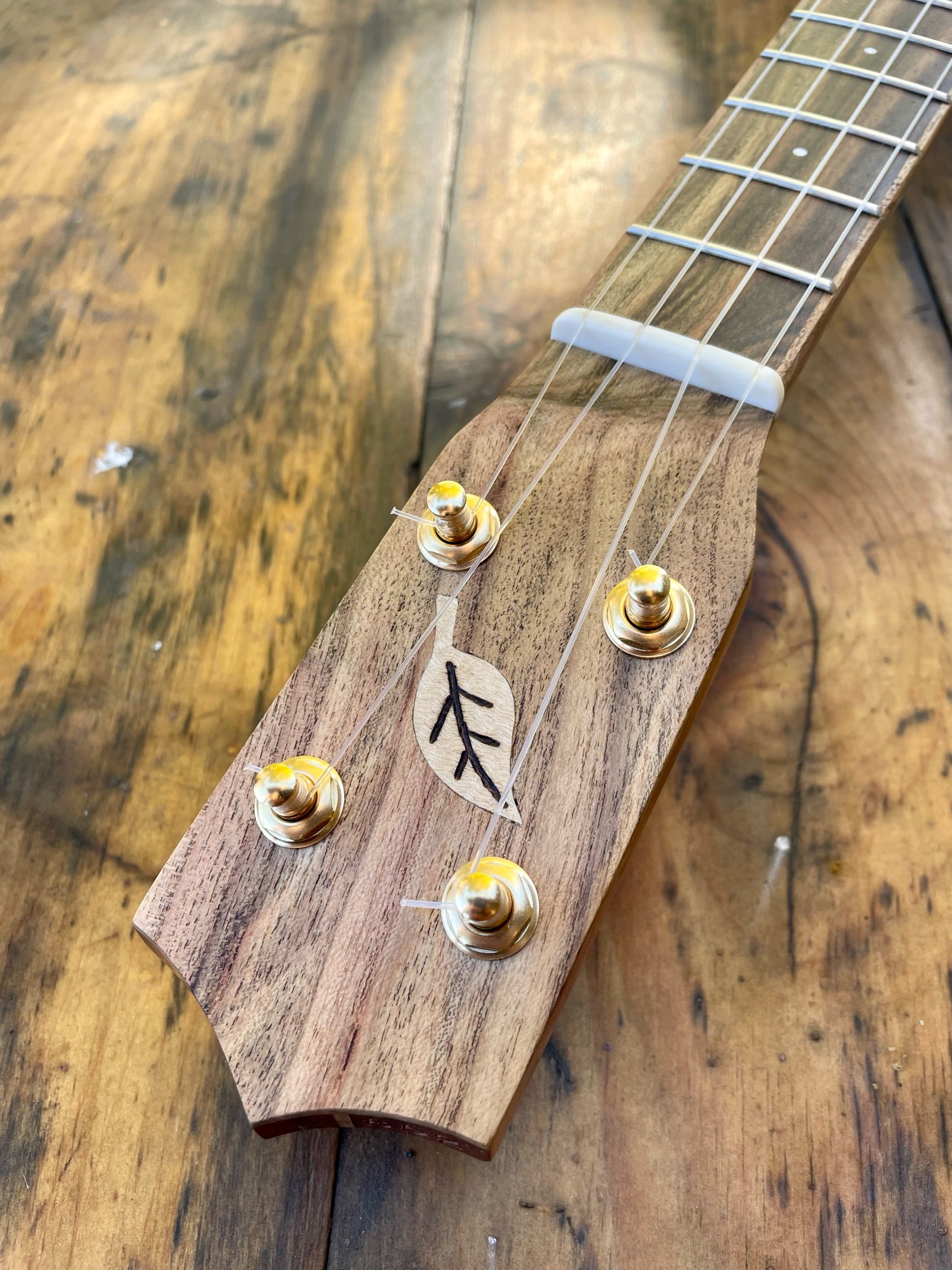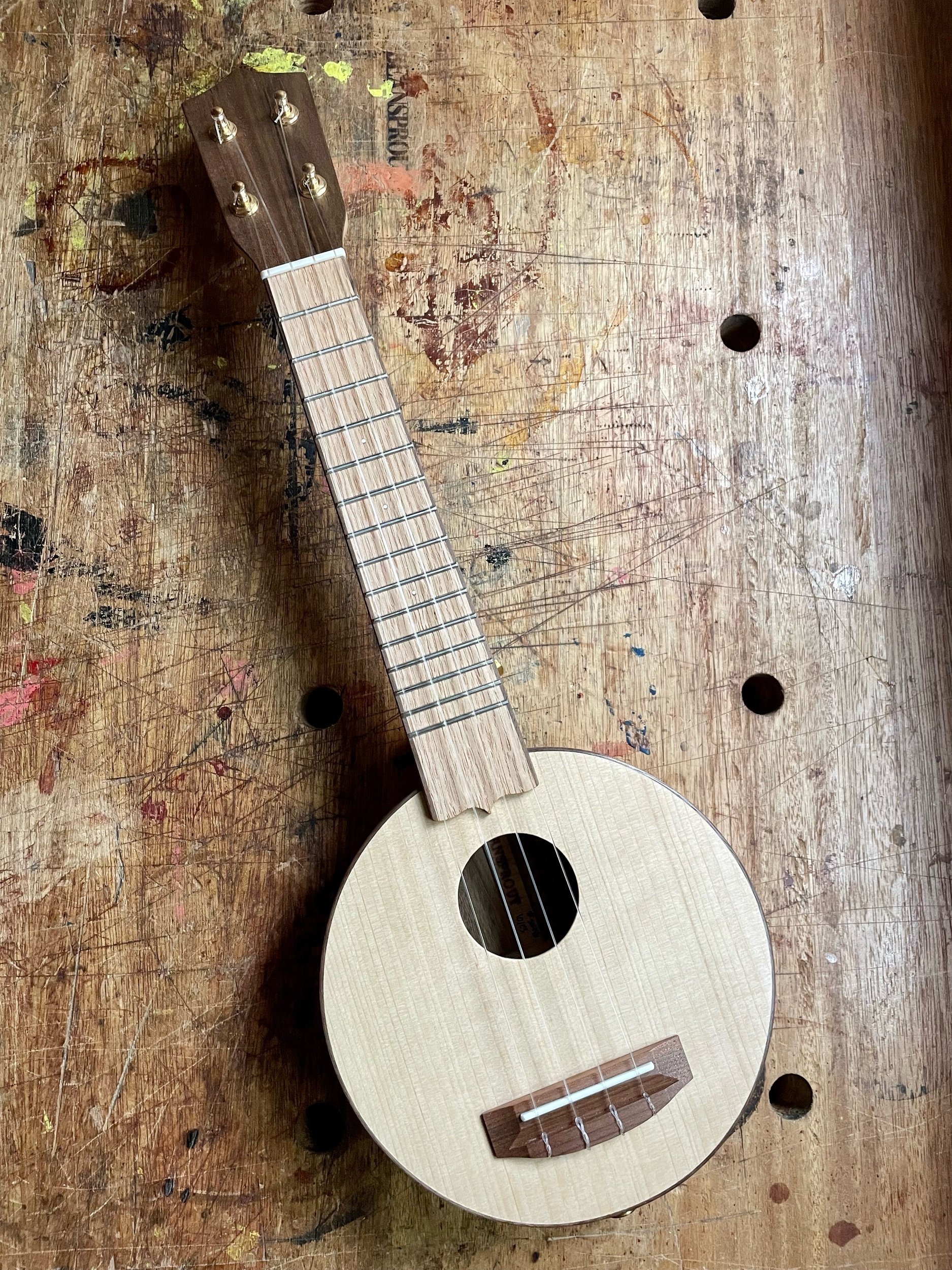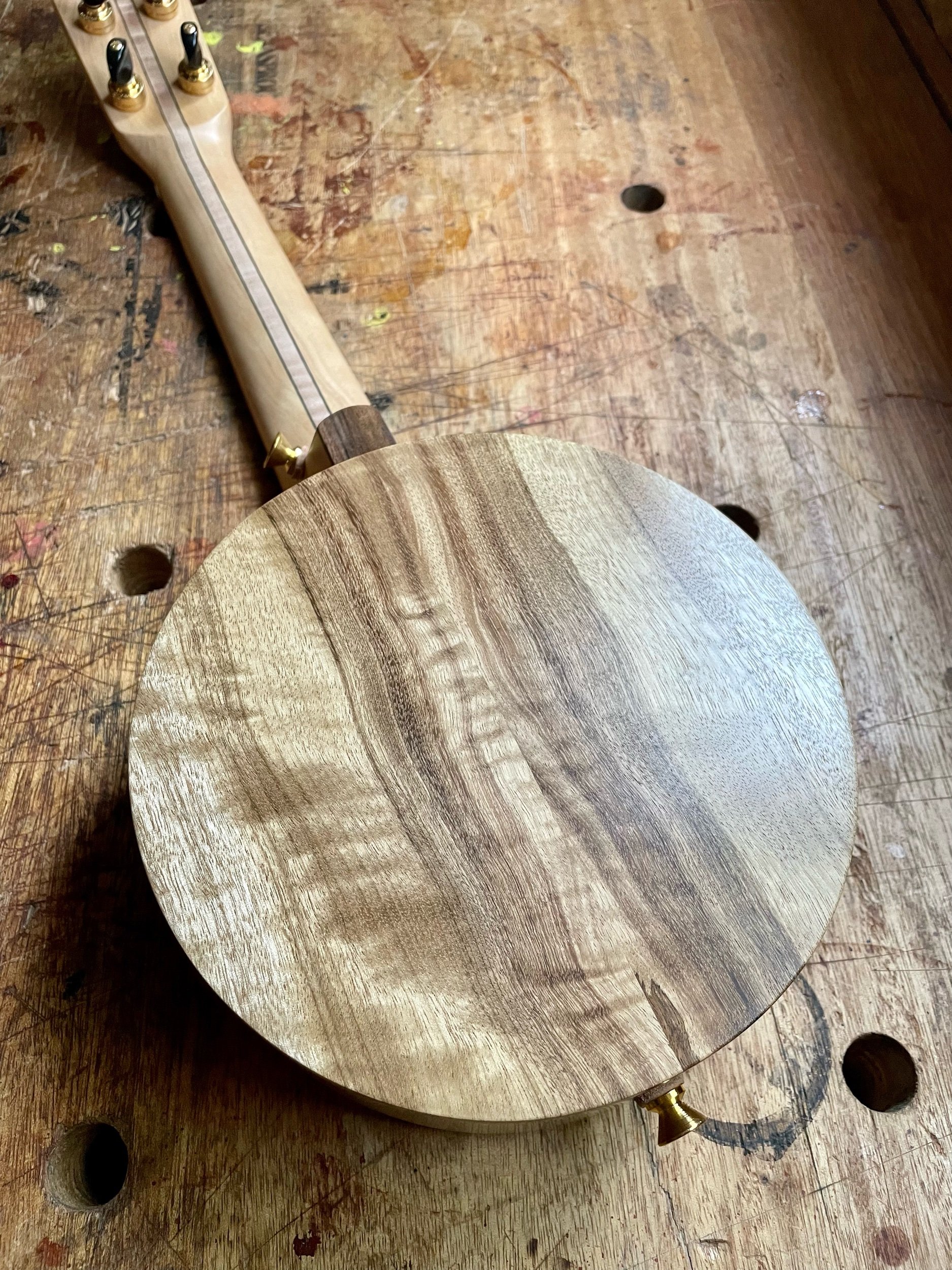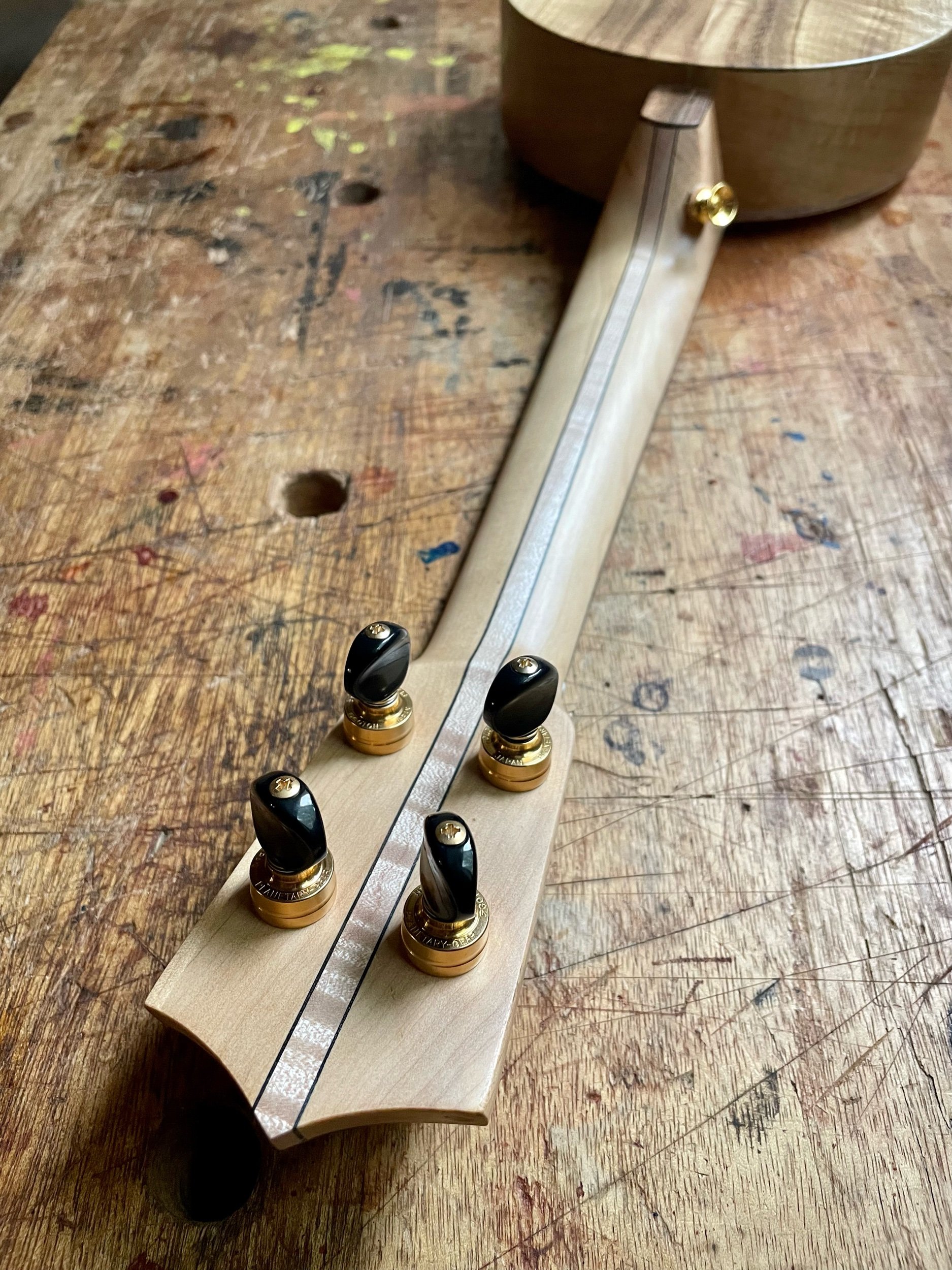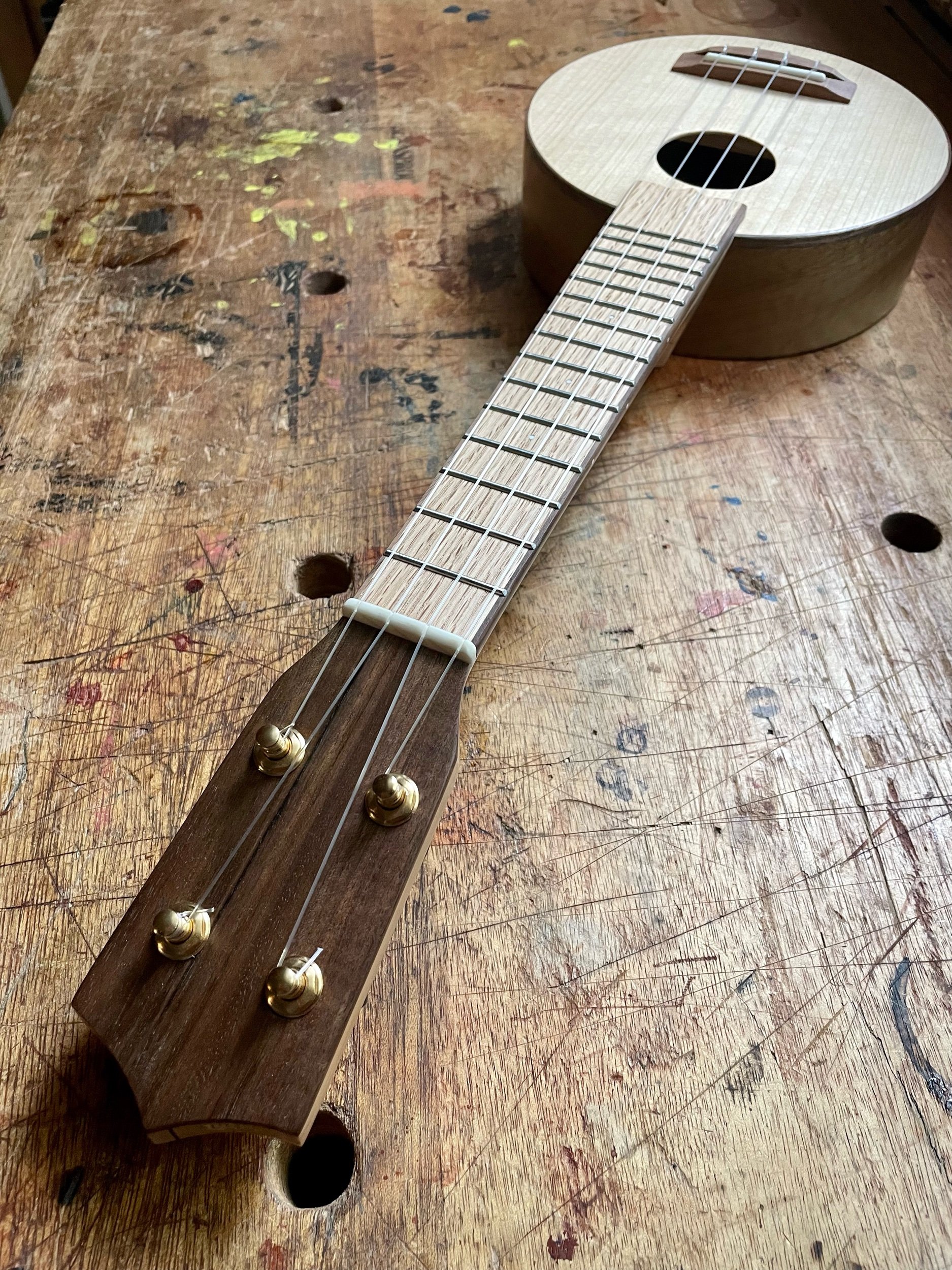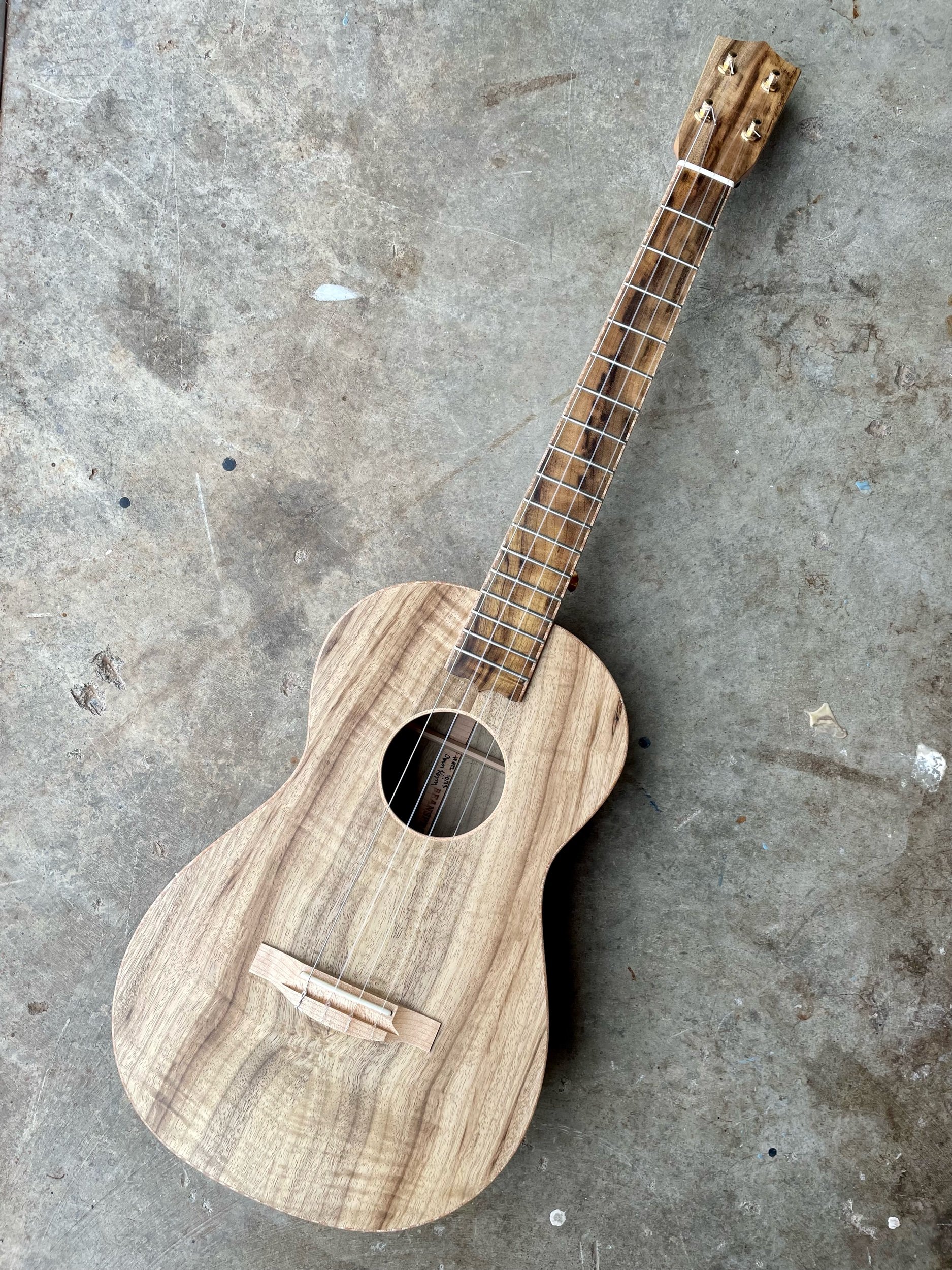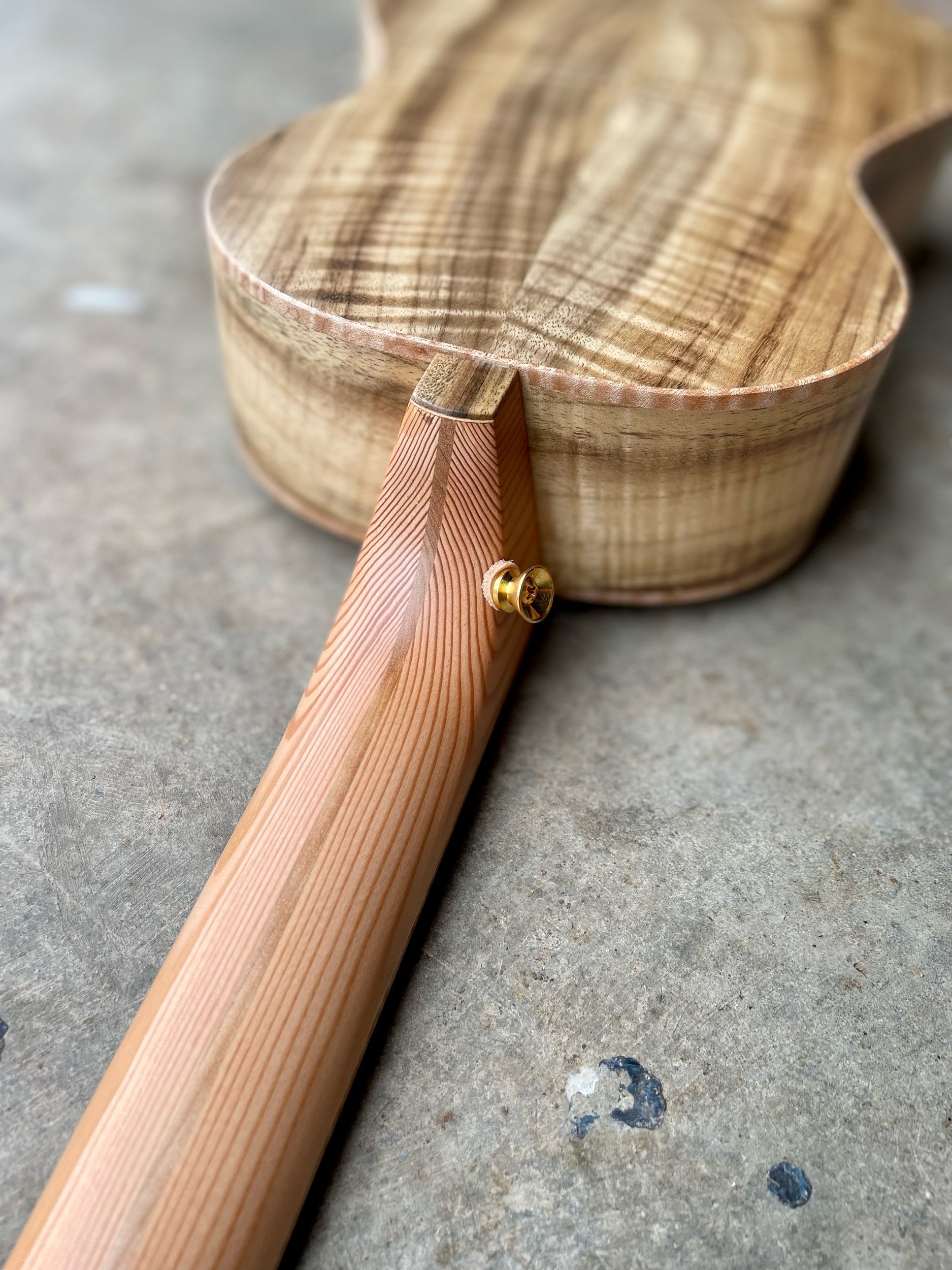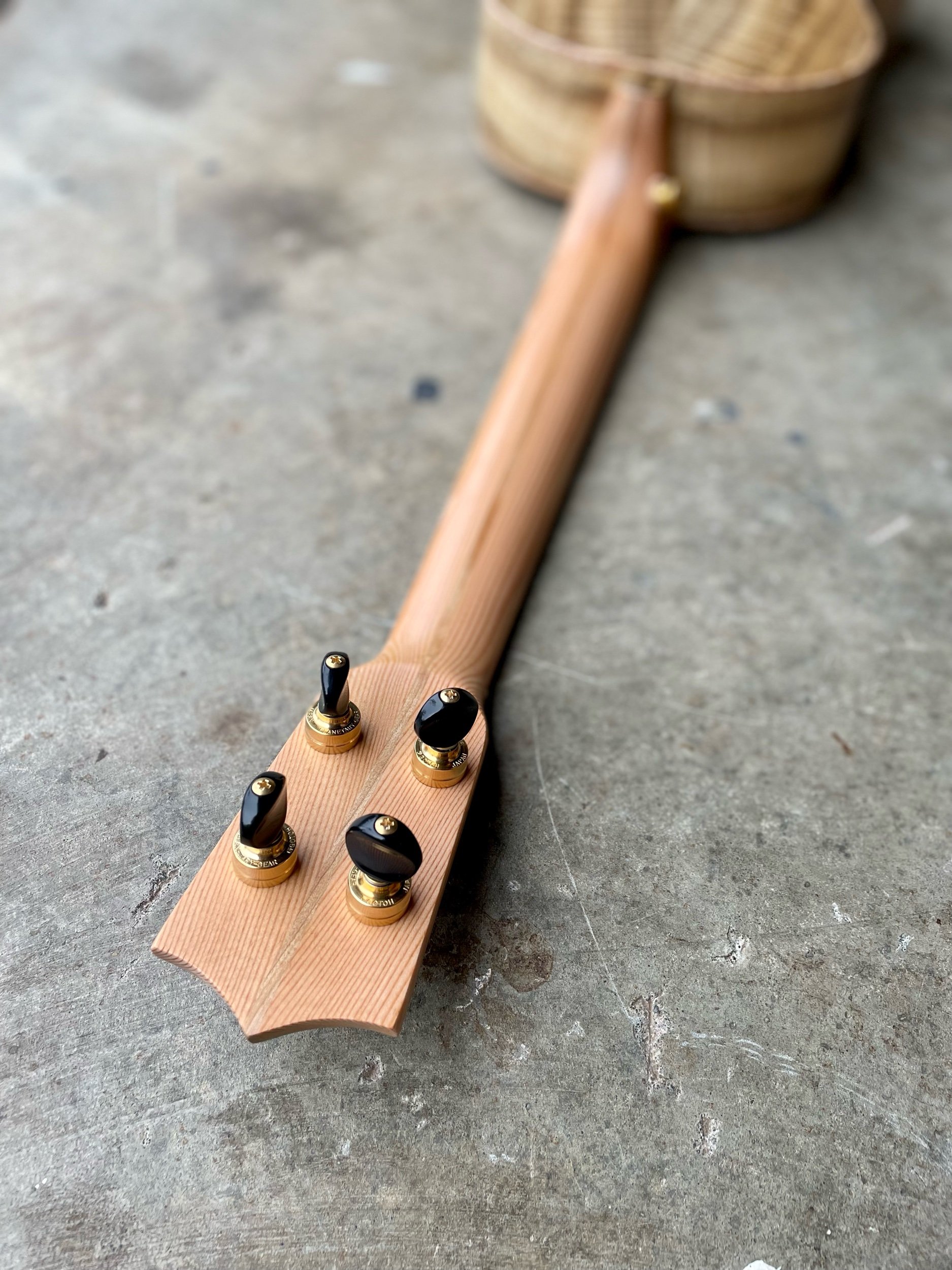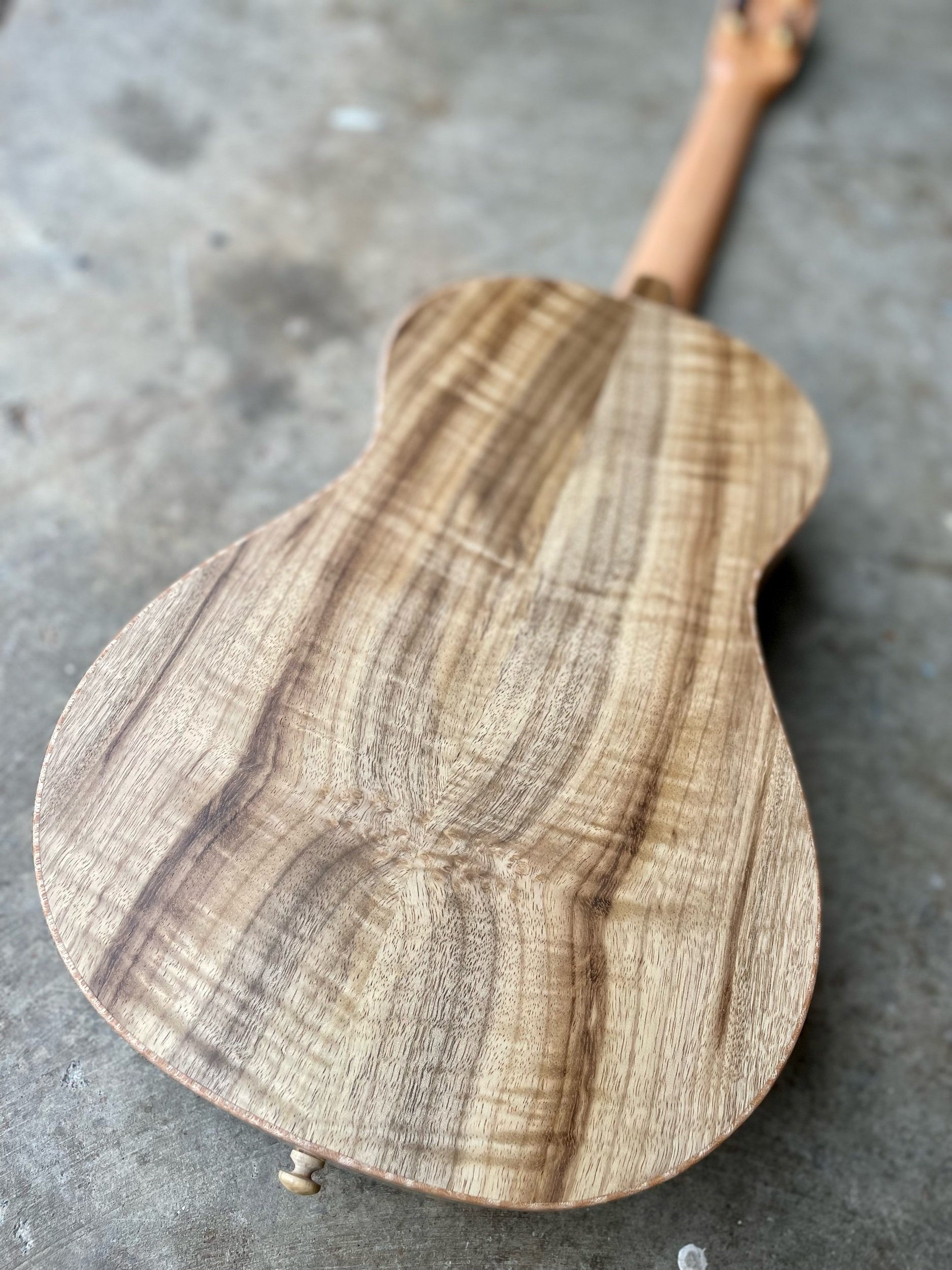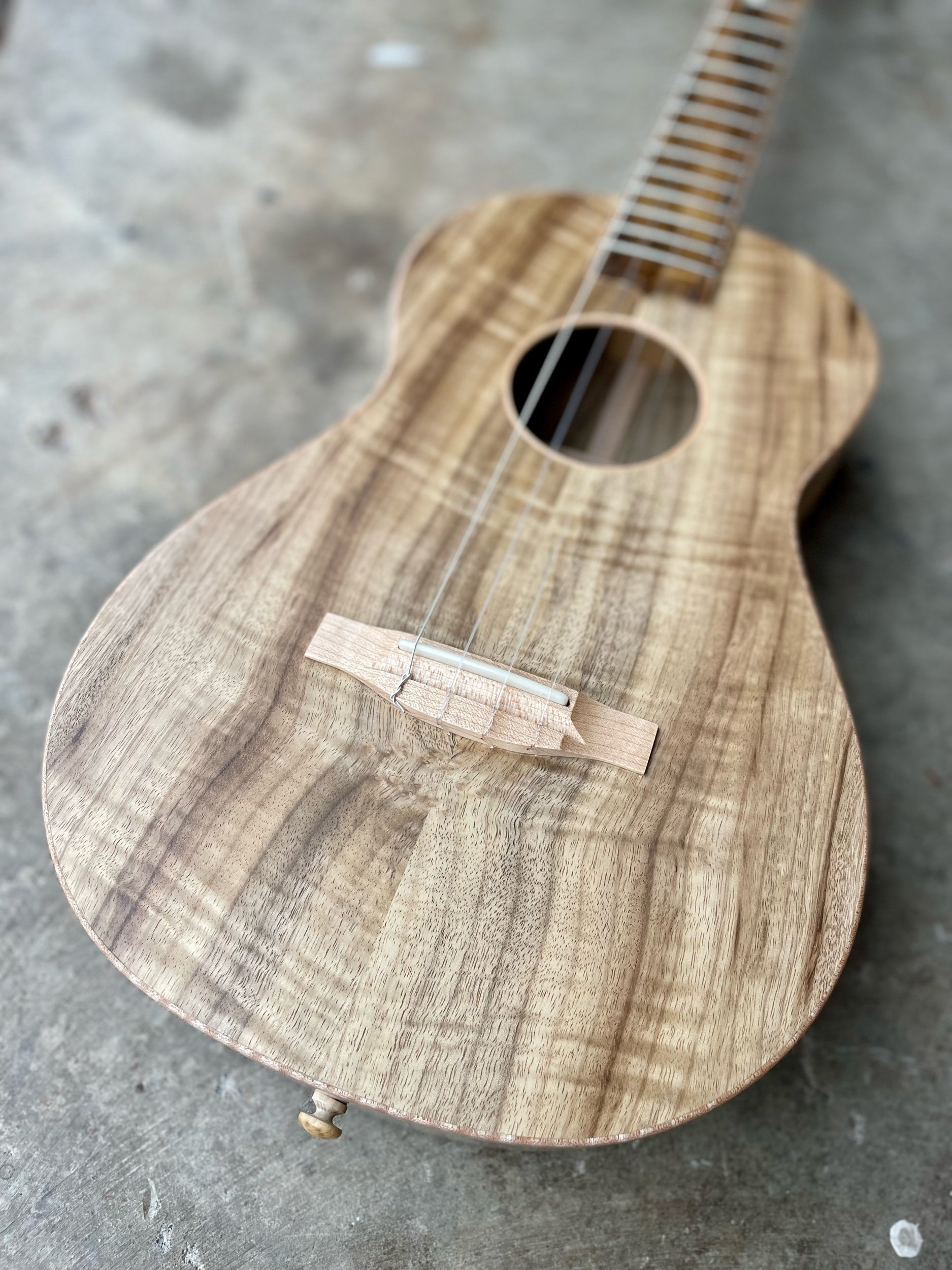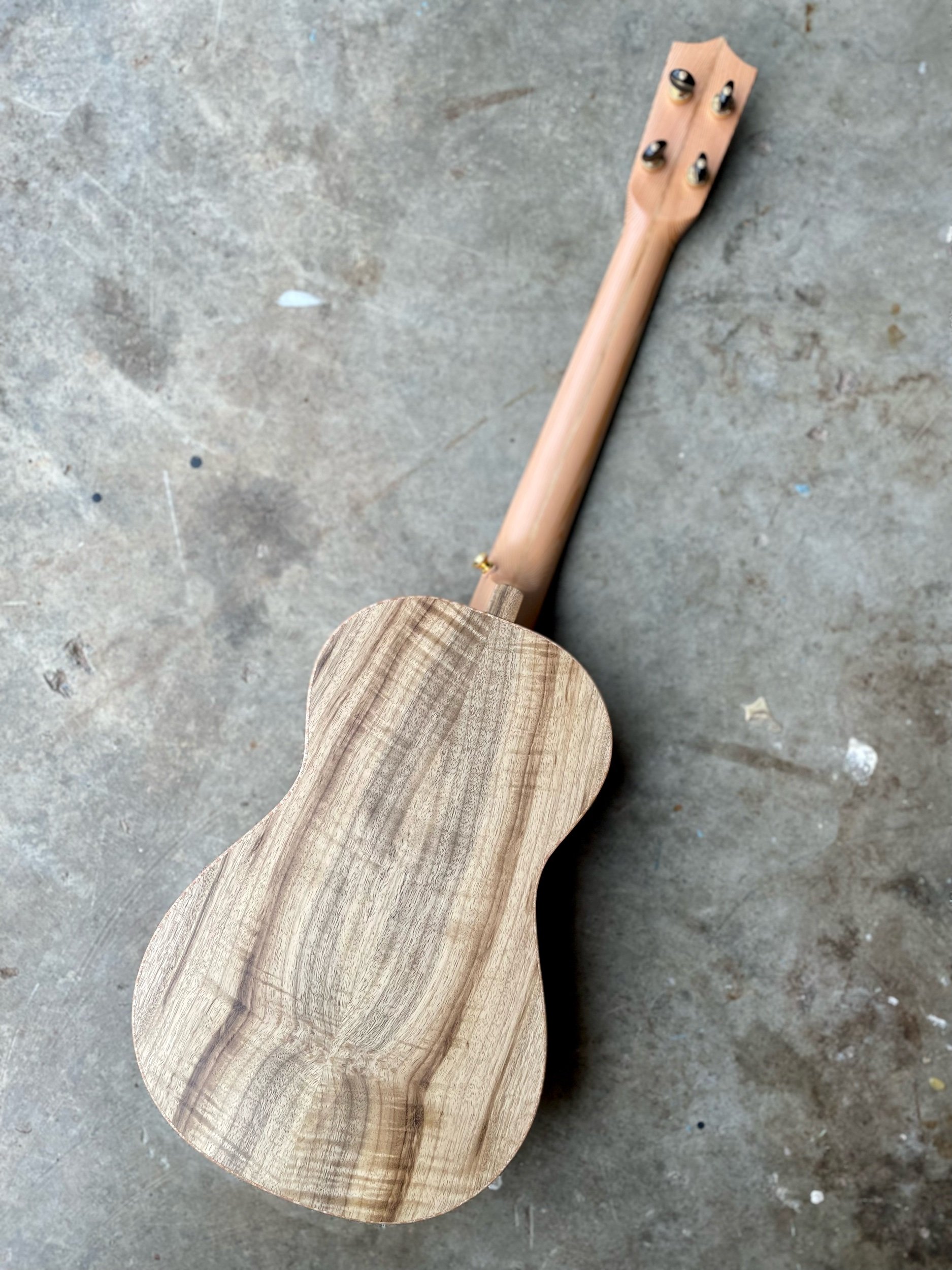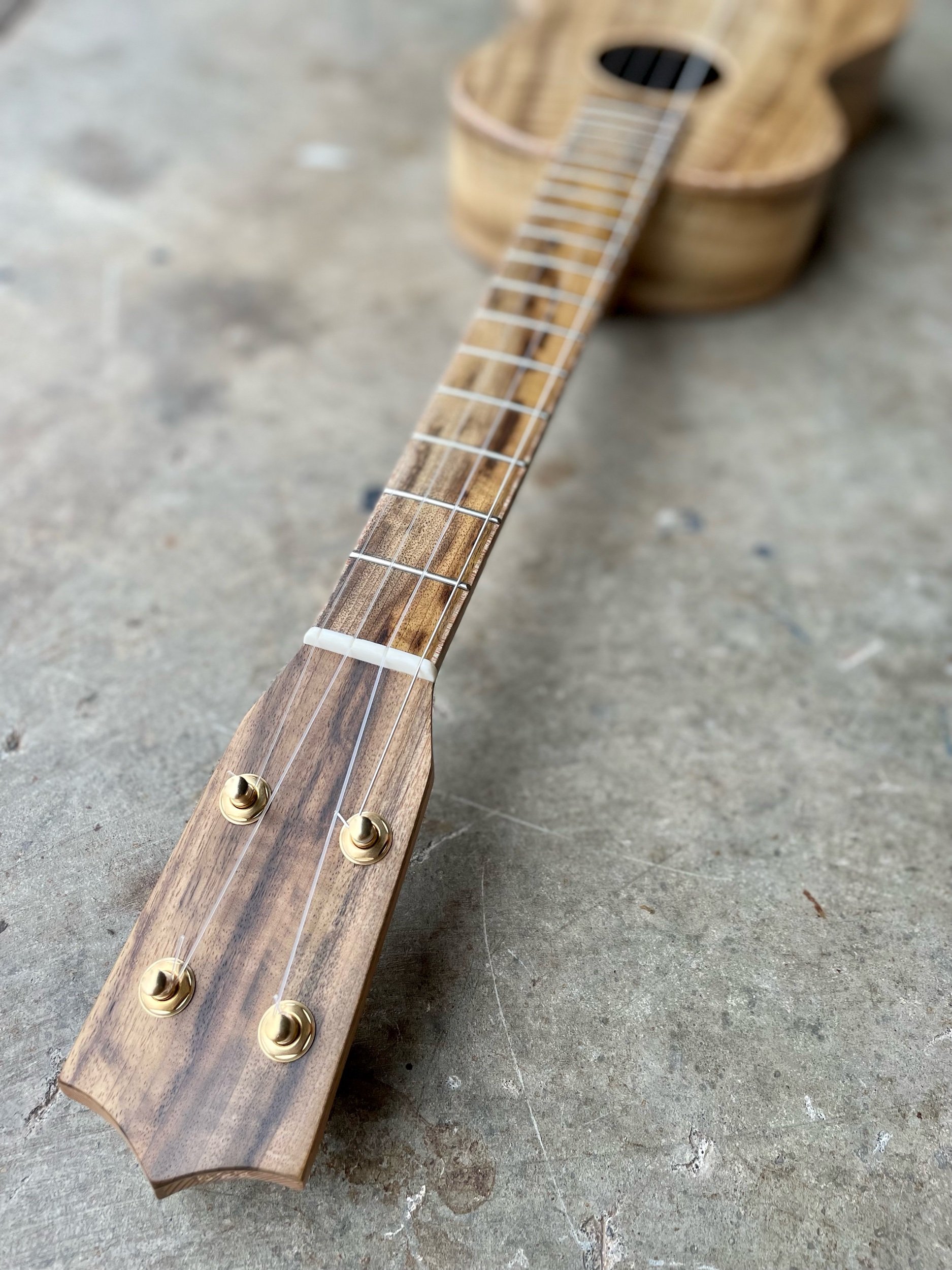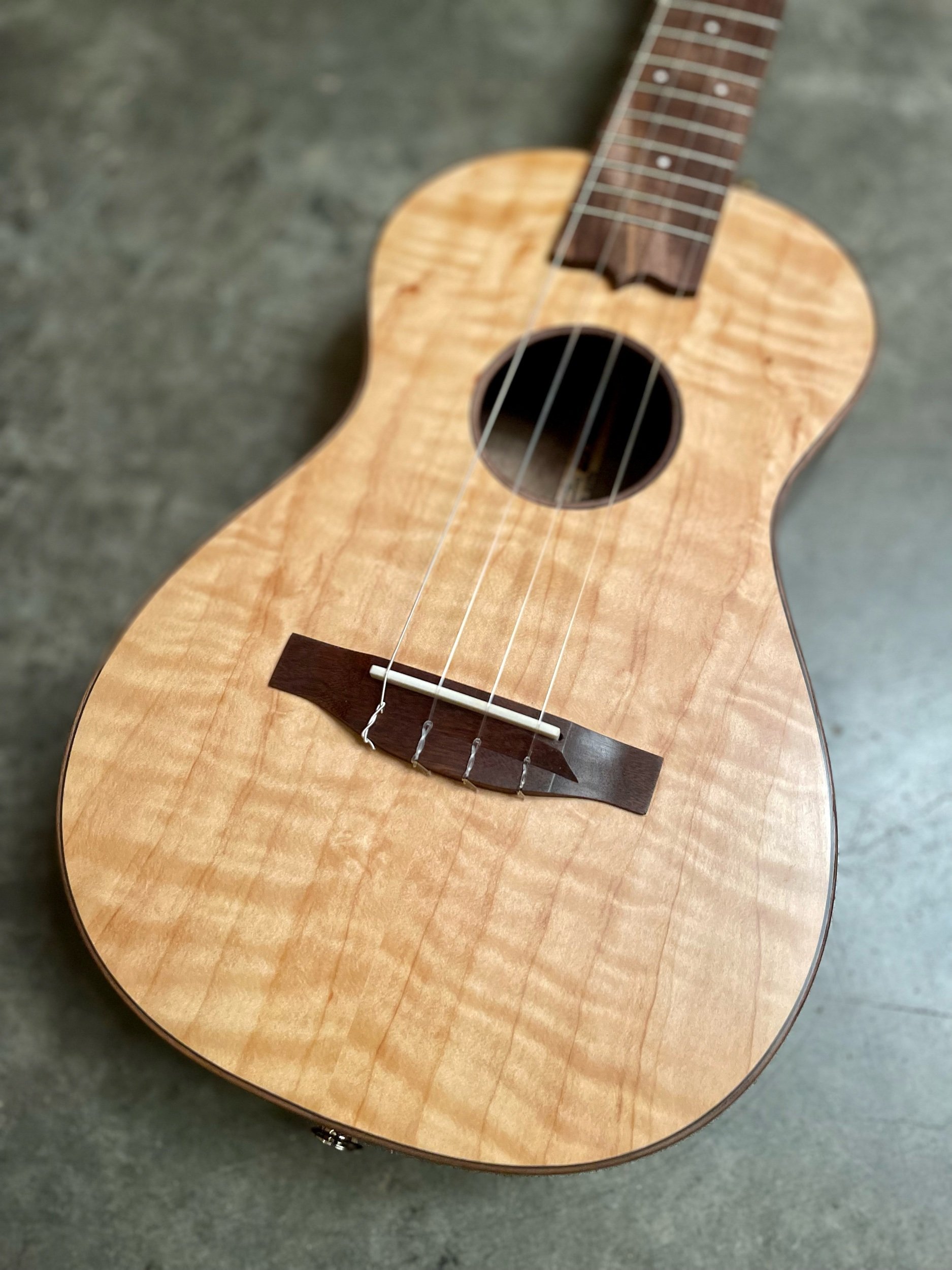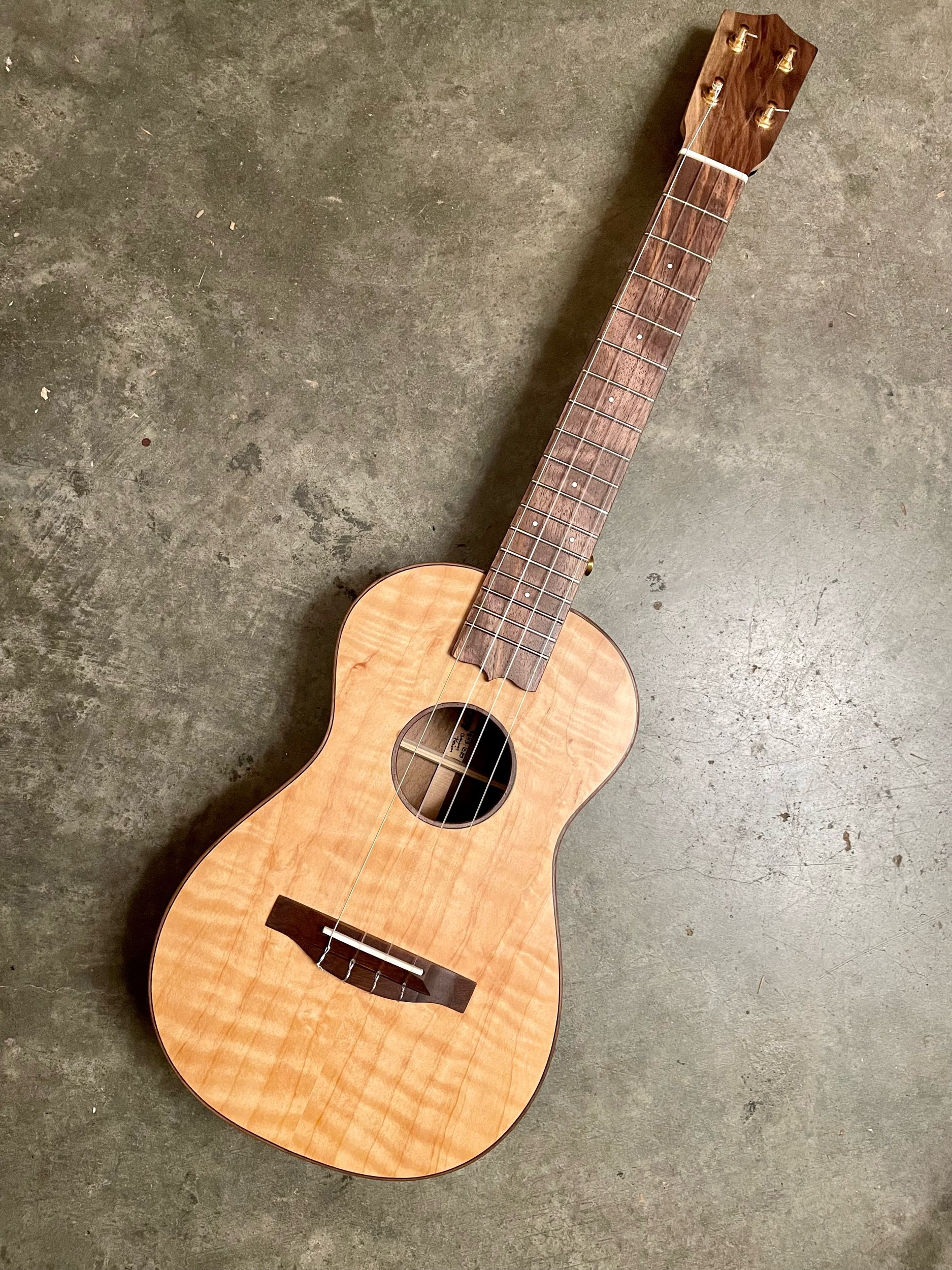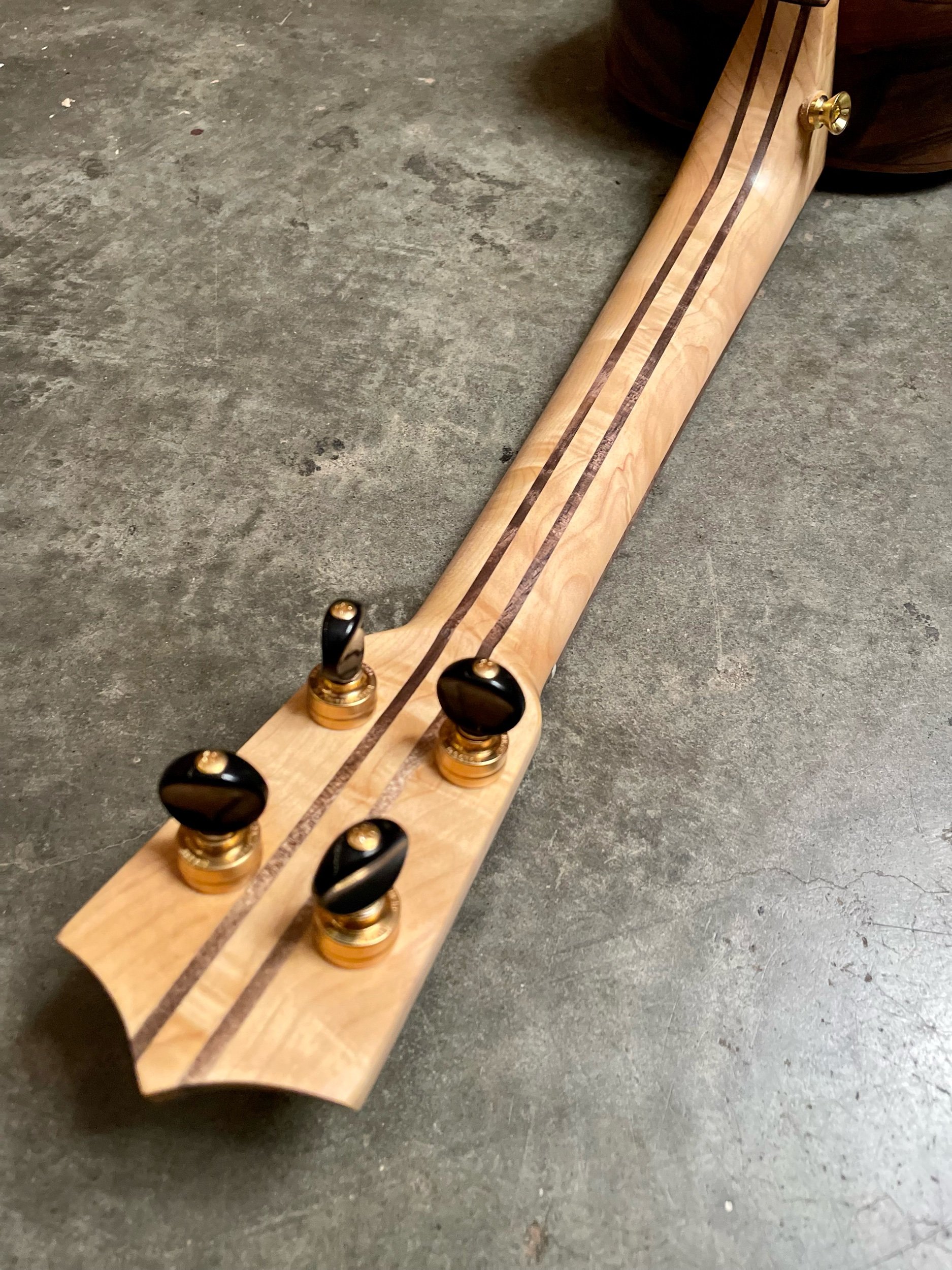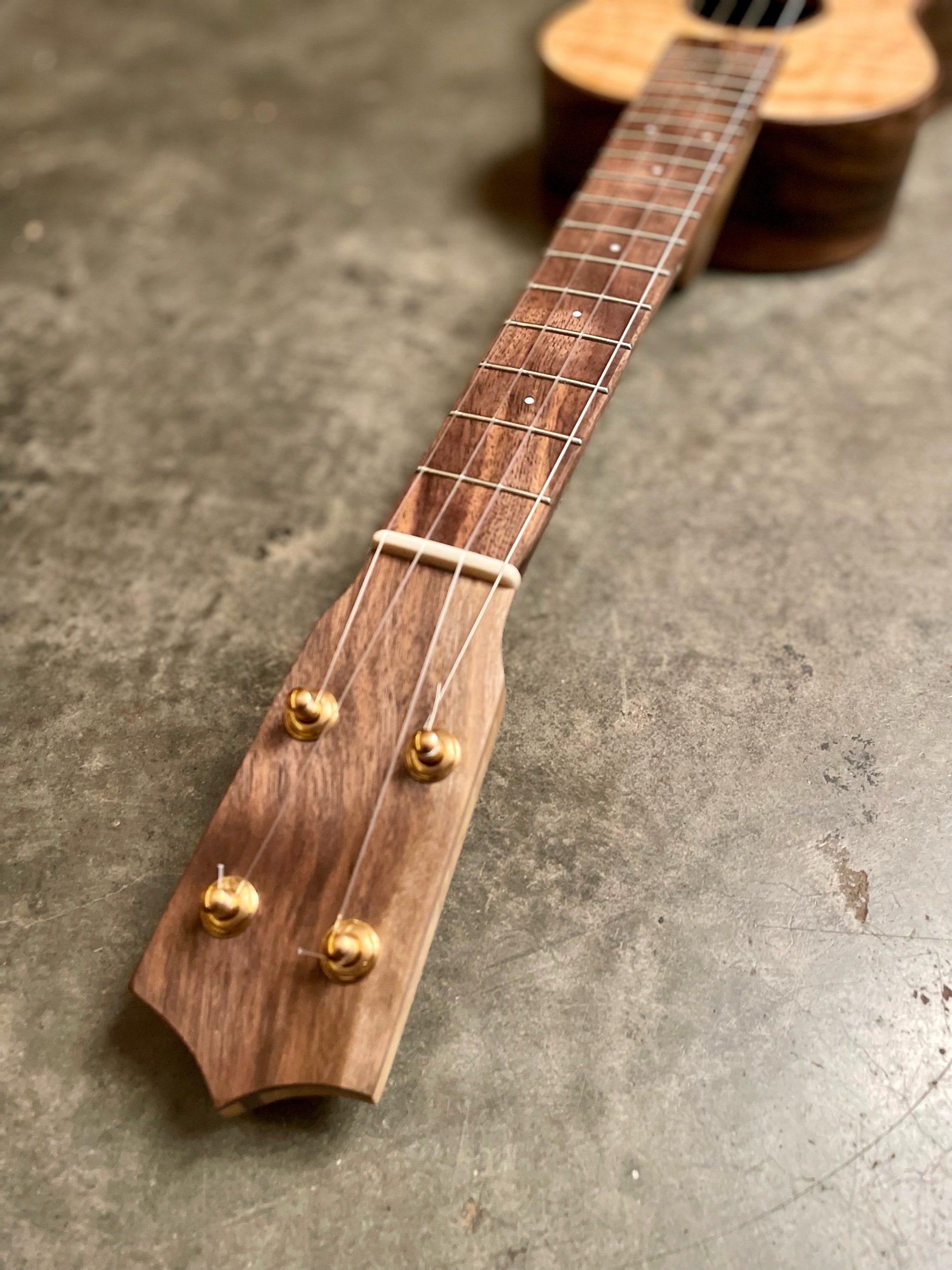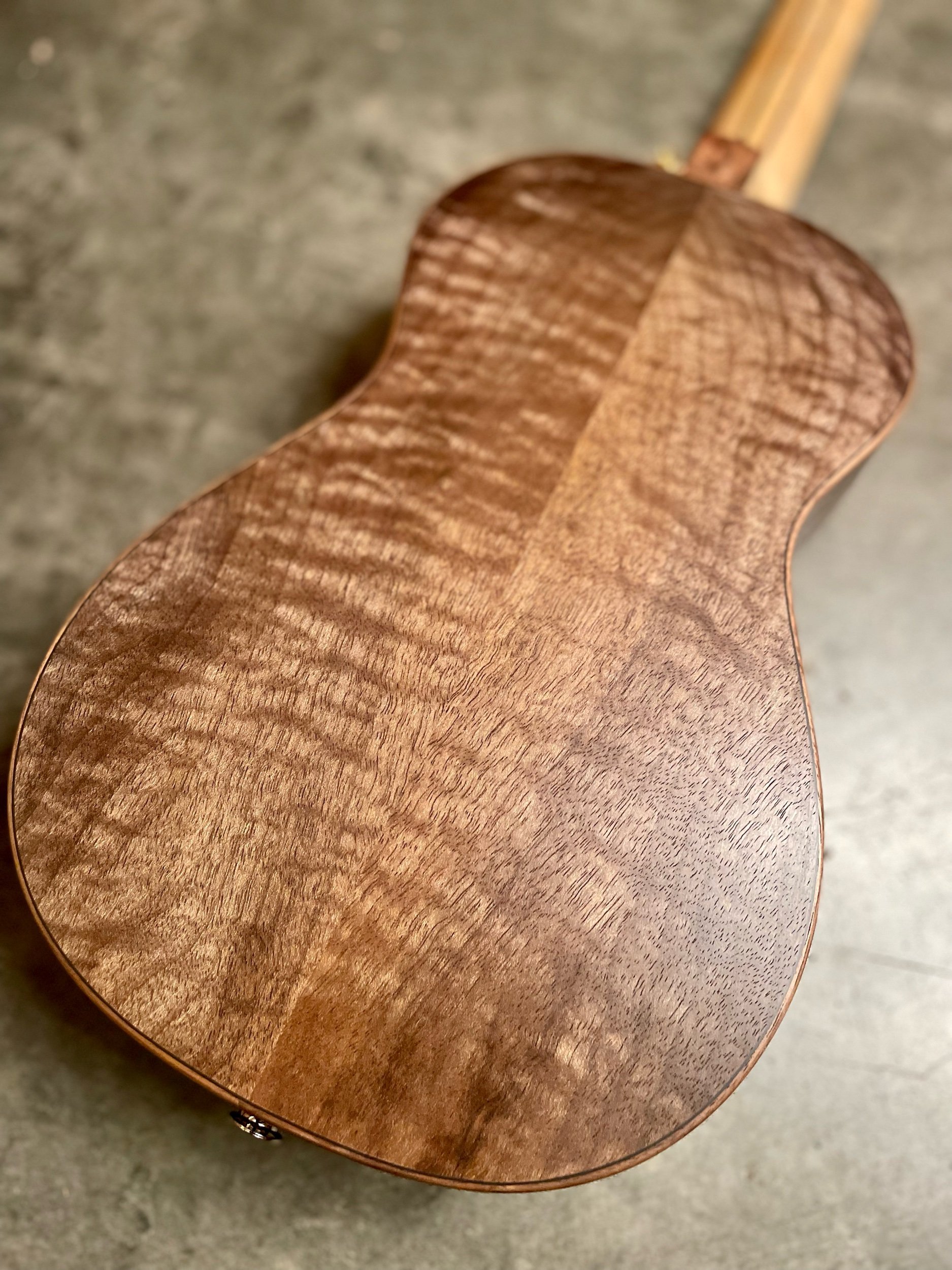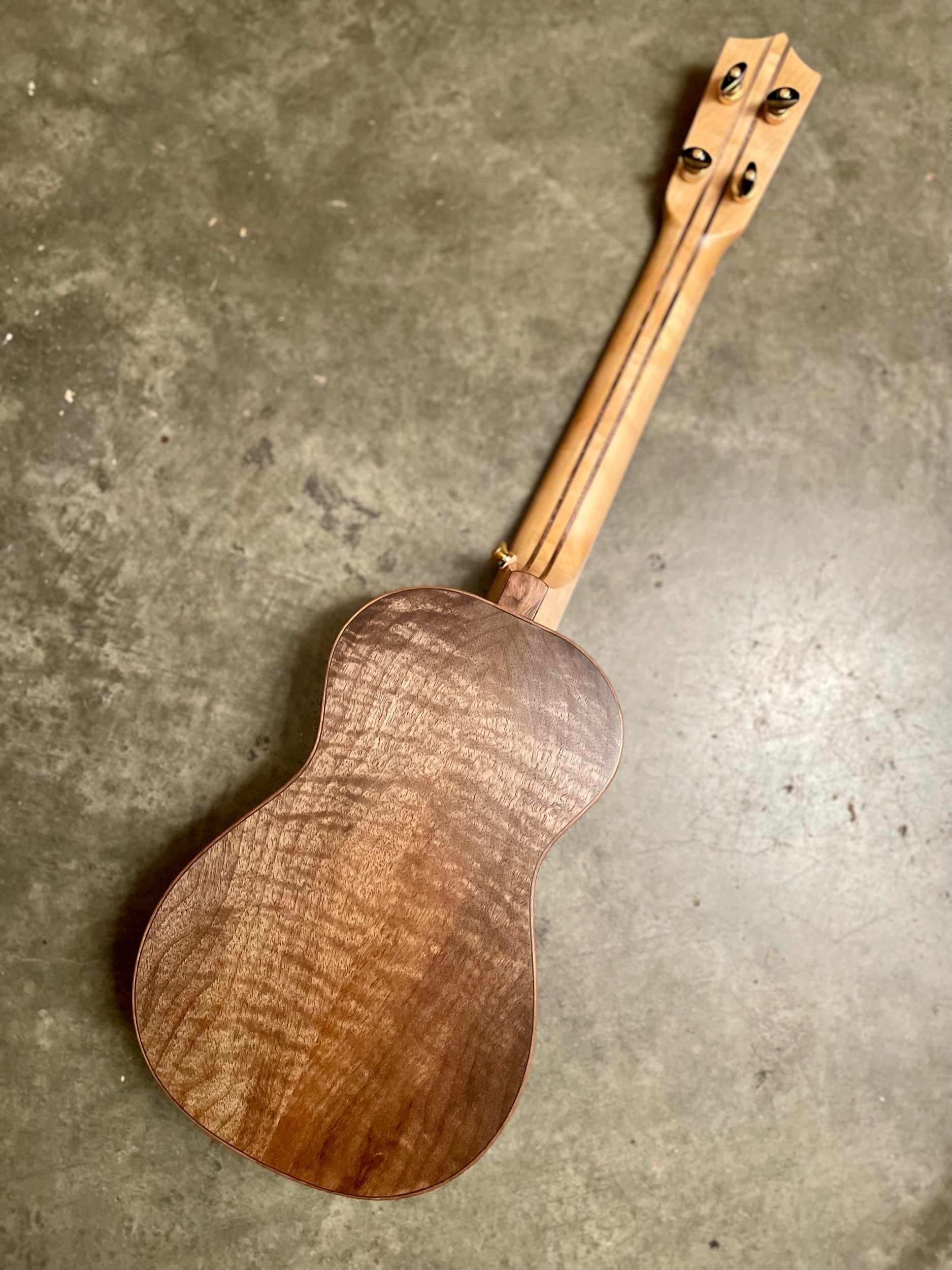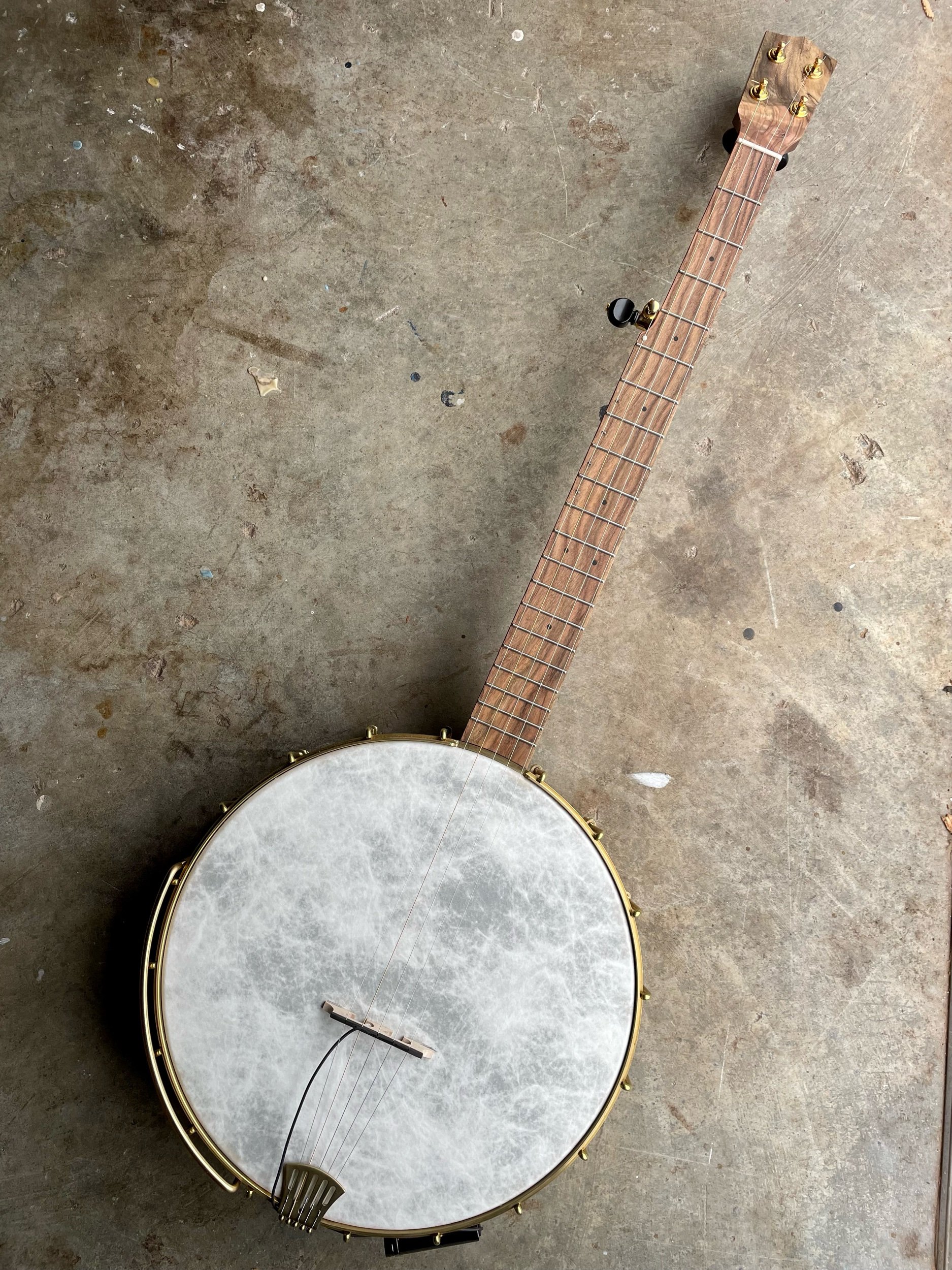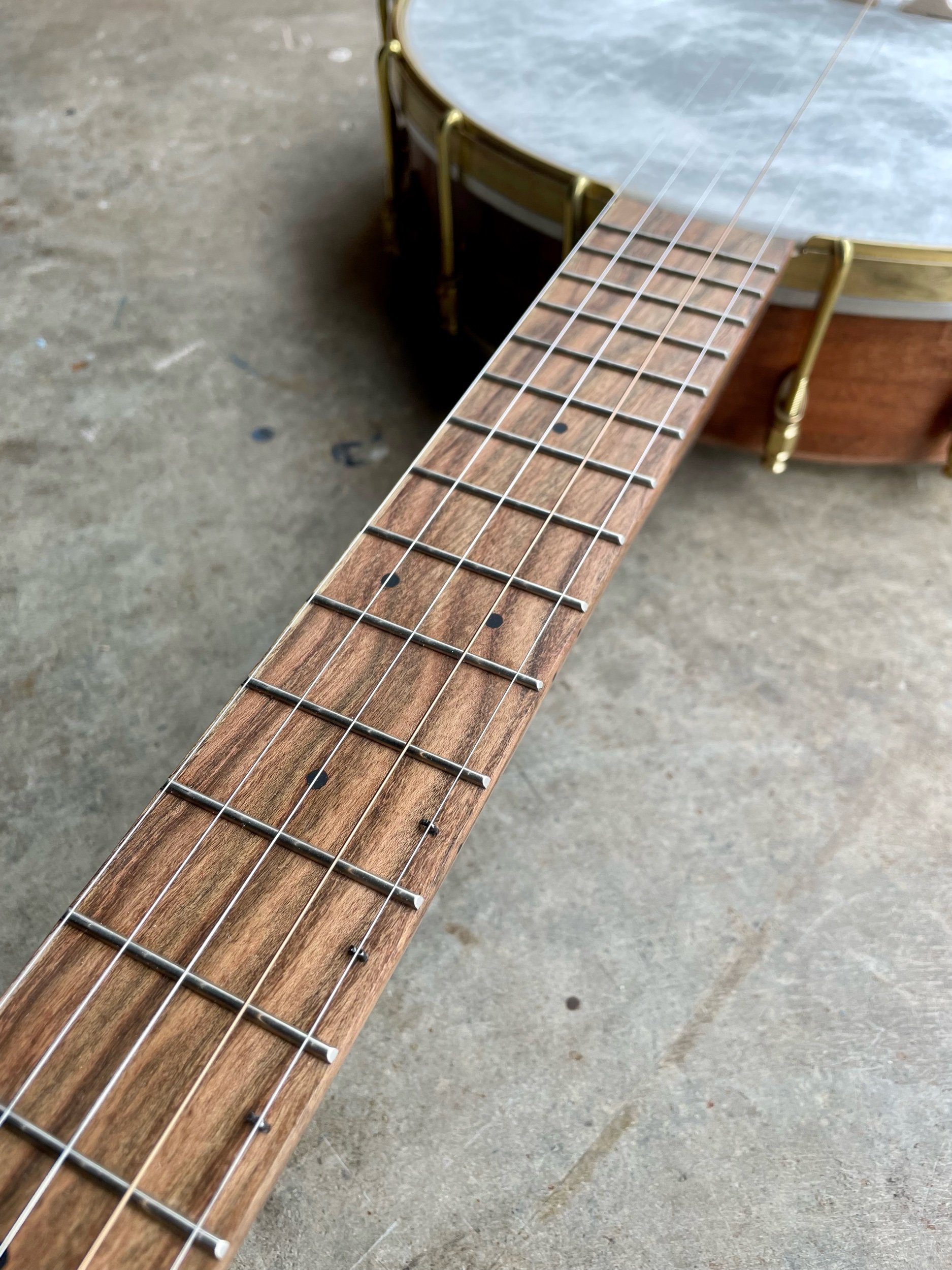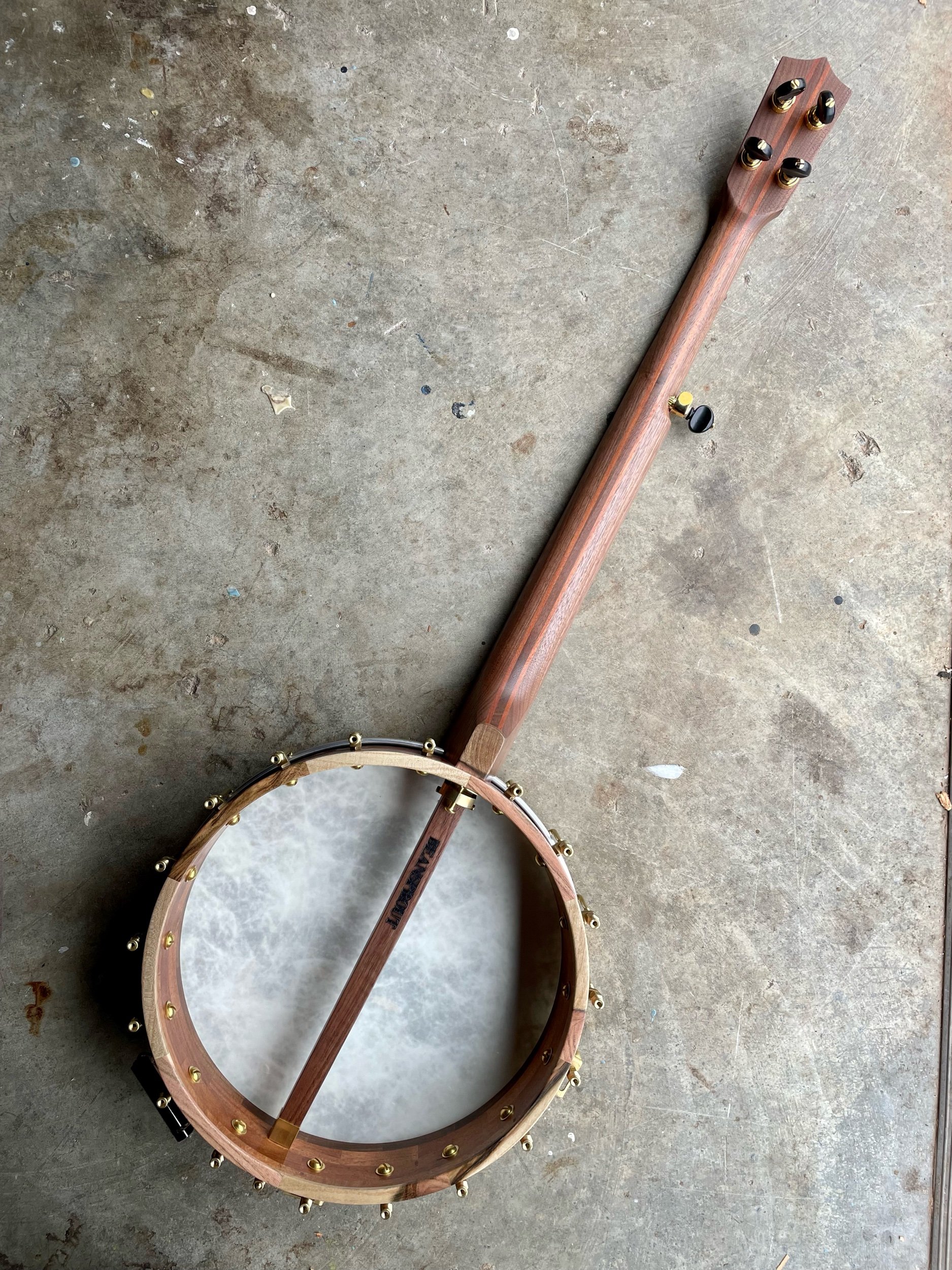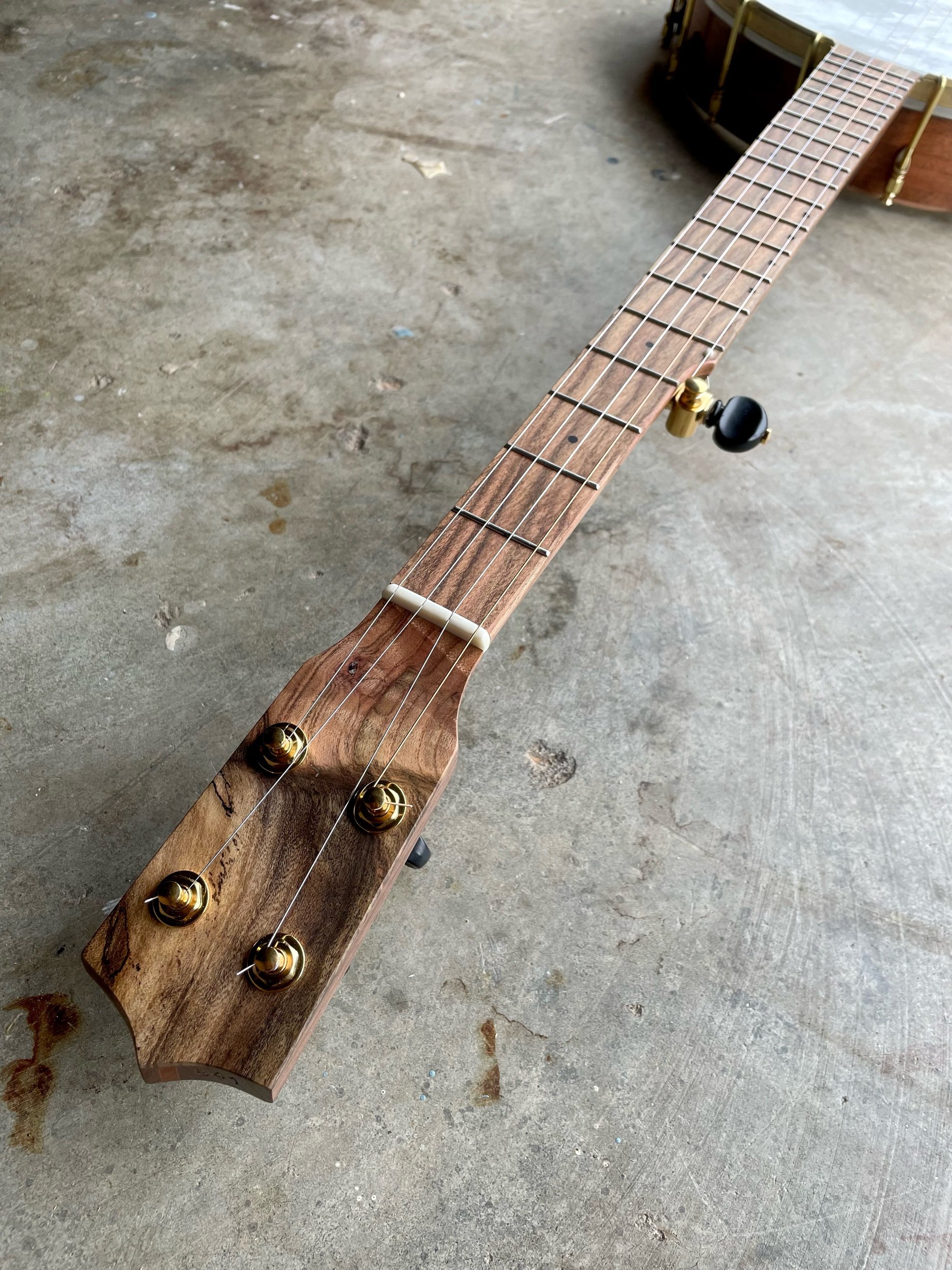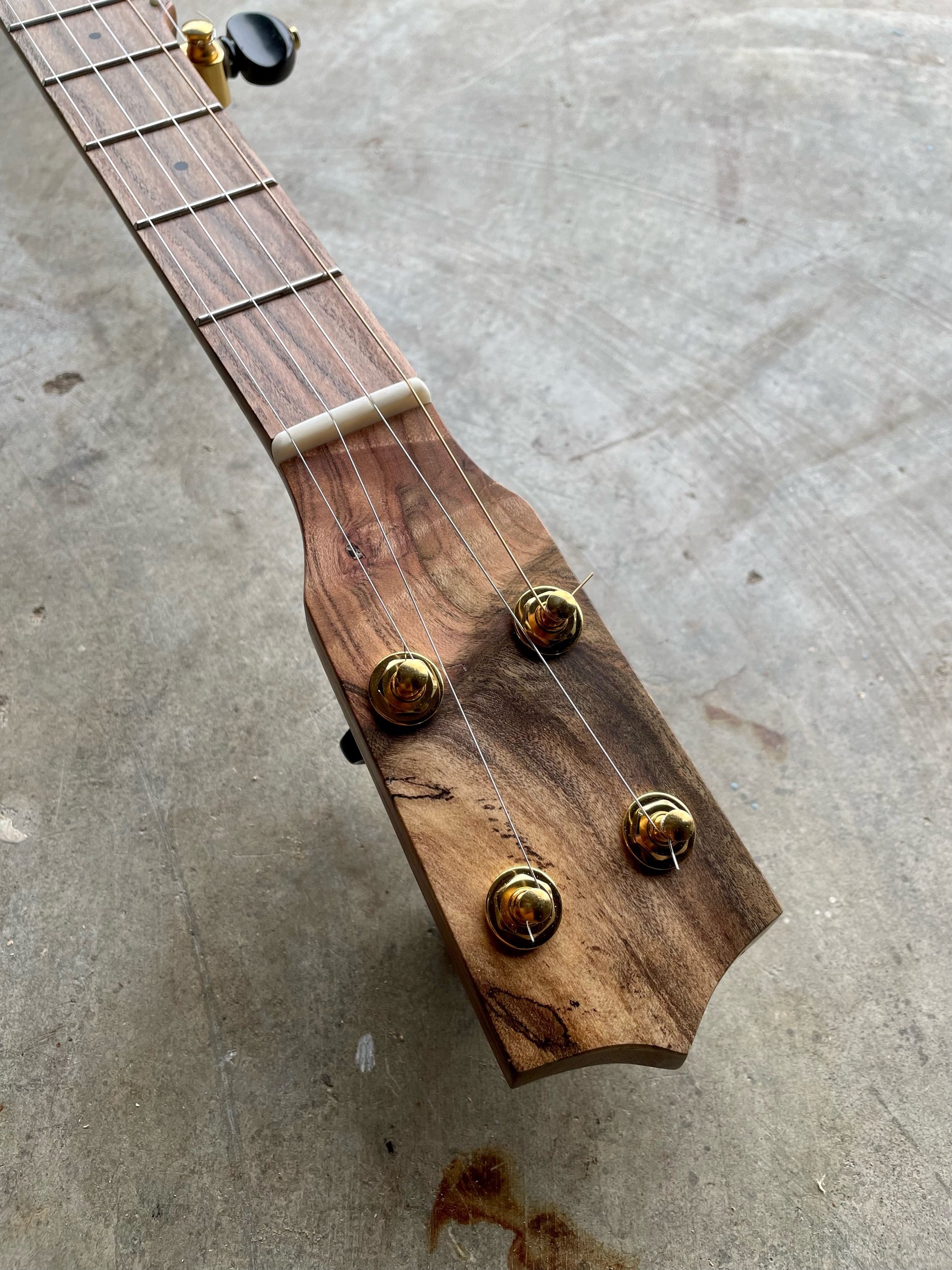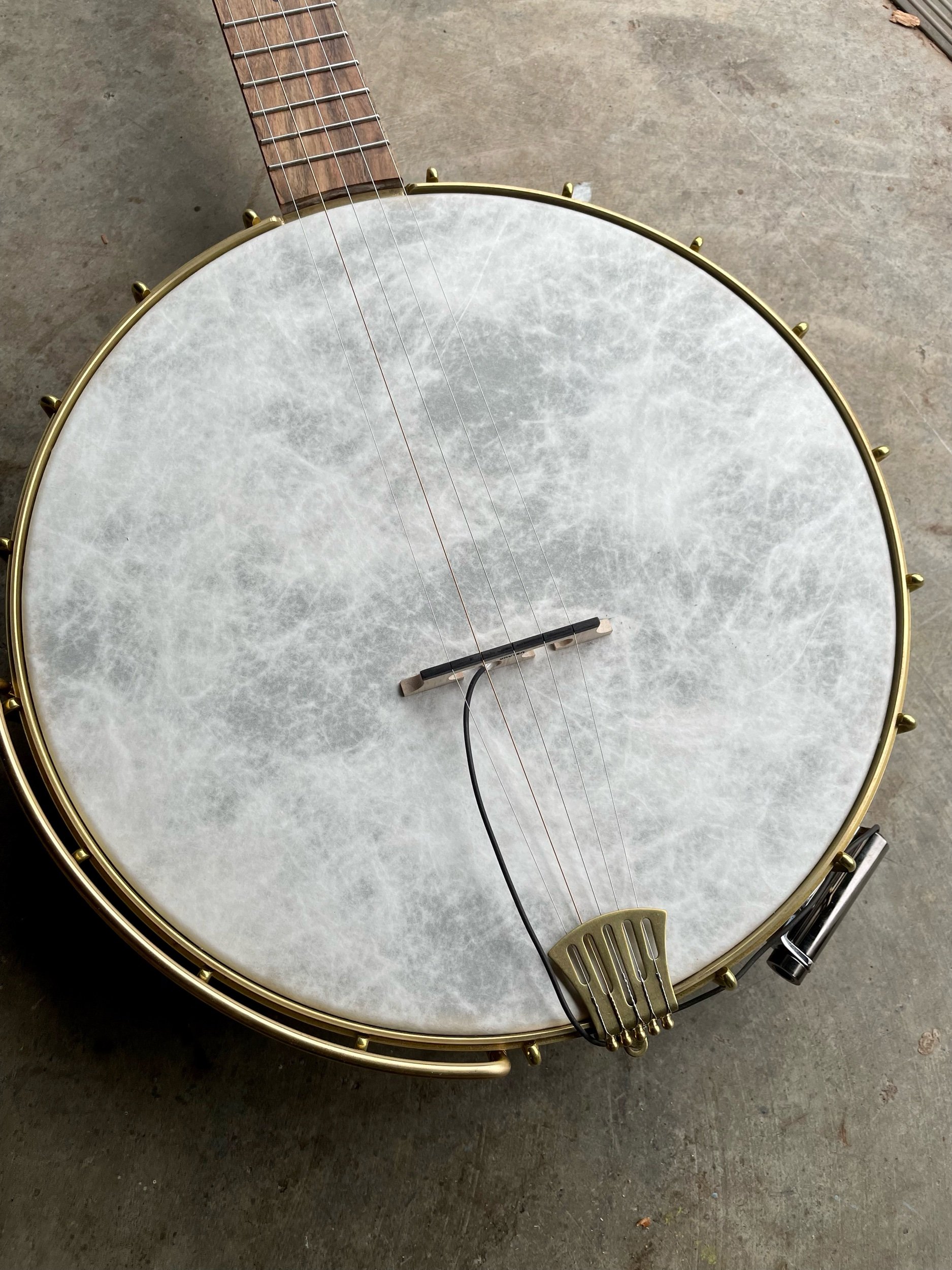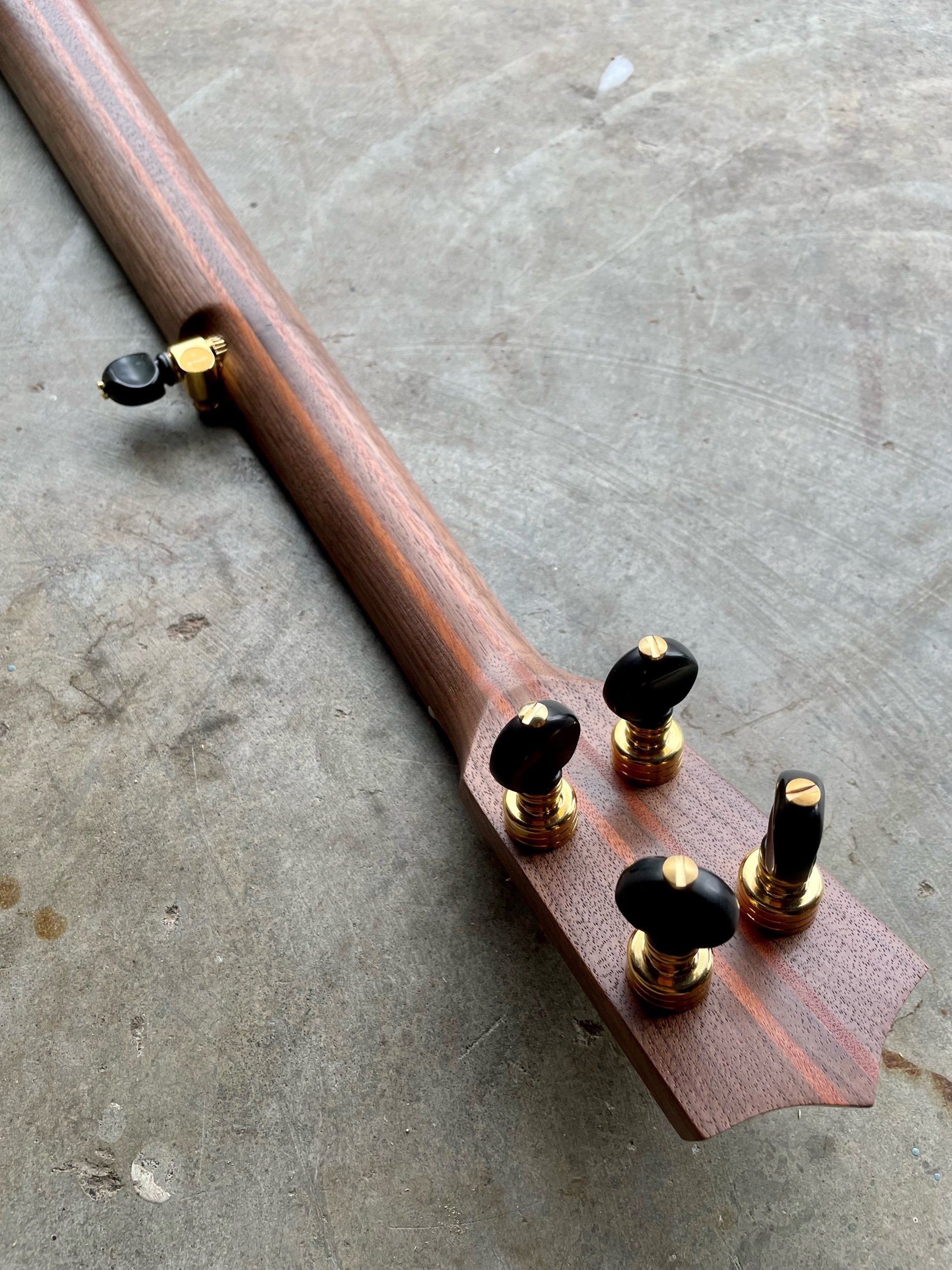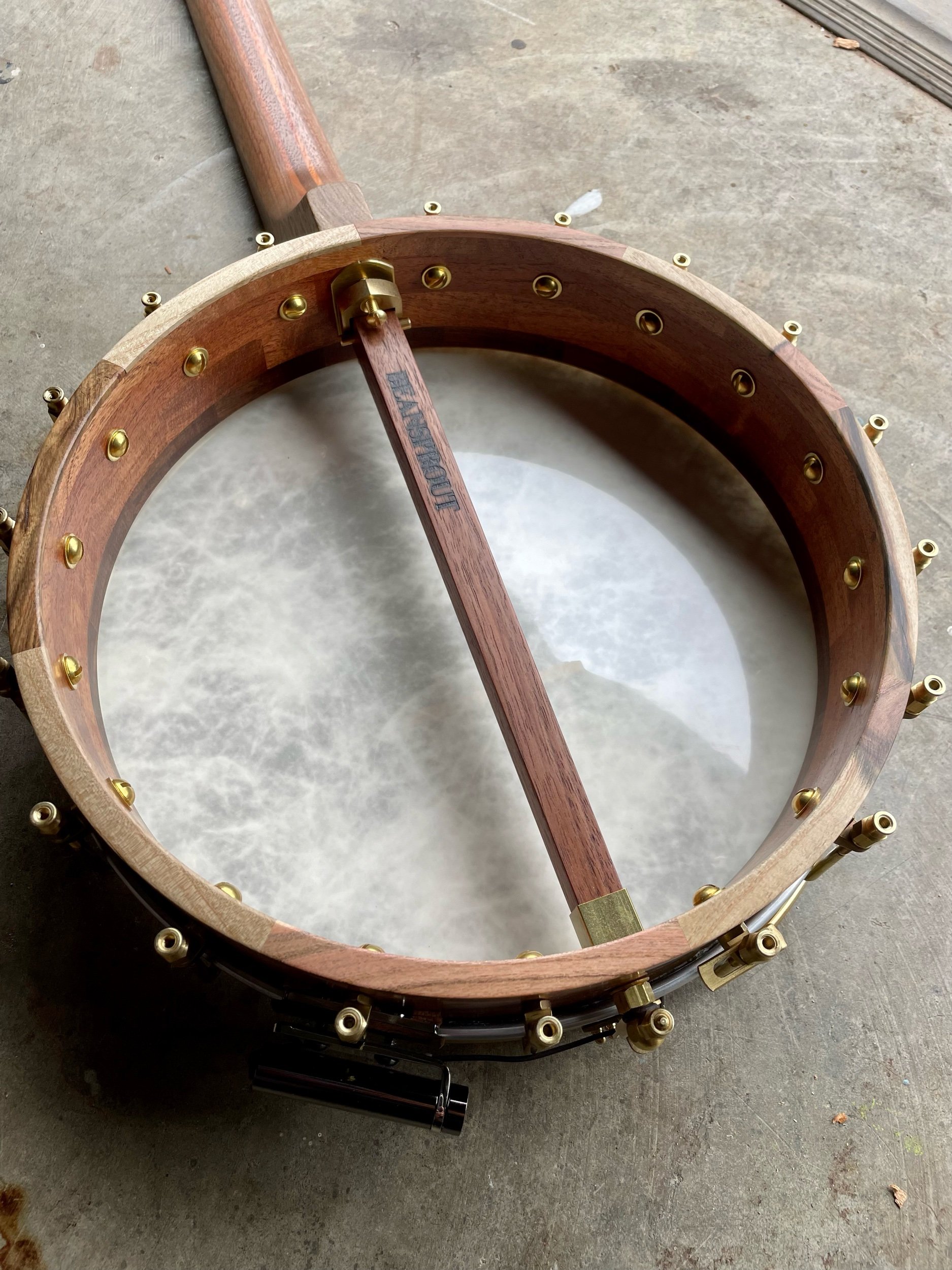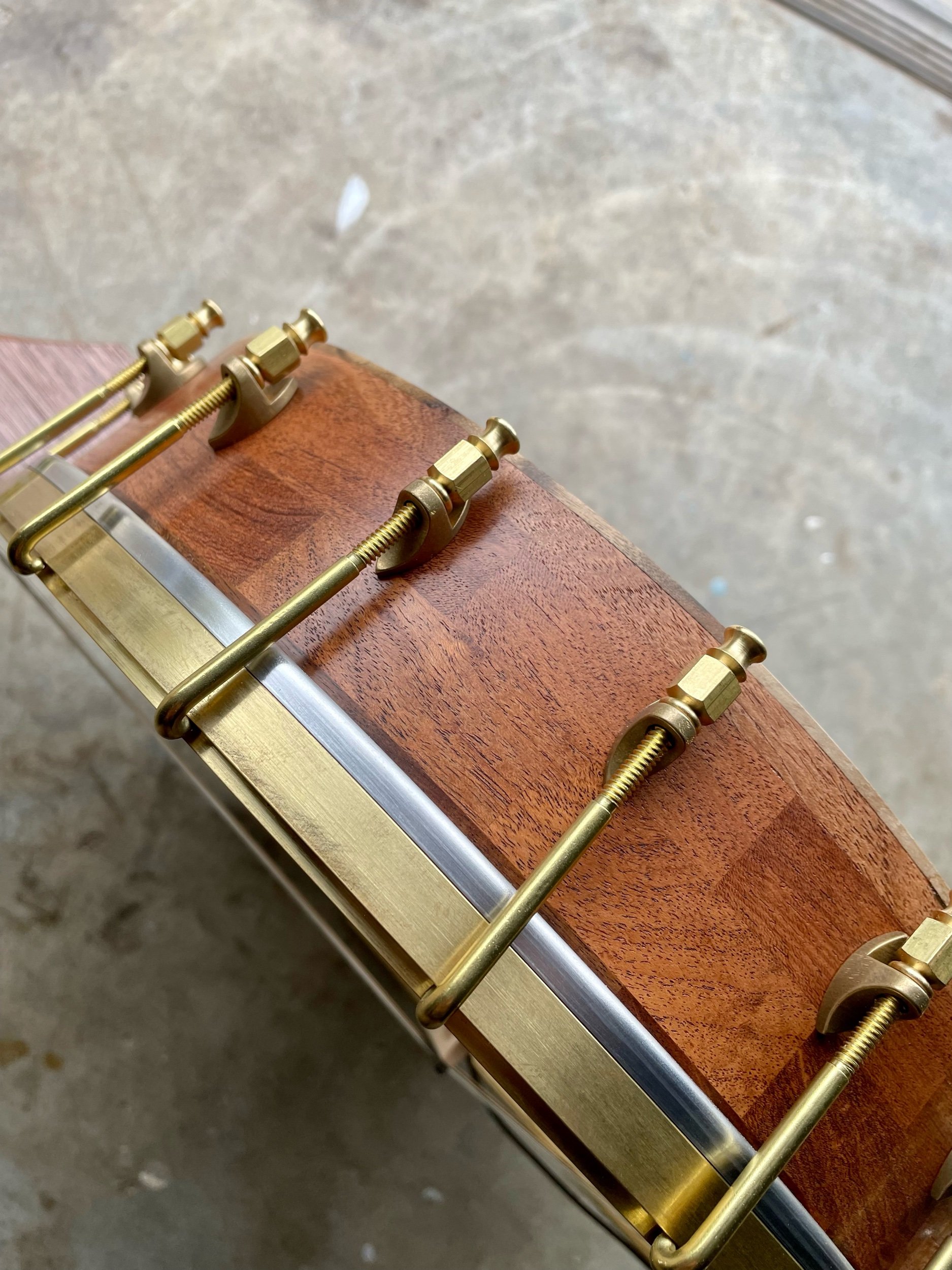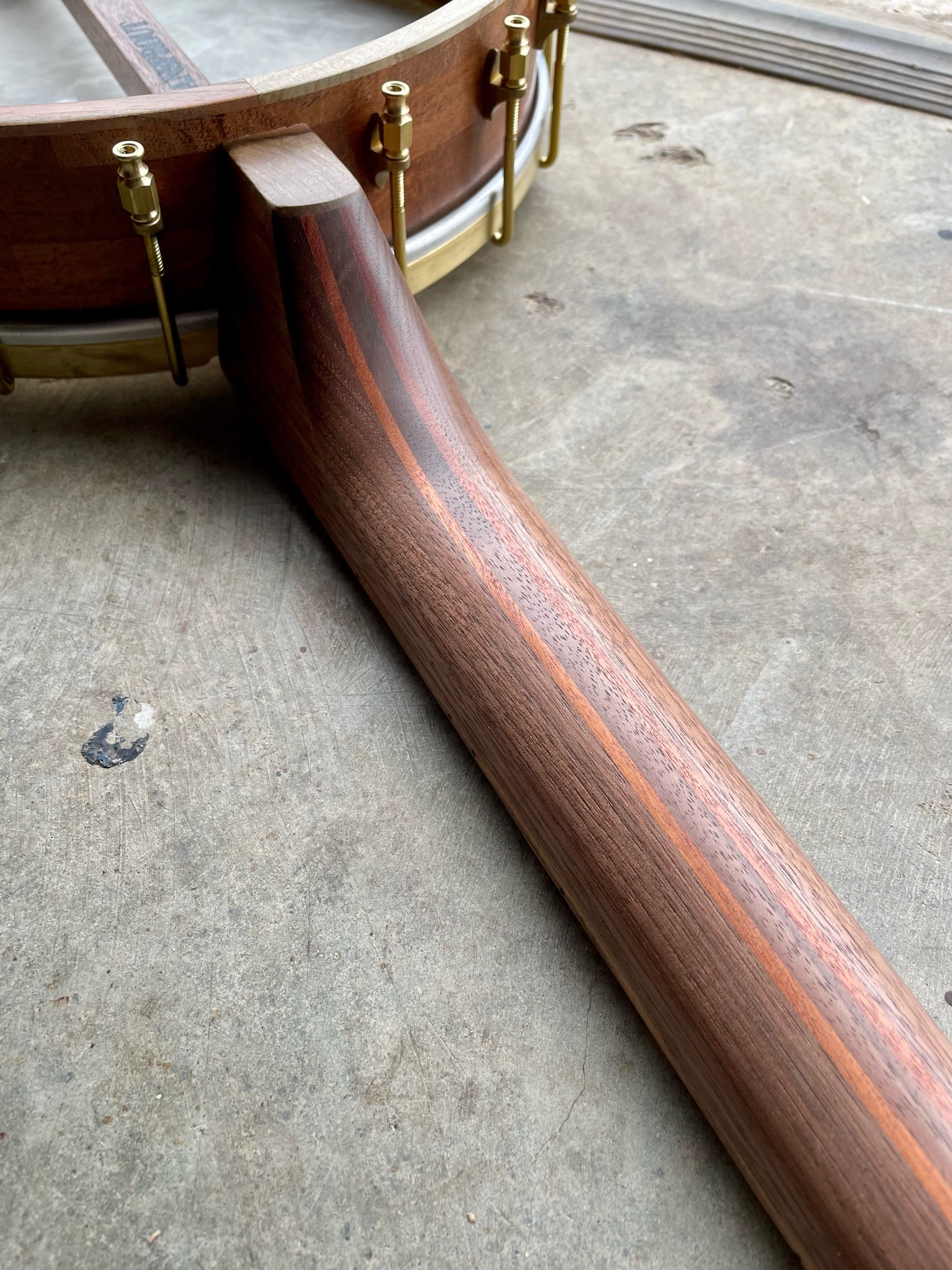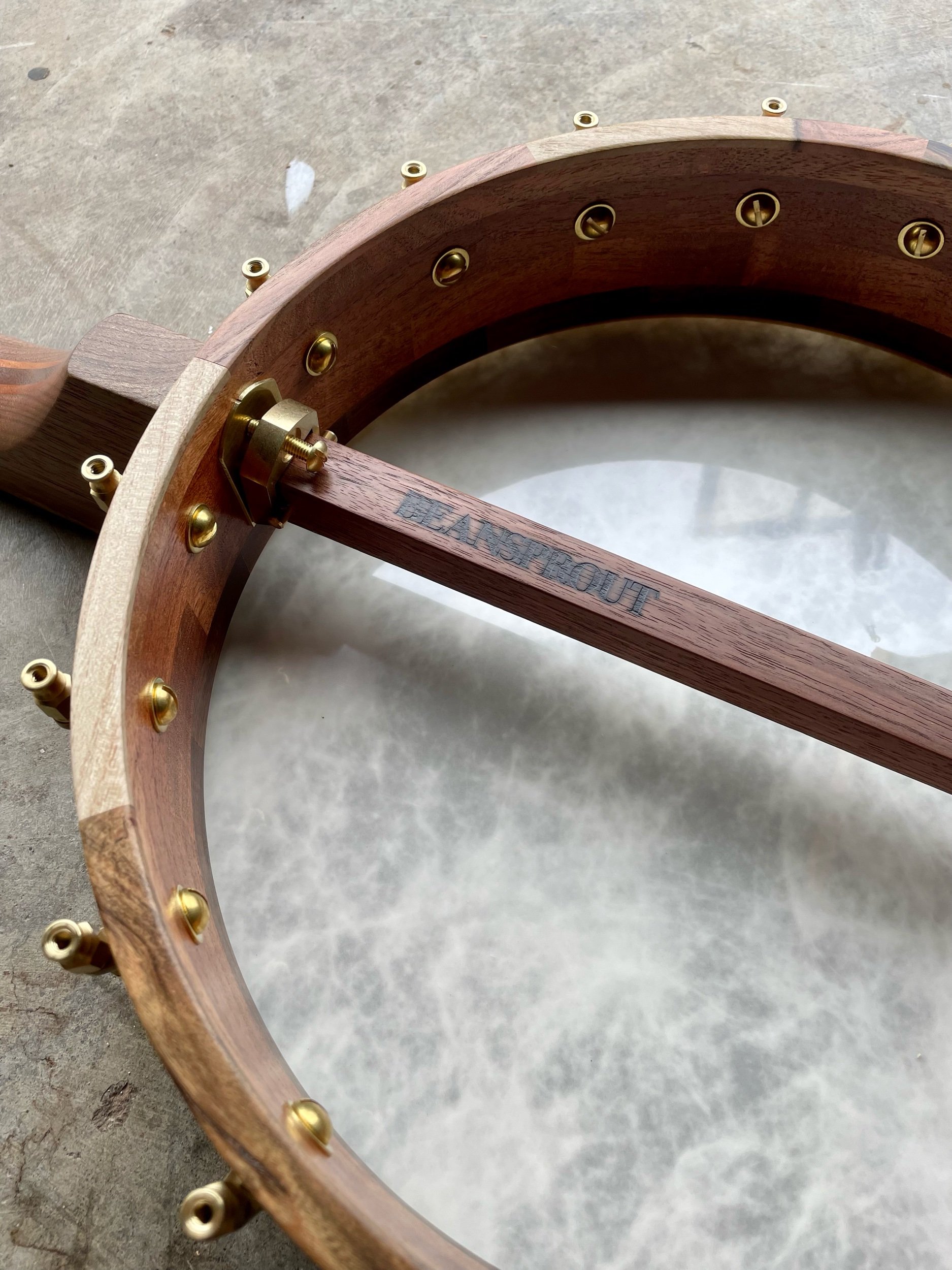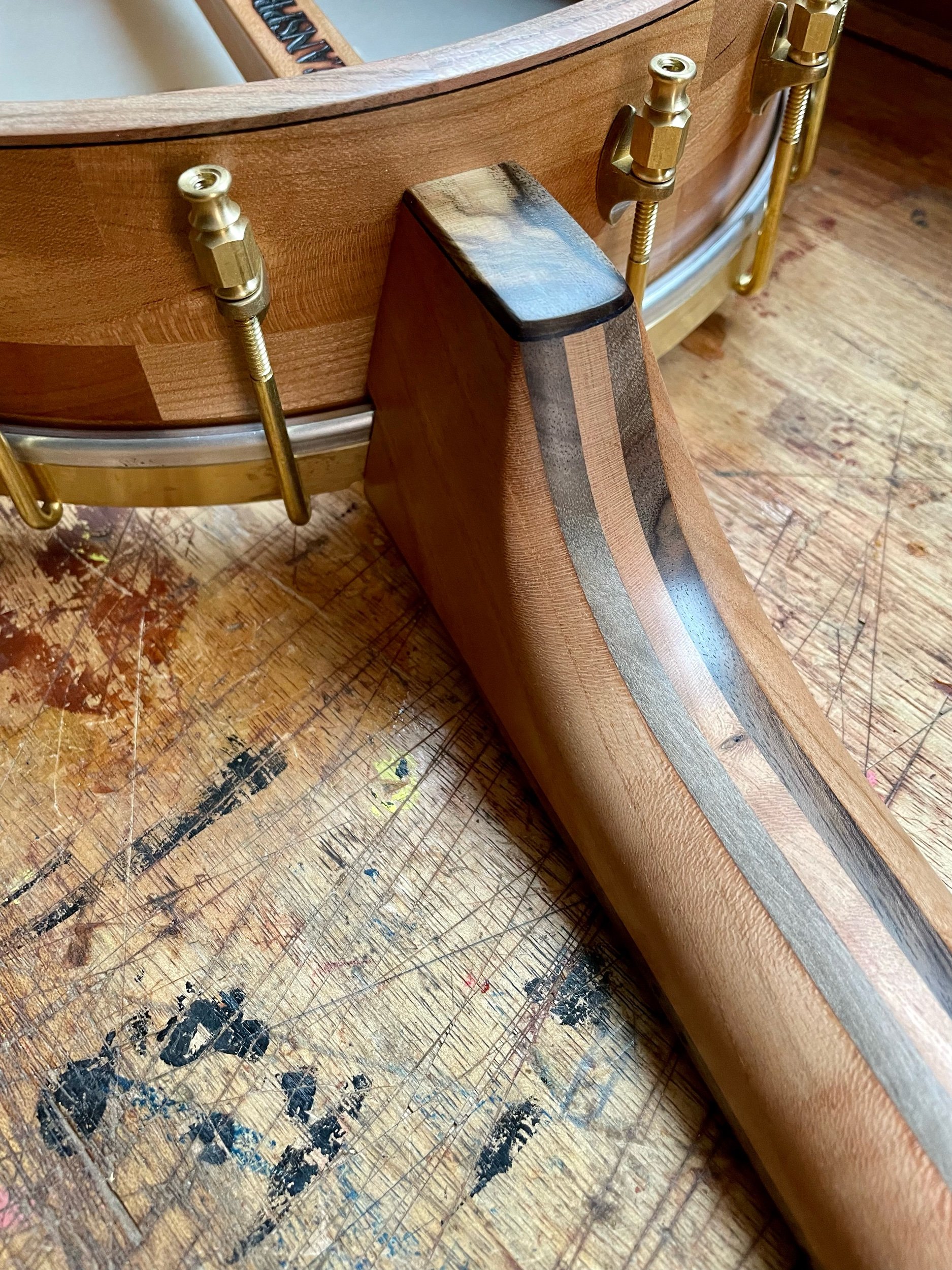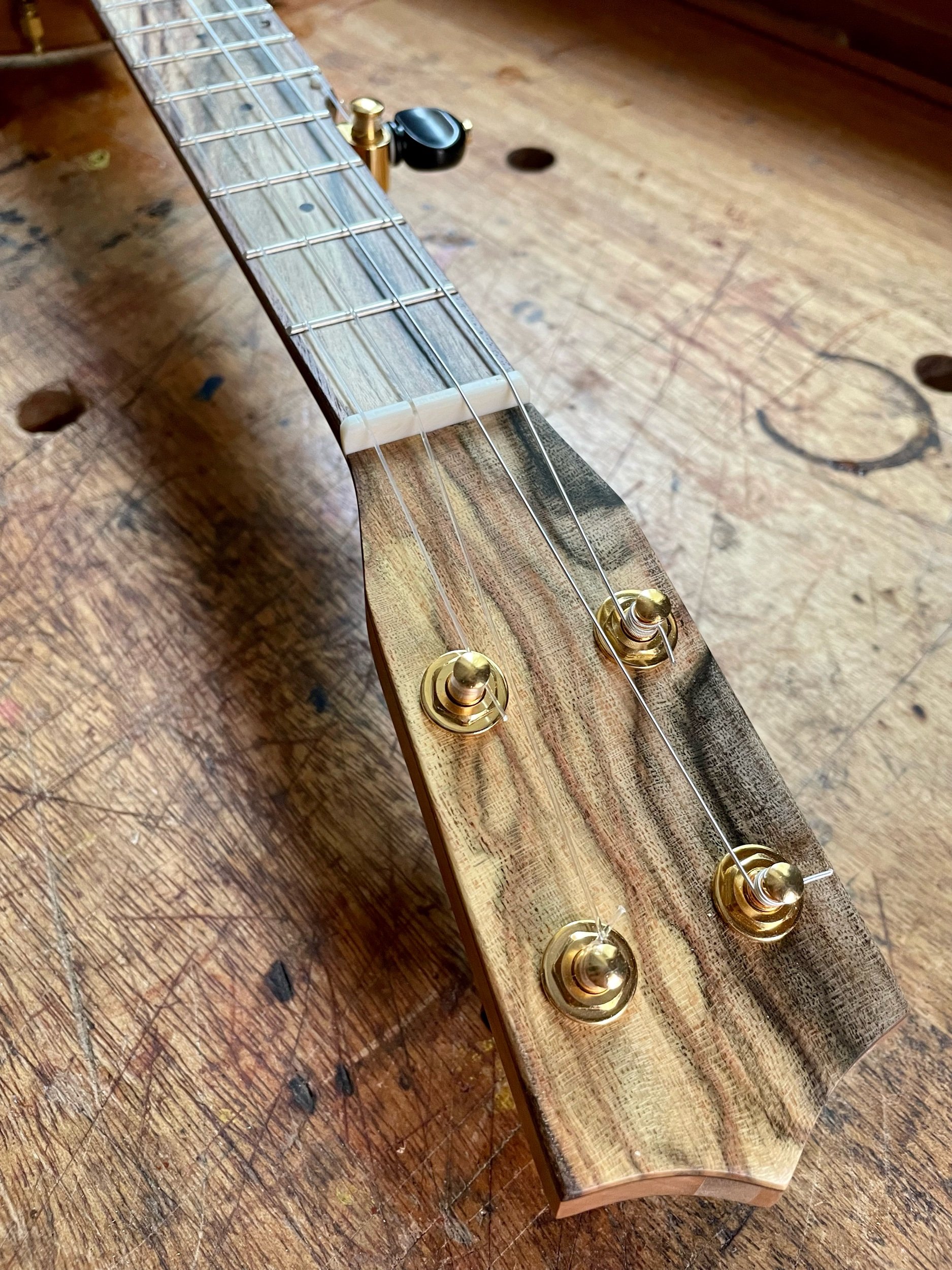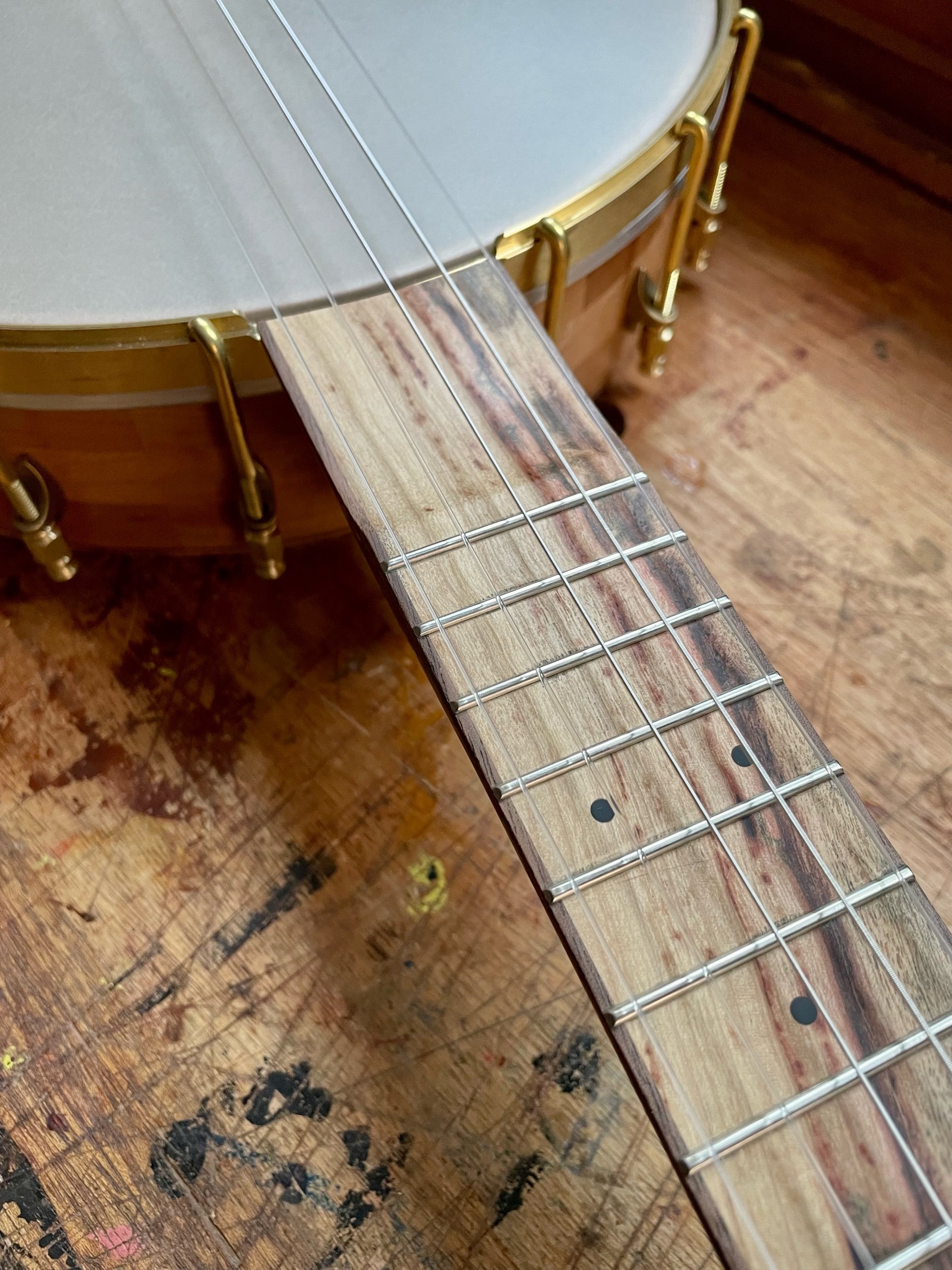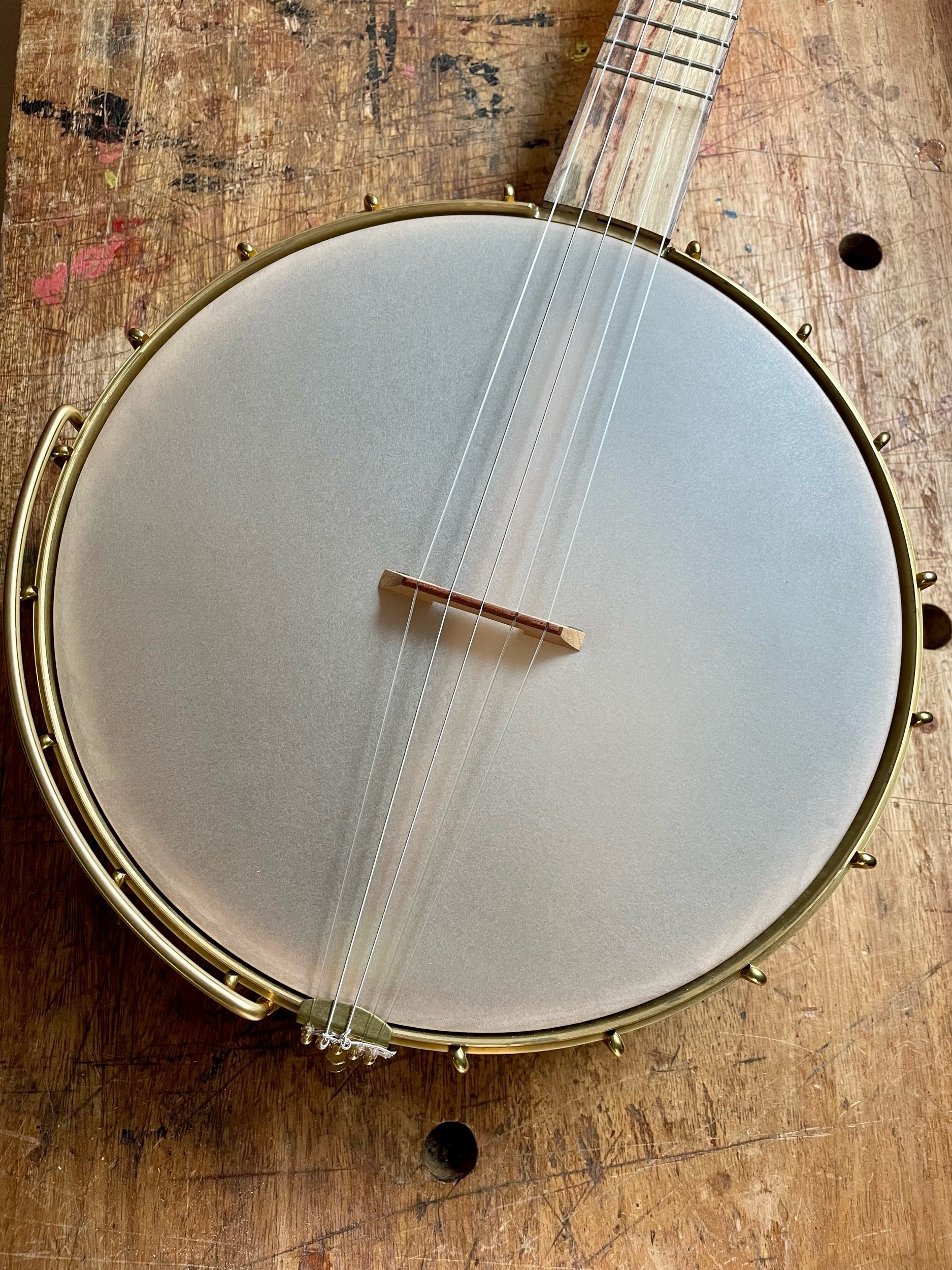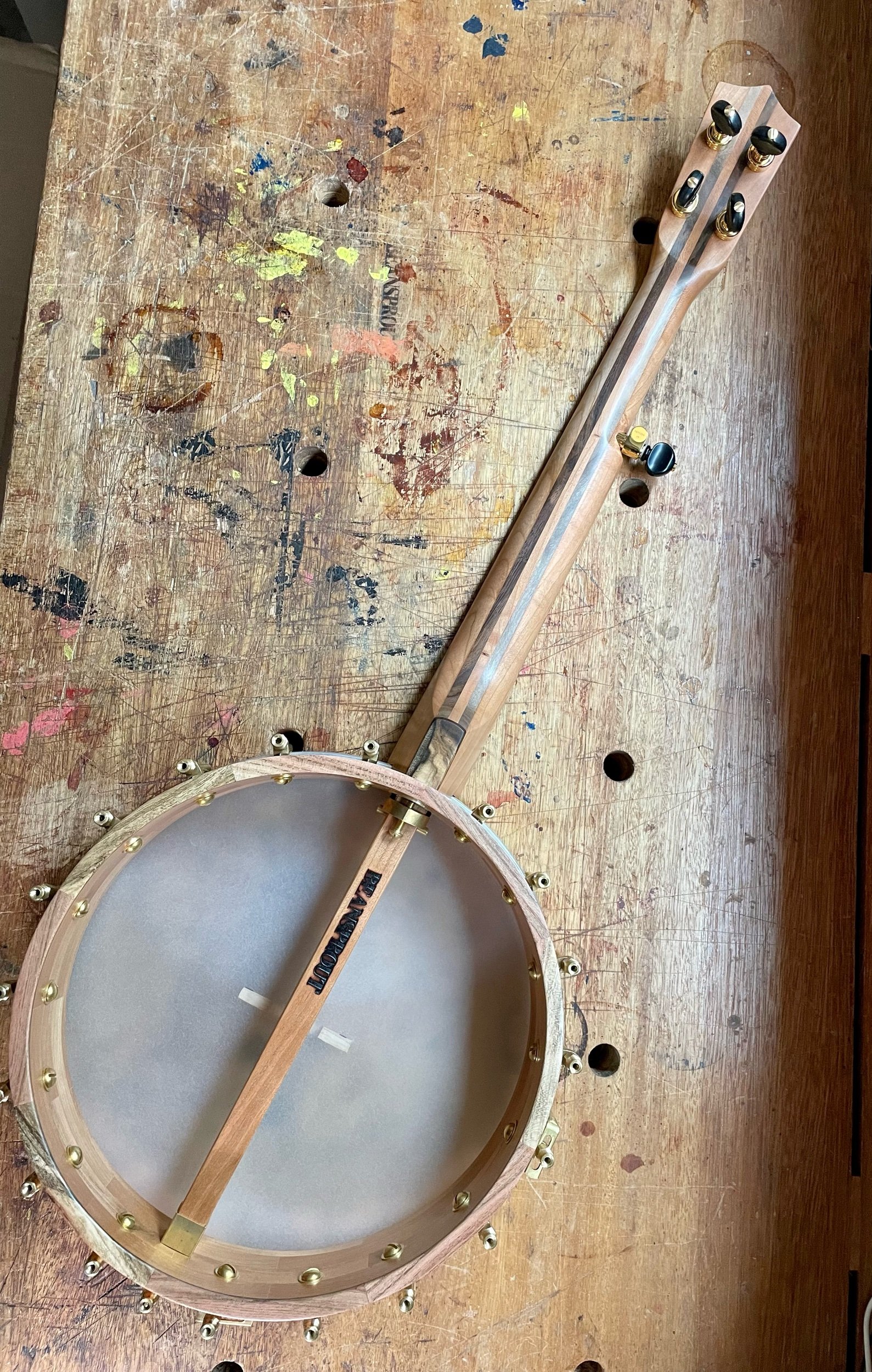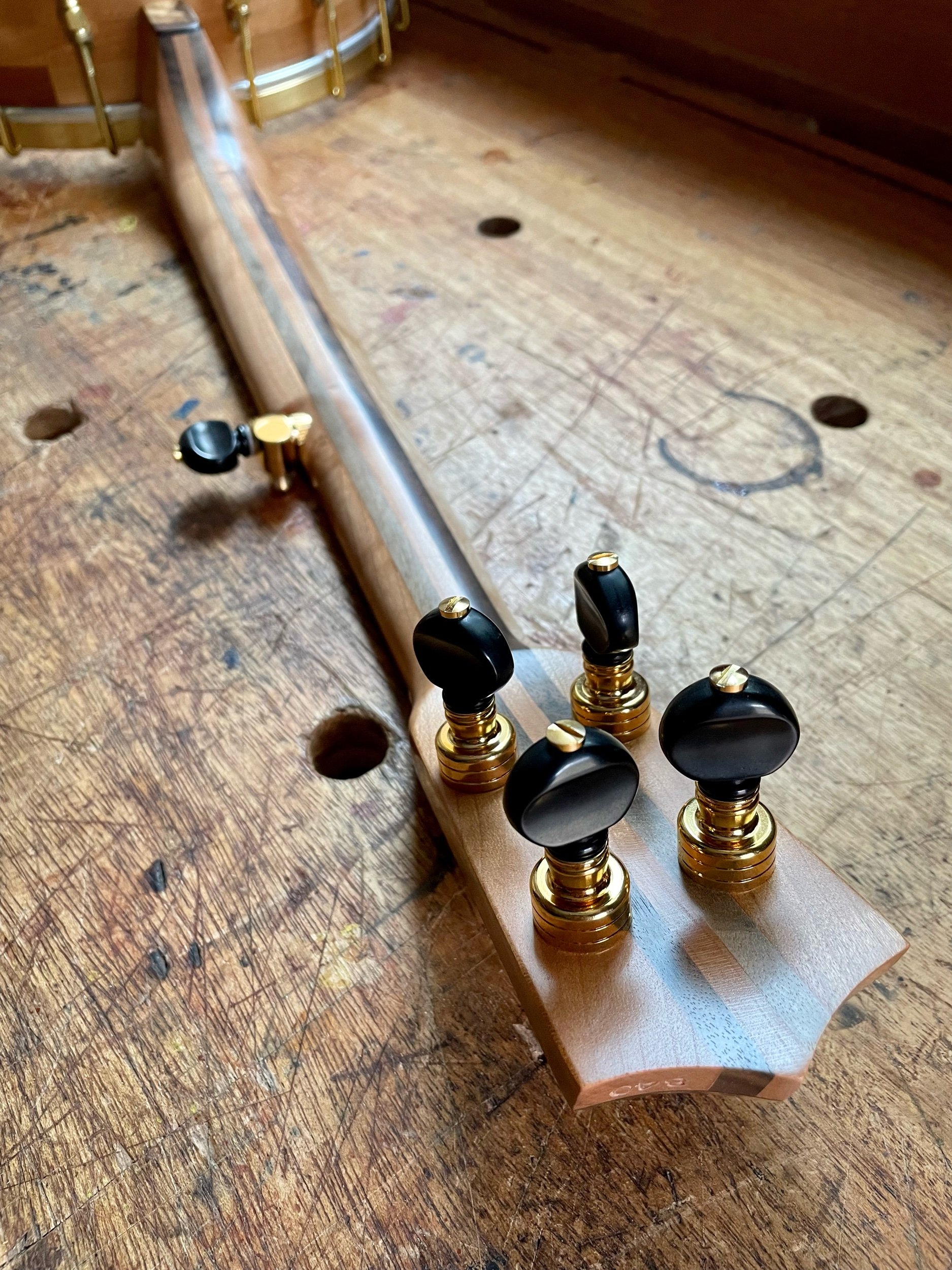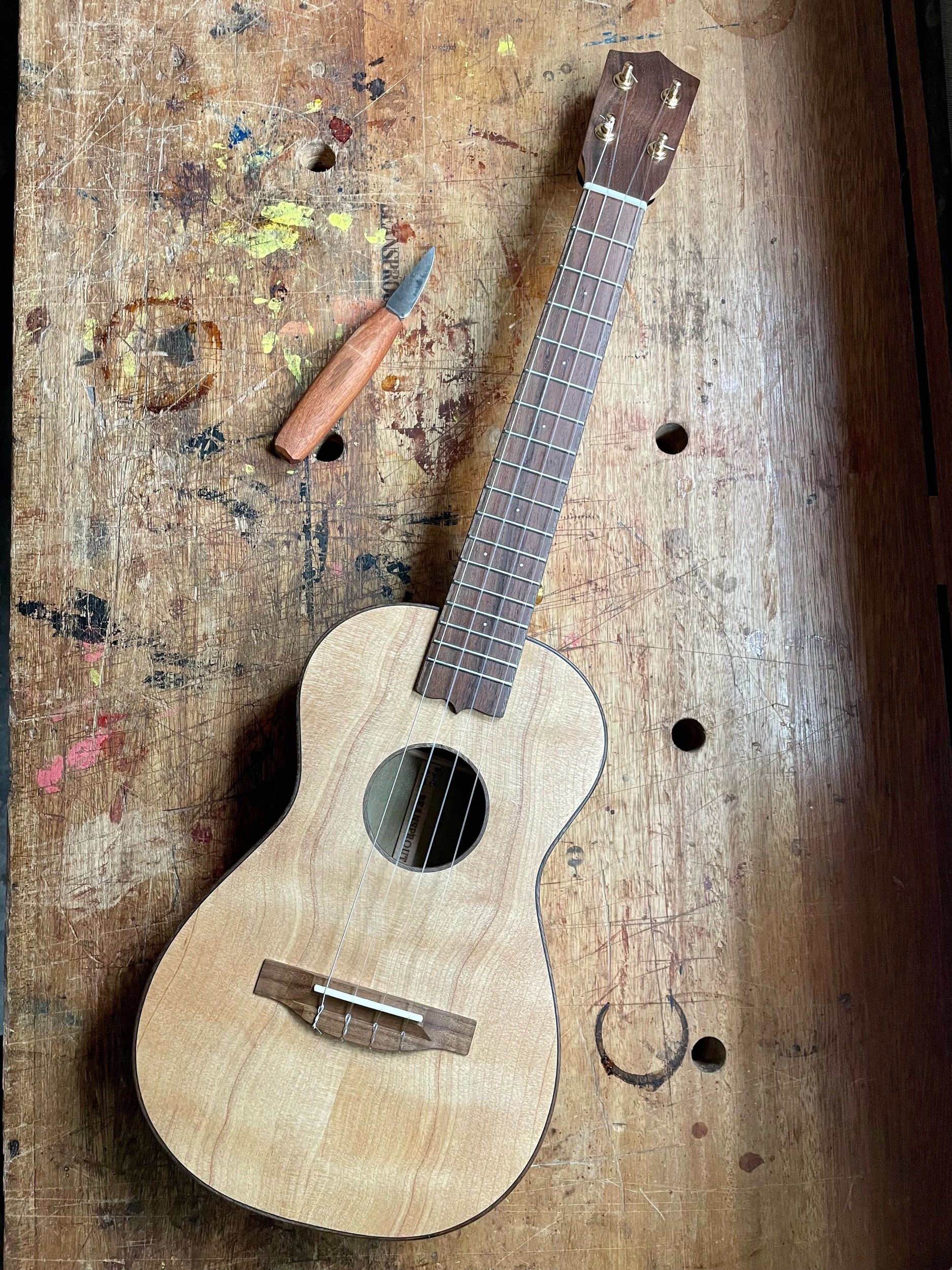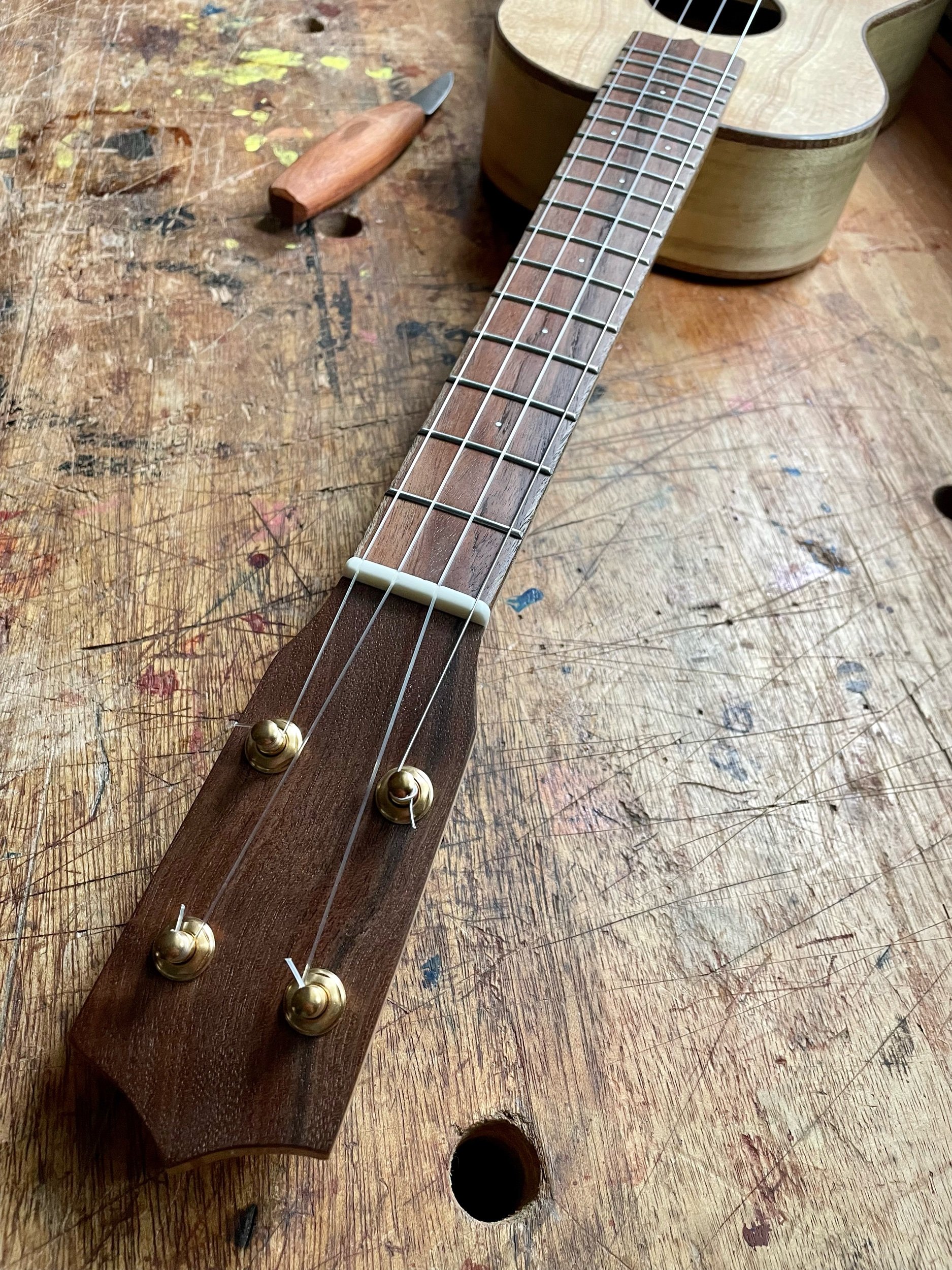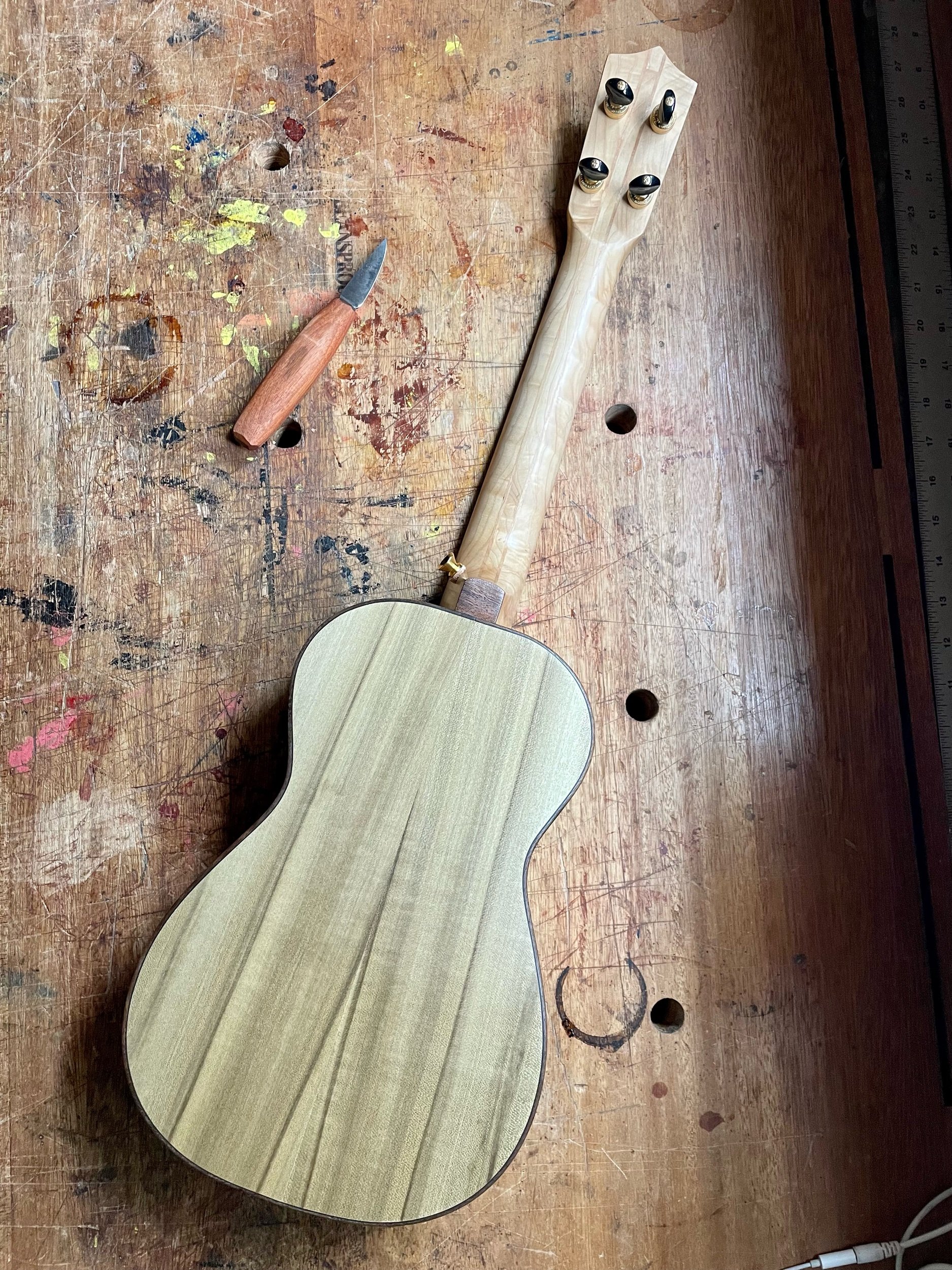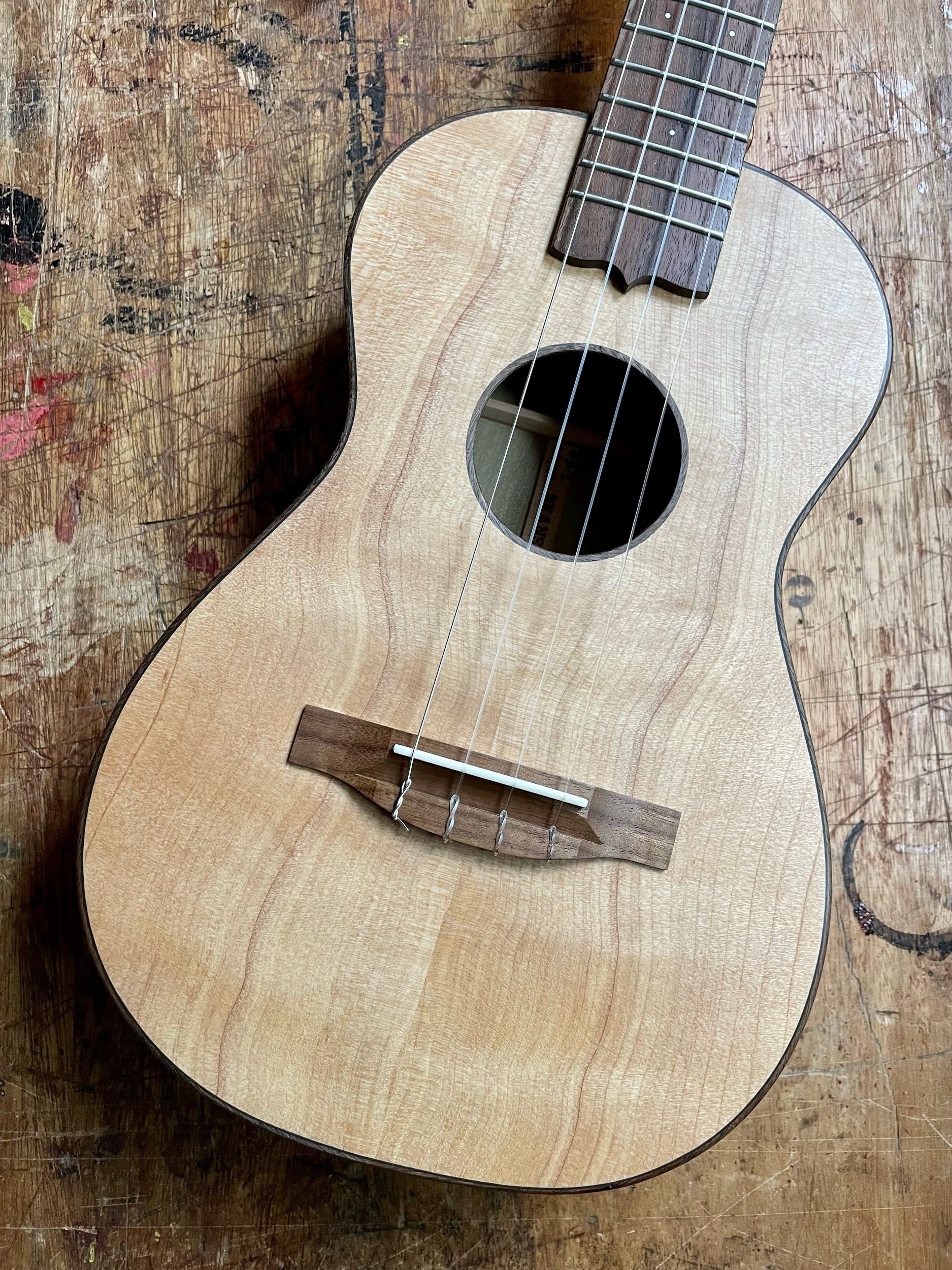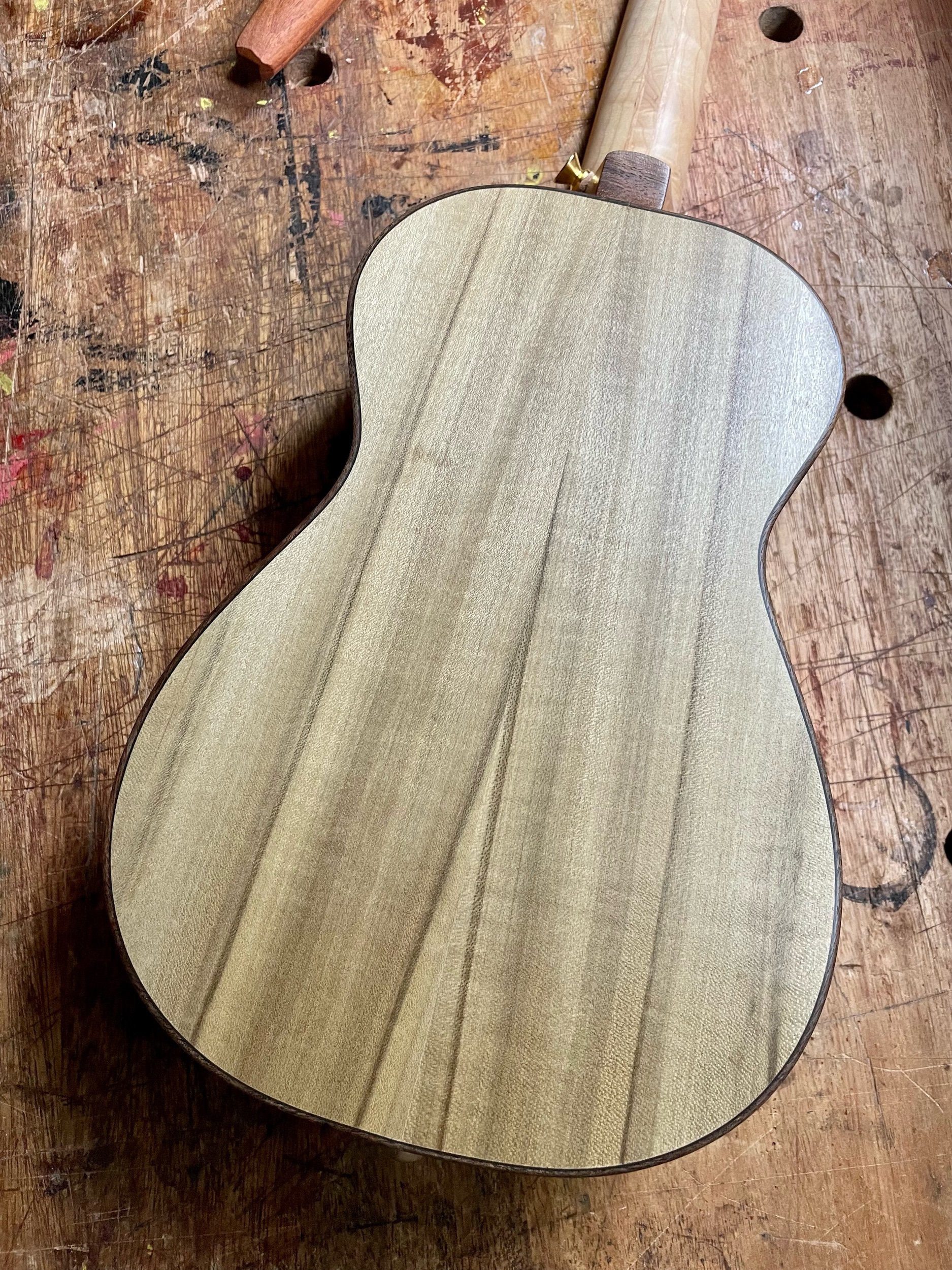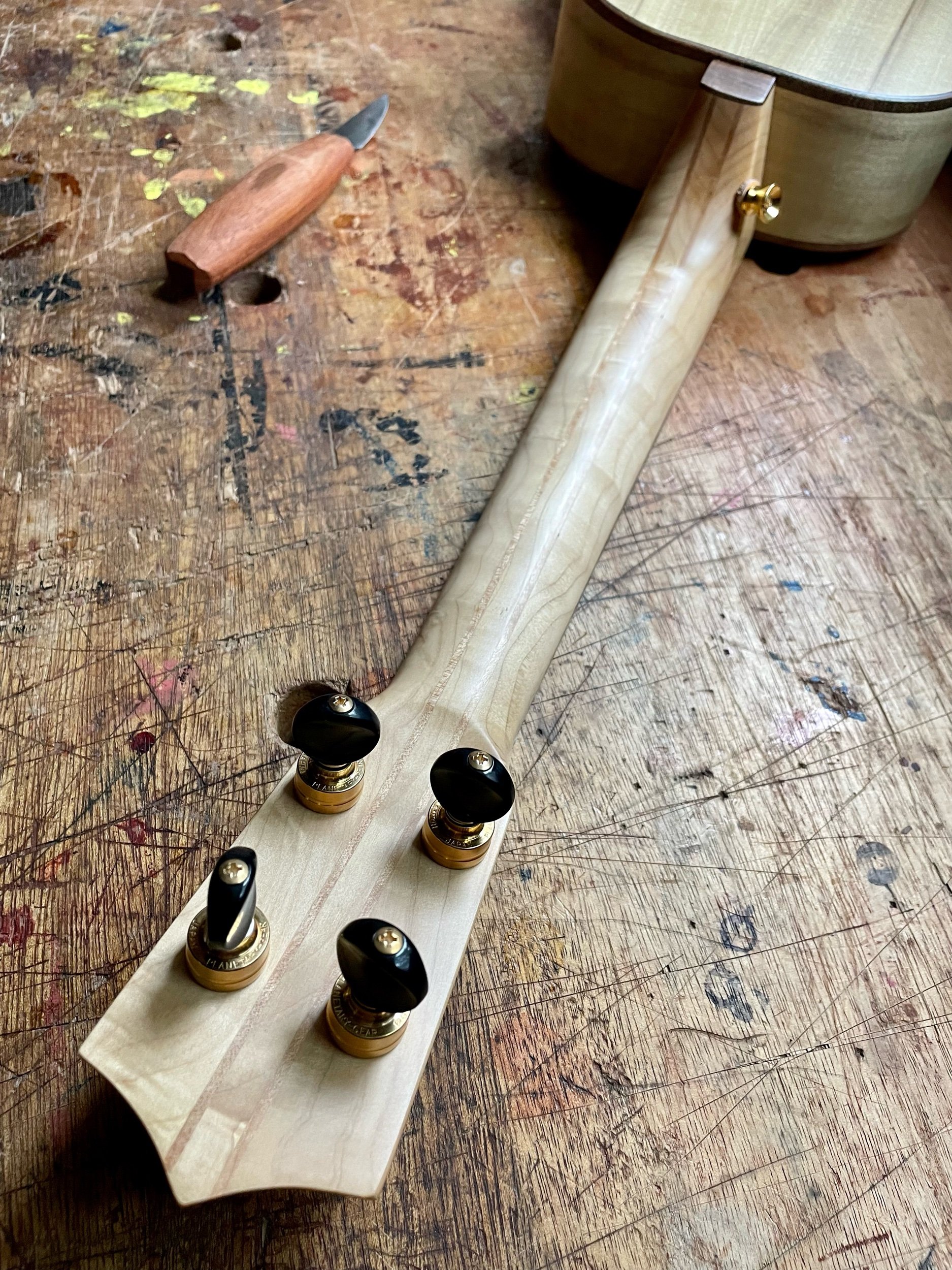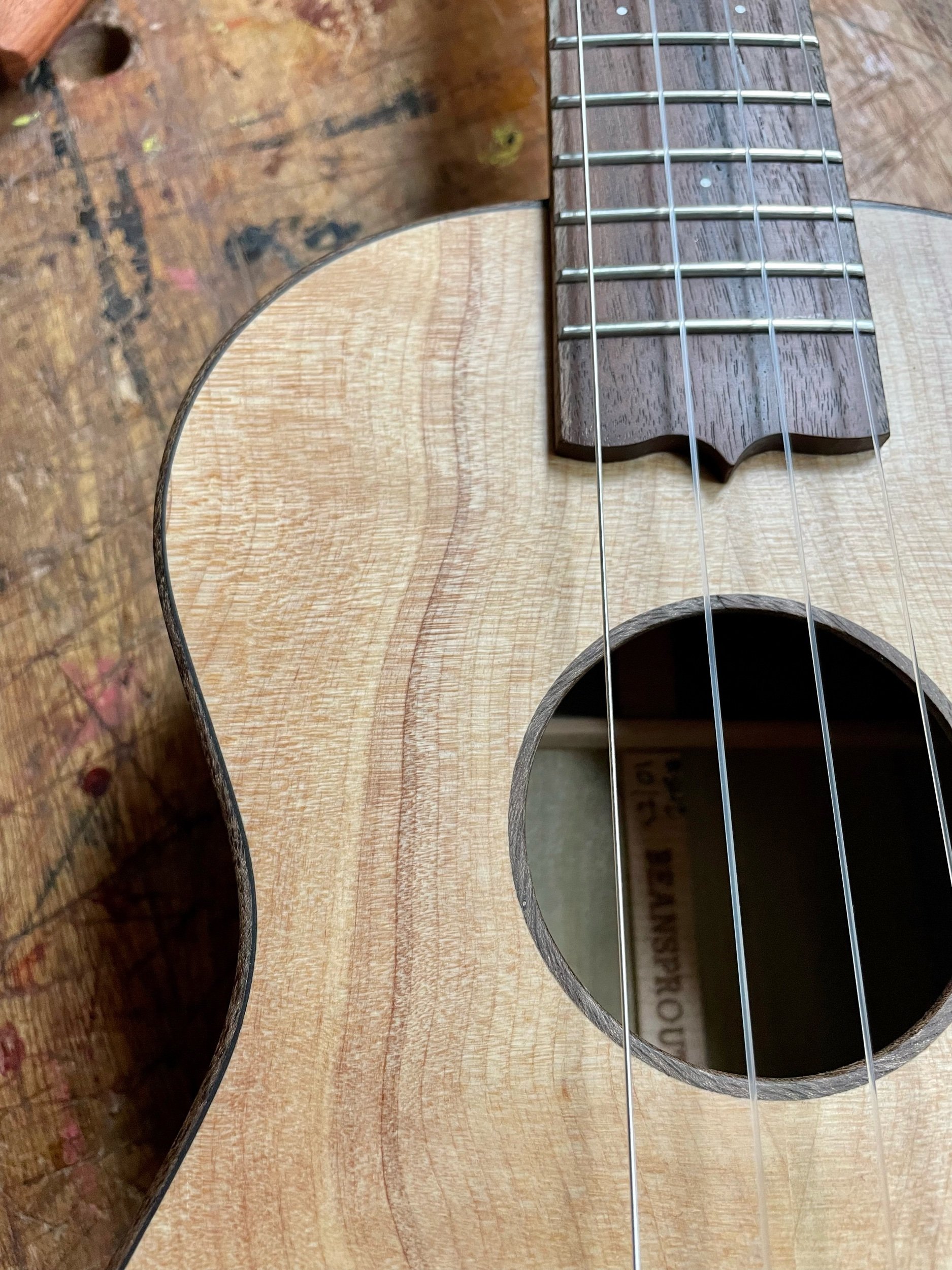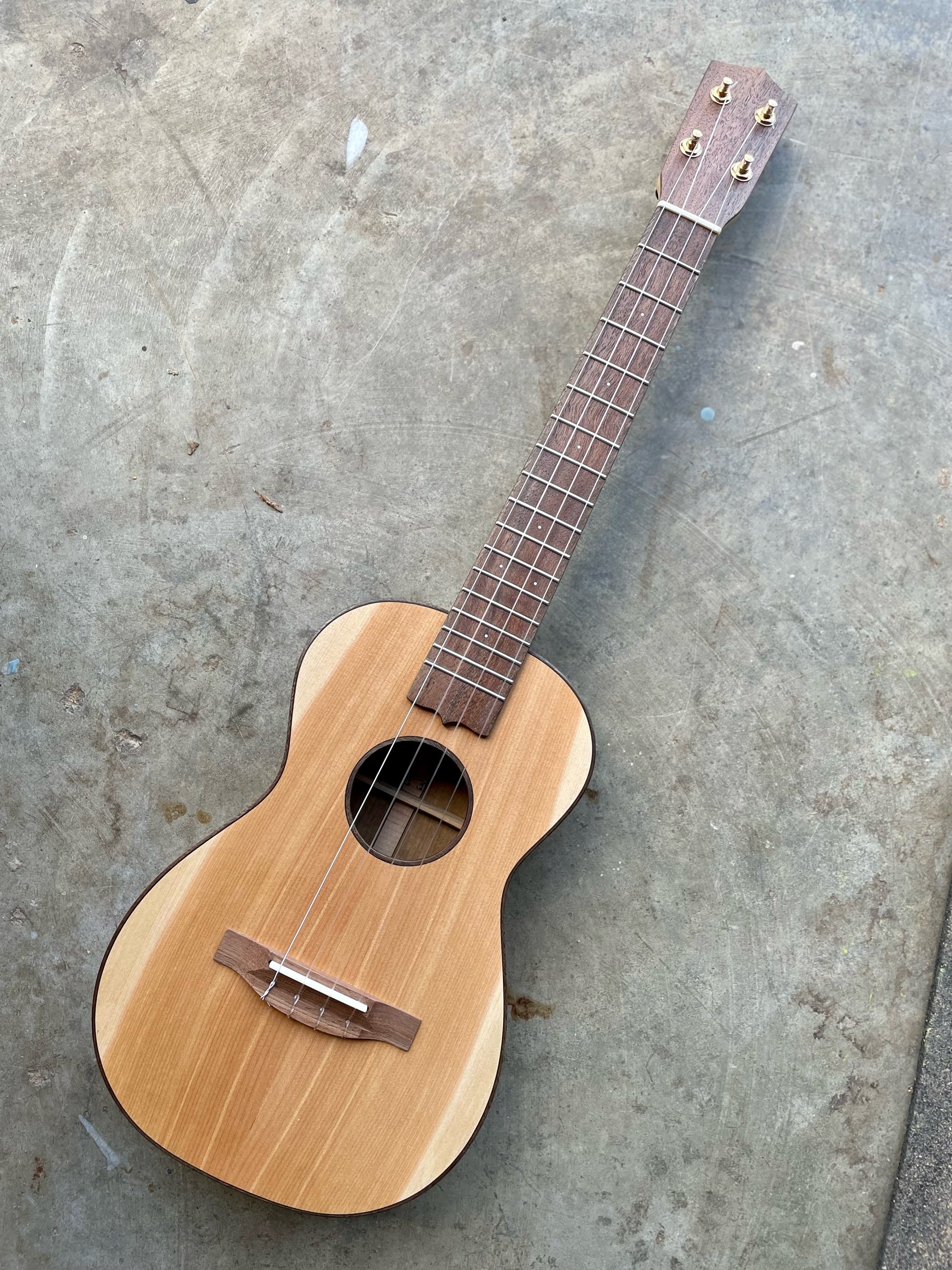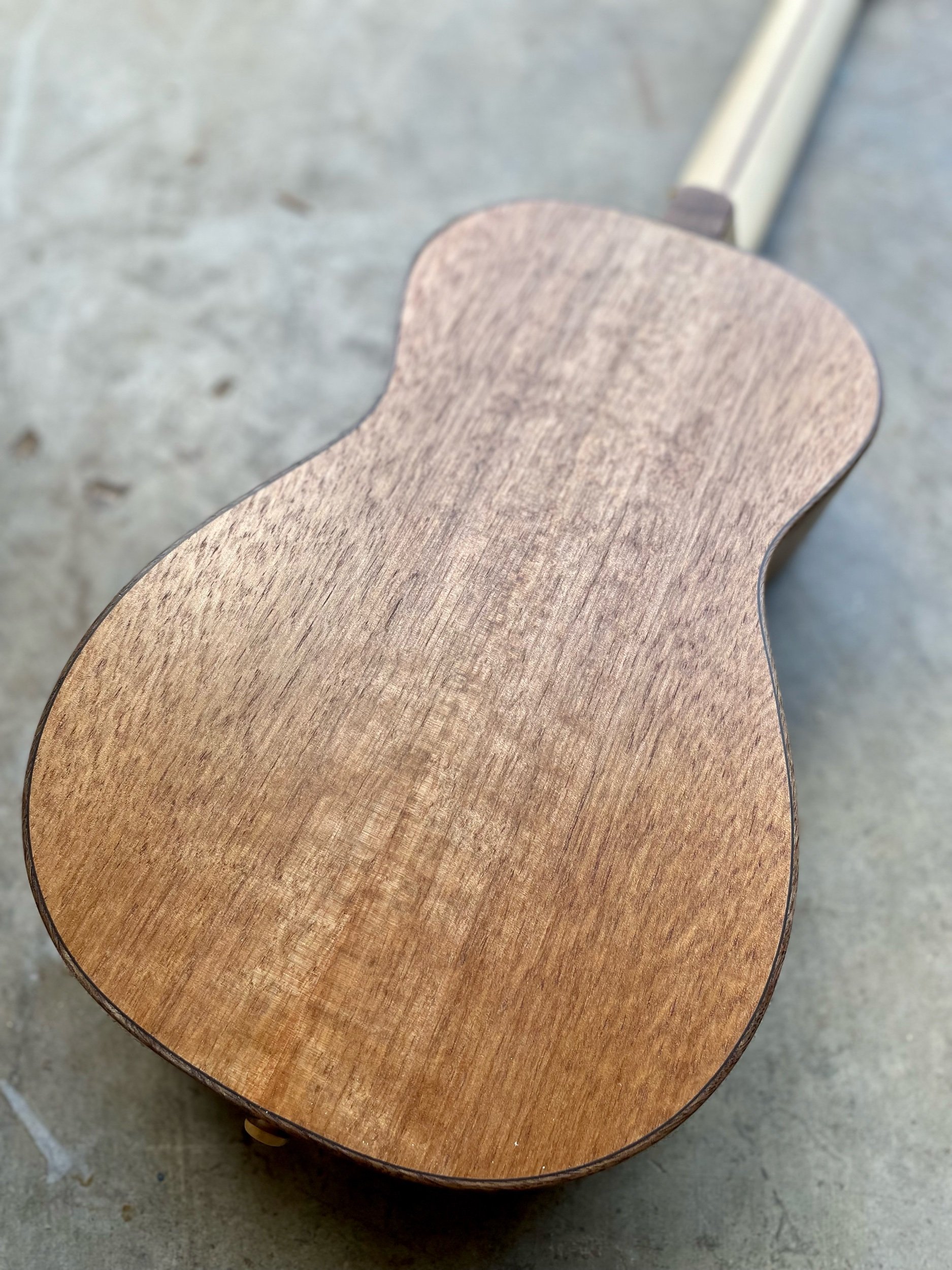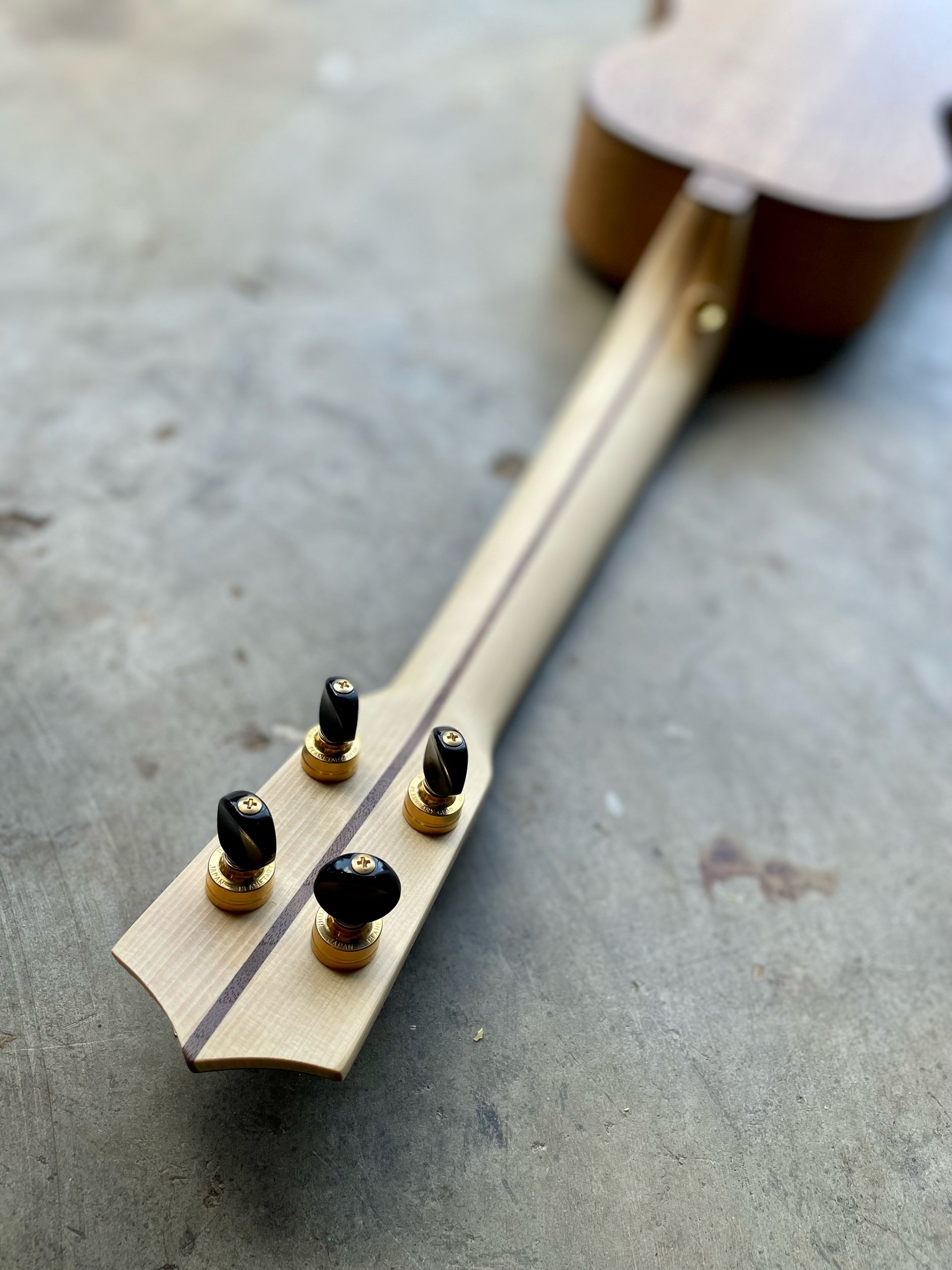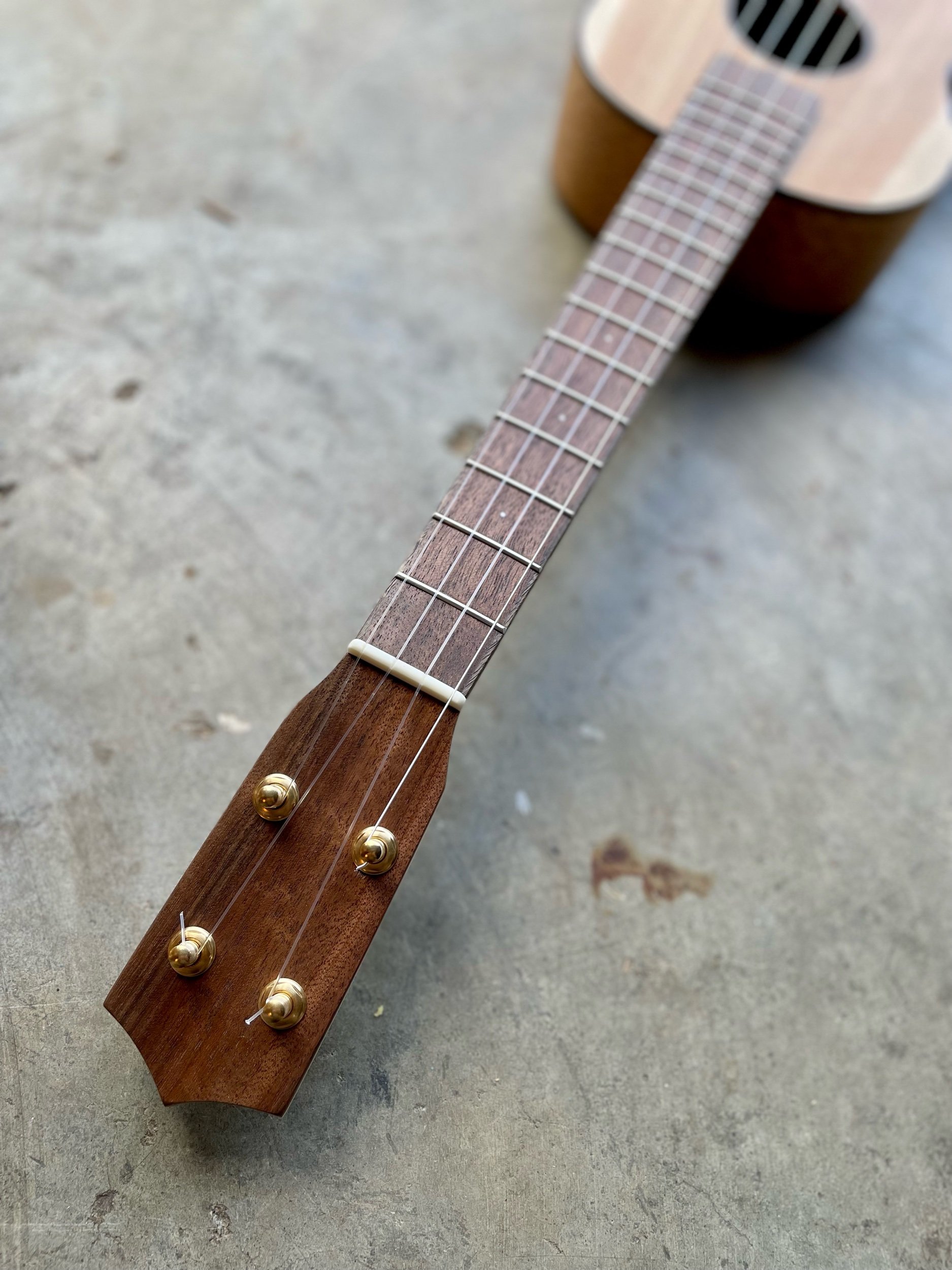I’ve never built a uke with Craig’s Spruce that didn’t sound good. His dad cut in many years ago in British Columbia from a float log. I’ve been using it for brace stock and tops for a few years now and it doesn’t disappoint. I like that the boards are wide enough to make one piece tops that have interesting grain and color. For #855, I paired it with some curly Oregon Walnut that I salvaged from a shop in The Dalles. The neck is some nice Port Orford Cedar and Walnut from my neighbor’s shop. I love the sound and feel of this combo, with a strong presence and sweet tone.
#851- Western Red Cedar and Mahogany Scout Ukulele
This one was really fun and a great chance to use up some special scraps. The Cedar top and neck are architectural salvage from a Hood River house, with those cool stripes and areas of texture that show their reclaimed status. The back and sides are African Mahogany and the fretboard/headplate/bridge are local walnut. I wrapped it all up with some shop made, random species rope binding. It’s off to the Scout waiting list.
#854- Spruce and Mastergrade Myrtle Tenor Ukulele
Spruce and Myrtle has proven really popular around here the last couple of years. It is loud, sweet, vibrant and “green” to me. (Do you ever hear colors?) The Spruce is from British Columbia, cut by our friend Craig’s dad. The Myrtle is some fancy stuff I got from Mya-Moe when my bosses retired. The neck is Port Orford Cedar from the Oregon coast. The rest is some local walnut. It has our special bird’s foot purfling, a low g and a K&K pickup. Let’s make some more “green” ukes, ok?
#857- Curly Walnut and Pistachio Mini Five String Banjo
I’m still surprised by the sound of this little thing, especially in open g tuning. I designed it for a higher tuning, but it’s a found a niche for banjo players who need a smaller instrument, whether for travel or due to physical needs. The curly Walnut on this instrument is subtle but has a lot of character. It comes from a local tree via The Dee Mill. The multi colored Pistachio is from California orchards and is a nice contrast to the Walnut. When you add the brass hardware and goat skin head, it really ties it all together.
#858- Cedar and Curly Walnut Alto Ukulele
This ukulele is a good representation of what I do:
1) Local woods, harvested and milled by me.
2) Simple aesthetic with interesting wood grain.
3) Easy playability and good intonation.
4) Loud and rich voice with nice sustain.
#853- Curly Walnut Tenor Banjo Ukulele
The root of this project was a banjo uke I made for myself last year that used a 10” vintage rim. I really liked it and folks started to ask for it after hearing me play it. This one is all Walnut from trees I’ve milled and I really like the look of just one species of wood. The 10” rim seems to have a little more air and resonance behind the notes and looks and feels proportional to me. Can’t wait to get it in your hands, Louise, and Happy Birthday!
FYI- I have parts set aside for a Maple one this winter, drop me a line if you are interested.
#850- Fir and Koa Rajao
This is my second instrument for my Kingdom Era Ukulele project, made possible by a grant from Mortise & Tenon magazine. For this project I went to Hawaii and studied instruments from the 1880-1890’s, built by the three original Portuguese builders. This instrument, the Rajao, is the larger five string ancestor of the ukulele. I used only appropriate hand tools, traditional methods and the same materials as the original builders for this instrument. It is constructed with hot hide glue and finished with shellac and wax. I hope in the future to build more instruments inspired by this design for customers. It has been fun, interesting, challenging and humbling to learn about this subject and I can’t wait to do keep going. Thanks to Mortise & Tenon, Shawn from the Honoka’upu collection and the Bishop Museum for their support.
#845- Cedar, Fir and Maple Baritone Ukulele
This instrument is for Evan, who has been sending me boards of salvaged Western Red Cedar for a few years now. This is the water tank cedar from Vashon Island that many of you are familiar with. The second wood is some old Douglas Fir, also from Vashon Island that I used for back, sides and neck. The rest is maple, with a little amber stain to make it look old and glow a bit. Every Cedar top I have used from this stash has sounded great and this one is no exception. The whole instrument growls and purrs in my lap, with a loud attack and warm sustain.
#847- Curly Maple and Pistachio Tenor Banjo Ukulele
Maple is the first wood I ever built banjo ukes from and I still love the sound. Bright and loud but also precise and sweet. This extra curly western big leaf Maple is from the estate of luthier John Sullivan. The small pieces passed through a few different hands till they got to me, perfect for these little banjos, The gray/green Pistachio is from California orchards and presents a nice contrast to the Maple. Big leaf Maple is softer than eastern Maple, which I think makes a softer and more balanced tone.
#849- Cedar and Cherry Tenor Ukulele
Wow- this one really has autumn vibes. Break out the decorative gourds! The top is a single piece of salvaged Western Red Cedar and the back is some Cherry from the Carpenter Ant stash in Portland. Both have little marks and natural flaws that give them character. The neck is some Douglas Fir, salvaged from a floor joist. The fretboard/headplate/bridge are Jatoba, a South American wood I salvage from old flooring scraps. Some bright maple binding and a Santo style headstock add some visual flare. It sounds nice too, rich and warm with a dusty texture. I think I’ll go rake some leaves and put a sweater on.
“Dear, Aaron, Nicole, and Henry,
The Ukulele arrived a week ago, and I’ve spent time with it every day.
I am someone who never should be trusted at a buffet, and, having worked my way through the various ukes in the gallery I was overwhelmed with the choices. I put myself on a ‘diet’ and only requested a cherry back and sides and simple binding; Aaron knows more about ukes and woods than I ever will, so I trusted his judgment on the rest. I could not be more pleased. Each of the woods is a rich color that melds perfectly with the others. Every wood has its own distinct character, but they all come together. The maple binding has an alternating pattern of light and “not so light” that gives the impression of a very subtle rope binding.
The action is light and quick. My 70-year-old hands find barre chords easy to play. The tone is true and rich and goes quite well with my baritone voice. I look forward to getting to know this instrument and hearing how it matures.
I played in a 3 uke session yesterday and this one held its own, singing out on solos, but giving up nothing as part of the group.
Finally, Aaron’s shop must smell wonderful. As I play, there is an incredible perfume that comes out of the sound hole.
Thank you for the care you’ve put in this instrument.
- R. E. ”
#846- Bearclaw Spruce and Curly Koa Alto Ukulele
This is an instrument for a friend and patron of ours who already has an alto ukulele made of Sycamore. This time she wanted a brighter sound, so we chose Spruce and Koa for the main woods. She also asked for a quilt square inlay, which was a fun challenge to piece together. I looked at quilts and barn hexes from the part of Pennsylvania that the Keim family first settled for inspiration. We chose Jatoba for the fretboard/headplate/bridge, which is a dense wood salvaged from flooring scraps. Some curly Maple binding ties it together. The Koa is from our friend Bart’s mill in Hawaii. We will donate to plant more native Hawaiian trees here.
#844- Mango Tenor Ukulele
As many of you know, I don’t use much tropical wood. When I do, it’s either salvaged wood or wood from a trusted sustainable source. Even though Mango is a common ukulele wood and we used it a lot at Mya-Moe, it just hasn’t been available under the above conditions to me. This summer, Perry and Dani brought me some end tables that were basically blocks of mango wood made from tree trunks. I split them, sawed them and found many ukulele sets and some neck blanks. I figured I should do a test and remind myself what it sounds like. I think it’s warmer than Myrtle but brighter than Koa, with a sweet and traditional voice that sounds familiar to me. I paired it with a Pistachio fretboard, headplate, bridge and rosette. Some curly Maple binding wraps it up. I have plenty of this, including curly, spalted and Mastergrade sets, so drop me a line if you want it on your next uke. This is a stock instrument, available for $1900 in a hard shell case plus shipping. I can switch it to low g or add a pickup if you are interested. Click here to purchase.
#852- Koa and Pistachio Tenor Banjo Ukulele
Koa is an uncommon wood for banjos, but I have a stash of flat and rift sawn Koa from the Carpenter Ant stash that makes perfect banjo parts. It was originally milled for clock cases and has had a lot of time to dry and season. Combined with Pistachio from California orchards, it makes a nice banjo uke. Cheerful, bright and sweet with good sustain. This one has a simple Beansprout leaf inlay with some wood burned details from Nicole. Maybe we should offer this on other instruments? Like all of our Koa builds, we will donate to plant more native Hawaiian forests here.
“Hello, Nicole and Aaron;
I am delighted with my new banjo uke! It is everything I hoped for. The quality of the craftsmanship is excellent, and the sound is wonderful! It has received many compliments from the other people in my regular informal jam session, and it hasn’t failed to impress both the banjo players and the guitar players as well. I’m currently using your “Fingerstyle Ukulele” workbook to begin growing into a better musician. (Someday, perhaps I’ll play well enough to really show that ukuleles ought to be allowed in bluegrass!)
Again; THANK you very much for this great instrument.
- C.S.
”
#848- Port Orford Cedar and Myrtle Scout Ukulele
Another humble Scout Ukulele made from shop scraps. Myrtle and Port Orford Cedar from the Oregon coast and local Oak and Walnut. This one is bright and cheerful with nice sustain. It’s off to the Scout waiting list, email info@thebeansprout.com to get on it.
#822- Mastergrade Myrtle Baritone Ukulele
I’ve been saving this fancy Myrtle which I inherited from a guitar maker for many years. Well, it’s time for this board to make music, so here we are! I also used Myrtle for fretboard and head plate, which I think is a nice look. The neck is some old salvaged Fir with really nice grain as well. I bound it in curly Maple and chose a Maple bridge to match. I strung it with a special string set, so it can be tuned gcea. This gives the normal uke tuning a deeper tone due to the larger baritone body. Of course, it can be strung for dgbe as well if that is what you prefer. It is available here for $2200 plus shipping, and includes a hard shell case. A K&K pickup can be added for $150.
***** If you are an international customer (outside of the US), please note we may need to charge you additional shipping fees depending on your location. You will also be responsible for any customs fees imposed by your country. Thanks! ******
#843- Curly Port Orford Cedar and Curly Walnut Tenor Ukulele
Port Orford Cedar is a Northwest wood I handle all the time. I am used to all the different types, grain patterns, the curl, even specific trees I have worked from over the years. When I lit this one up for photography yesterday I was still blown away by the top. I finally took the time to appreciate its amazing grain, curl and natural beauty marks. And the sound! Rich, full, bright, detailed and expressive. I also made the neck from curly POC, with some walnut stripes and a carbon fiber rod inside for strength. All the walnut is from a grafted Walnut stump I got from Zena Forest Products a few years ago. The POC came from my neighbor, a retired flute builder. This instrument also has a 1.5” nut width and a K&K pickup.
“Hi Guys,
I’m finally getting around to sending a picture of me #843. I’m totally enjoying it! I switched to a high g string and am really liking the sound. Definitely different than anything else I own. Very bright, fun to play and the sustain goes on forever!. I’m working on my fingerpicking and 843 is my usual choice. Besides, I just like to look at it! And, the strap looks and works great too!
Happy holidays!
- T. G. ”
#841- Walnut, Pistachio and Mesquite Five String Banjo
This project had lots of fun little details to keep me on my toes, but by the end I couldn’t be happier with it. It just feels, looks and sounds incredible. The 12” rim has a brass tone ring and is made of Mesquite and Texas Ebony with a Pistachio cap on it. The neck is Walnut and Pistachio, with 20 frets and 4 spikes. It has a Fiberskyn head, Hawktail tailpiece, brass arm rest and Baggs pickup. I think the Mesquite rim adds a lot of bass and sustain to the sound. The Mesquite and Texas Ebony come from a retired builder. The Walnut is from a retired furniture maker and the Pistachio is from California orchards.
#840- Cherry and Pistachio Short Scale Five String Banjo
Cherry keeps impressing me lately. It is plenty loud, but also textured, mellow and rich. This 11” cherry rim has a wood tone ring, a synthetic head and non steel strings. It’s a good all around combination that I can’t complain about. The 20” scale neck is short enough to be comfortable and light weight, but long enough to hold the G tuning well and look proportionate to the 11” rim. The Cherry and Walnut neck is all wood salvaged from the Carpenter Ant stash in Portland. The Pistachio fretboard, headplate and trim comes from California orchards.
#842- Curly Port Orford Cedar and Poplar Tenor Ukulele
I say “no” to more woods than I say “yes” to. When I find a new wood, I want it to be domestic, sustainable, affordable, look good, easy to work and sound good. No wood gets a perfect score, of course. One thing that often happens is that I salvage a few boards from somewhere and I find inspiration within them. Maybe I can never find or afford a board like this again, but I’m willing to work with it as I salvage it. Lots of my Mahogany is like this.
In this case, I pulled a long, wide board of perfectly quarter sawn Poplar from the Carpenter Ant stash. Poplar is a fast growing, easily workable hardwood from North America. You can even get it at Home Depot! I used it for back and sides on this uke, even finding it to be a bit curly. I paired it with a curly Port Orford Cedar top and neck, salvaged from a retired flute maker and local Walnut for everything else. It is light, responsive, loud and rich.
“The instrument arrived today - wow. So beautiful. So light. A lovely sound. I played the strings with my handmade finger picks made of crow beaks, and they started a musical coversation that will last a very long time.
I shall treasure this instrument, and take good care of it as I play it.
Thank you kindly,
- L. M.
”
#839- Juniper and Chinquapin Tenor Ukulele
I work hard to limit the number of woods that I use. This helps with the consistency and identity of my work, but also helps with the labor of checking for sustainability and yield. But, there are still some ukes that contain a combination that surprises me. In this case, the Juniper is from Western Oregon and came from Chris at The Dee Mill. It is sort of between Cedar and Spruce in hardness and tone. The Chinquapin is a west coast wood that behaves like a mix of Oak and Mahogany. Put all that together for a bright but earthy sound, with some grit below the sweetness. I like it. The neck is some Port Orford Cedar and the rest is local Walnut. I am really proud of this one and can’t wait to pass it on.
“This uke speaks to me on all levels. Bright yet warm. It’s very inviting. What a joy Aaron. You really are able to “feel” the woods and bring them together. Such beautiful music.
- J.H. ”


